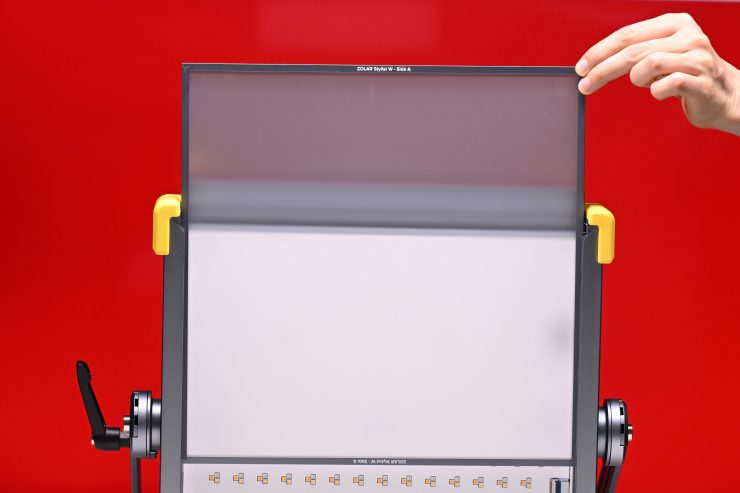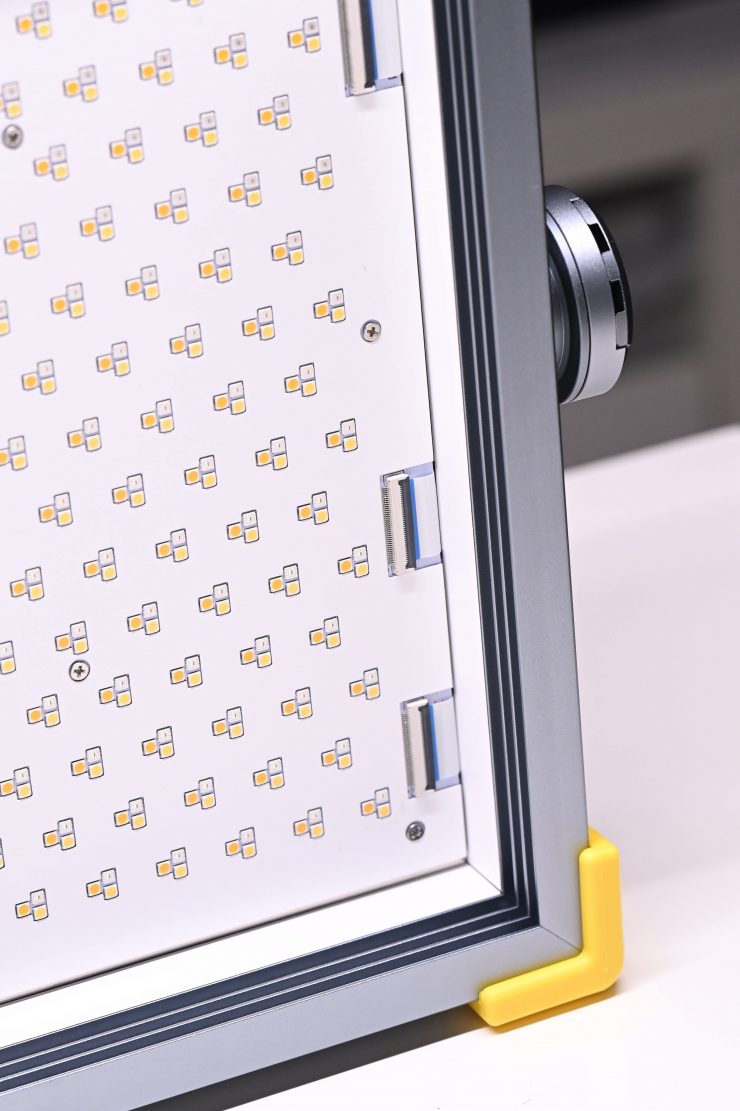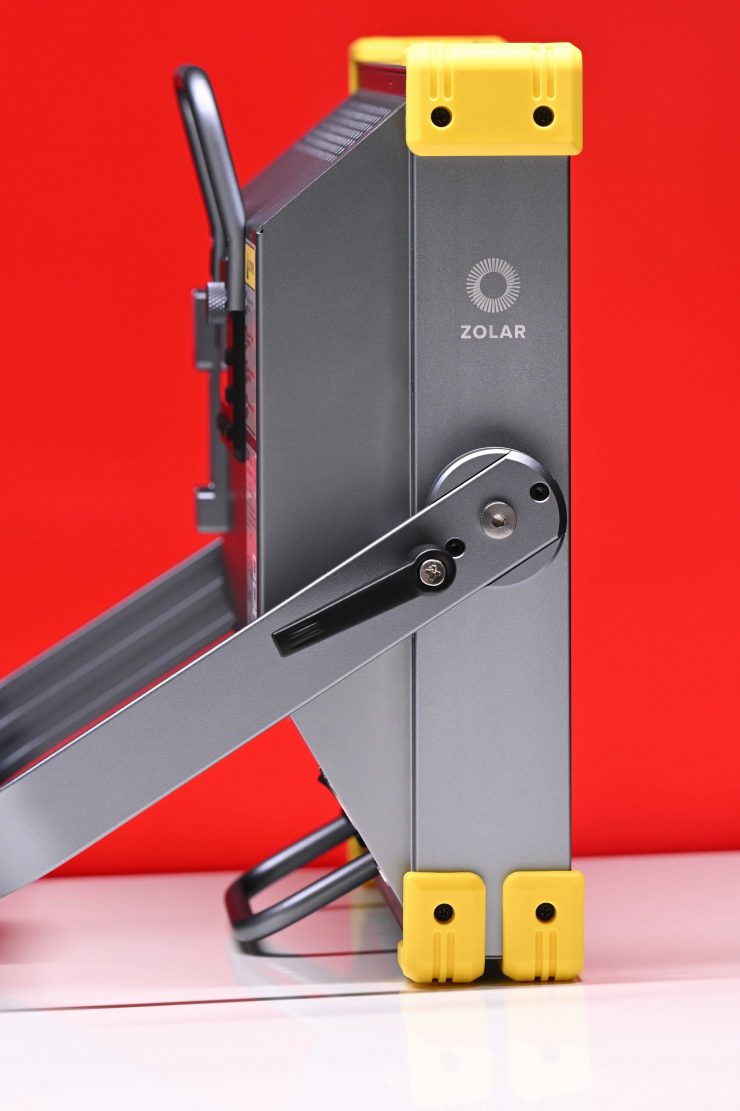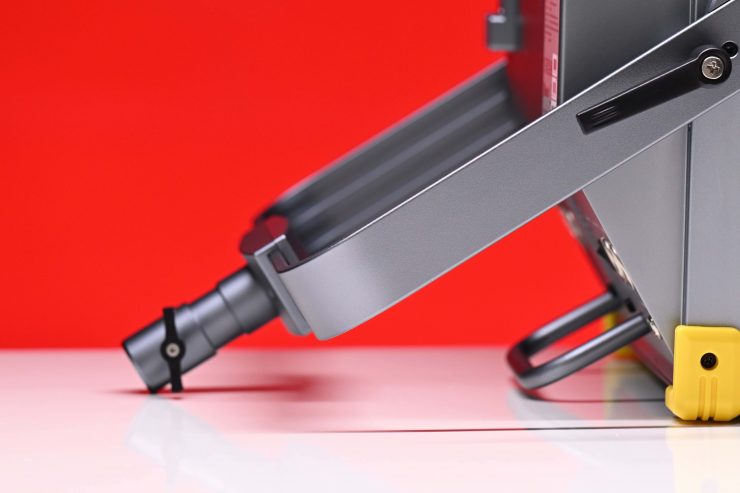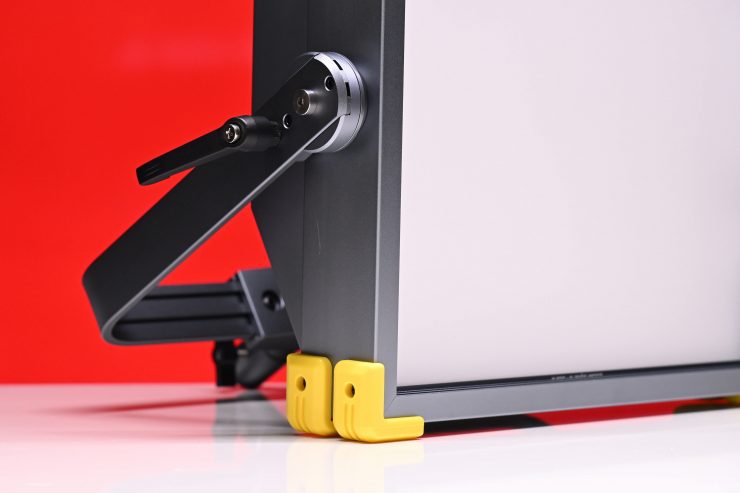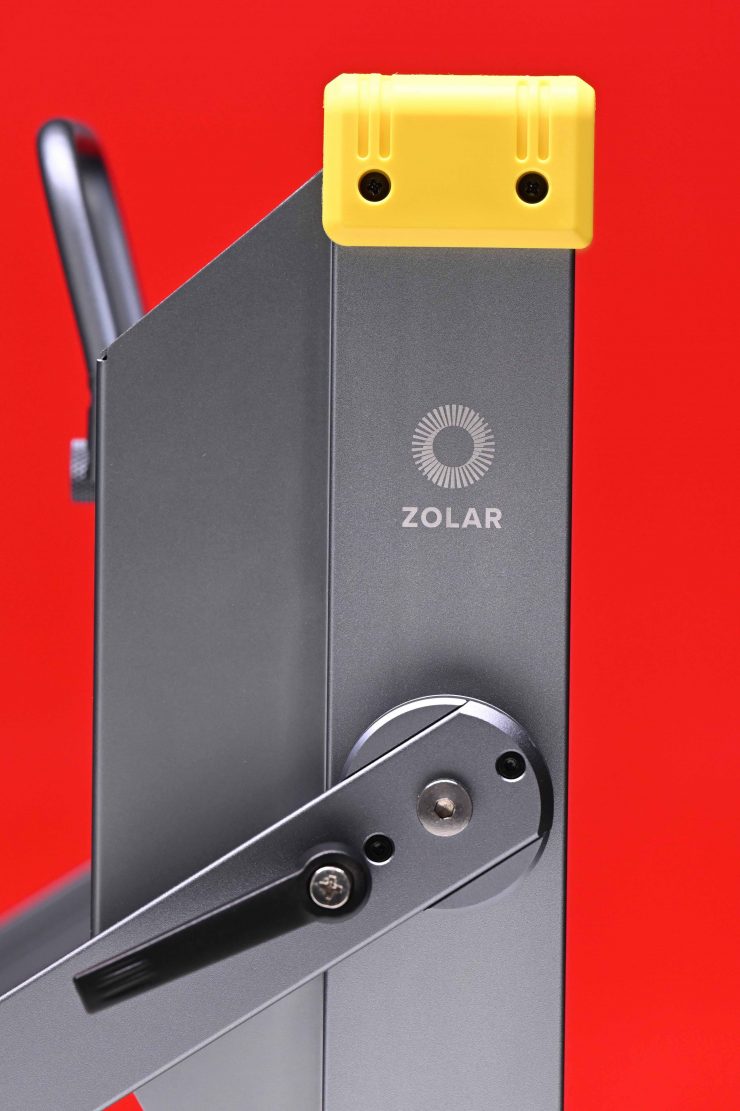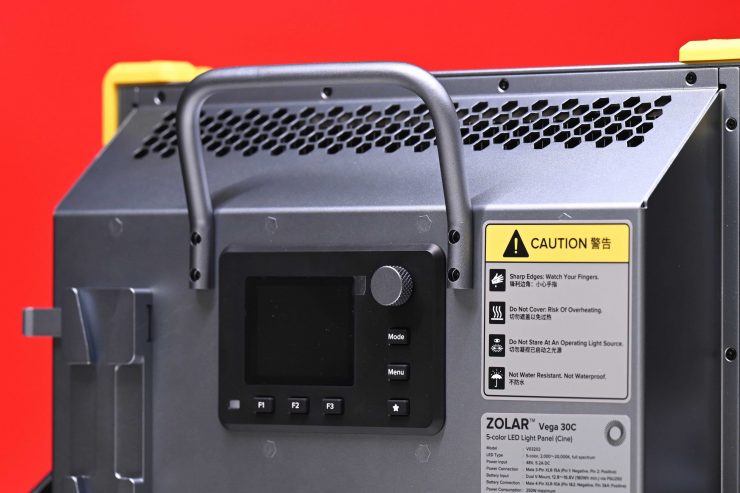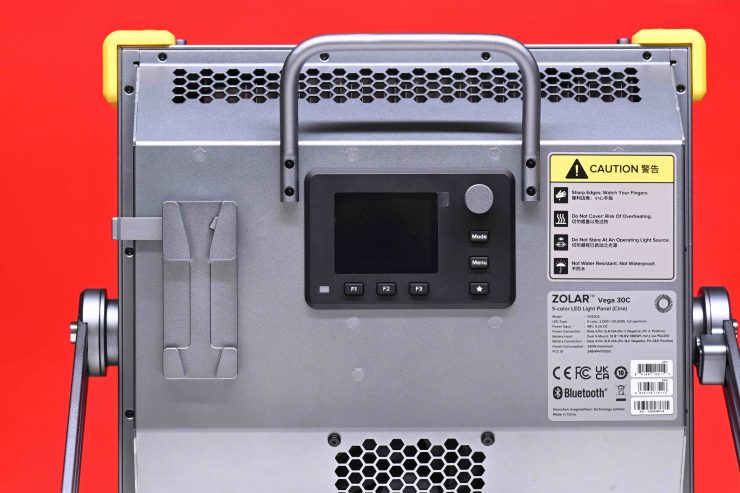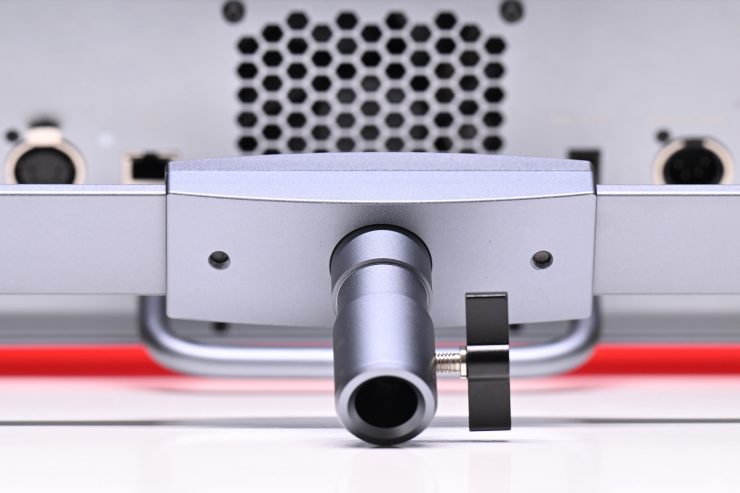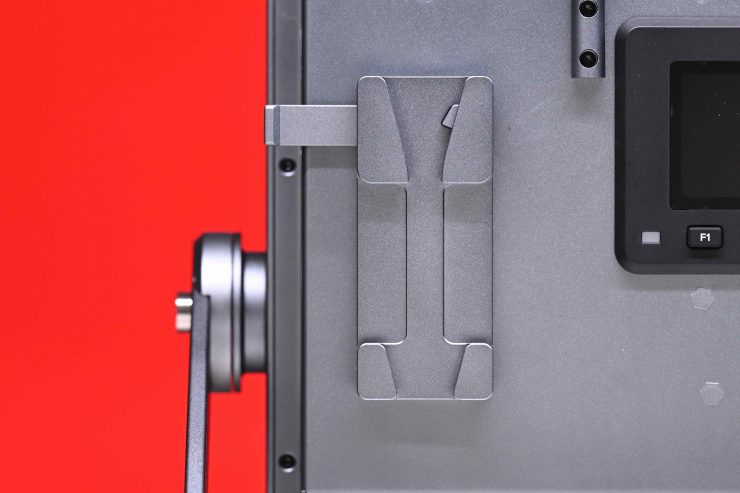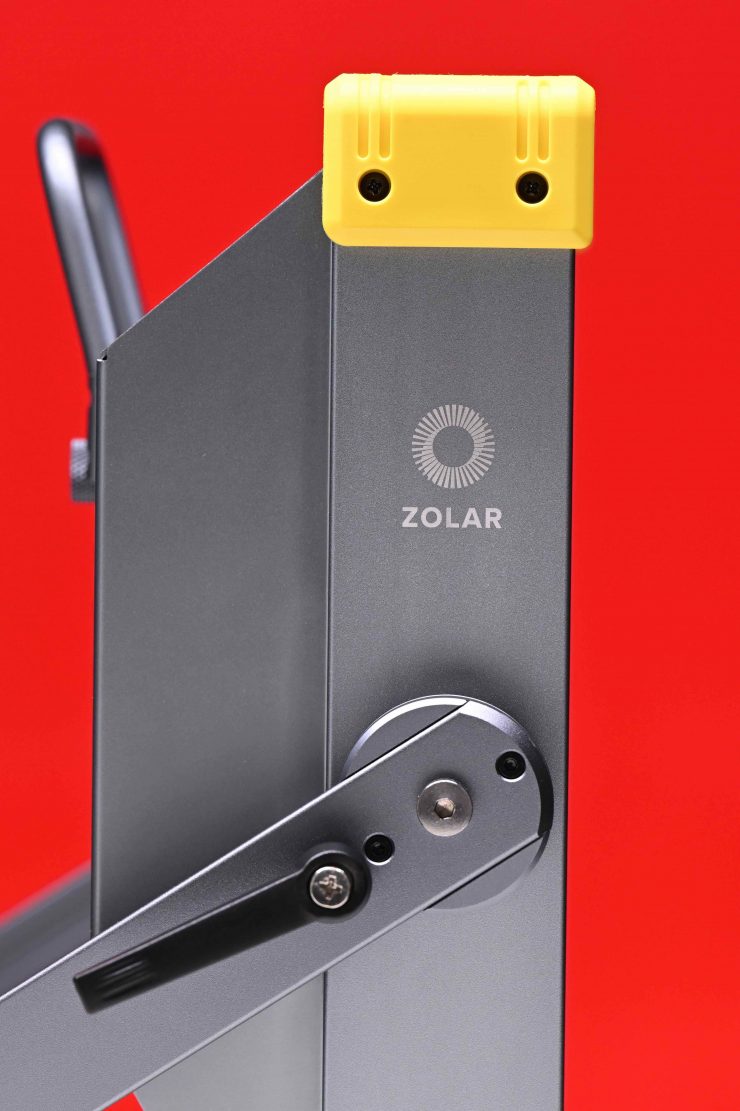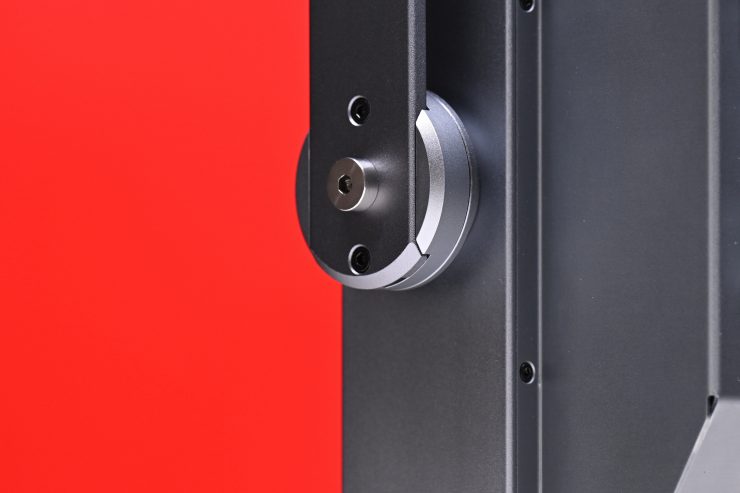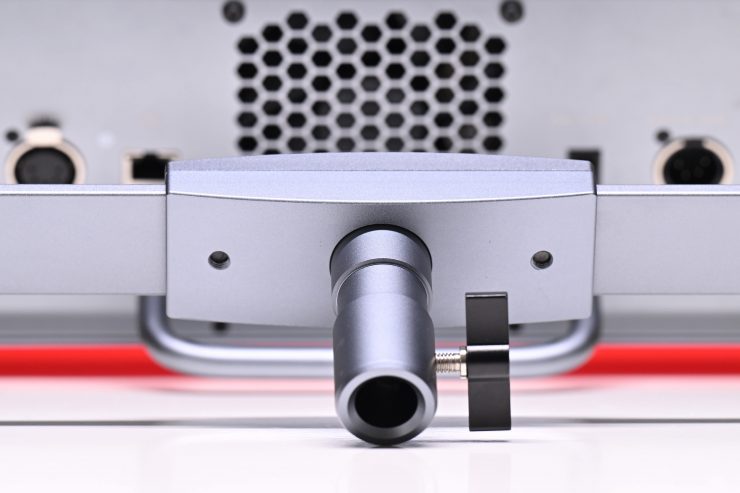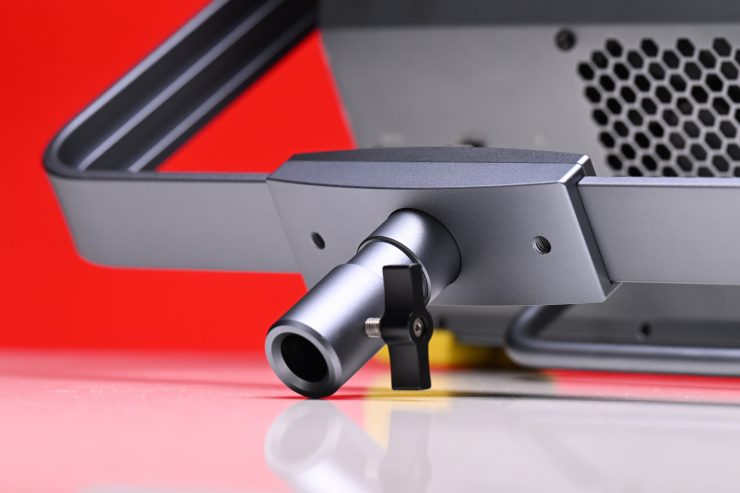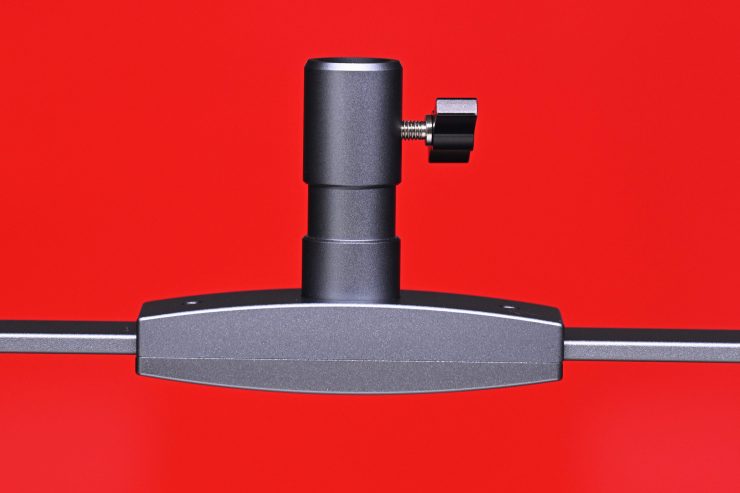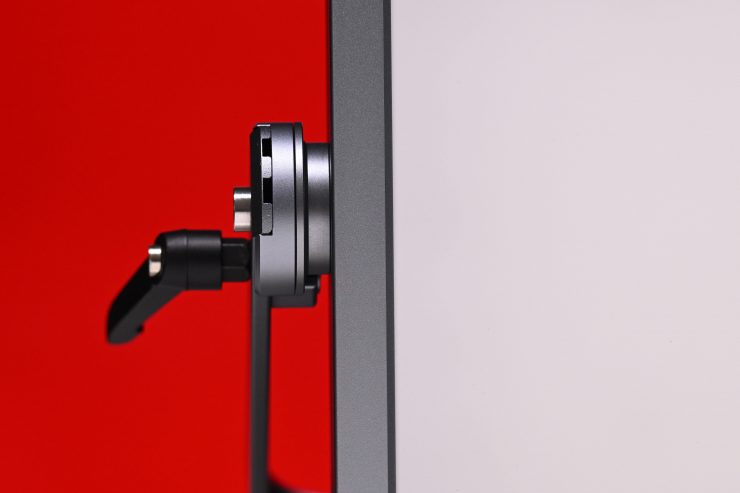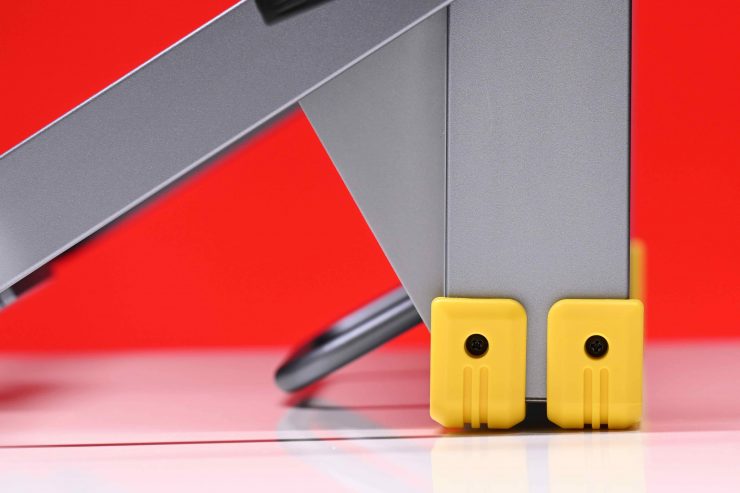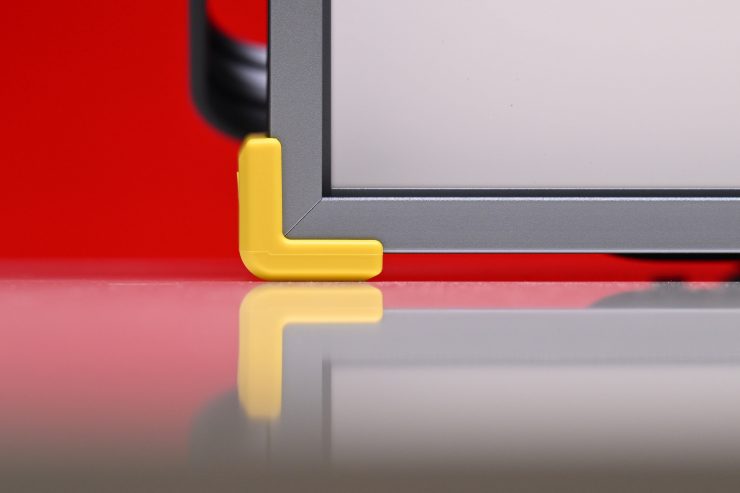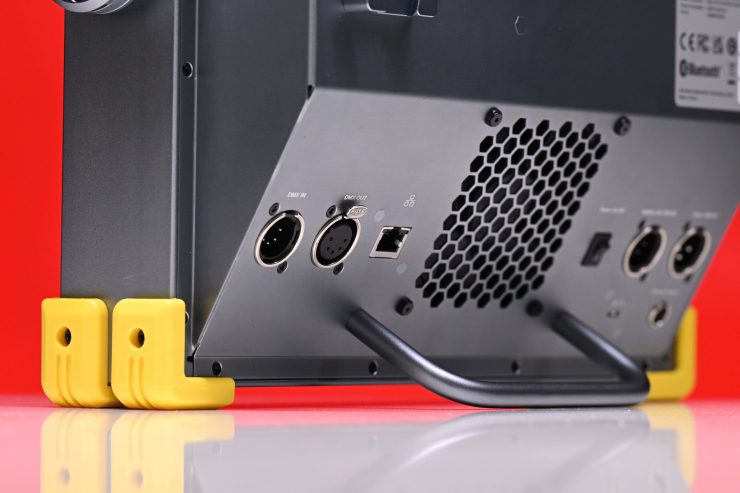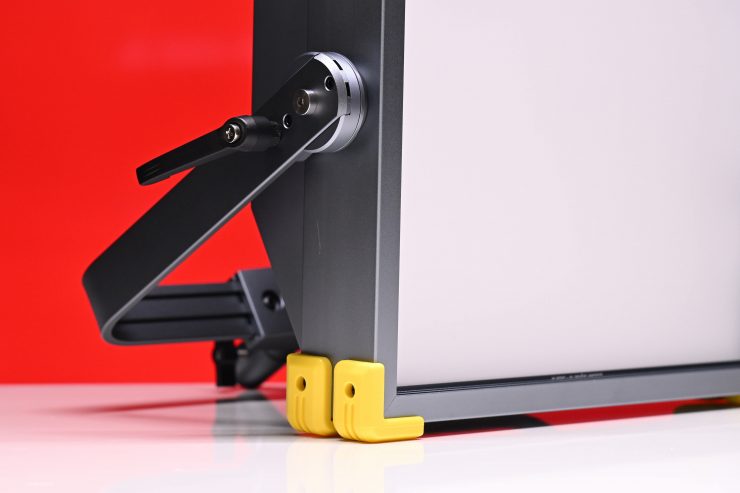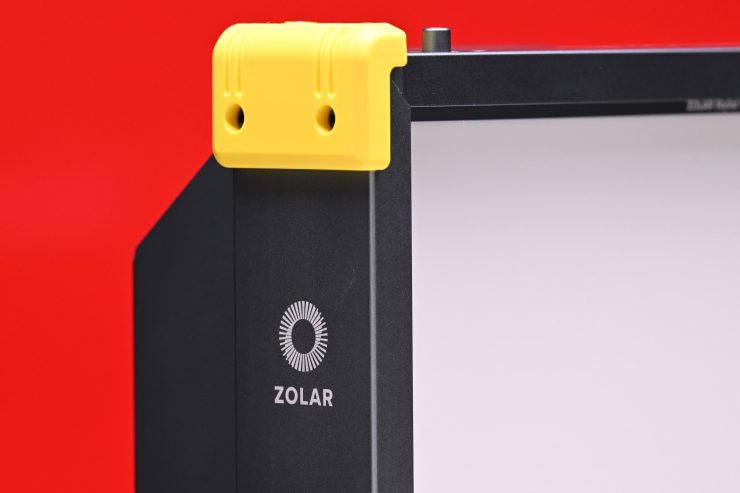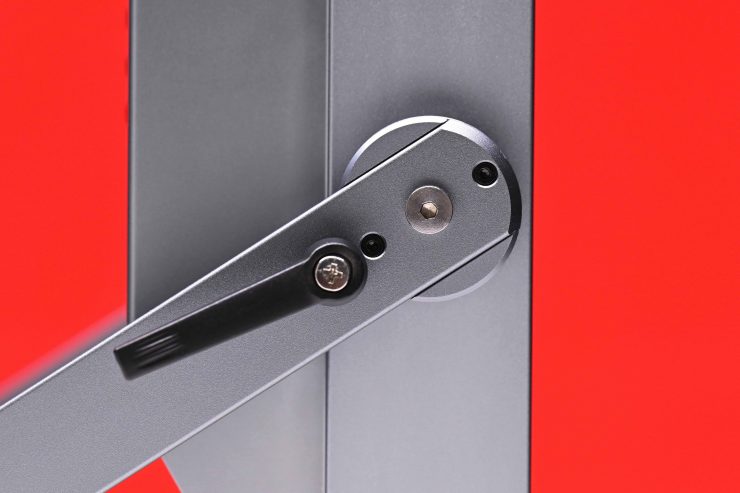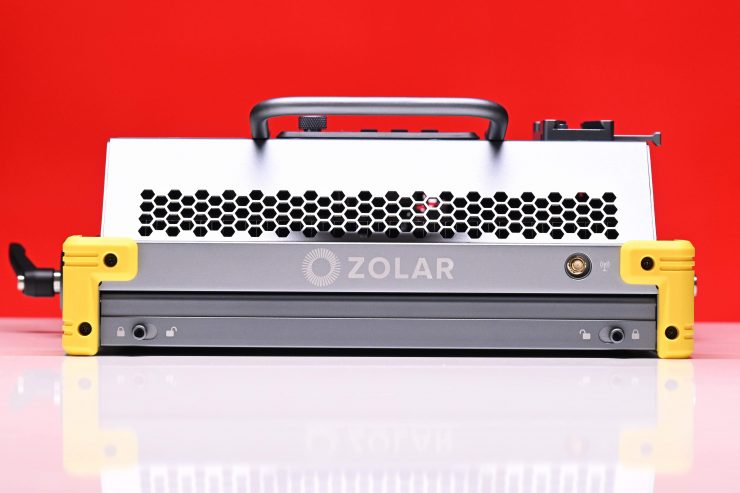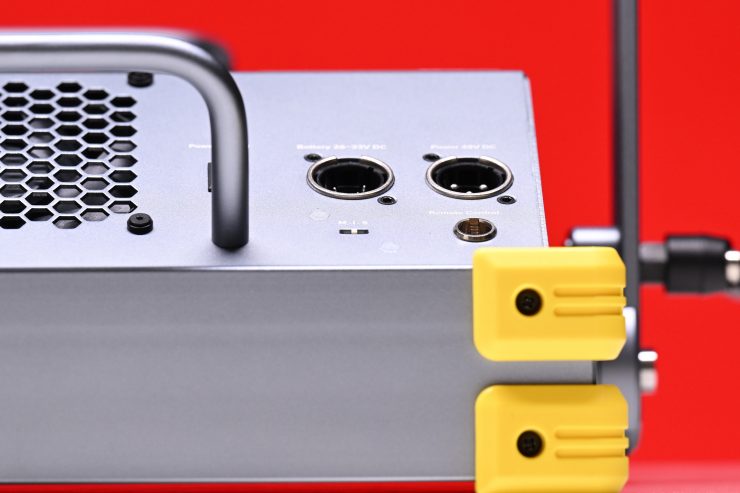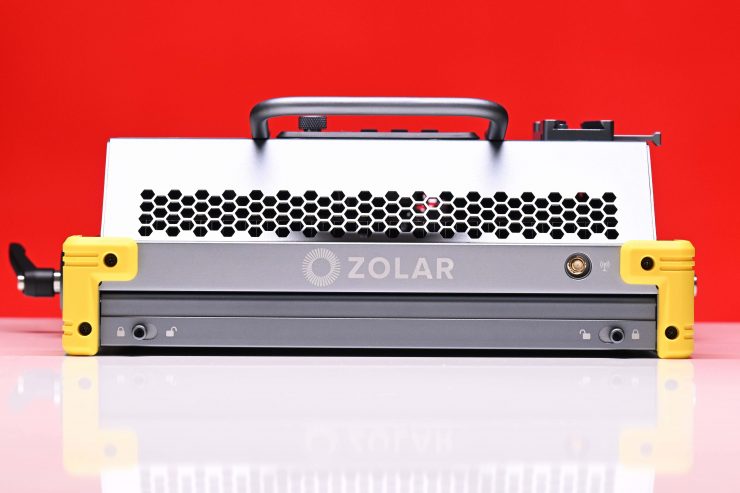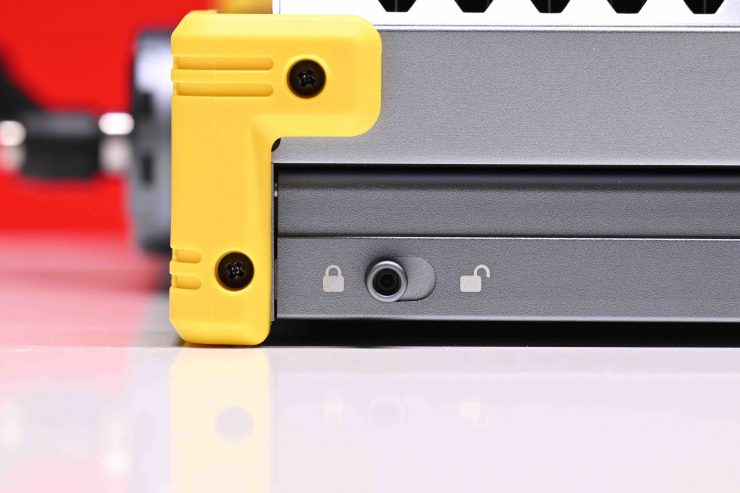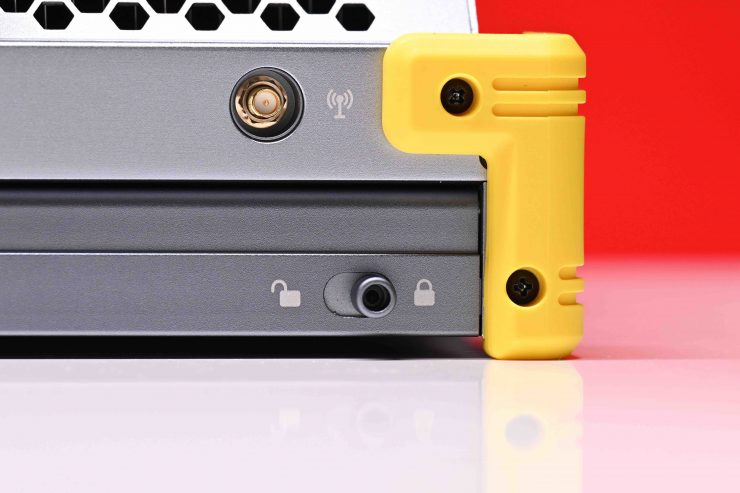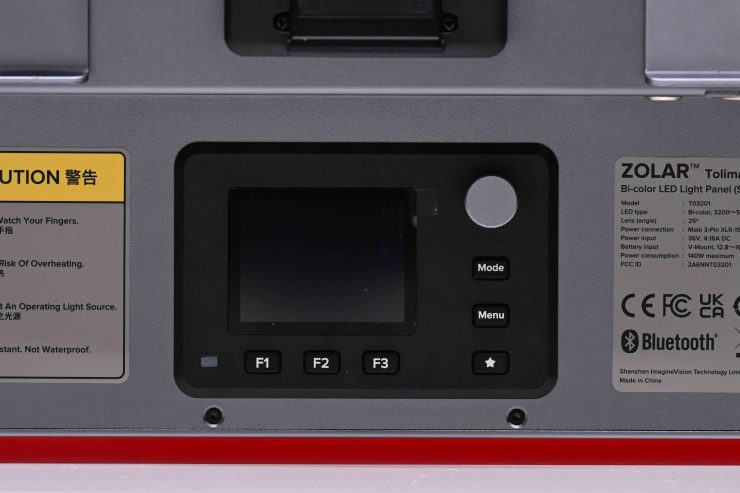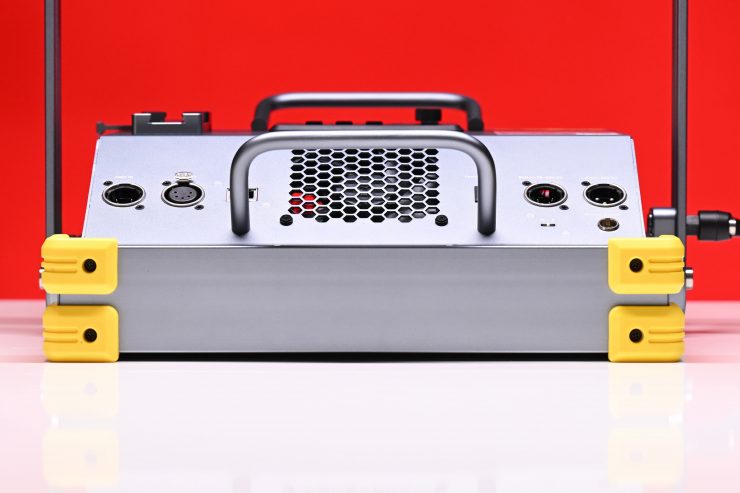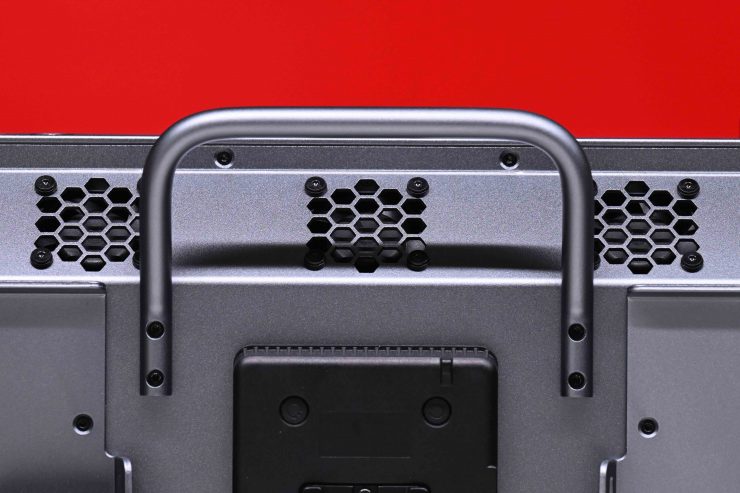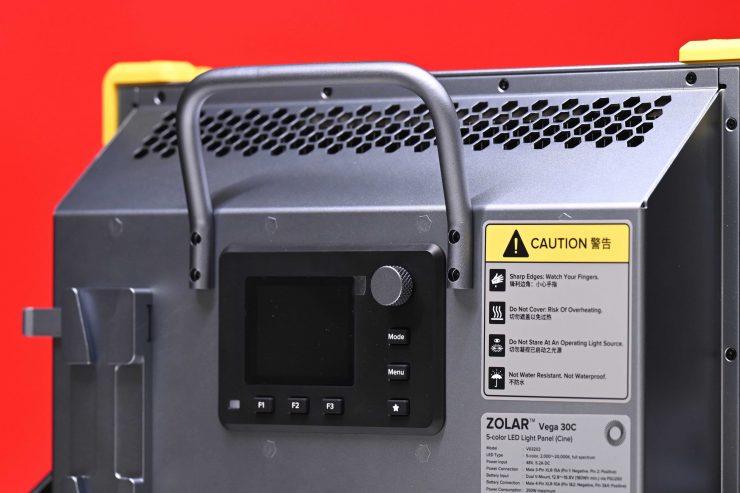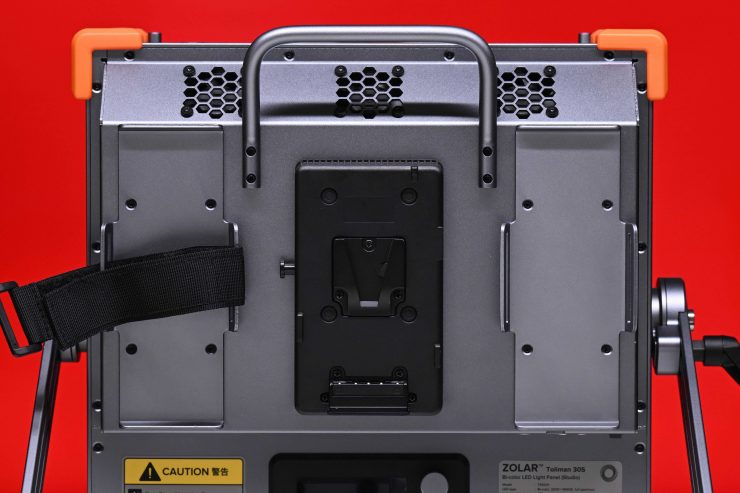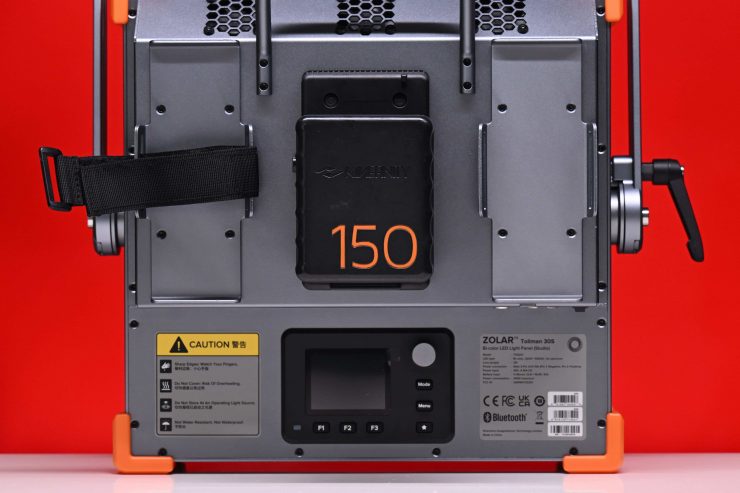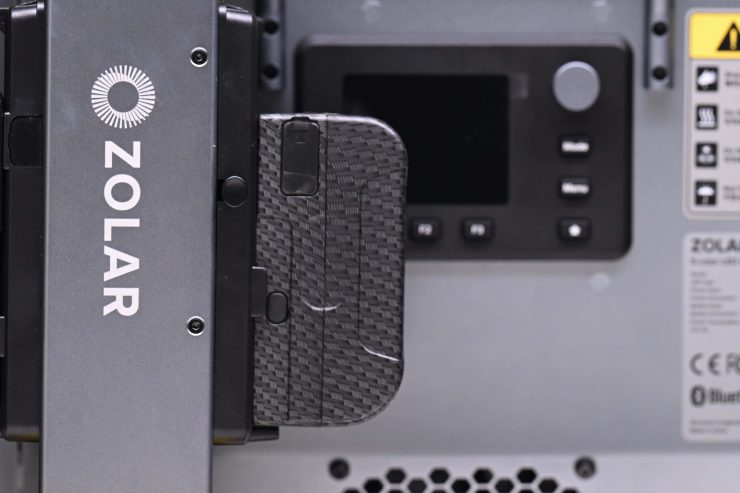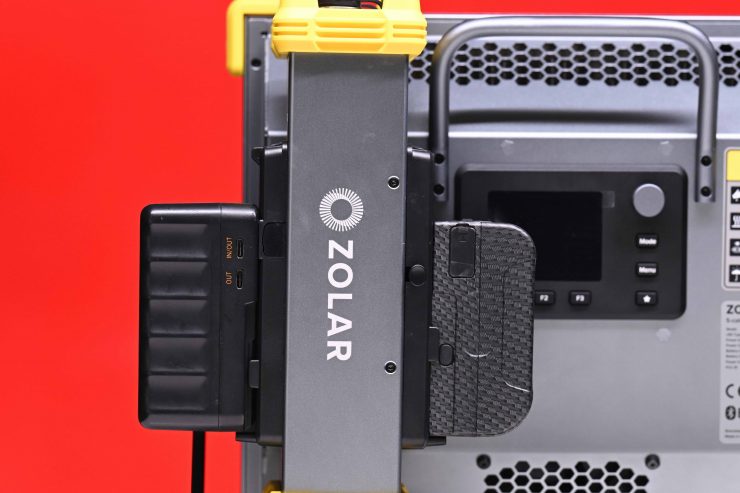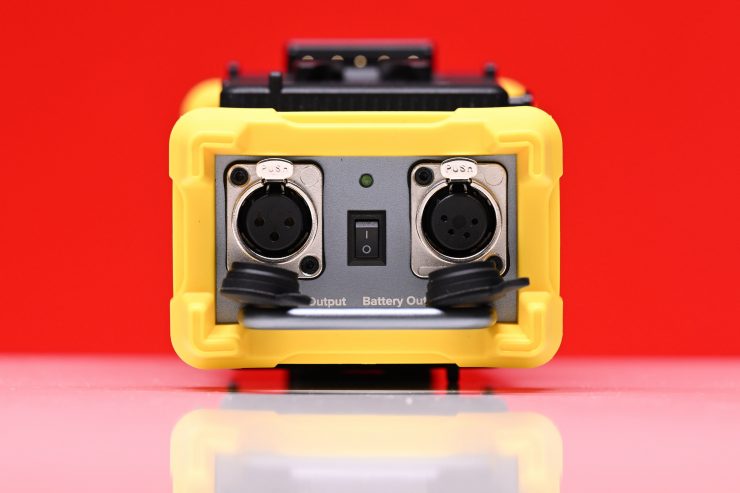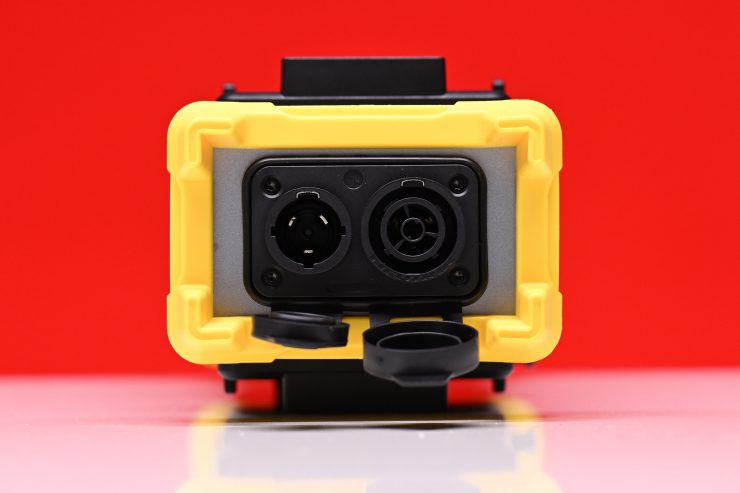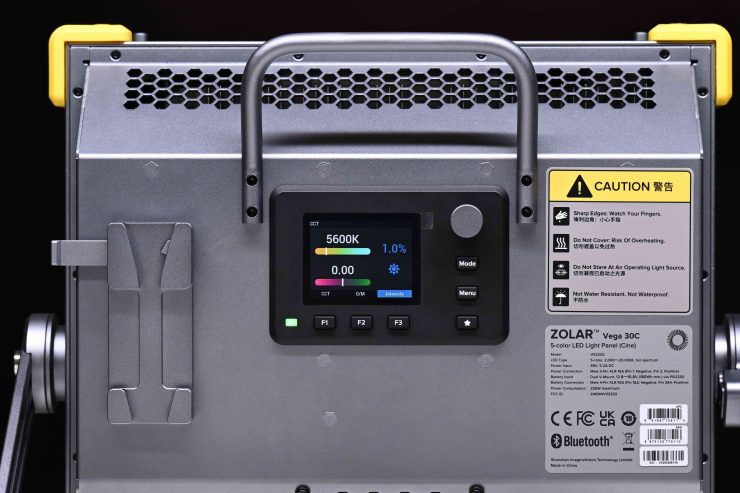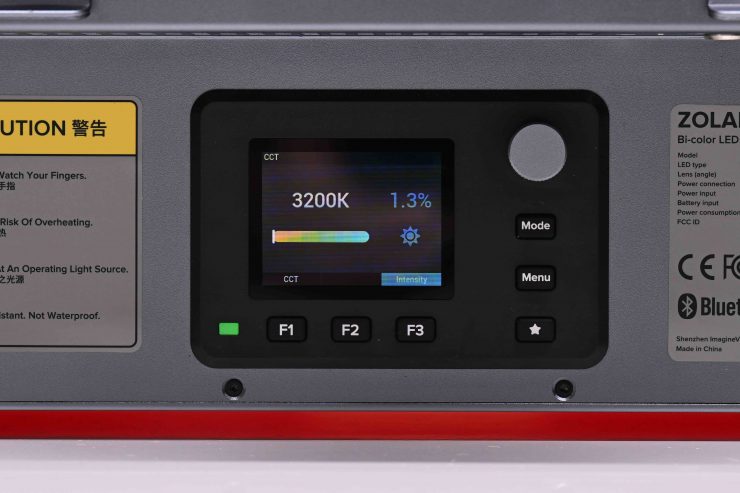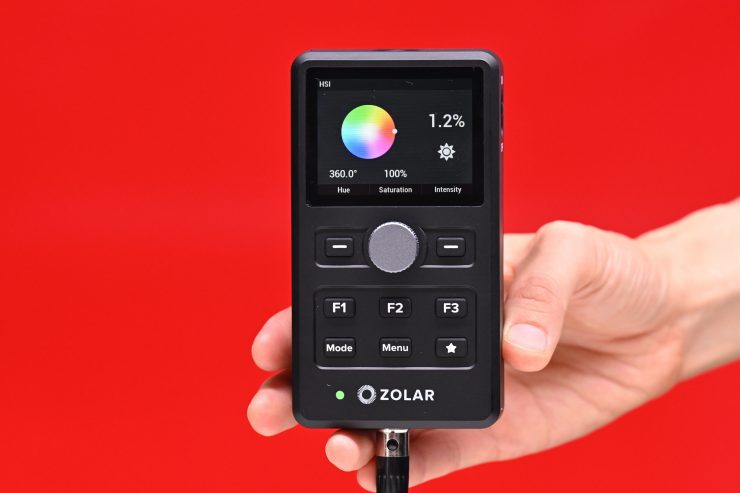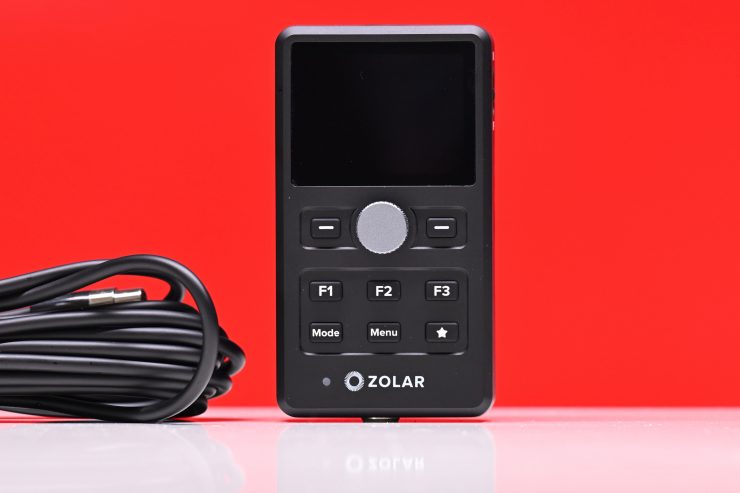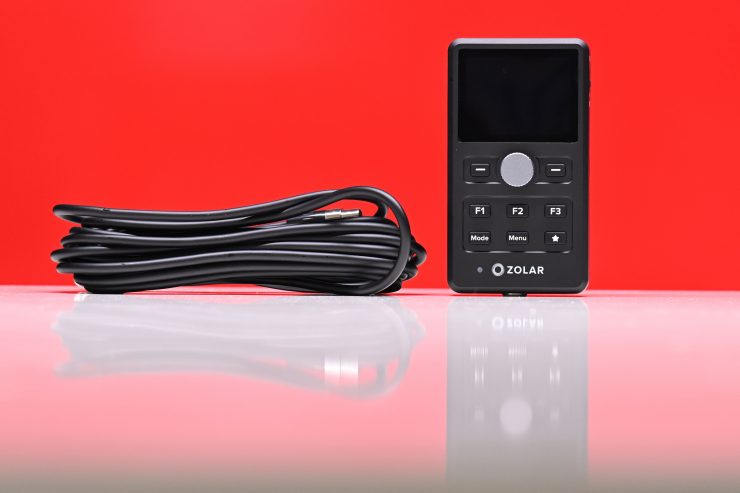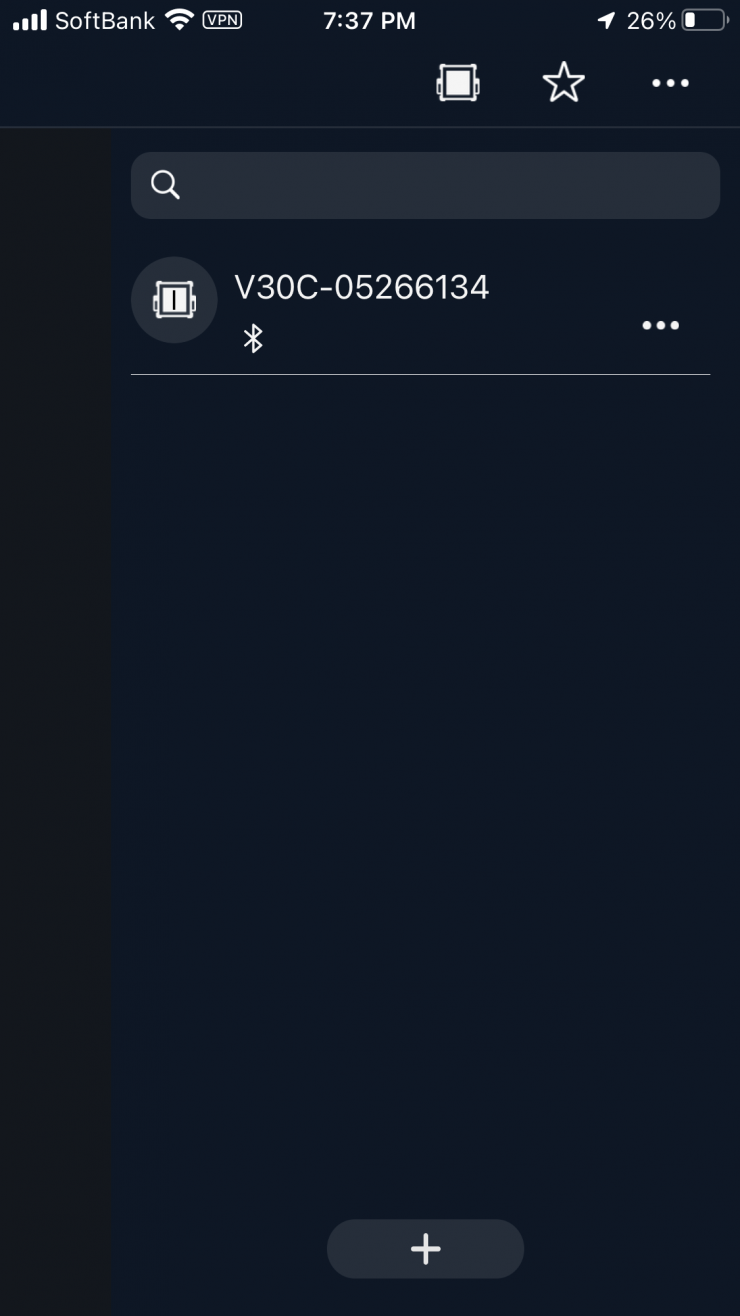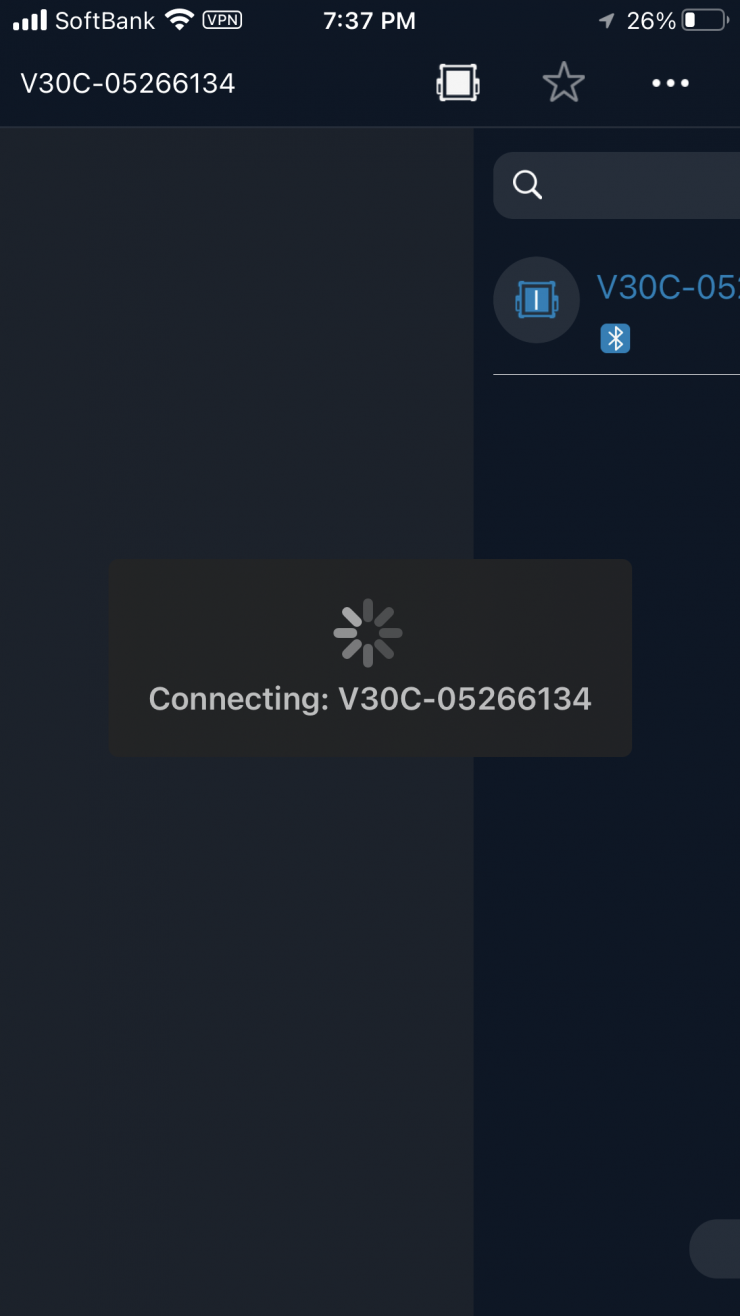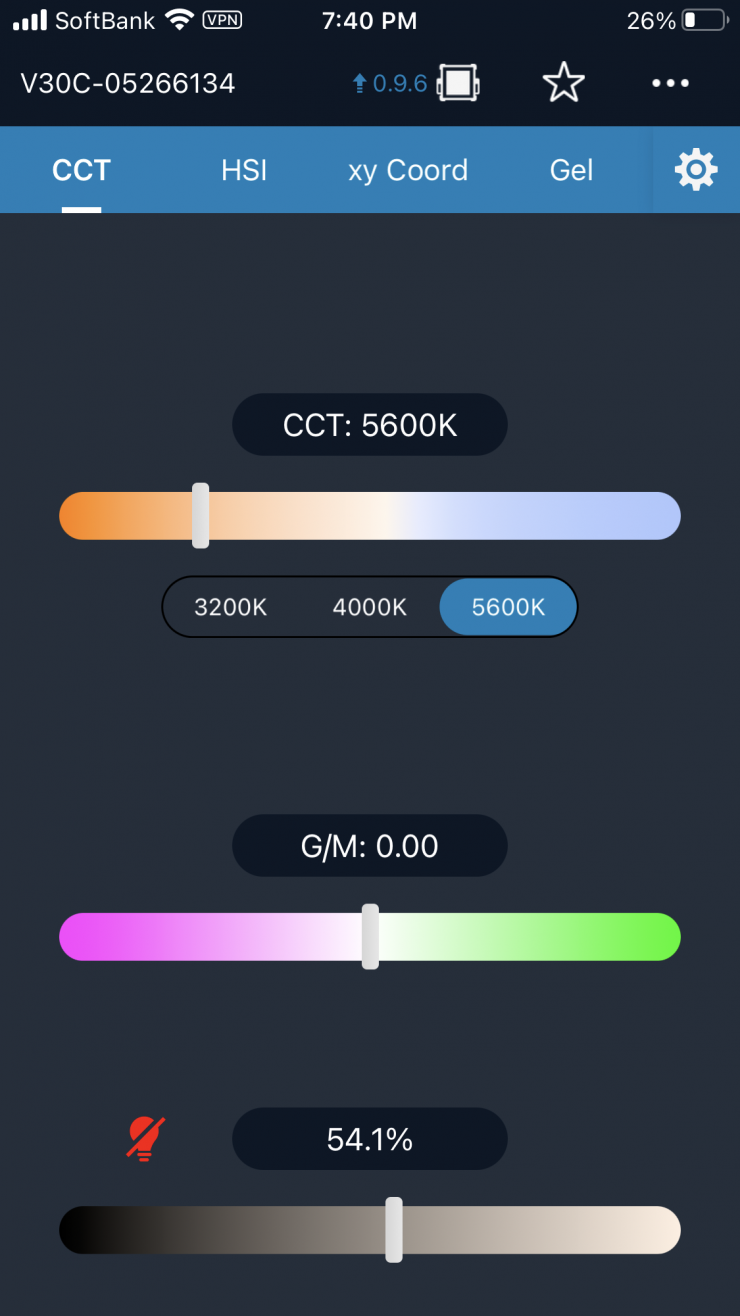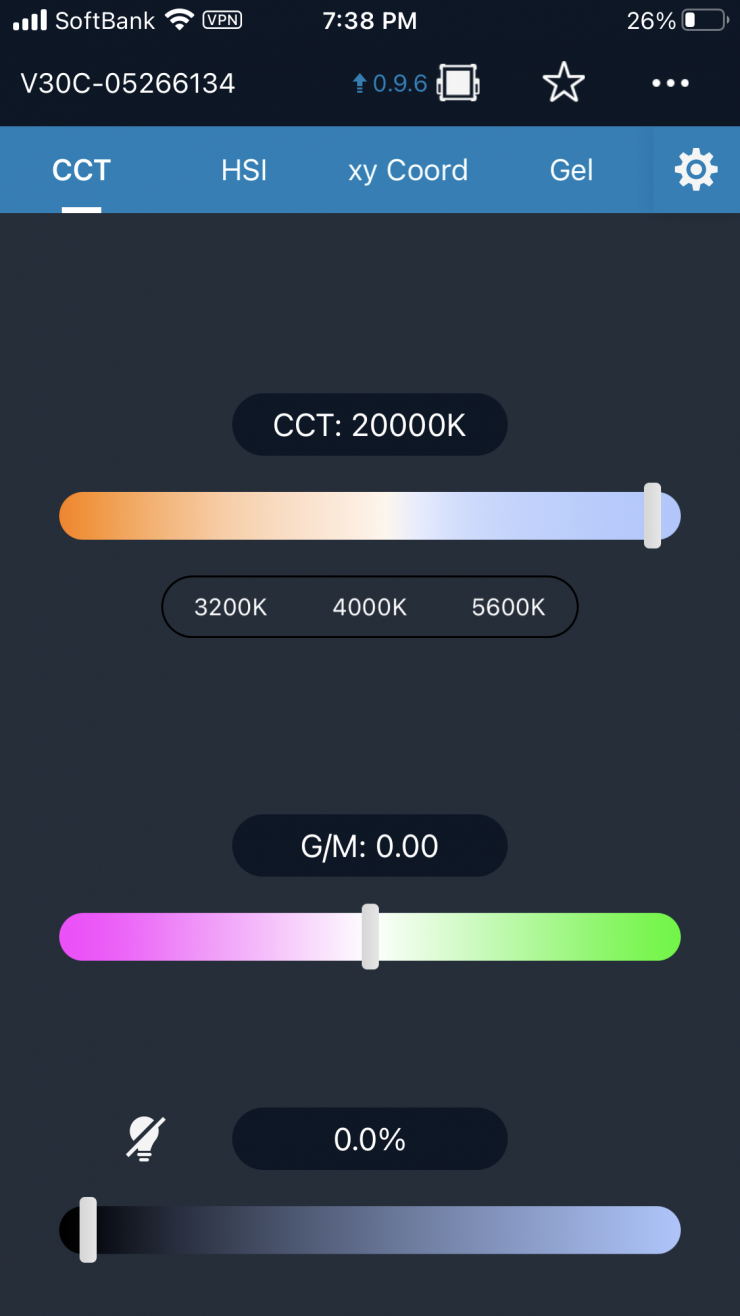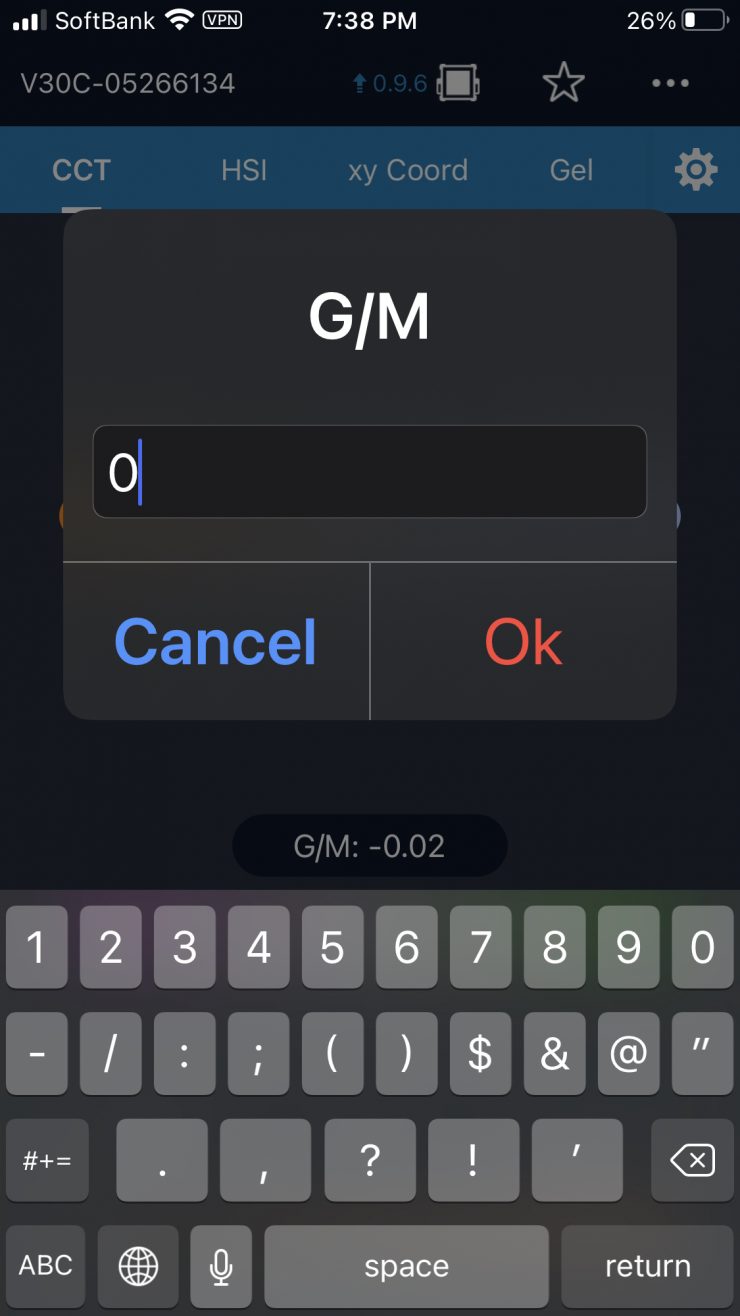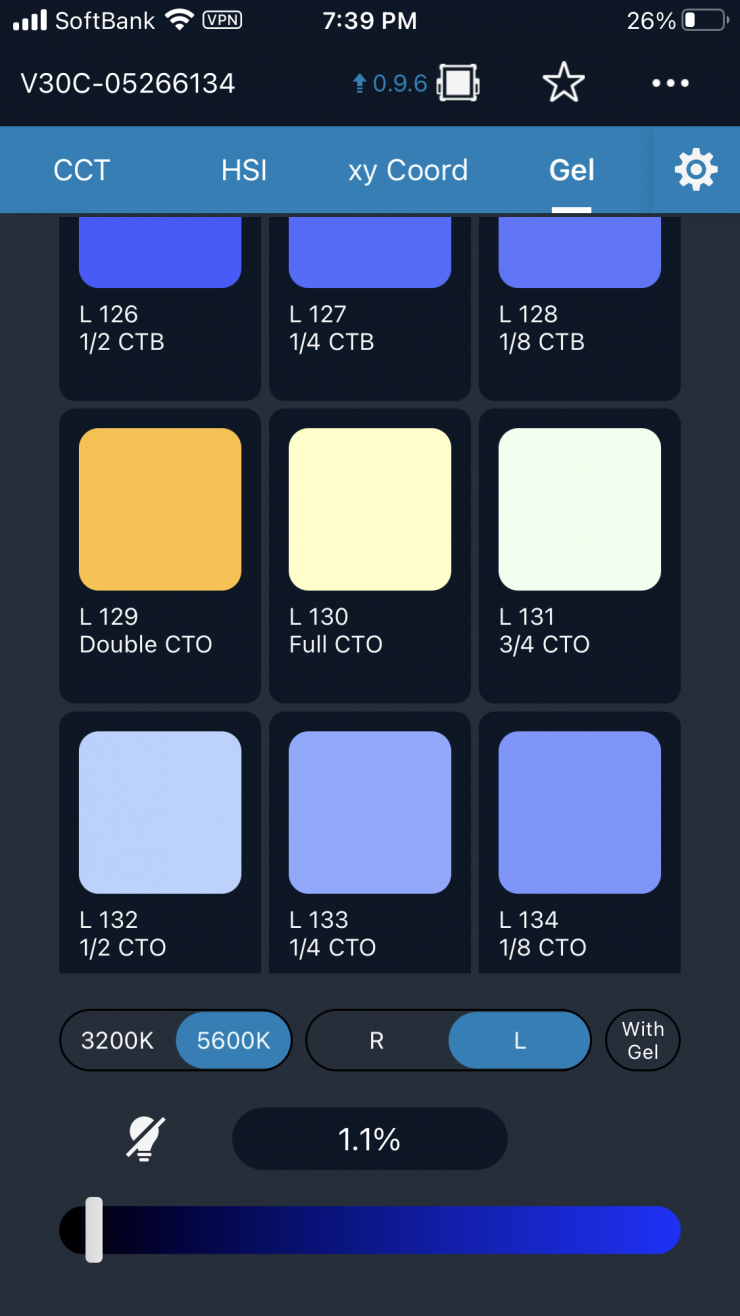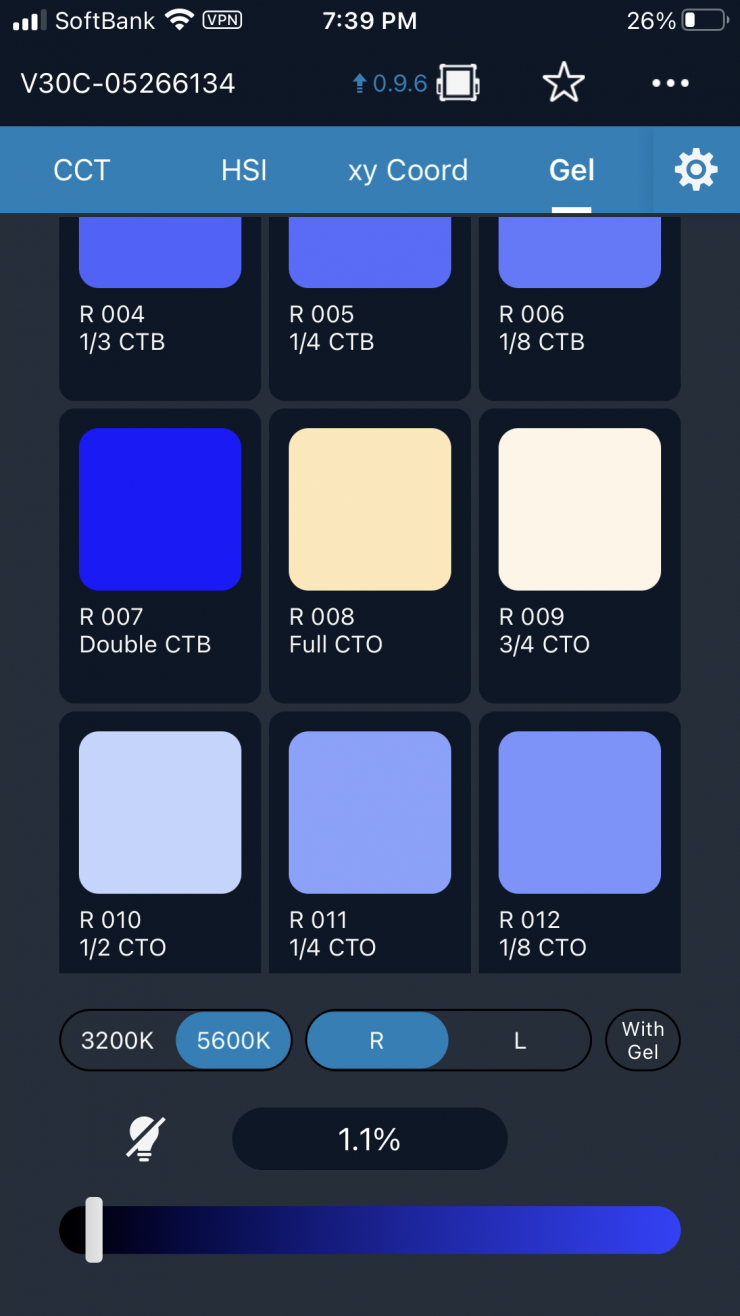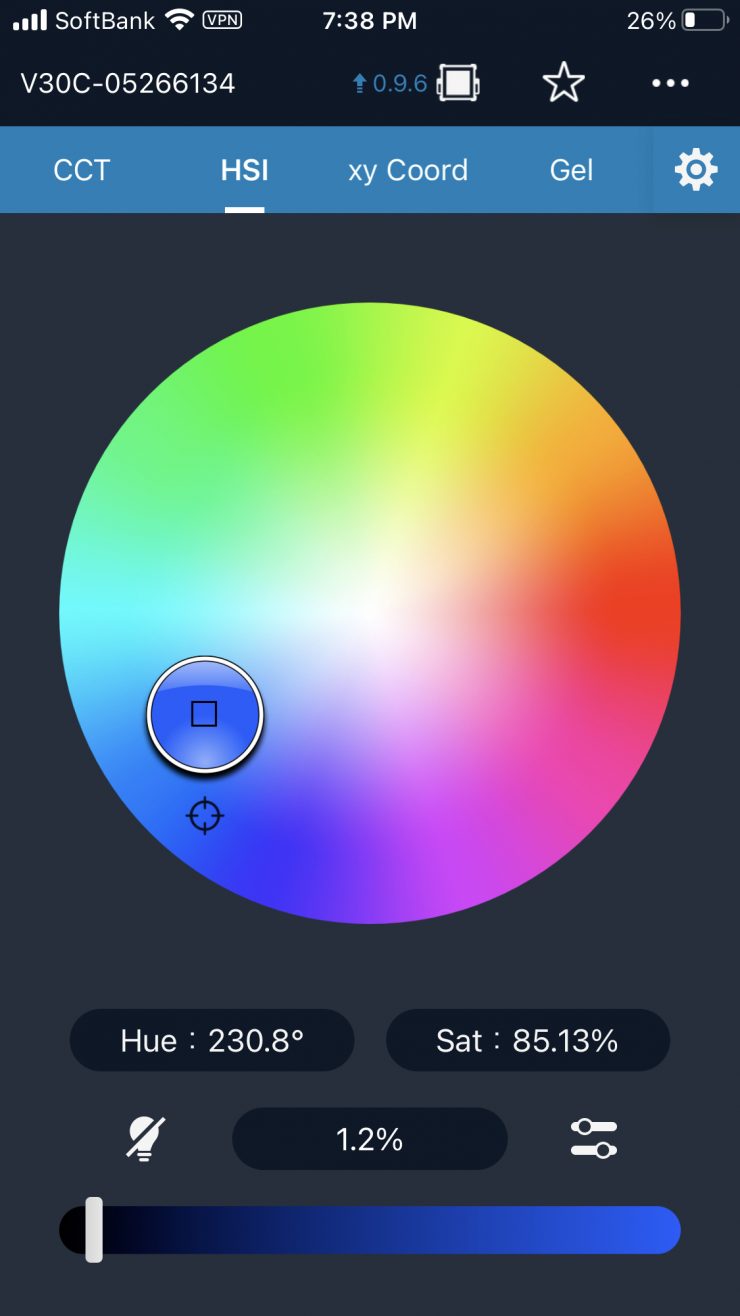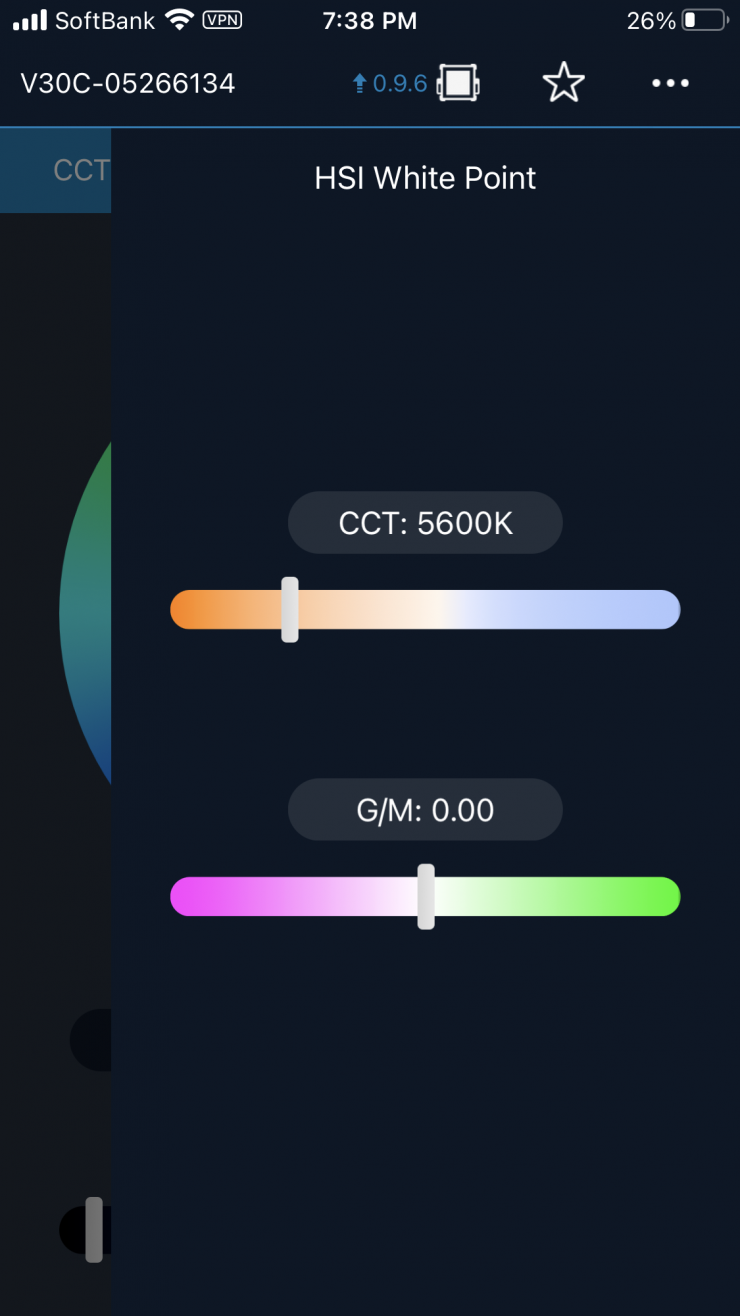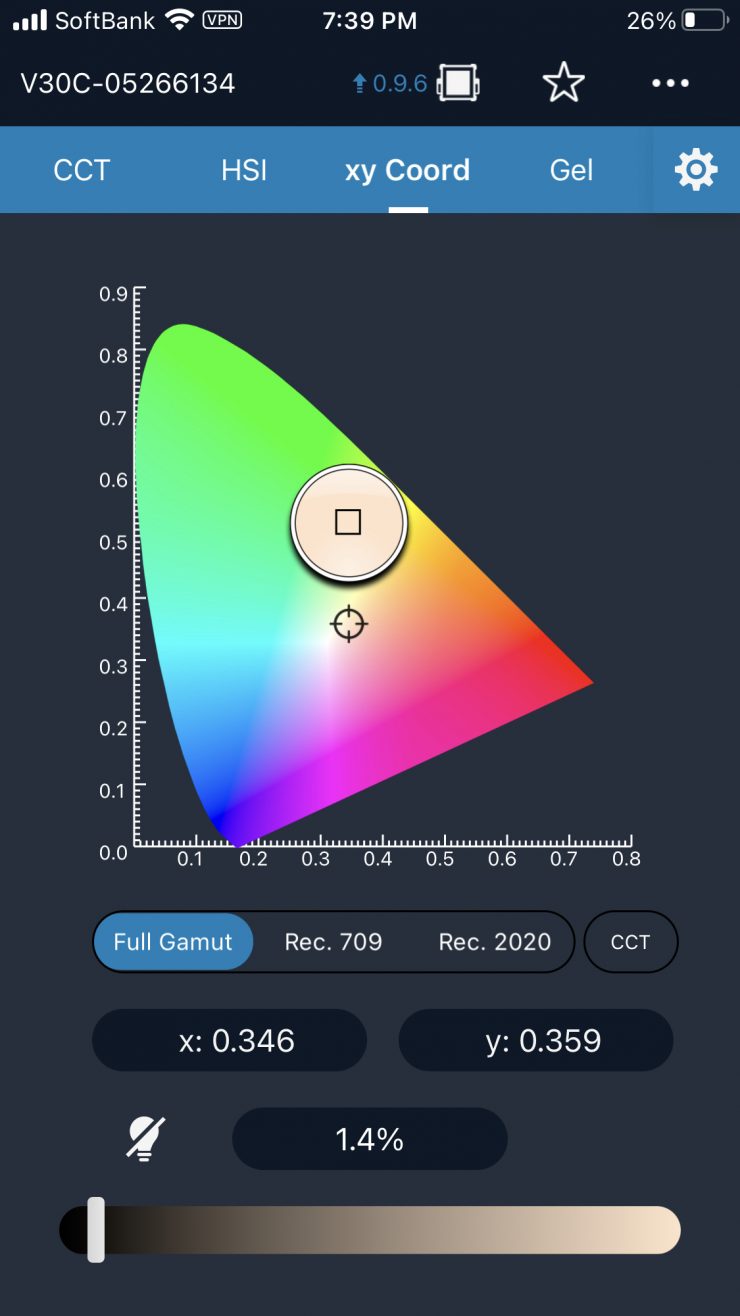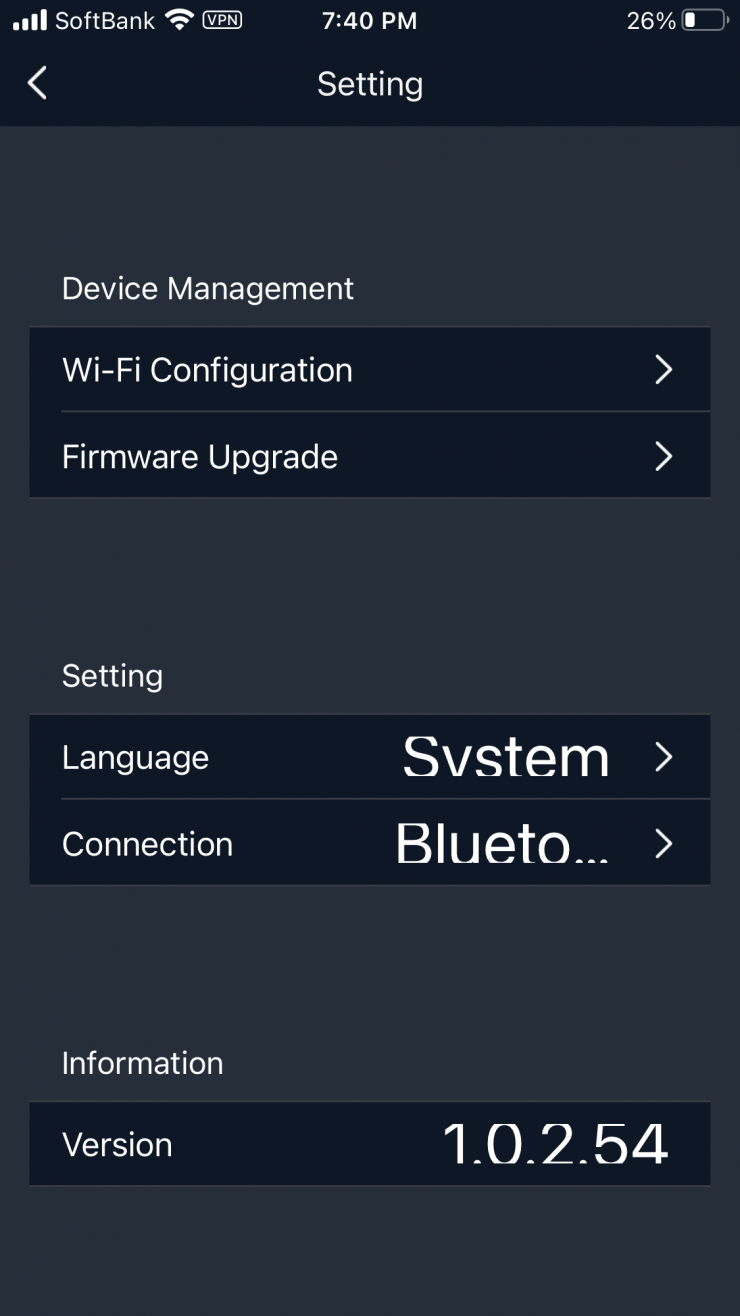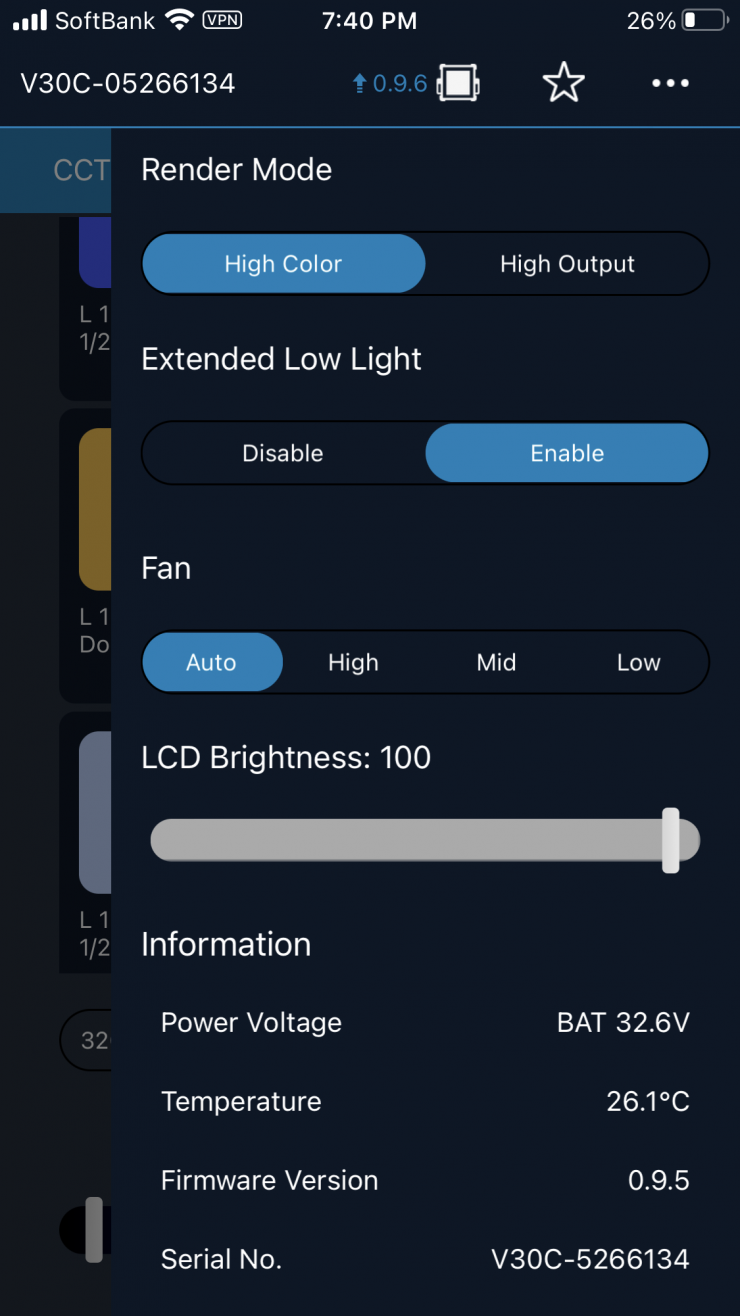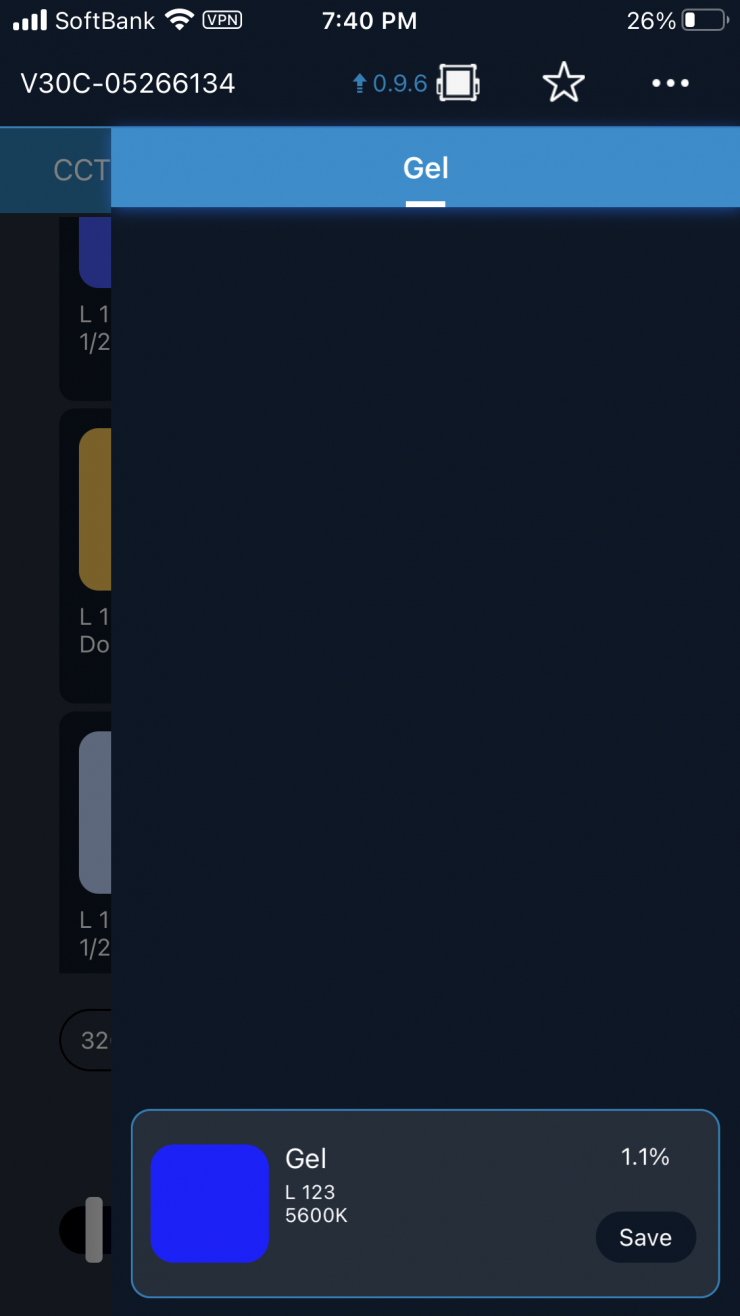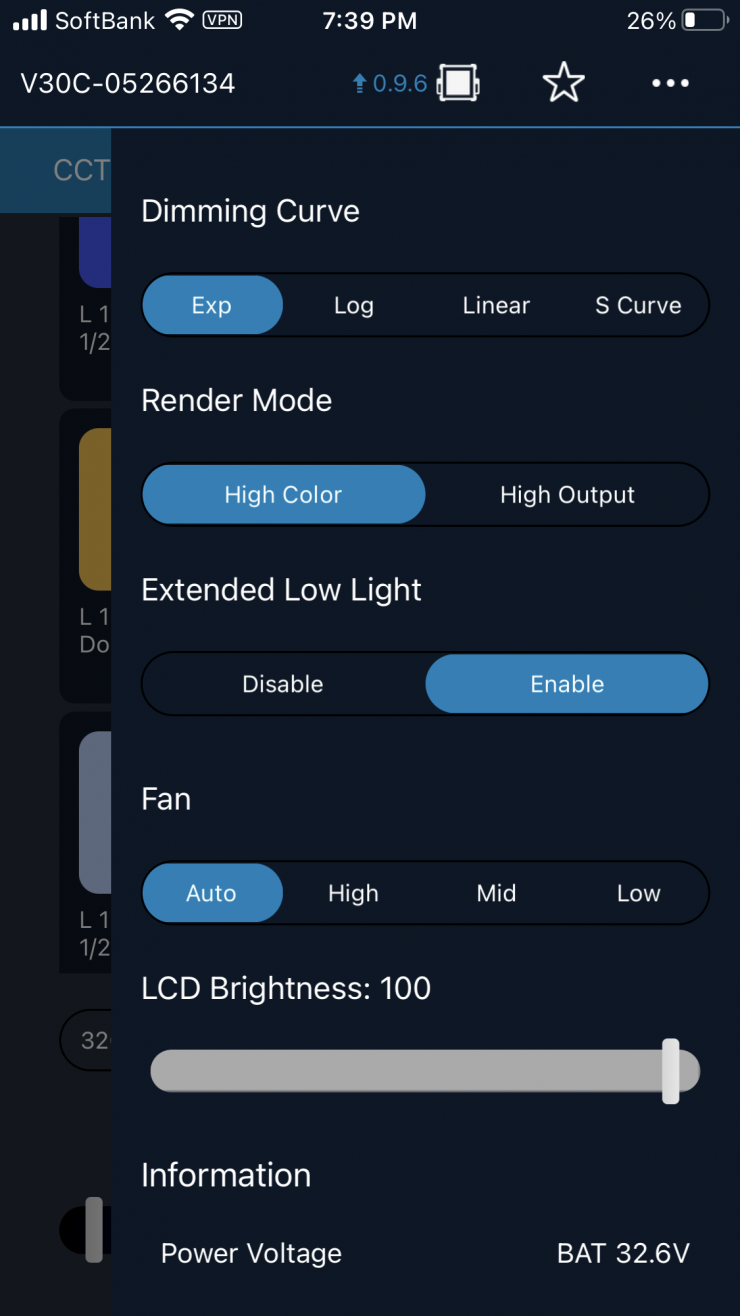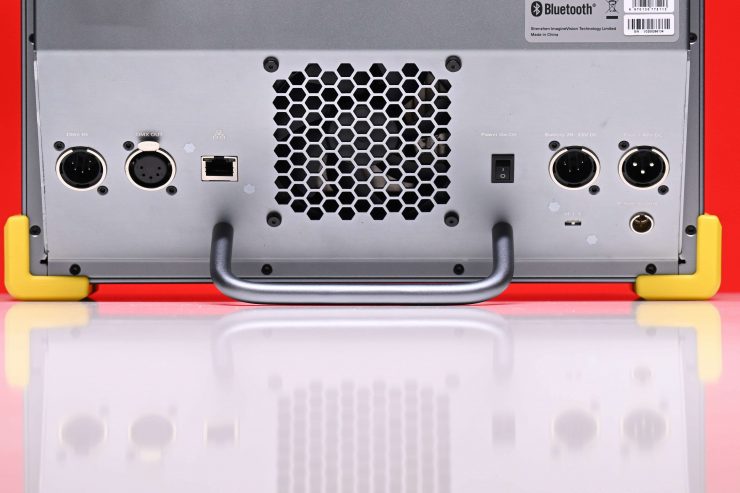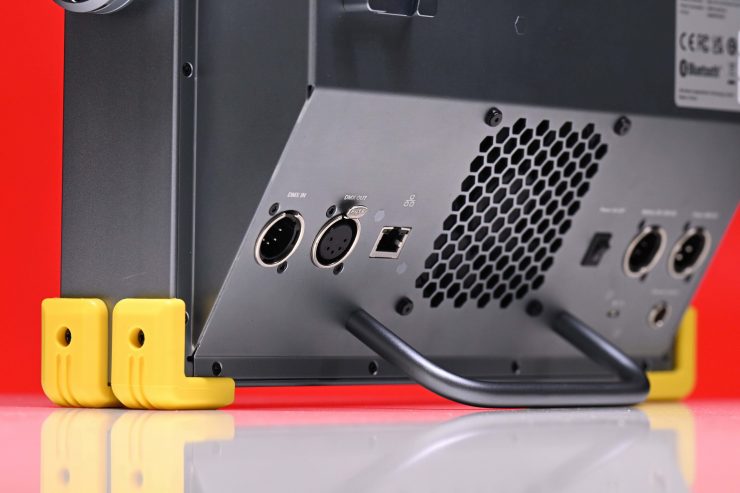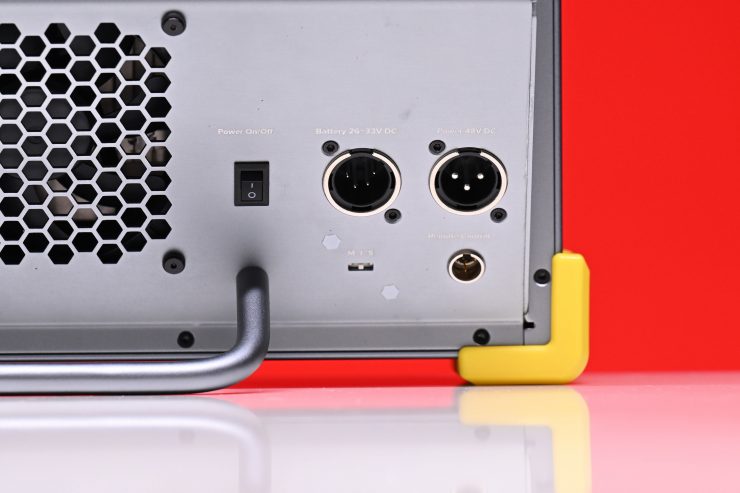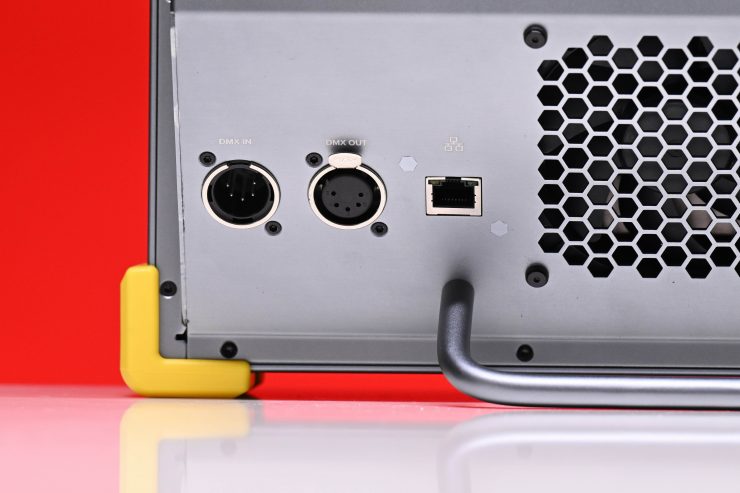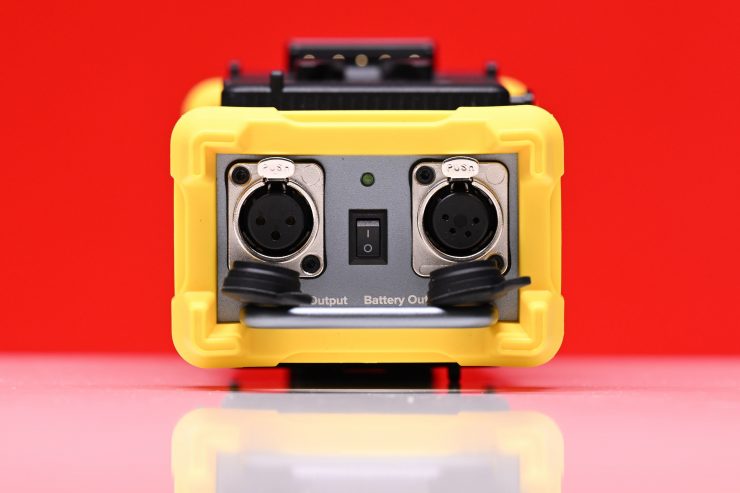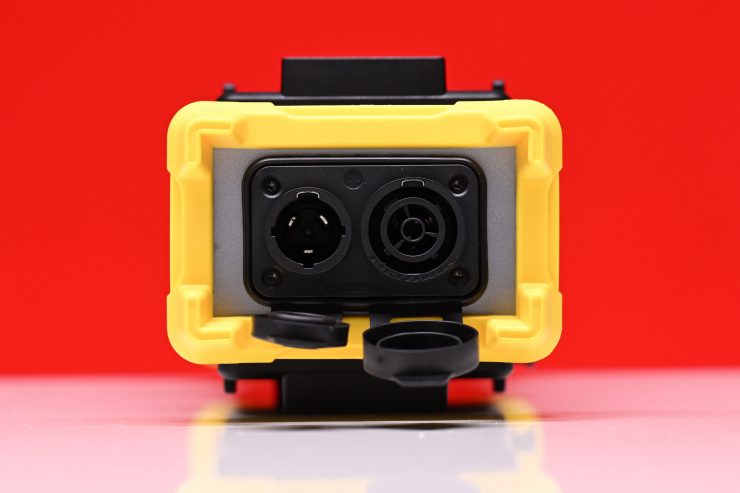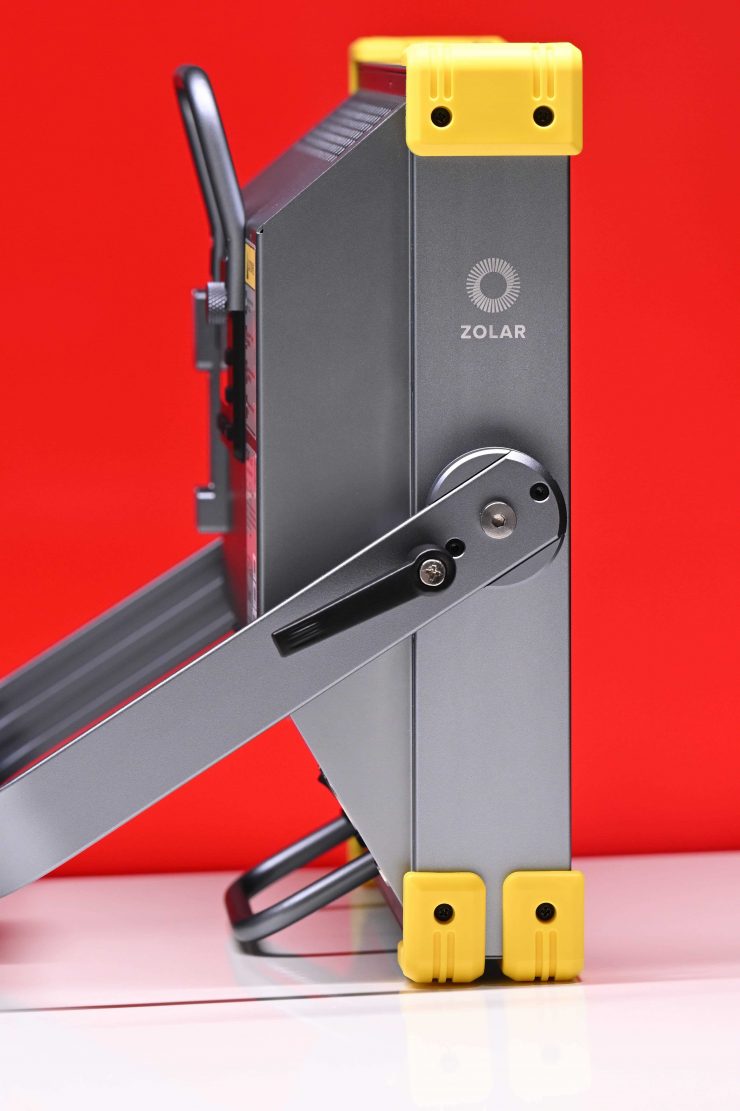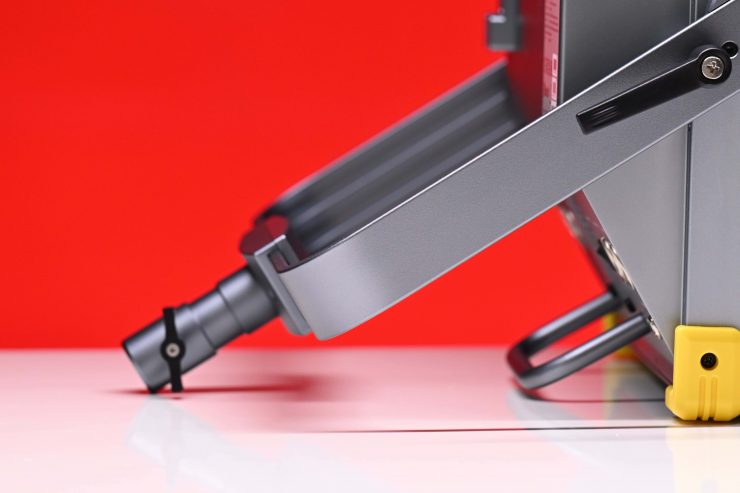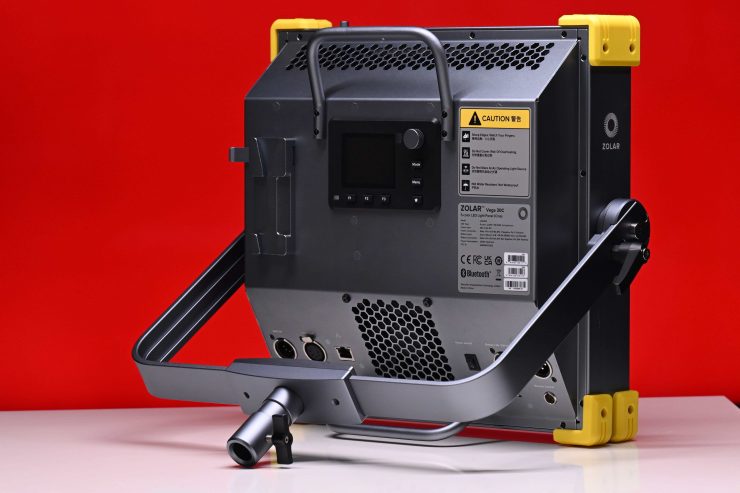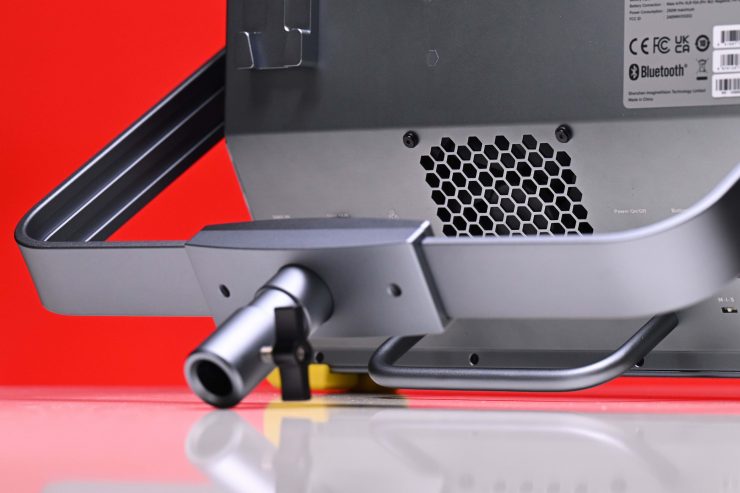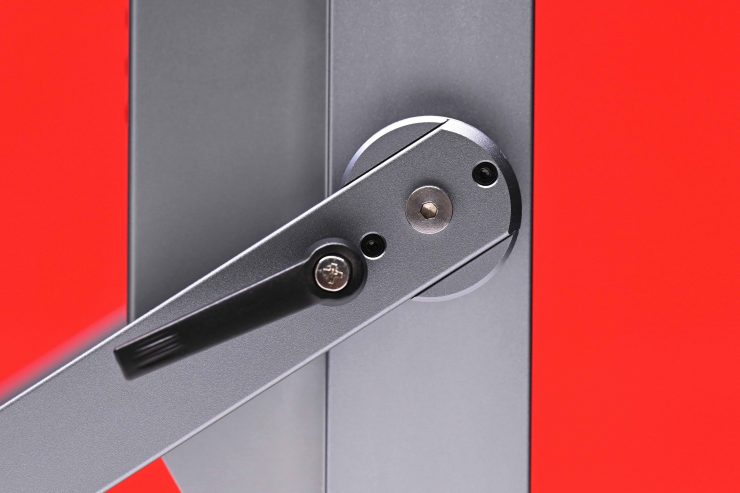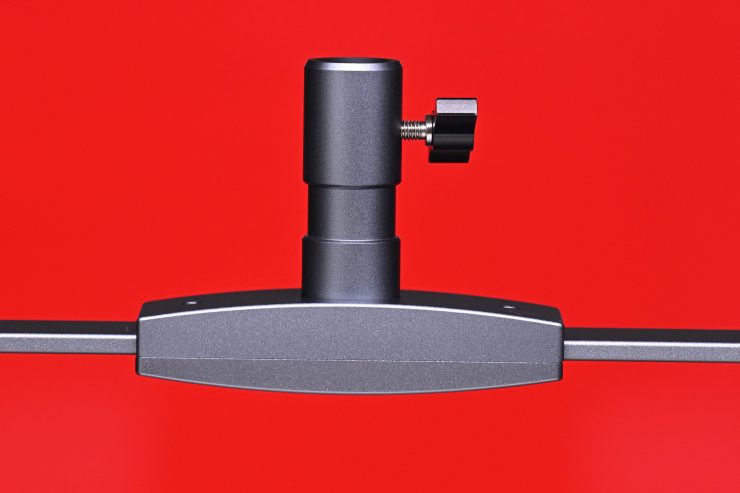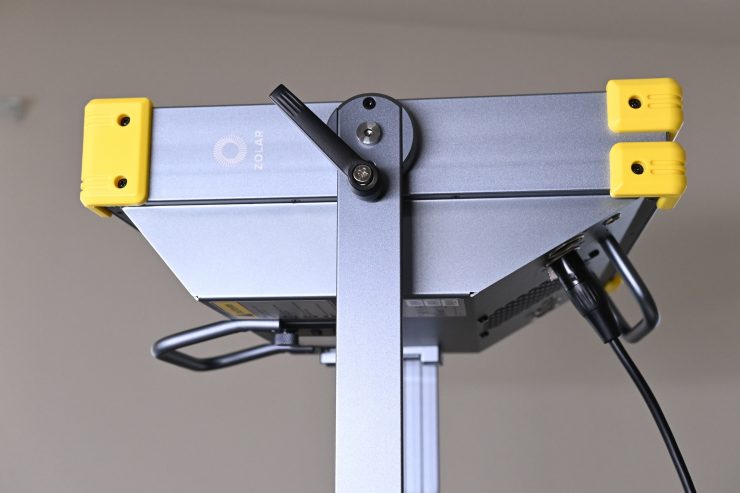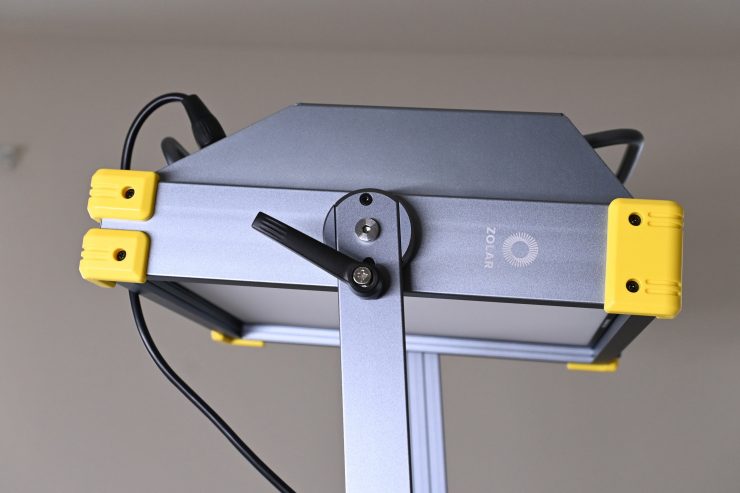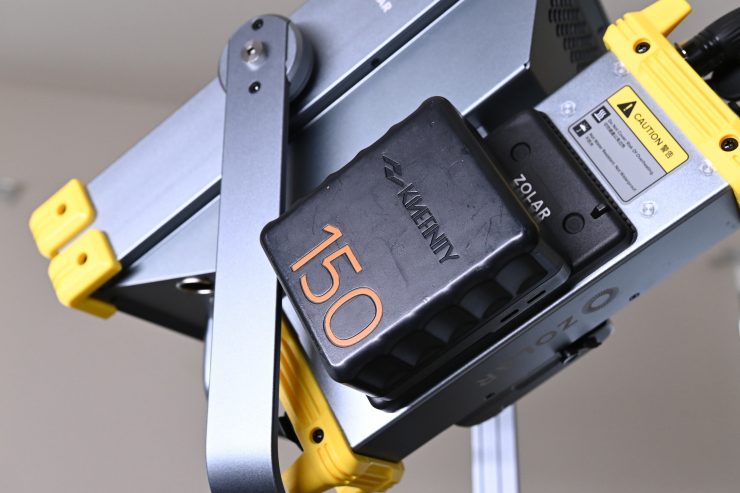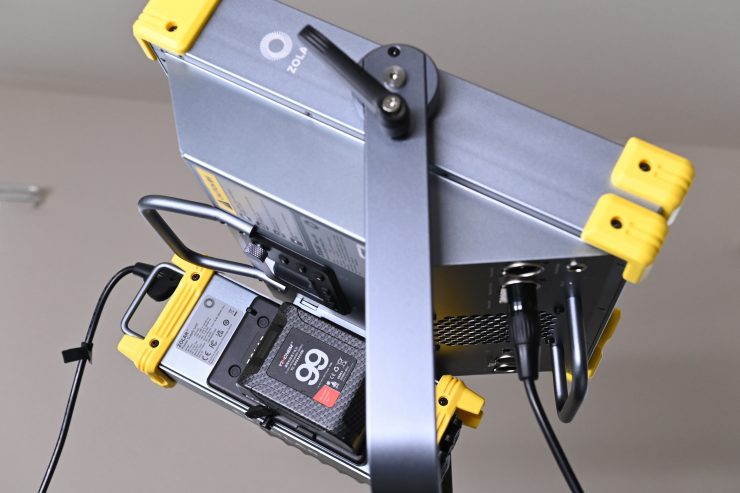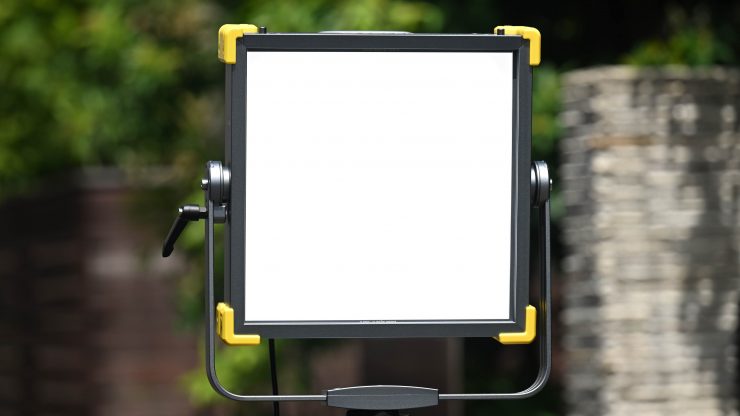
The same team behind Z CAM is branching out into LED lights and they have just announced their new ZOLAR range of professional LED lights.
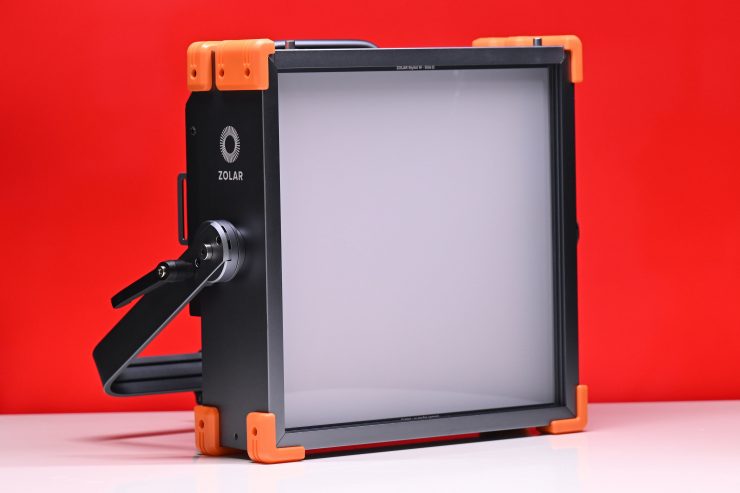
ZOLAR Toliman 30S 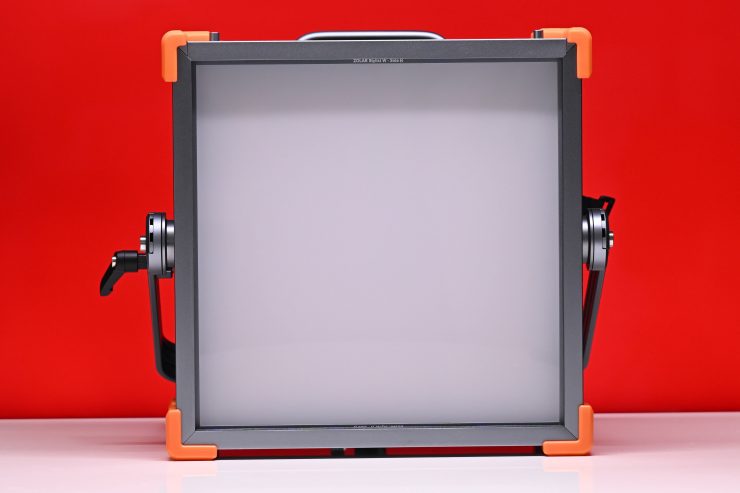
ZOLAR Toliman 30C 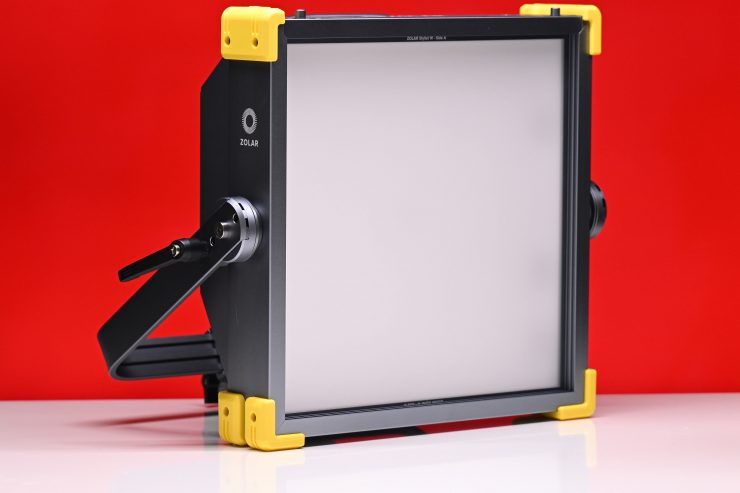
ZOLAR Vega 30C
Here is what they have just announced:
The Z CAM ZOLAR Toliman 30S, Toliman 30C and Vega 30C are all 1×1 panels. It is probably a wise decision to release 1×1 panel lights instead of COB spotlights. COB spotlights utilizing Bowens mounts have flooded the market, but there aren’t nearly as many 1×1 panels, at least decent ones. Options from Litepanels, ARRI, Rotolight, Velvet, KinoFlo and Creamsource are all pretty expensive. Lupo, Luxli, and Rayzr 7, at least in my opinion, are the only ones who are making 1×1 panel lights that are reasonably affordable and also offer good quality and performance.
Now, you may be thinking, it’s just another 1×1 panel light, I am not interested. However, these lights really surprised me and they have some very interesting functionality and whatever someone is doing over there in China, they are doing it right. These are the first lights I have seen that can properly recreate a daylight spectrum.
The ZOLAR professional LED lighting system was developed by Shenzhen ImagineVision Technology Limited, the same team that created Z CAM Cinema Cameras. ZOLAR products are claimed to have been developed with profound color science knowledge, leading image processing algorithms, as well as camera lens and sensor calibration expertise. They were made to deliver high-fidelity color reproduction and excellent color rendition with performances very close to natural daylight.
The in-house developed “Self Adaptive Spectral Nonlinear Dynamic Illuminance Calibration System” is claimed to eliminate the inconsistent LED performance issues. In addition, the ZOLAR light series has been designed so that you can match all of the lights in the series without any inconsistencies.
Meet the models
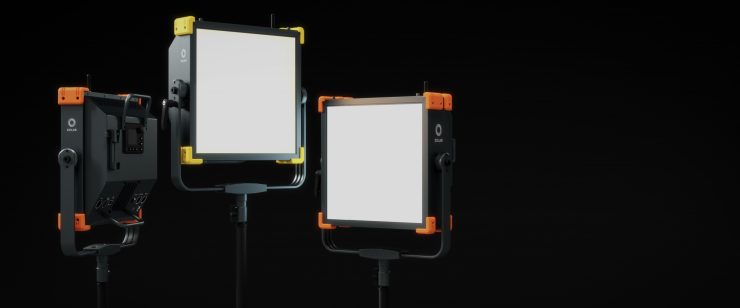
I am going to go into way more detail during this review, but below is a quick overview of each of the lights.
The ZOLAR Toliman 30S
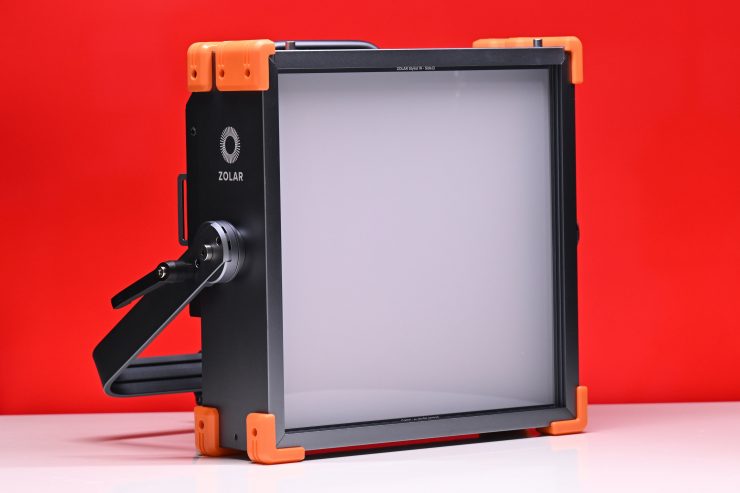
The Toliman 30S is the entry-level and most affordable 1×1 panel in the ZOLAR series. It is a Bi-color, Full Spectrum fixture that can be used from 3200K to 5600K.
Key features
- CRI: Ra≥97 (R9 & R12 up to 95), TLCI≥98
- Spectral Similarity Index SSI up to 90
- Low power consumption high output: Input ≤ 120W, Output ≥ 4,200 lx at 1m / 3.28ft
- Revolutionary 25-degree optical design lens array to boost illuminance
- ZOLAR Stylist precision directional super light transmissible panel: control beam angle, light diffusion, no color shift
- Multi Light Sync – ZolarLink (wireless), rapid auto sync grouping
- Supports Art-Net 4 & sACN (through wireless connection);
- Built in Light Effect for different scene applications;
- Bluetooth + WiFi mixed control: Remote Controller, mobile app (iOS & Android).
ZOLAR Toliman 30C
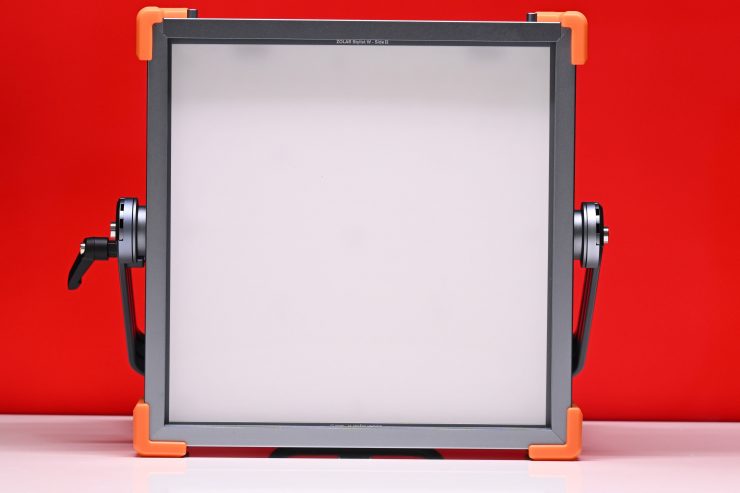
The Toliman 30C is a higher power draw, brighter version of the Toliman 30S. It is also a Bi-color, Full Spectrum fixture that can be used from 3200K to 5600K.
Key features
- CRI: Ra≥98 (R9 & R12 up to 98), TLCI≥98
- Spectral Similarity Index SSI up to 90
- Power consumption 200W, Output > 7,500 lux at 1m / 3.28ft;
- DMX, Art-Net 4 & sACN + powerCON
- ZOLAR Stylist precision directional super light transmissible panel: control beam angle, light diffusion, no color shift
- Multi Light Sync – ZolarLink (wireless / cable), rapid auto sync grouping
- Built in Light Effect (synchronized) for different scene applications
- Bluetooth + Wi-Fi mixed control: Remote Controller, mobile app (iOS & Android)
ZOLAR Vega 30C
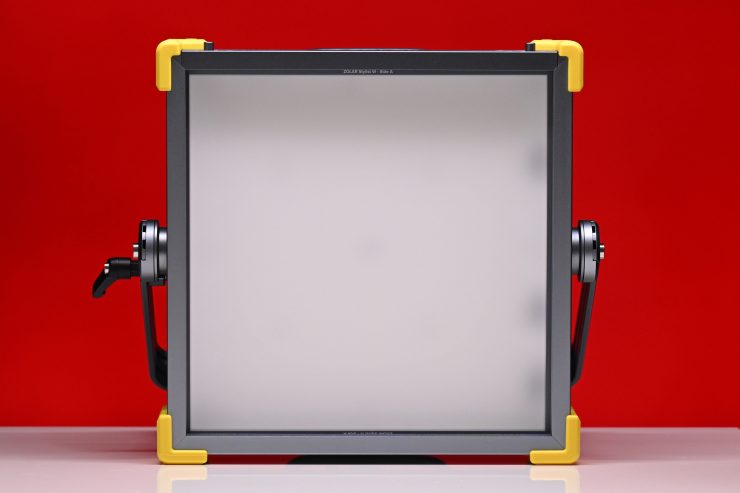
The Vega 30C is a Full RGBAW Color Gamut 1×1 panel with a CCT range of 2,000K to 20,000K. It also features built-in effects, gels, and source matching. It also has full +/- G/M.
The Vega is a 5-color LED light panel series targeting professional video productions. It was designed with 5-color full spectrum LEDs and RGBAW algorithm to deliver continuous light spectrum across full CCT range with exceptionally high CRI & TLCI scores, particularly in R9, R12, R13 & R15.
Key features
- CRI: Ra≥97 (R9 & R12 up to 97), TLCI≥98
- Spectral Similarity Index SSI up to 90
- Full RGBAW Color Gamut
- CCT range: 2,000K ~ 20,000K
- DMX, Art-Net 4 & sACN + powerCON
- ZOLAR Stylist precision directional super light transmissible panel: control beam angle, light diffusion, no color shift
- Multi Light Sync – ZolarLink (wireless / cable), rapid auto sync grouping
- Built in Light Effect (synchronized) for different scene applications;
- Bluetooth + WiFi mixed control: Remote Controller, mobile app (iOS & Android).
ZOLAR Stylist
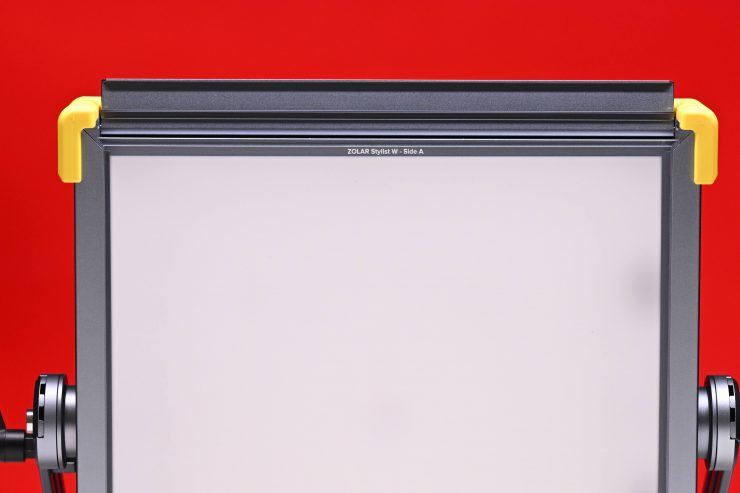
The ZOLAR Stylist isn’t someone who picks out your clothes for you! It is the name used for the interchangeable diffusion panels that you place in front of the lights.
The Stylist has a different microstructure on both sides of the panel. This means that the same Stylist has different beam angles depending on which side you use and what light you use it with.
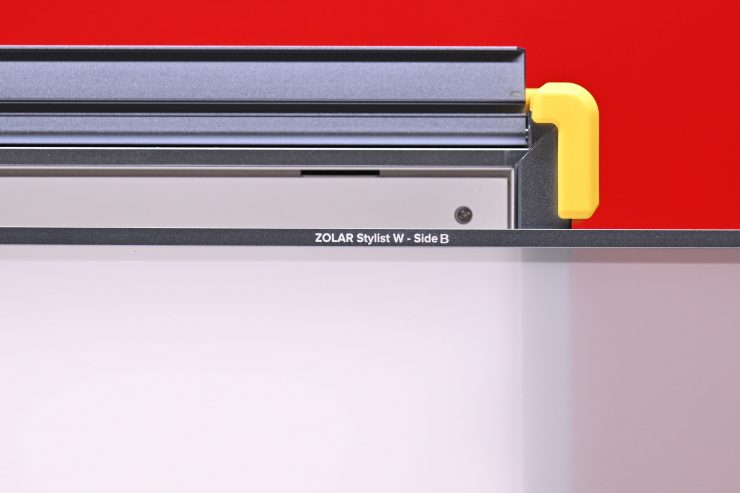
All three models in the line up coming with the ZOLAR Stylist W diffusion. Now, this has two sides that you can use, side A and side B.
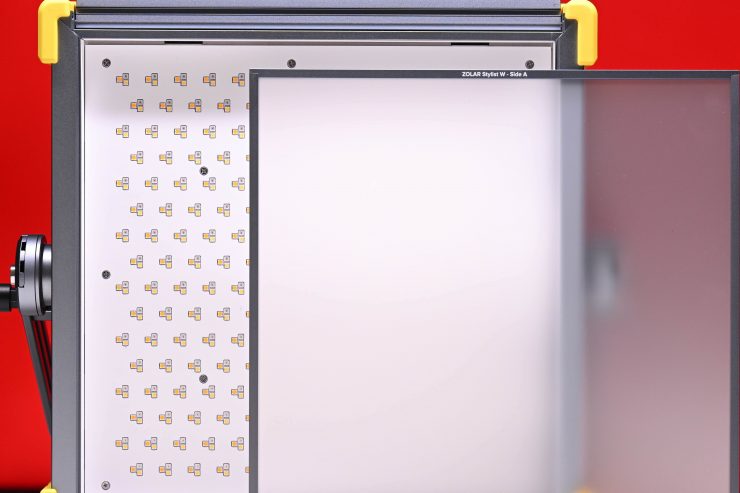
When you have side A facing outward, the light’s beam angle is narrower.
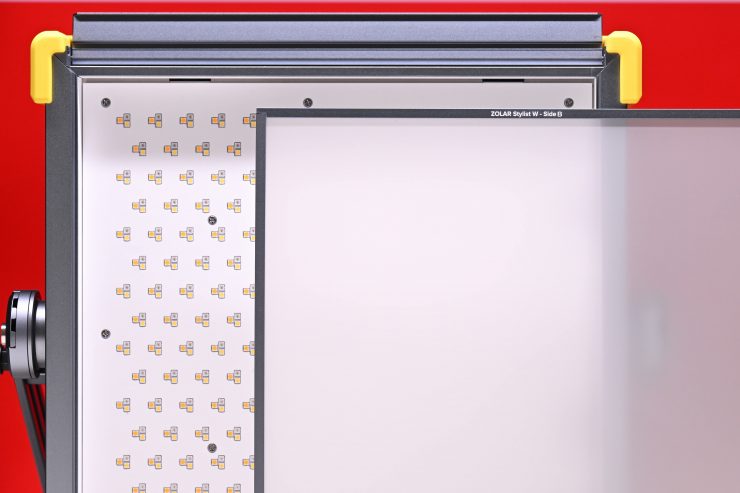
If you have side B facing outward then the light’s beam angle gets increased
These ZOLAR Stylist diffusion panels slide down into grooves in the front of the light and there is a really well-made and thought-out locking system that keeps them in place.
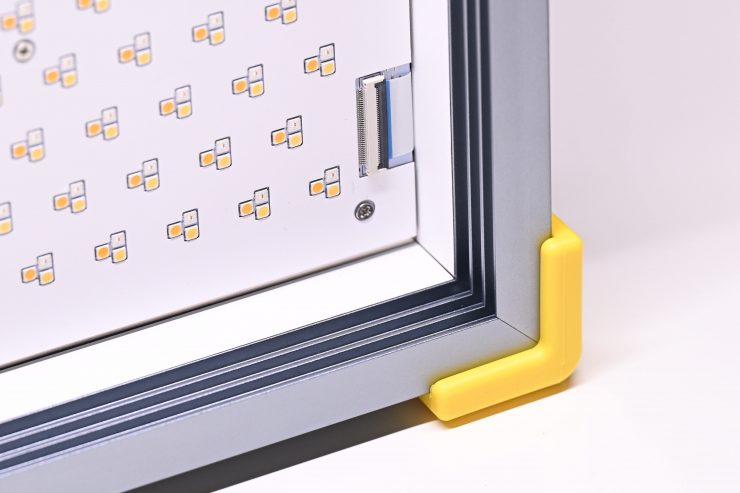
There are three slots to place ZOLAR Stylist panels. You could stack various options to create more diffusion if need be.
I really like this idea and it works well. Just being able to turn a diffusion panel over and then change the characteristics of the lights makes a ton of sense.
Now, I believe Z CAM will have other optional ZOLAR Stylist panels available in the future. There will be a Stylist L available at launch as an optional accessory. I imagine the L is a lighter diffusion.
Size & Weight
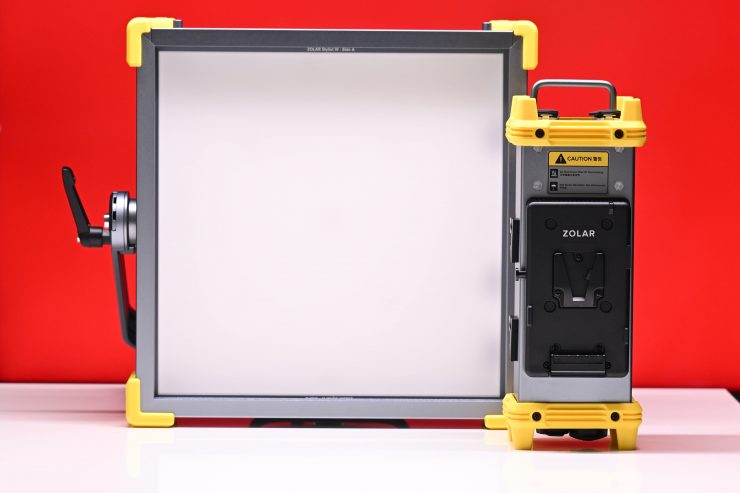
Here is what the three fixtures weigh:
- ZOLAR Toliman 30S 5.22 kg / 11.51 lb with its yoke frame
- ZOLAR Toliman 30C 4.53 kg / 9.99 lb with its yoke frame
- ZOLAR Vega 30C 4.53 kg / 9.99 lb with its yoke frame
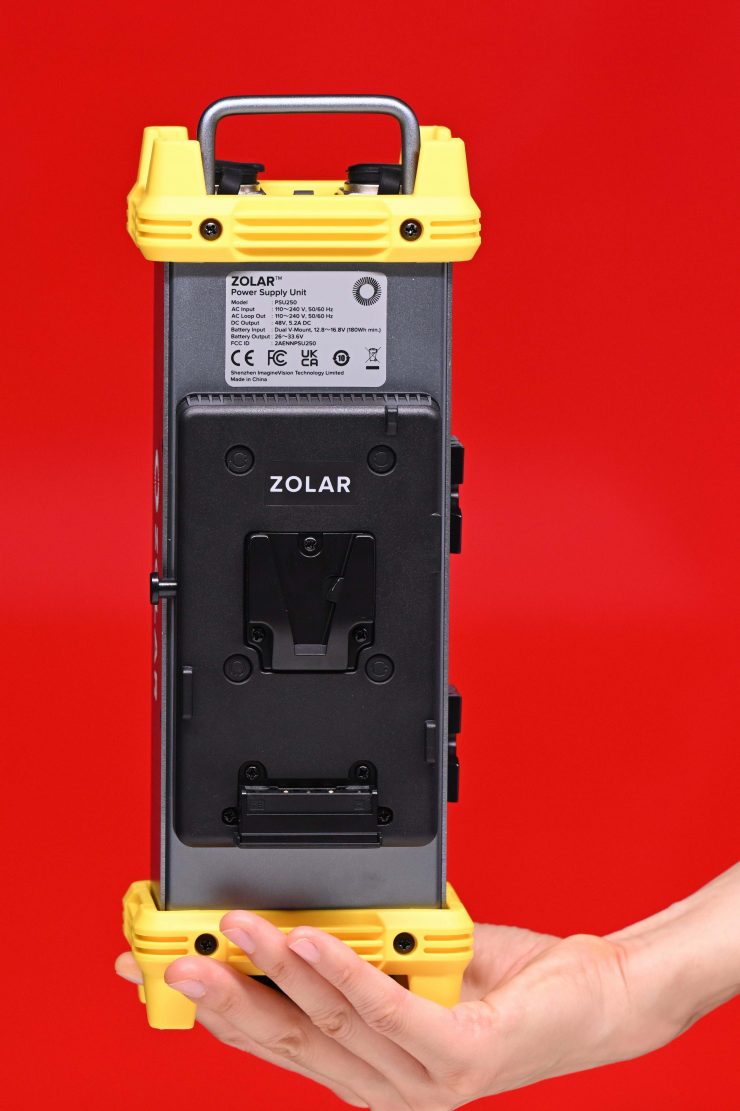
The power supply for both the Toliman 30C and the Vega 30C weighs 1.5kg / 3.3 lbs.
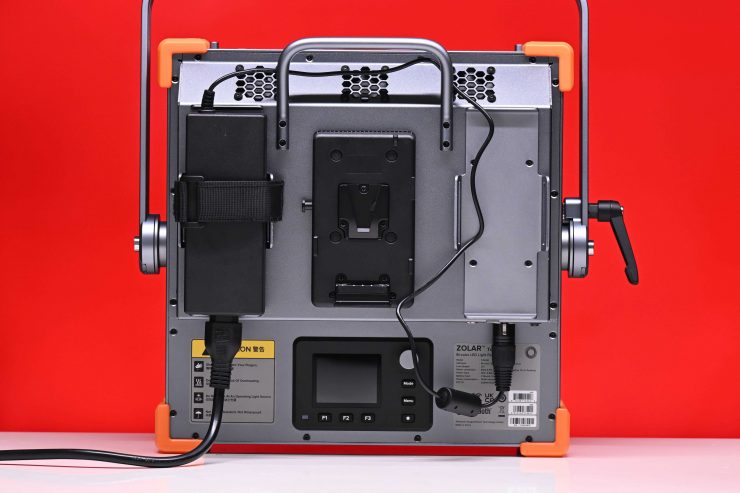
The power supply for the Toliman 30S is much smaller.
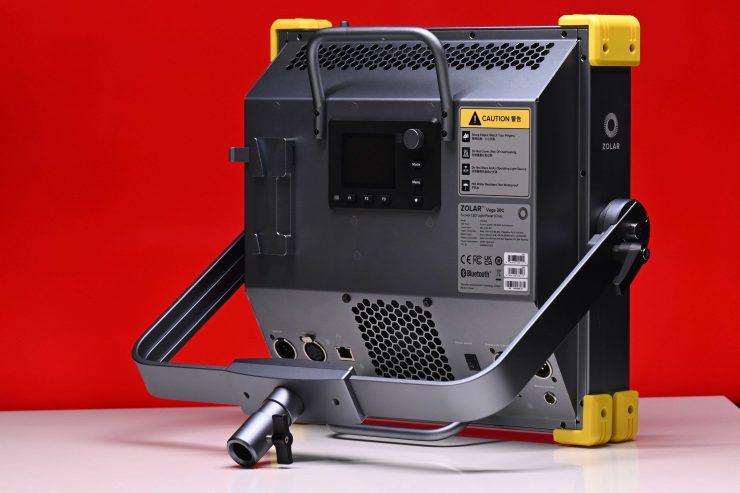
So how does this weight compare to some other 1×1 lights? Below you can see:
| Weight | |
| ZOLAR Toliman 30S | 5.22 kg |
| ZOLAR Toliman 30C | 4.53 kg 6.03 kg with power supply |
| ZOLAR Vega 30C | 4.53 kg 6.03 kg with power supply |
| Luxli Timpani² | 3 kg |
| Rotolight Titan X1 | 12.2 kg (including power supply) |
| Creamsource Vortex4 | 11.4 kg (Including Yoke) |
| ARRI S30-C SkyPanel | 10.3 kg (including power supply) |
| Litepanels Gemini 1×1 | 5.31 kg** |
| Rayzr 7 MC120 | 3.63 kg* |
| Lupo Superpanel 30 Full Color | 3.7 kg* |
| Luxli Timpani 1×1 RGBAW | 3.37 kg* |
| Aputure Nova P300C | 10.35 kg (Including Yoke, Cable, Frame, Mount, Receiver) |
* Including the weight of the power supply.
* This light has a built-in power supply
I wouldn’t say that the ZOLAR series are lightweight, but given their build quality and feature set, I think the weight is fairly reasonable.
Build Quality
The build quality of the ZOLAR fixures is very good considering their price point.
The casing is all made out of aluminum and the lights feature an almost industrial-looking design.
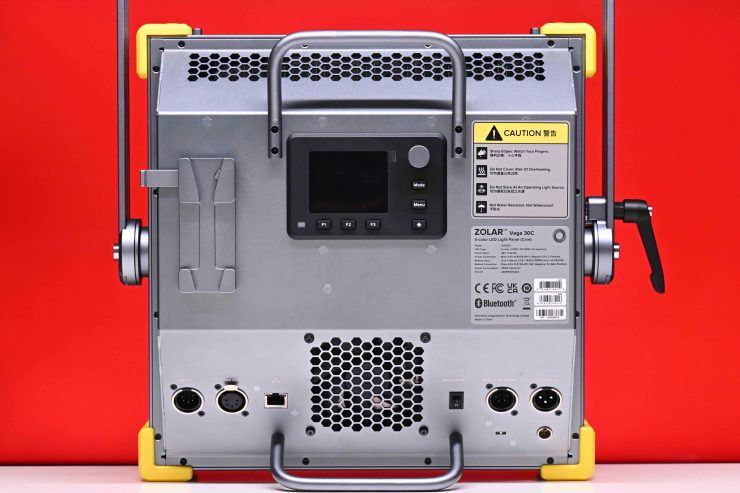
ZOLAR Vega 30C 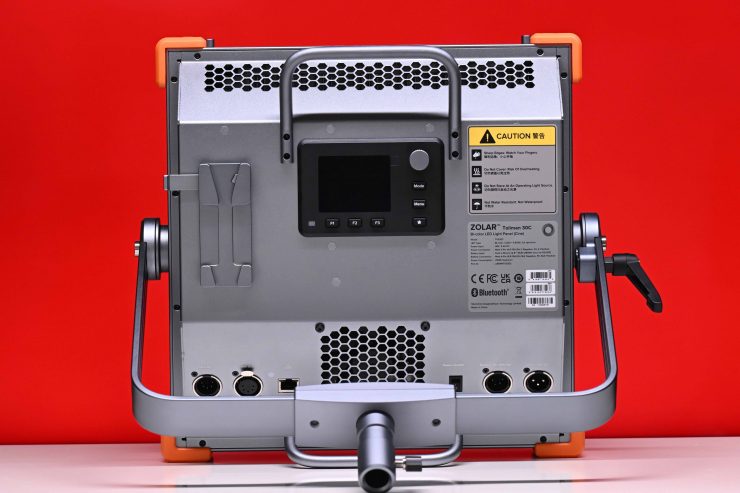
ZOLA Toliman 30C
The ZOLAR Vega 30C and Toliman 30C are basically identical when it comes to the design and form factor.
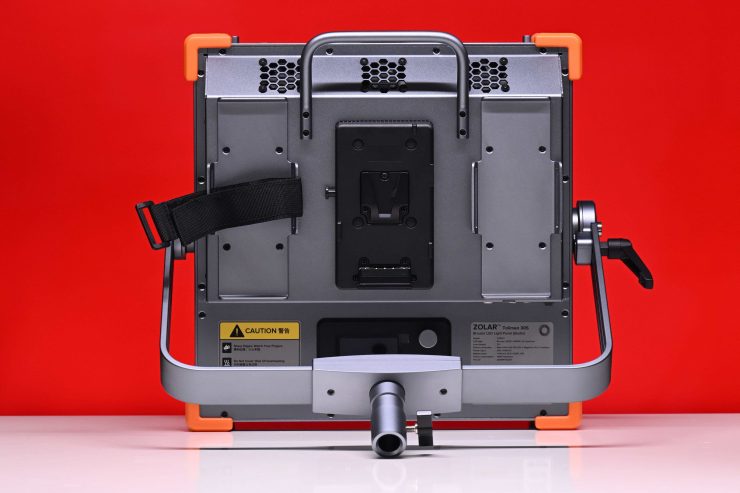
The Toliman 30S does look different from the other two lights, but it shares the same build quality and finish.
The yoke frames and locking mechanisms on all three lights are solidly made and they all lock down tightly.
I like that there are protective bumpers on all four corners of the lights.
The overall build quality of the ZOLAR fixtures is excellent and it is right up there with 1×1 fixtures that cost substantially more money.
The mechanism that locks down the ZOLAR Stylist diffusion panels is beautifully made and it works really well.
All the buttons and switches have a nice solid and tactile feel.
I like that the ZOLAR has placed two carry handles on the back of the Vega 30C and Toliman 30C fixtures. This is a nice touch. On the Tolman 30S, there is a handle on the top and in the kit, you get another handle that you can attach to the bottom.
Power Draw
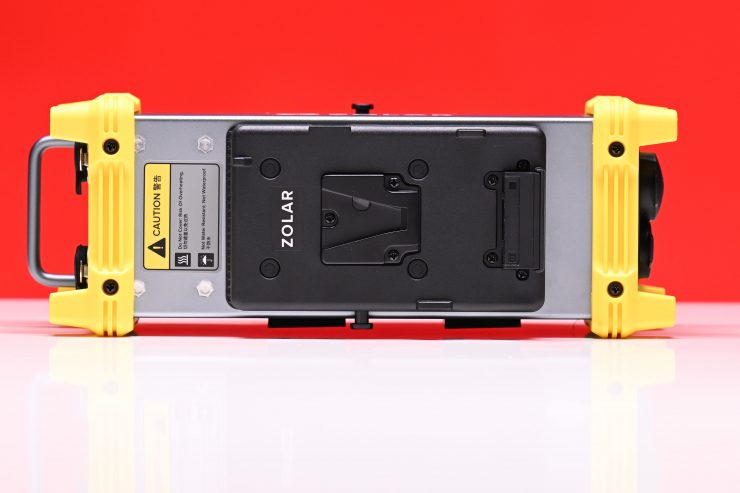
Most 1×1 lights these days tend to draw a lot of power, especially the RGBWW ones. Below you can see how much the ZOLAR fixtures draw:
Here is what the three fixtures draw when it comes to power (nominal):
- ZOLAR Toliman 30S 120W (140W maximum)
- ZOLAR Toliman 30C 200W (250W maximum)
- ZOLAR Vega 30C 200W (250W maximum)
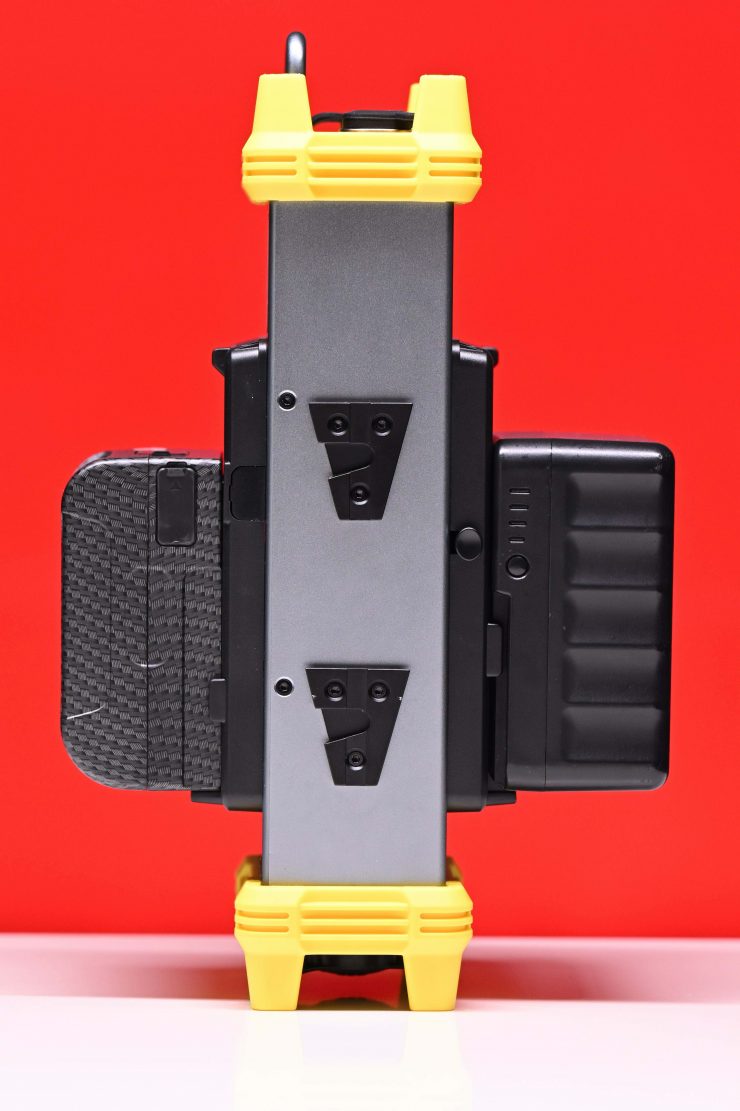
All three models can easily be run at full power off camera batteries that are below the 160Wh limit that airlines will allow you to travel with. This is a big deal if you are a traveling cameraman. However, with the ZOLAR Toliman 30C and Vega 30C, you will need to use two V-lock batteries.
The Toliman 30S is the only one of the three lights with a built-in V-mount plate.
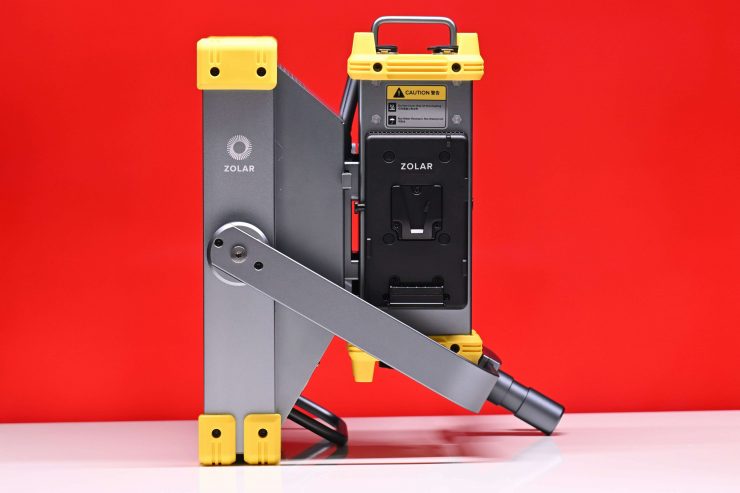
The ZOLAR Toliman 30C and ZOLAR Vega 30C both feature a V-mount wedge adapter that you can use to attach the power supply to the fixture.
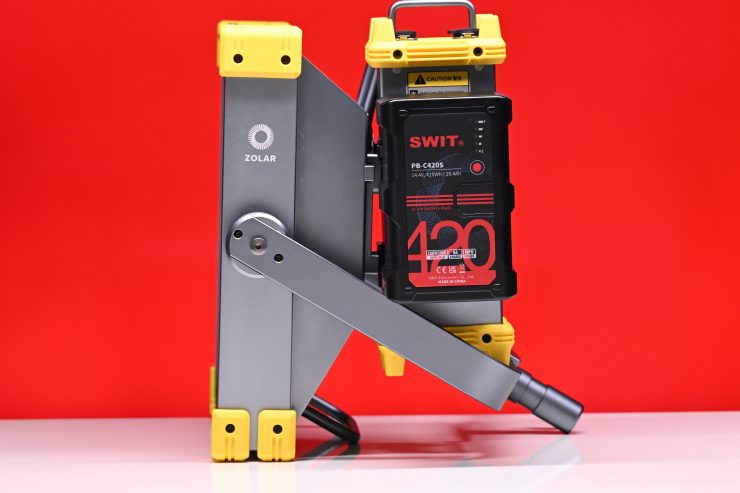
The ZOLAR Toliman 30C and ZOLAR Vega 30C can’t be powered via a single camera battery regardless of the capacity. I tried using a SWIT PB-C420S and a CORE SWX Hypercore 293Wh XL and neither would let me power up the power supply. Unless you have two batteries on the power supply it won’t work. I confirmed this with the manafacturer. All three lights can be run via mains power.
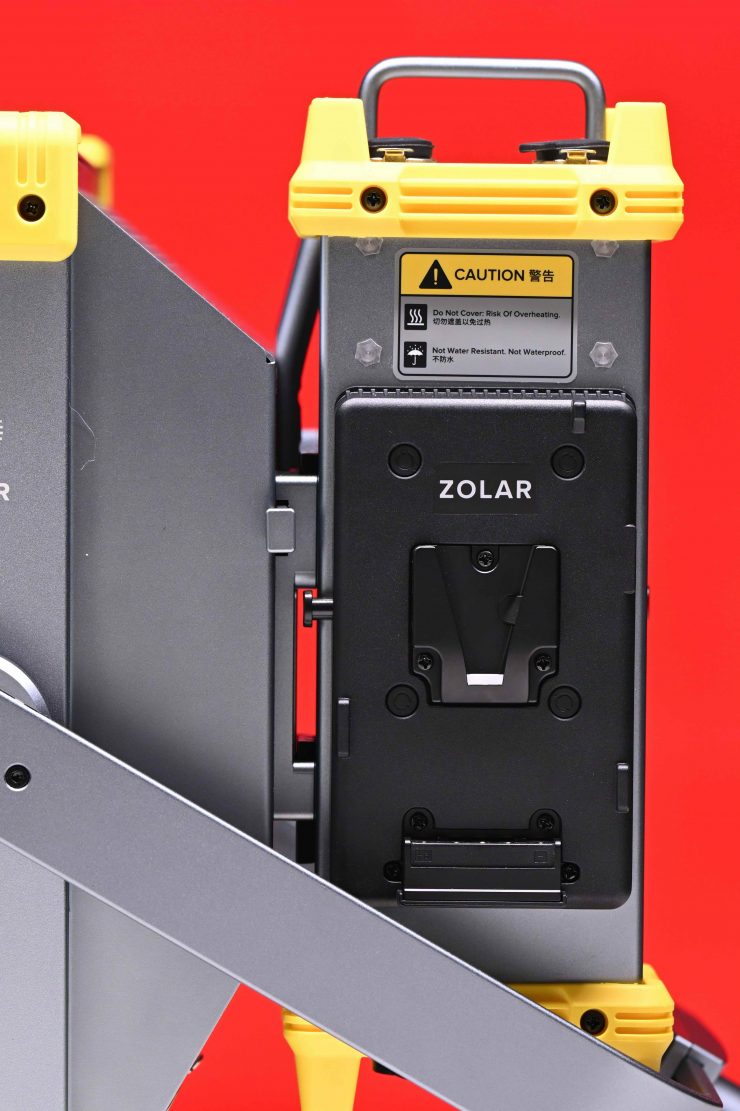
The power supplies for both the Toliman 30C and the Vega 30C are pretty big. You can either attach the power supply directly to the V-mount wedge plate on the light, or you can put it on the ground or hang it from a light stand, etc. It is nice that you have these options. Please be are that you still need to run a cable from the power supply to the light when running it via batteries.
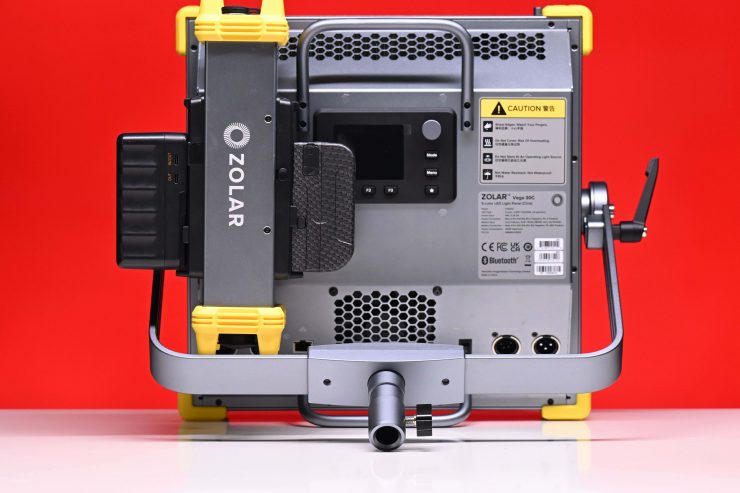
I personally wouldn’t place the power supply for the Vega 30C and Tolamn 30C on the light if I was running it via a camera battery or batteries, because I think it is too much weight. You would be better off putting it on the ground or using one of those V-lock wedge adapters that you can mount on a lightstand.
The design is also slightly strange because when you are using two V-lock batteries, one of them will end up getting in the way of the rear LCD screen.
The power supply for both the Toliman 30C and the Vega 30C weighs 1.5kg / 3.3 lbs as I previously mentioned.
Yes, there are some advantages to separating the power supply from the light as you can use a slightly smaller light stand. You can also use the power supply as a ballast further down the light stand if need be.
So how does the power draw of the ZOLAR models compare to other 1×1 fixtures? Below you can see:
| Power Draw | |
| ZOLAR Toliman 30S | 120W (nominal) |
| ZOLAR Toliman 30C | 200W (nominal) |
| ZOLAR Vega 30C | 200W (nominal) |
| Luxli Timpani² | 120W (nominal) |
| Rotolight Titan X1 | 230W (nominal) |
| Creamsource Vortex4 | 325W (nominal) |
| ARRI S30-C SkyPanel | 200W (nominal) |
| Litepanels Gemini 1×1 Soft | 200W (nominal) |
| Litepanels Gemini 1×1 Hard | 200W (nominal) |
| Rayzr MC 100 | 98W (nominal) |
| Lupo Superpanel 30 Full Color | 200W (nominal) |
| Luxli Timpani 1×1 RGBAW | 120W (nominal) |
| Aputure Nova P300C | 360W (nominal) |
The ability to power a light at 100% via a single flight safe battery can be a big deal to some users. On the flip side, lights with a lower power draw don’t tend to have as much output as some other fixtures.
Display & Controls
The built-in color LCD display on all three lights lets you clearly see all of the relative information. Depending on the ZOLAR model you are using, the functionality and menus will be slightly different.
Being able to see all the relevant information about your light without having to walk up really close to it is always nice. All the operating modes can be accessed through the pushing of a single button, and each mode is clearly and concisely shown on the LCD screen.
I will show you some of the controls for the Vega 30C, but the basic controls are also the same for both the Toliman 30C and Toliman 30S.
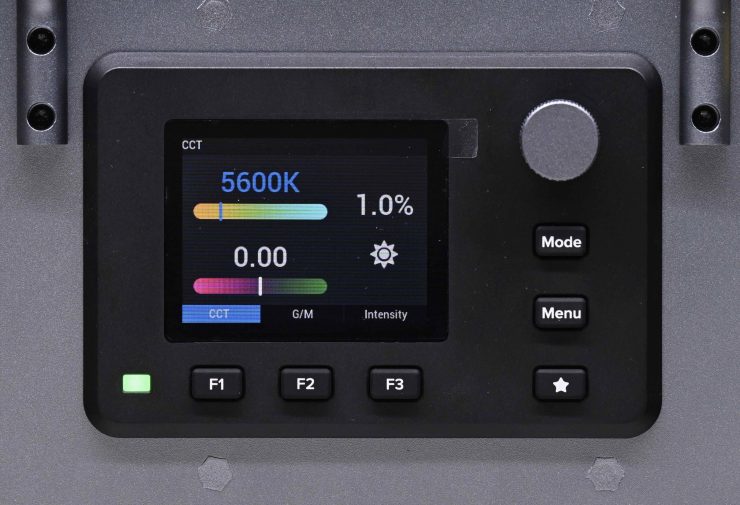
You select what parameter you want to adjust by pressing the corresponding Function Button (F1-F3). Whatever parameter is selected will be displayed in blue. You then use the dial to make adjustments.
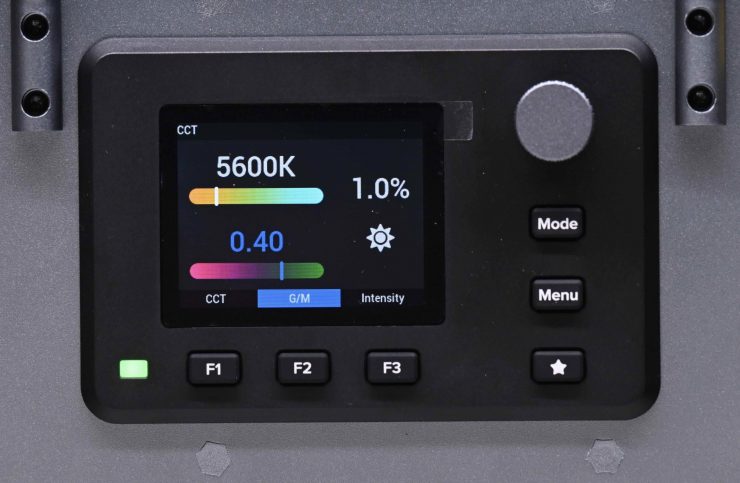
The Vega 30C is the only one of the ZOLAR lights with +/- G/M adjustment.
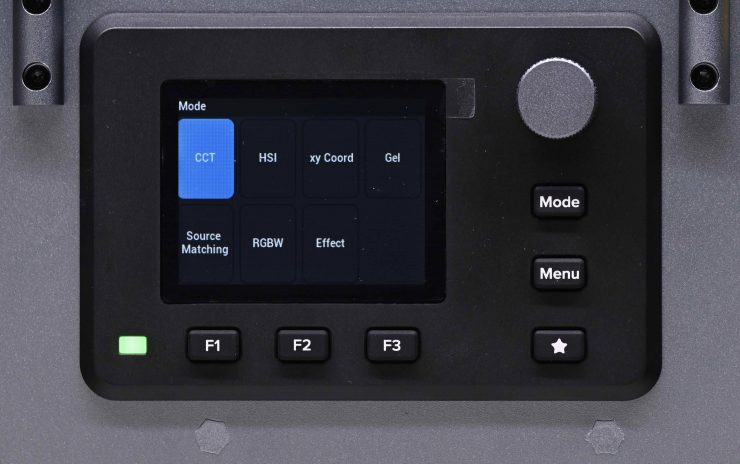
If you press the Mode button you can then cycle through and select what operating mode you would like to use. Your choices are:
- CCT
- HSI
- xy Coord
- Gel
- Source Matching
- RGBW
- Effect
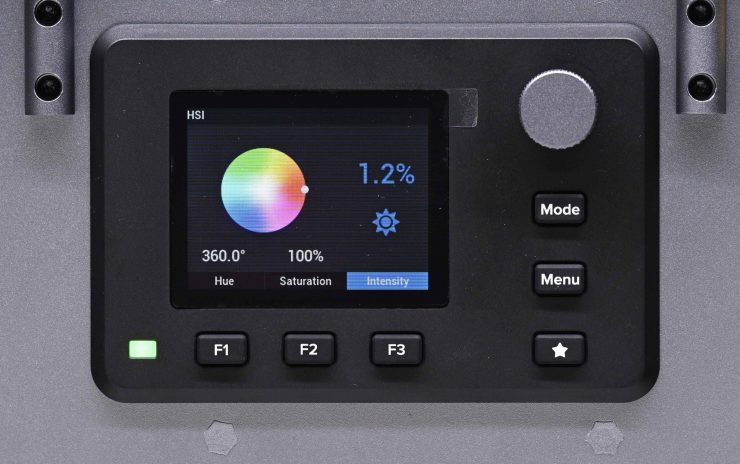
In HSI mode you can adjust the Hue, Saturation, and Intensity of the light. You get a visual reference that helps you select the color you would like to produce.
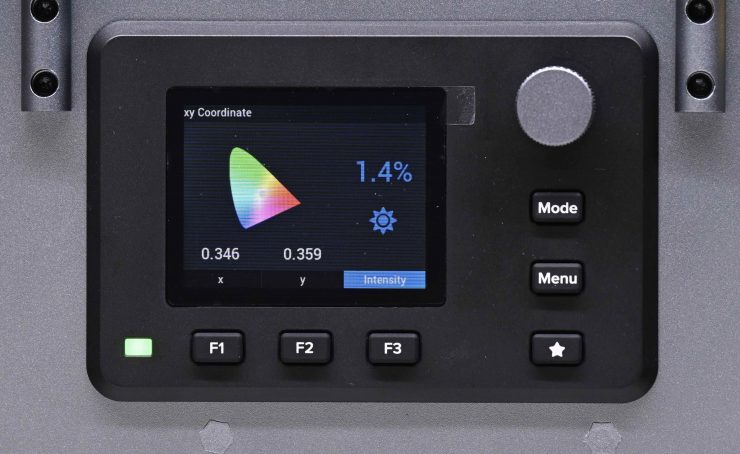
In the xy Coordinate mode, you can adjust the coordinates for the x and y axis and also the intensity.
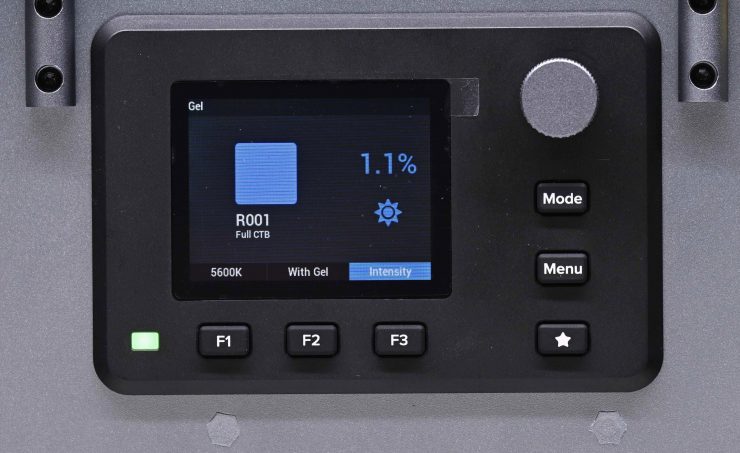
In Gel mode you can select from a wide array of gels. You can also adjust the CCT temperature and intensity.
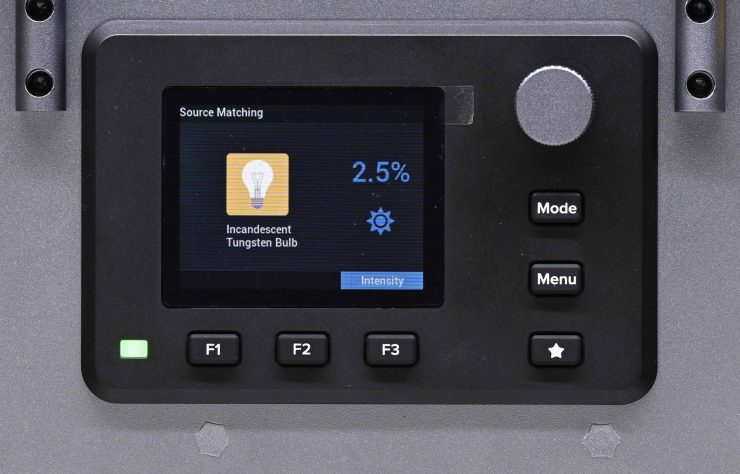
In Source Matching mode you can select from a wide array of various lighting sources that you want to replicate.
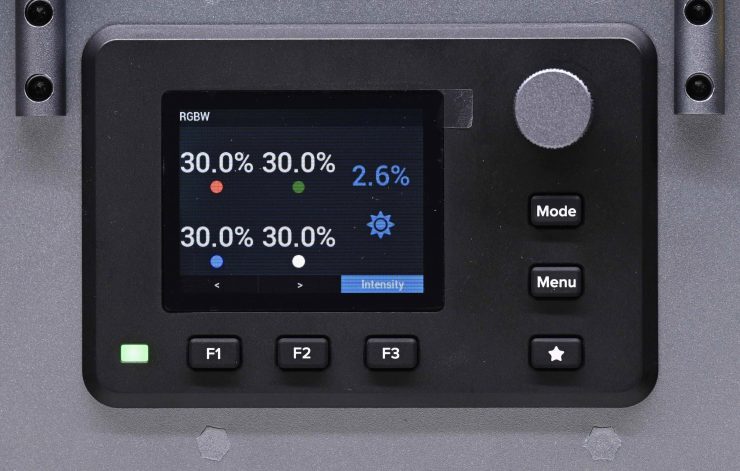
In RGBW mode you can individually adjust the values for Red, Green, and Blue.
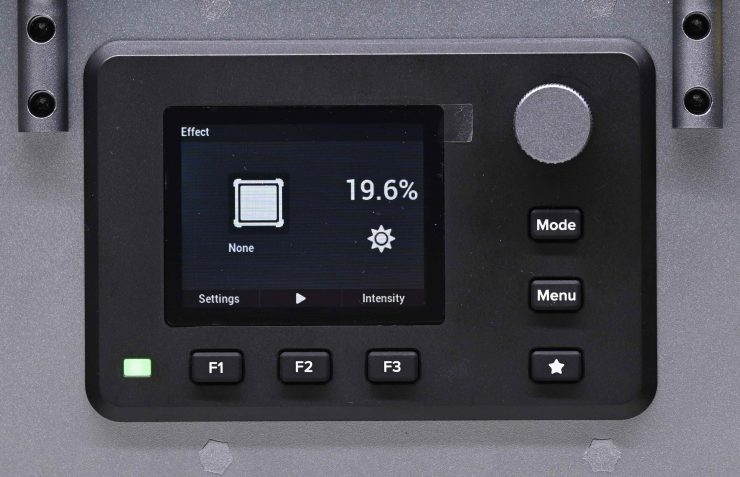
In the Effect mode, you can select and adjust various effects as well as play them back. You ned to press the Settings button and then rotate the dial to choose the effect you want to use.
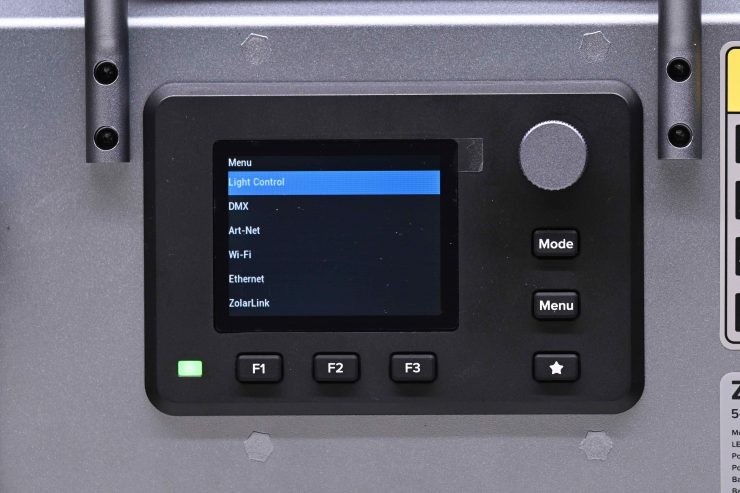
If you select the Menu you are greeted by the following items:
- Light Control
- DMX
- Art-Net
- Wi-Fi
- Ethernet
- ZolarLink
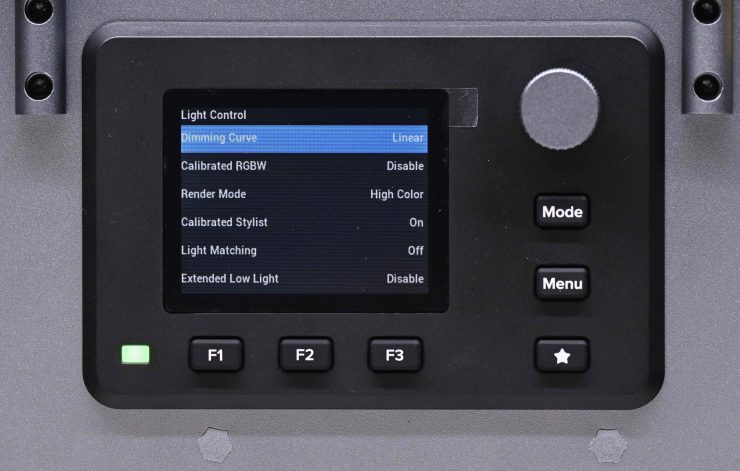
In Light Control you get the following options:
- Dimming Curve (you can choose from Exp/Log/Linear/S Curve)
- Calibrated RGBW
- Render Mode
- Calibrated Stylist
- Light Matching
- Extended Low Light
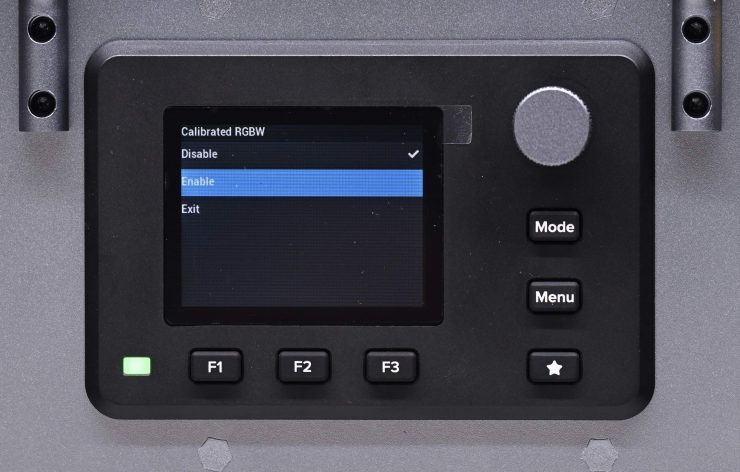
You can either choose to enable or disable Calibrated RGBW. I am still waiting to try and find out exactly what this function does.
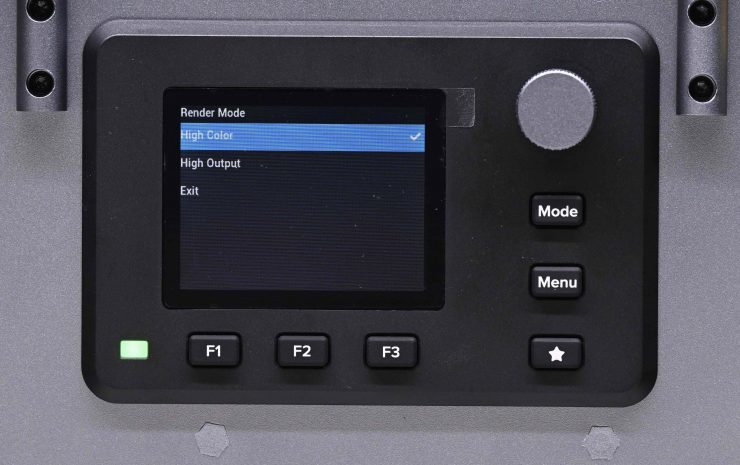
In Render Mode, you can select between High Output and High Power. I will test these further down in the review.
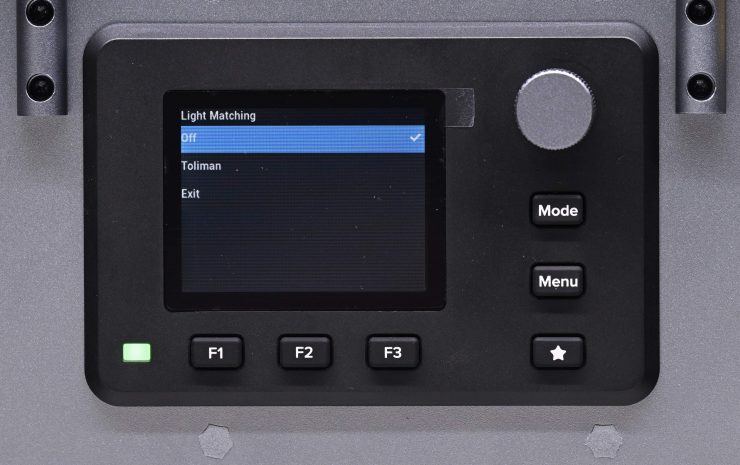
In Light Matching, you can set the Vega 30C to match the Toliman 30C and Toliman 30S. I will also test this further down in the review.
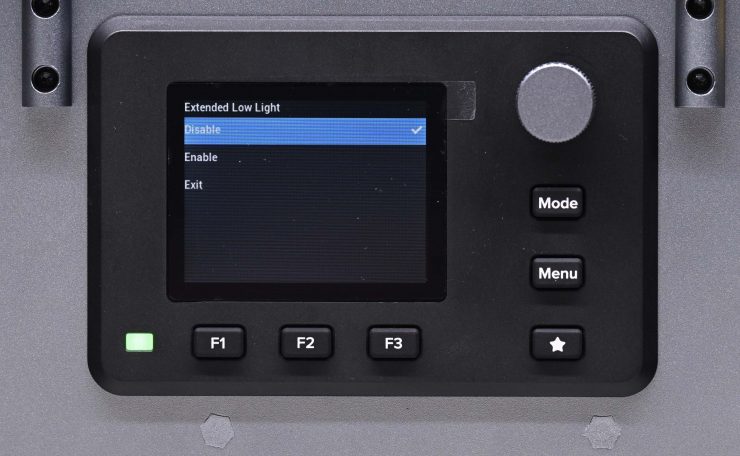
In Extended Low Light, you can turn it on or off. I am still waiting to find out exactly what this actually does.
All three lights also come with a wired remote controller that you can use. I like this idea because for interviews etc. you may be standing reasonably close to the light and being able to make adjustments via the remote is really handy. The remote basically looks like the rear screen on the lights and it has the exact same controls. The cable you get that goes from the remote controller to the light is also nice and long at 5m / 16.4 ft.
Now, if you would prefer to use wireless control you also have that option. There is a free iOS/Android app called ZolarLink that will be available. The ZolarLink app will have a Multi Light Sync Protocol, so up to 16 groups with a maximum 60 slave units per group (wireless) can be used.
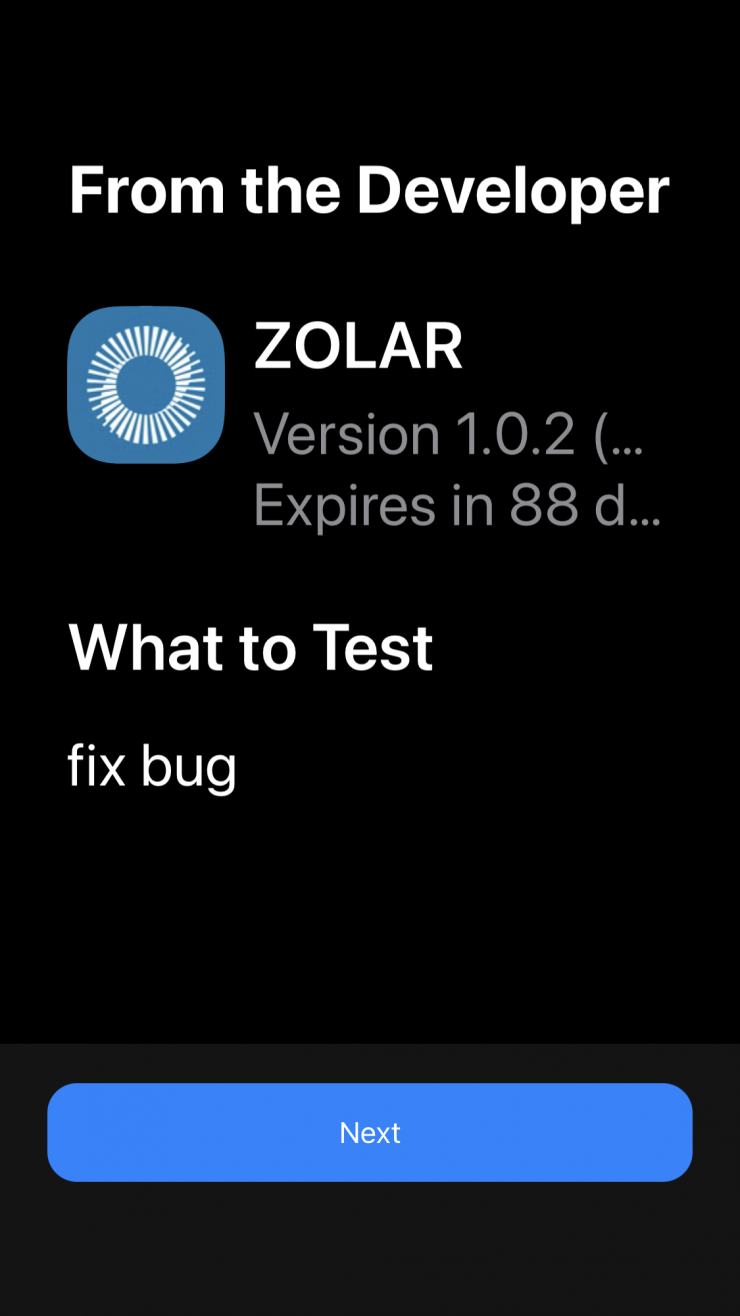
I was Beta testing the app and I found that it worked really well. It is straightforward and simple to use and the interface is intuitive.
All you need to do is open up the app and as long as you have The ZolarLink activated in the menu it will appear as a device instantly. You then tap on the light and it connects up within a few seconds.
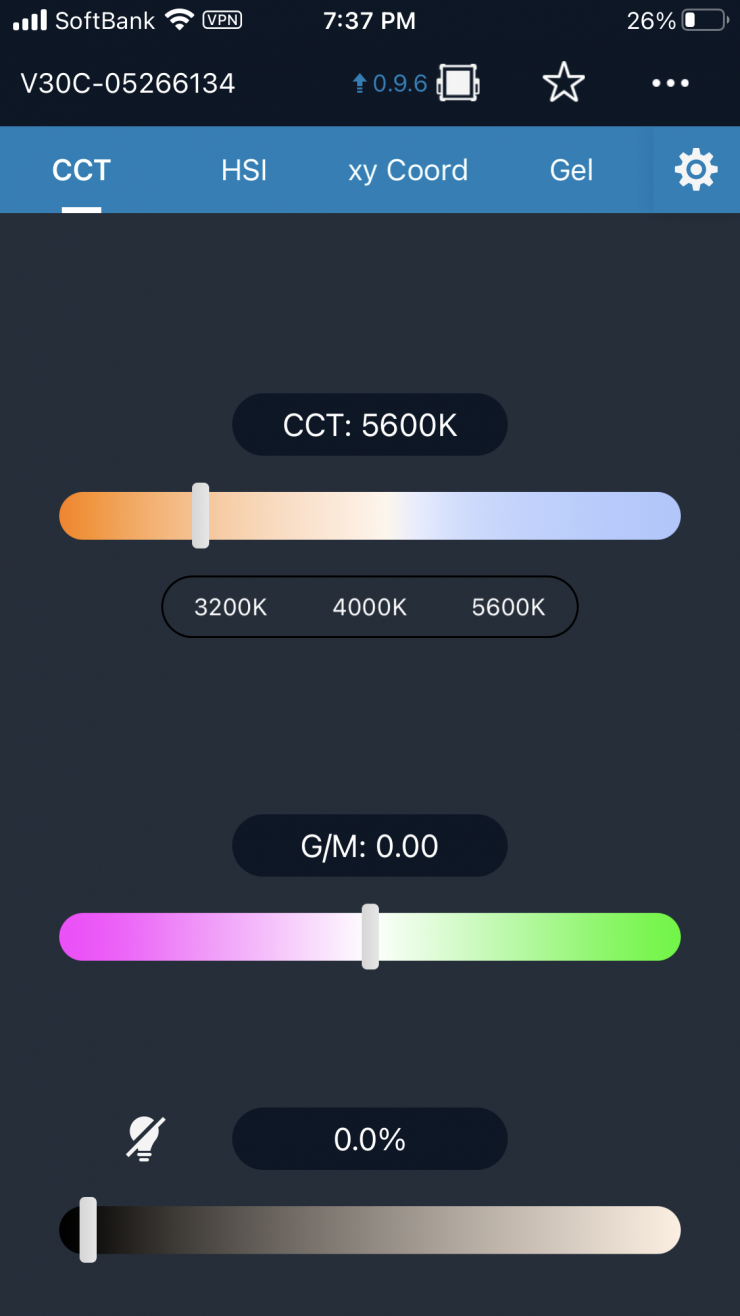
On the main screen, you can change between the various operating modes.
There are a ton of items you can adjust as you can see from the screenshots above.
For studios and people wanting control over lots of different fixtures, the ZOLAR lights can use DMX, Art-Net 4 & sACN + powerCON.
Inputs & Outputs
The Vega 30C and Tolman 30C feature the exact same inputs and inputs:
- 5-pin DMX IN
- 5-pin DMX OUT
- Ethernet
- 26-33V DC Input
- 48V DC Input
- Remote Control Interface
On the power supply for the Vega 30C and Toliman 300C there is the following:
- 4-pin Battery output (this is for the cable that goes from the power supply to the light if you are using the battery plates)
- 3-pin Power Output (this goes from the power supply to the light if you are using mains power)
- Powercon power input
Fan Noise
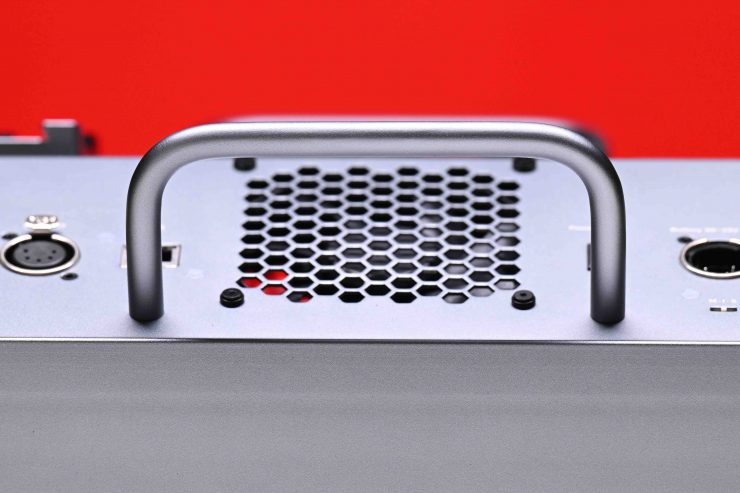
All three of the ZOLAR fixtures utilize a fan. The fan noise is relatively low and I don’t think it would be of concern to anyone. There is a Low Noise Fan mode where you can choose what setting you want to use (Auto, High, Mid, Low). I found that I mostly just left it in the Auto setting.
Yoke Frame
The ZOLAR fixtures all feature a nice solid, well-made yoke frame.
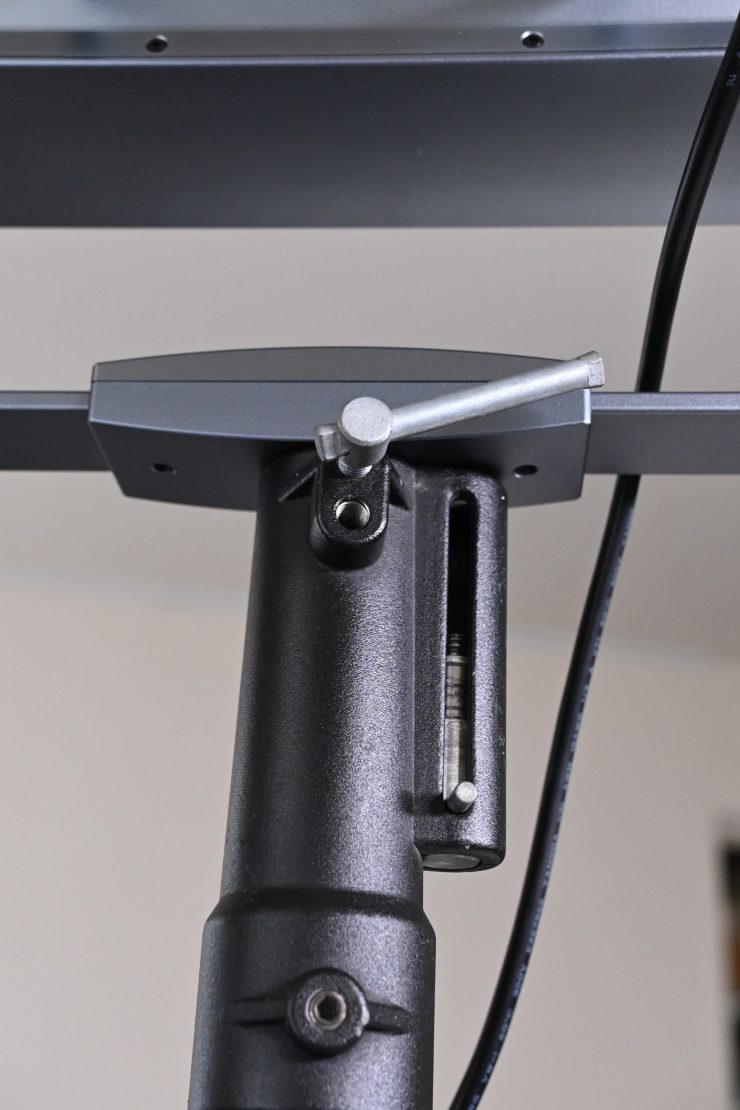
What is nice is that the ZOLAR fixtures can be used with a regular light stand or a stand with a junior pin mount as they feature a 16 mm / 28 mm Combo Pin (Baby 5/8″ / Junior 1-1/8″ Combo Pin) / 28 mm Spigot (Junior Pin).
The lock-off mechanisms on all three lights lock tightly securely and allow for a full range of movement.
However, if you are running the Vega 30C or Tolman 30C with the power supply attached to the light and with two batteries, the outside battery will end up hitting the yoke frame at certain angles.
It is also fairly easy to remove the yoke frame for transport and it is also handy to remove it if someone is going to be using the light by holding onto the handle.
Barn Doors?
There will be optional barn doors that you can purchase for these lights.
Beam Angle
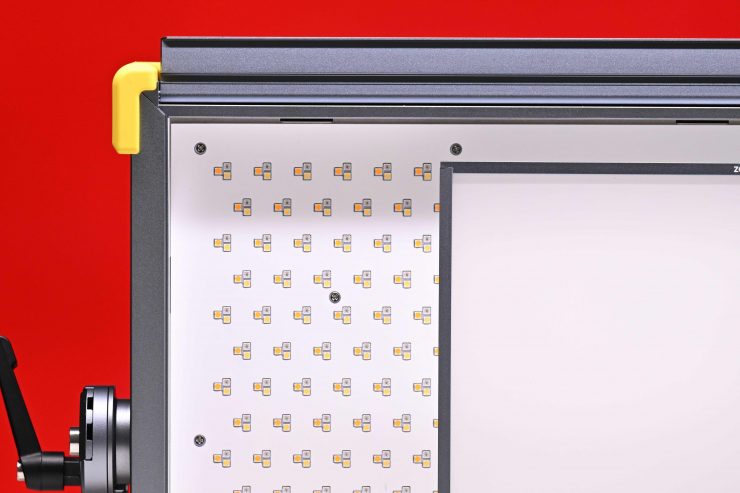
The ZOLAR fixtures have the following beam angles when used with their Stylist W Diffusion panels (Side A Out):
- ZOLAR Toliman 30S 40°
- ZOLAR Toliman 30C 90°
- ZOLAR Vega 30C 90°
Below you can see what the beam angles are when using the lights with the Stylist W Diffusion panels (Side B Out):
- ZOLAR Toliman 30S 88°
- ZOLAR Toliman 30C 127°
- ZOLAR Vega 30C 127°
1×1 lights that are on the market have a wide array of different beam angles. Normally they have either a very tight beam angle or a very wide beam angle. Although there are exceptions to this rule such as the Rotolight Titan X1 and Ceamsource Vortex4 where you can adjust the beam angles.
Below you can see what the beam angle is of other competing lights:
| Beam Angle | |
| ZOLAR Toliman 30S | 40°/ 88° |
| ZOLAR Toliman 30C | 90°/ 127° |
| ZOLAR Vega 30C | 90°/ 127° |
| Luxli Timpani² | 78° |
| Rotolight Titan X1 | 68° to 150° |
| Ceamsource Vortex4 | 20° |
| ARRI SkyPanel S30-C | 110° |
| Litepanels Gemini 1×1 | 95° |
| Razyr 7 MC120 | 120° |
| Lupo Superpanel 30 Full Color | 40° |
| Lupo Superpanel 30 Full Color Soft | 115° |
| Luxli Timpani 1×1 RGBAW | 78° |
| Aputure NOVA P300c | 120° |
With lights such as the ARRI SkyPanels, you can put accessories such as honeycomb grids, benders, and intensifier panels that will change the beam angle. Other lights also have the ability to change the beam angle through the use of various light modifiers.
Photometrics
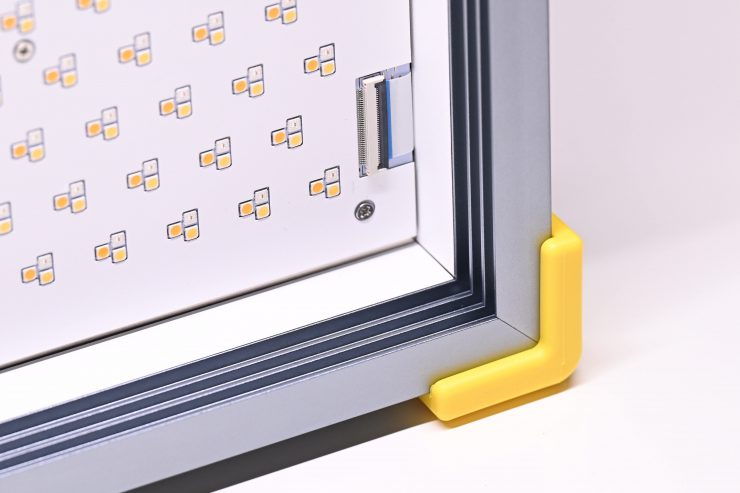
So now let’s get to the photometric results. I always test lights in this way so that I get a reference to how they compare to other fixtures. Results only tell part of the story and should never be used alone to judge a light. I have found from extensive testing over the years that certain lights that have good photometric results don’t always look good, and lights that have worse photometric scores can sometimes look better than their results indicate. It is important that you don’t judge a light from one individual result. You have to gather all the data to make a comprehensive conclusion.
Different lights can also look different depending on what camera you happen to be using.
There is a ton of results to get through here so grab a coffee because this is going to take a while!
Output & CCT Accuracy
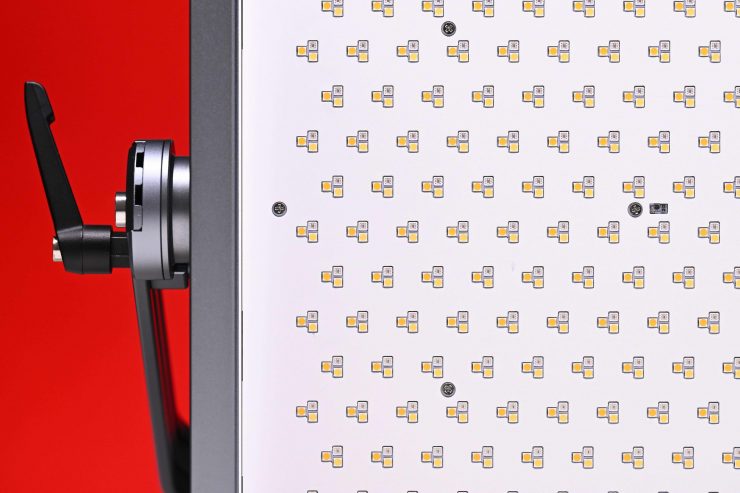
I tested all three ZOLAR lights at a variety of Kelvin color temperatures with a Sekonic C-800 Spectrometer to find out how much output the light had and how accurate the CCT reproduction was. All readings are taken at a distance of 1m (3.28ft) in a controlled environment.
First, let’s look at how the lights perform at 5600K.
5600K
ZOLAR Toliman 30S 5600K (Stylist W Side A)
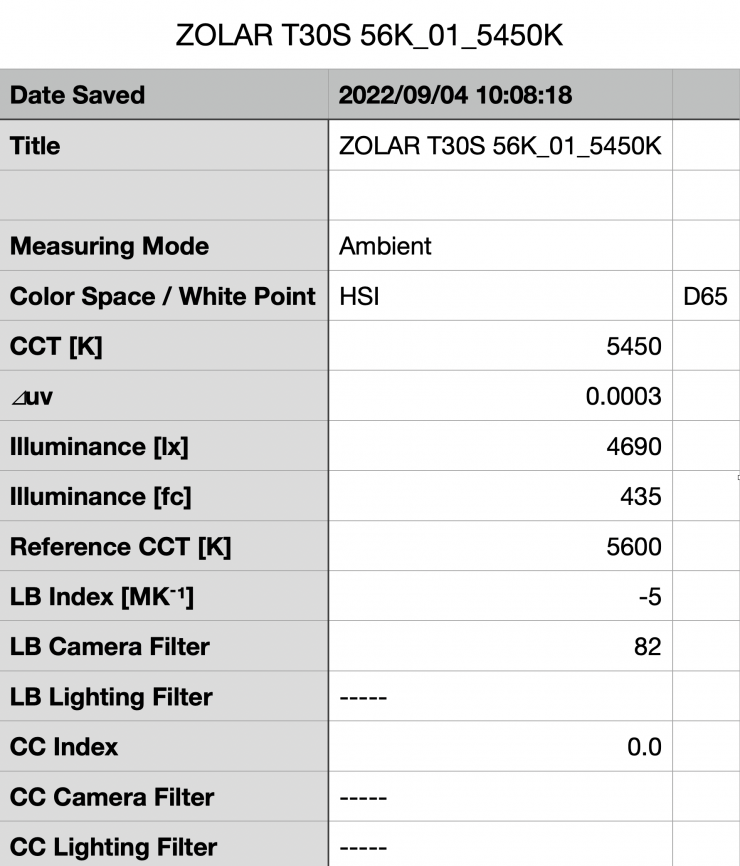
Above you can see that the Toliman 30S recorded an output of 4690 lx (435 fc) when set at 5600K with its Stylist W diffusion panel (side A) and run via mains power. This was a decent amount of output for a light with a 120W power draw.

Above you can see the claimed figures from the manufacturer. From my testing I found these figures to be very close to the results I obtained.
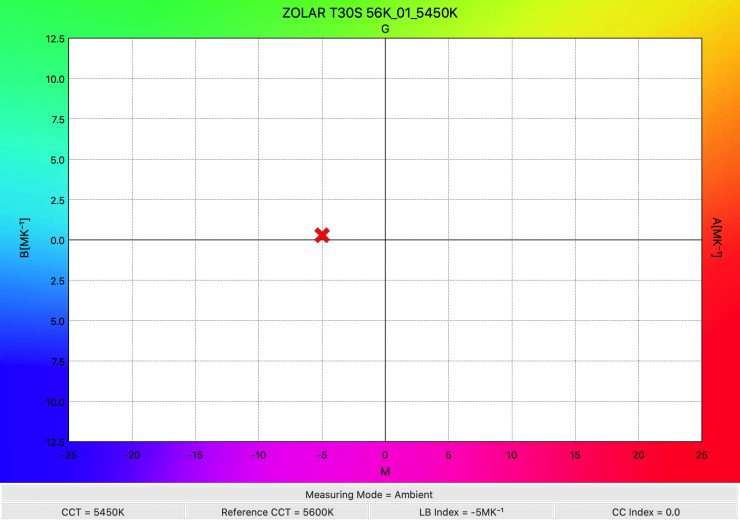
The light recorded a CCT of 5450K which was ok, but it was still 150K off.
ZOLAR Toliman 30S 5600K (Stylist W Side B)
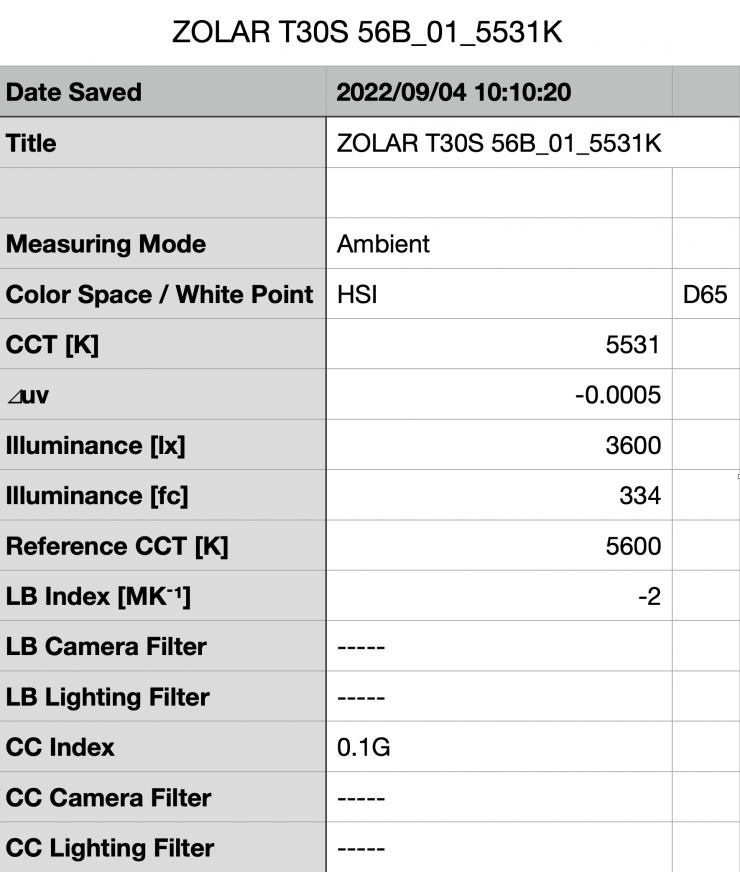
As you can use the ZOLAR Stylist W diffusion panels on their B side, I was interested to see how much that affected the output.
Above you can see that the Toliman 30S recorded an output of 3600 lx (334 fc) when set at 5600K with its Stylist W diffusion panel (side B) and run via mains power. This tells me that when you use the side B diffusion the output of the light gets reduced by 23.2%.
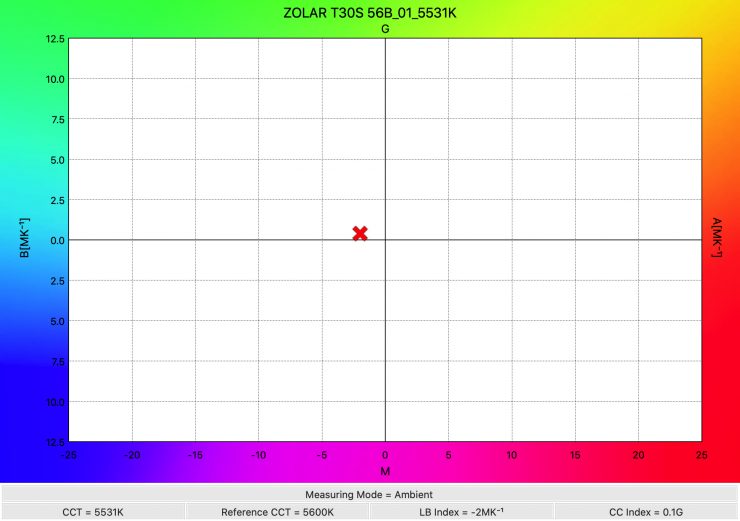
The light recorded a CCT of 5531K when used with its B side diffusion which was actually a slightly better result than the 5450K it recorded when using the A side diffusion.
ZOLAR Toliman 30C 5600K (Stylist W Side A)
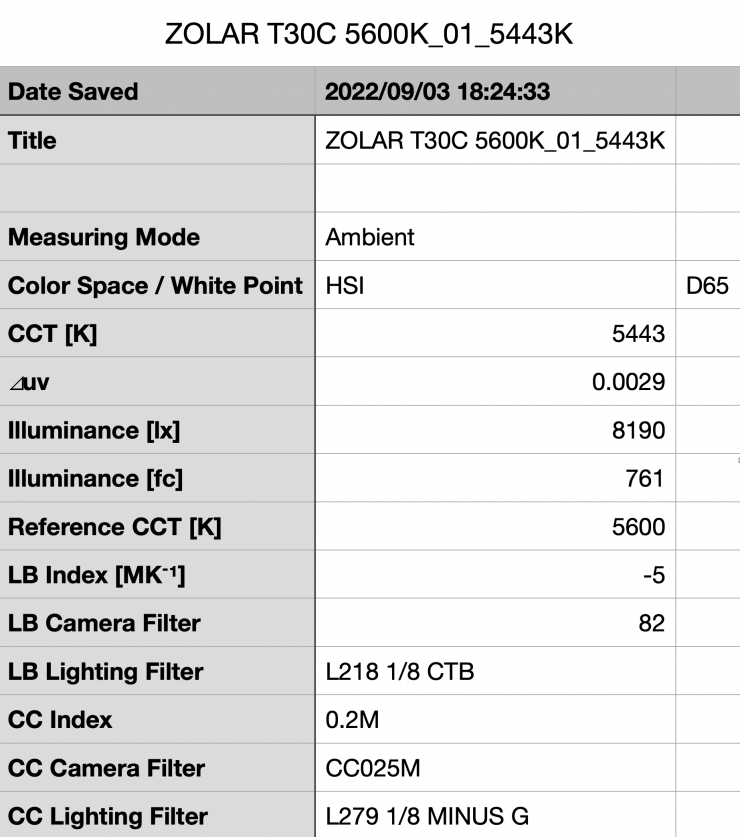
Above you can see the light recorded an output of 8190 lx (761 fc) when set at 5600K with its Stylist W diffusion panel (side A) and run via mains power. This was an impressive amount of output for a light with a 200W power draw.

Above you can see the claimed figures from the manufacturer. From my testing, I found that the output I recorded was higher than those claimed by the manufacturer.
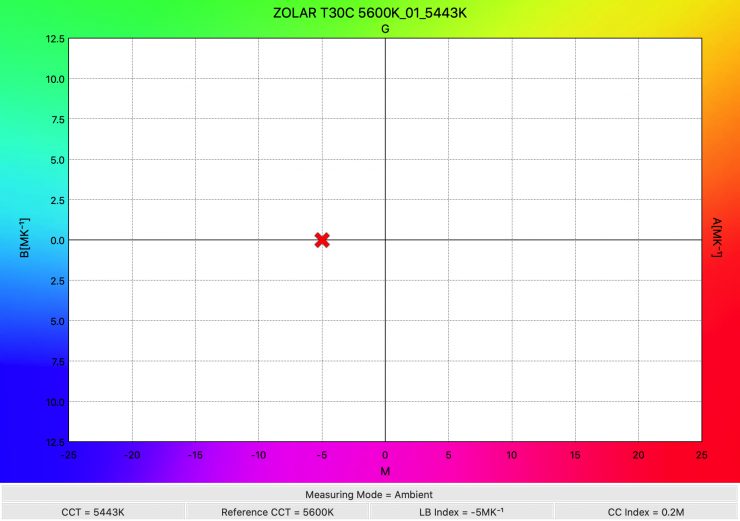
The light recorded a CCT of 5443K which was ok, but it was still more than 150K off.
ZOLAR Vega 30C (Stylist W Side A) High Color Mode
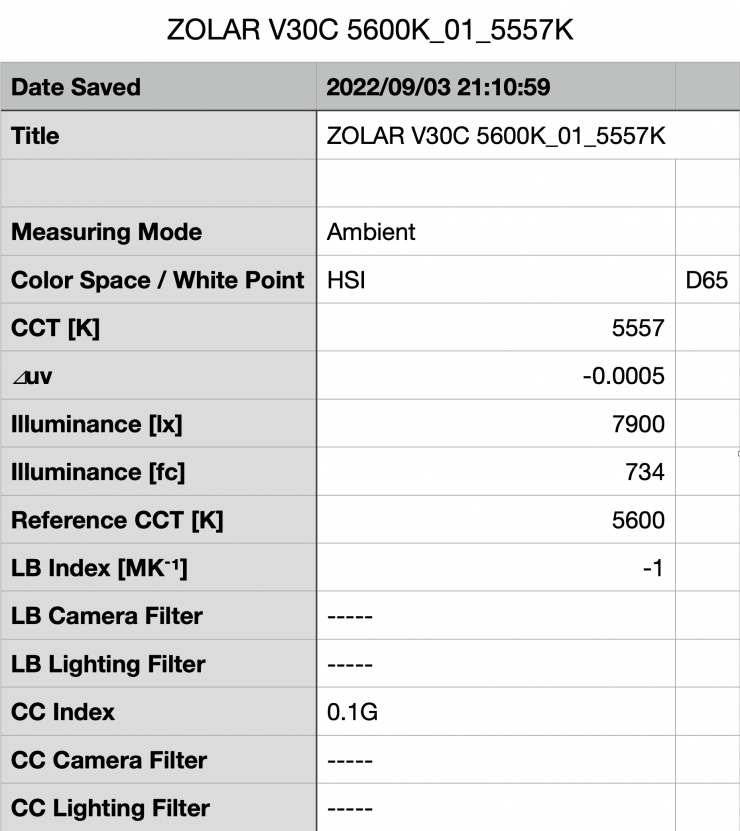
Above you can see that the Vega 30C recorded an output of 7900 lx (734 fc) when set at 5600K with its Stylist W diffusion panel (side A) and run via mains power in its High Color mode. This was an impressive amount of output.

Above you can see the claimed figures from the manufacturer. From my testing, I found that the output figures I recorded actually exceeded that of the manufacturer’s claims.
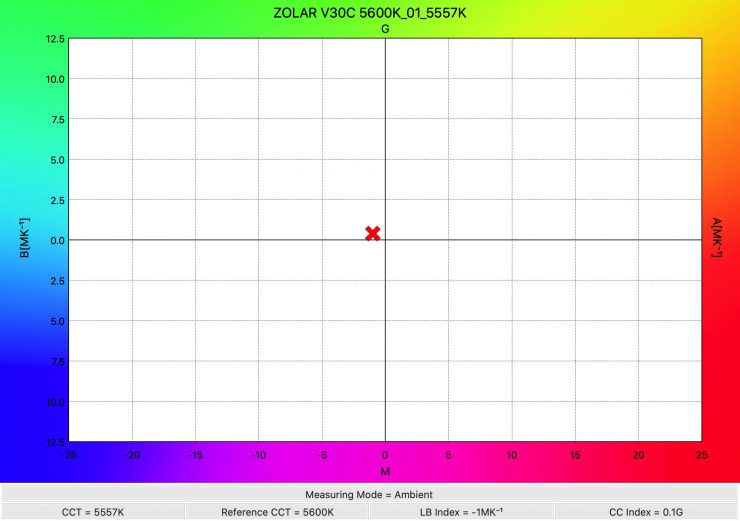
The light recorded a CCT of 5557K which was very accurate.
ZOLAR Vega 30C (Stylist W Side A) High Output Mode
The ZOLAR Vega 30C has the ability to be used in both High Color and High Output modes. So let’s see how much output it produces in the High Output mode.
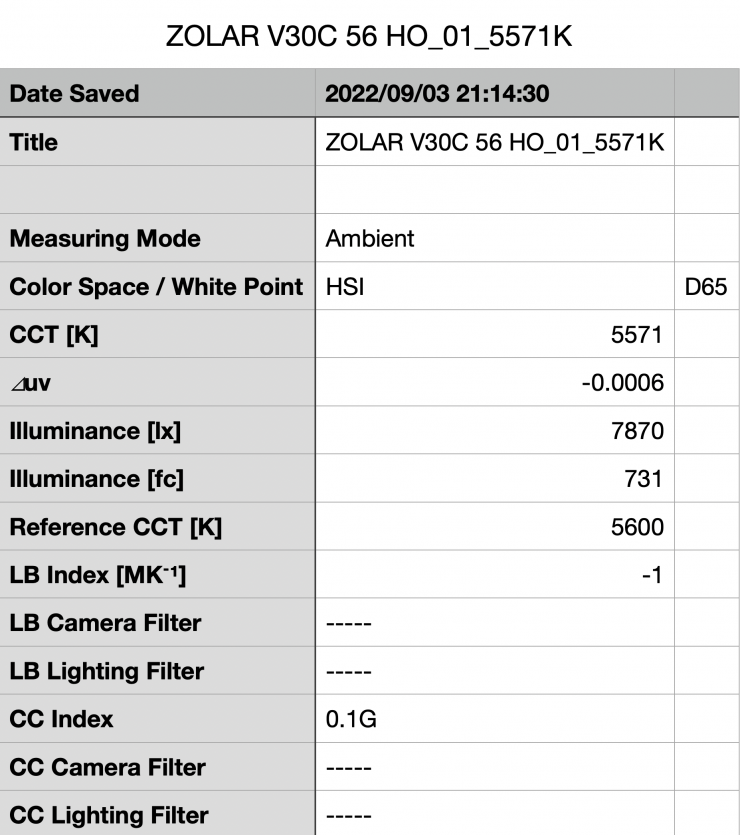
Above you can see that the Vega 30C recorded an output of 7870 lx (731 fc) when set at 5600K with its Stylist W diffusion panel (side A) and run via mains power in its High Output mode. This was actually almost identical to the output it produced in the High Color mode. I am not sure what the reason behind this was.
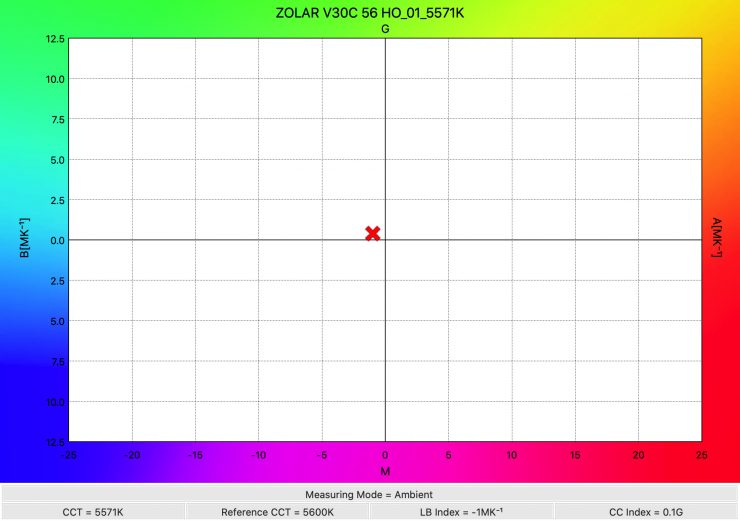
The light recorded a CCT of 5571K which was very accurate.
How does the output of the ZOLAR fixtures compare when used at 5600K to other 1×1 fixtures? Well, that is tricky, because it is hard to compare lights with vastly different beam angles, power draws, and diffusion. I have listed outputs, beam angle and power draw for some of the competing lights below.
5600K
| OUTPUT | POWER DRAW | BEAM ANGLE | |
| ZOLAR Toliman 30S | 4690 lx | 140W | 40° |
| ZOLAR Toliman 30C | 8190 lx | 250W | 90° |
| ZOLAR Vega 30C | 7900 lx | 250W | 90° |
| Luxli Timpani² (No Diffusion Panel) | 6171 lx | 120W | 78° |
| Luxli Timpani² (Diffusion Panel) | 3810 lx | 120W | 78° |
| Luxli Timpani (No Diffusion) | 3840 lx | 120W | 78° |
| Rotolight Titan X2 (100% Smartsoft Diffusion) | 3180 lx | 230W | 150° |
| Rotolight Titan X2 (No Diffusion) | 8210 lx | 230W | 68° |
| ARRI SkyPanel S30-C | 5950 lx | 200W | 110° |
| Litepanels Gemini 1×1 Soft | 6260 lx | 200W | 95° |
| Litepanels Gemini 1×1 HARD (Light Diffusion) | 15700 lx | 200W | 46° |
| Lupo Superpanel 30 Full Color Soft | 4380 lx | 200W | 115 |
| Lupo Superpanel 30 Full Color | 16900 lx | 200W | 40° |
| Aputure NOVA P300c | 9600 lx | 360W | 120° |
As you can clearly see, the output varies depending on the beam angle, diffusion, and power draw of the light. It is impossible to do an apples-to-apples comparison unless the two lights you are comparing have the same power draw, beam angle and diffusion.
3200K
ZOLAR Toliman 30S 3200K (Stylist W Side A)
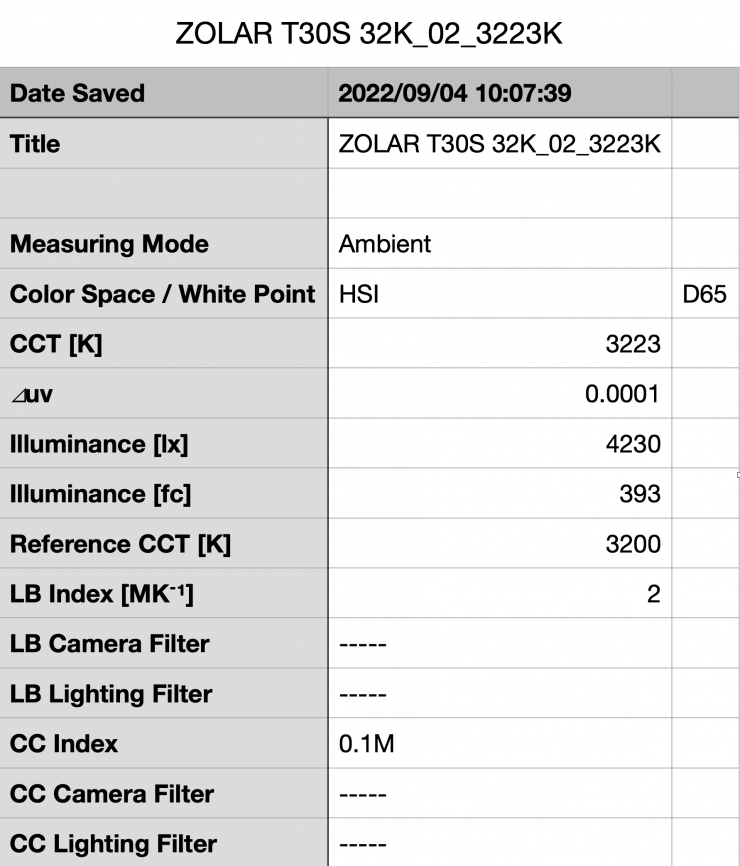
Above you can see that the Toliman 30S recorded an output of 4230 lx (393 fc) when set at 3200K with its Stylist W diffusion panel (side A) and run via mains power. This was 9.8% less output than when it is used at 5600K.
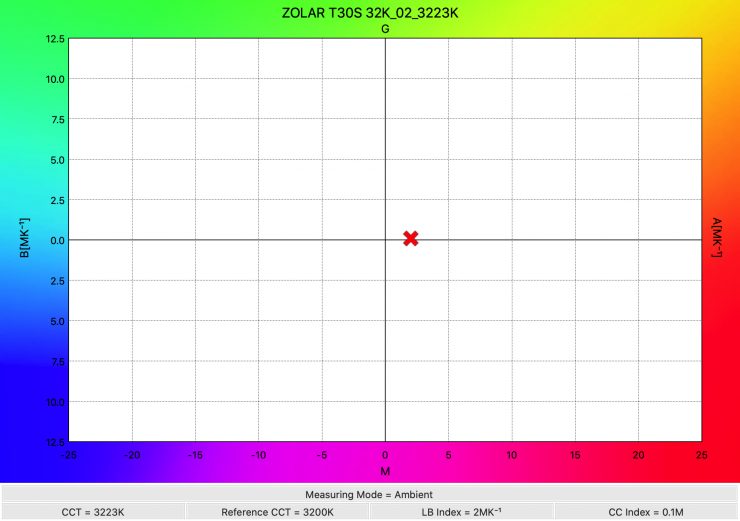
The light recorded a CCT of 3223K which was very accurate.
ZOLAR Toliman 30S 3200K (Stylist W Side B)
As you can use the ZOLAR Stylist W diffusion panels on their B side, I was interested to see how much that affected the output.
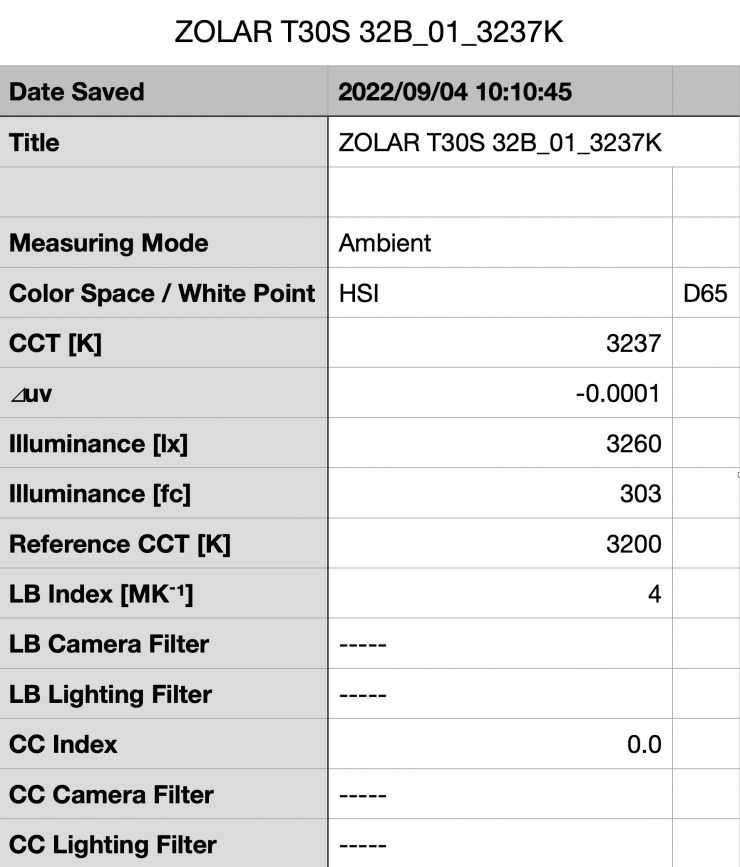
Above you can see that the Toliman 30S recorded an output of 3260 lx (303 fc) when set at 3200K with its Stylist W diffusion panel (side B) and run via mains power. This tells me that when you use the side B diffusion the output of the light gets reduced by 22.9%.
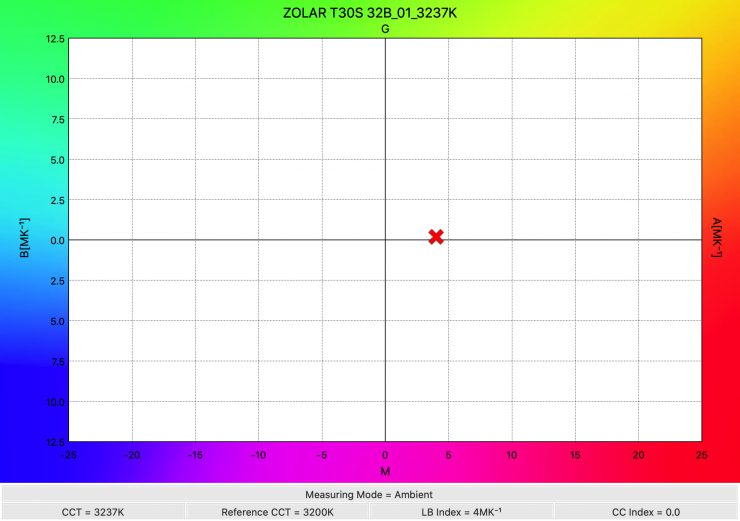
The light recorded a CCT of 3237K when used with its B side diffusion which was very close to the 3223K it recorded when using the A side diffusion.
ZOLAR Toliman 30C 3200K (Stylist W Side A)
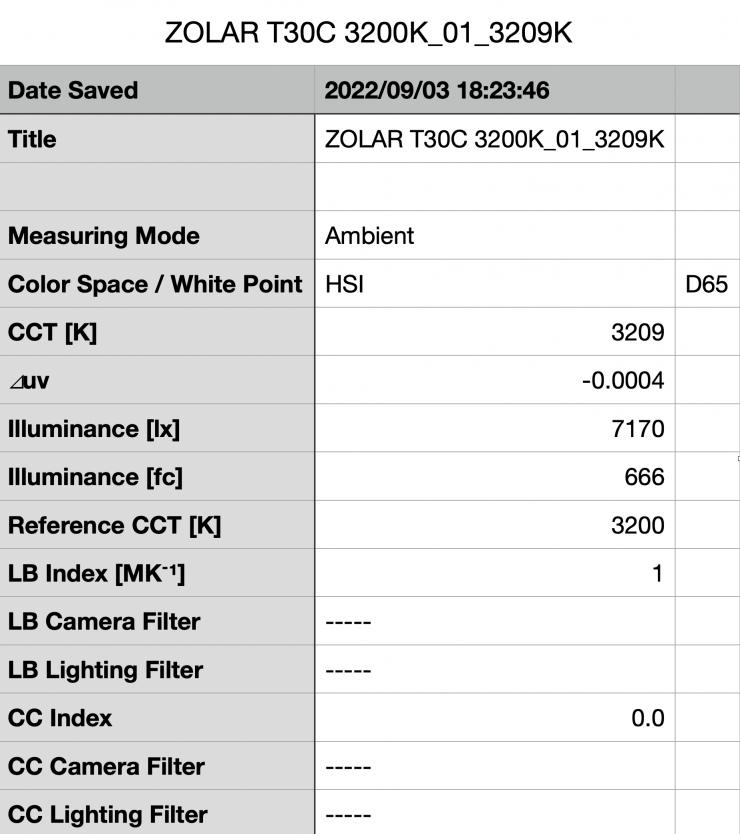
Above you can see the light recorded an output of 7170 lx (666 fc) when set at 3200K using its Stylist W diffusion panel (side A) and running via mains power. This was 12.45% less than it was recorded when used at 5600K.
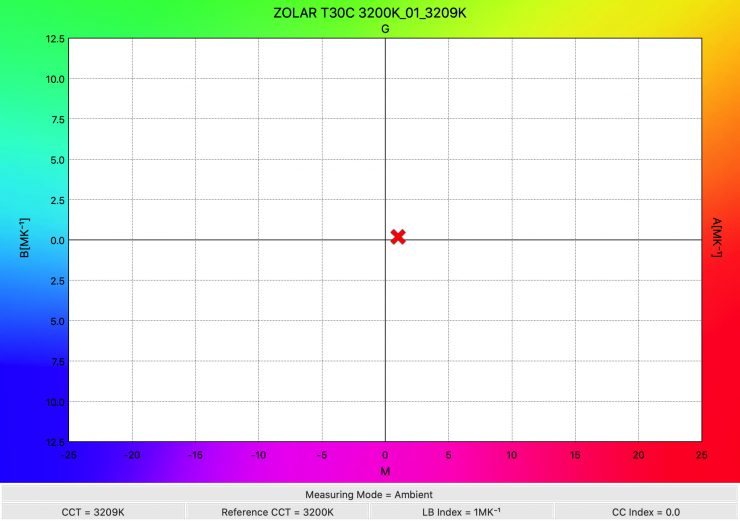
The Toliman 30C produced a Kelvin color temperature of 3209K which was very close to being perfect.
ZOLAR Vega 30C 3200K (Stylist W Side A) High Color Mode
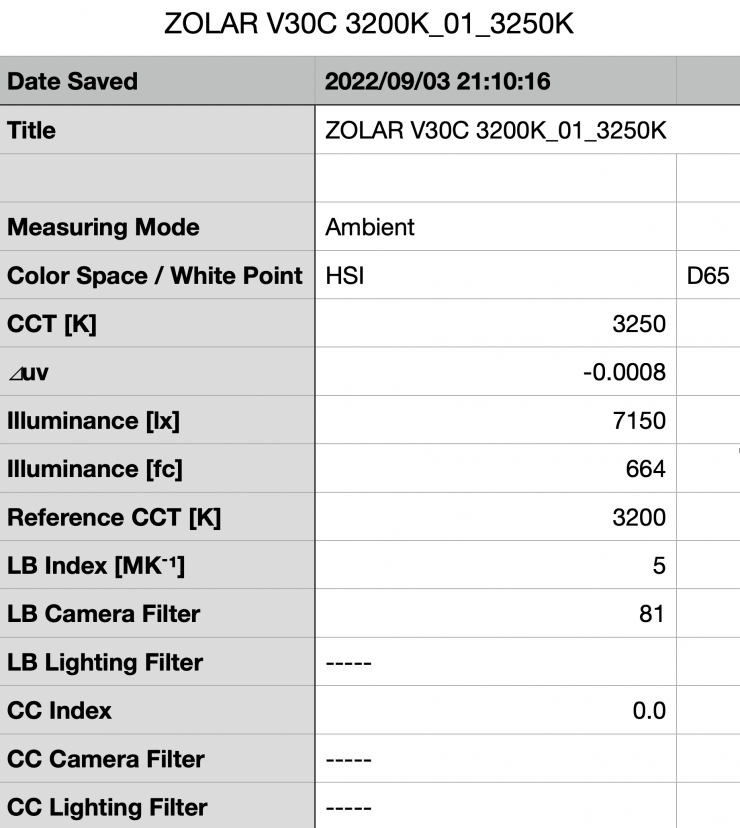
Above you can see the light recorded an output of 7150 lx (664 fc) when set at 3200K with its Stylist W diffusion panel (side A) and run via mains power in its High Color mode.
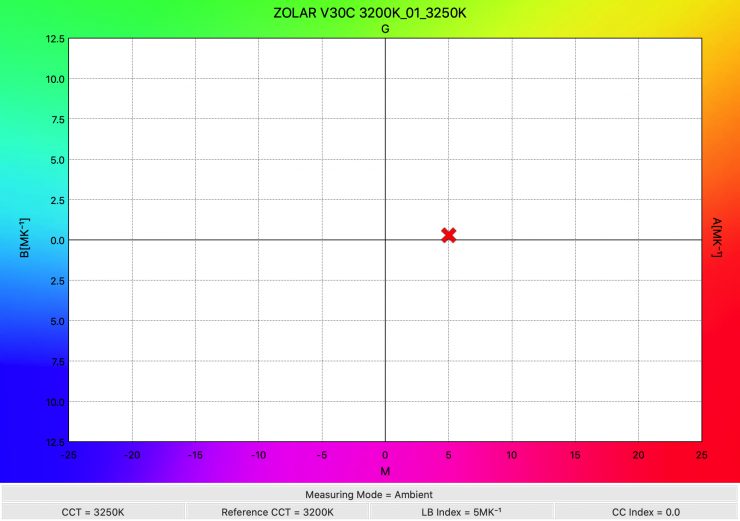
The Vega 30C produced a Kelvin color temperature of 3250K which was a good reading.
ZOLAR Vega 30C (Stylist W Side A) High Output Mode
The ZOLAR Vega 30C has the ability to be used in both High Color and High Output modes. So let’s see how much output it produces in High Output Mode.
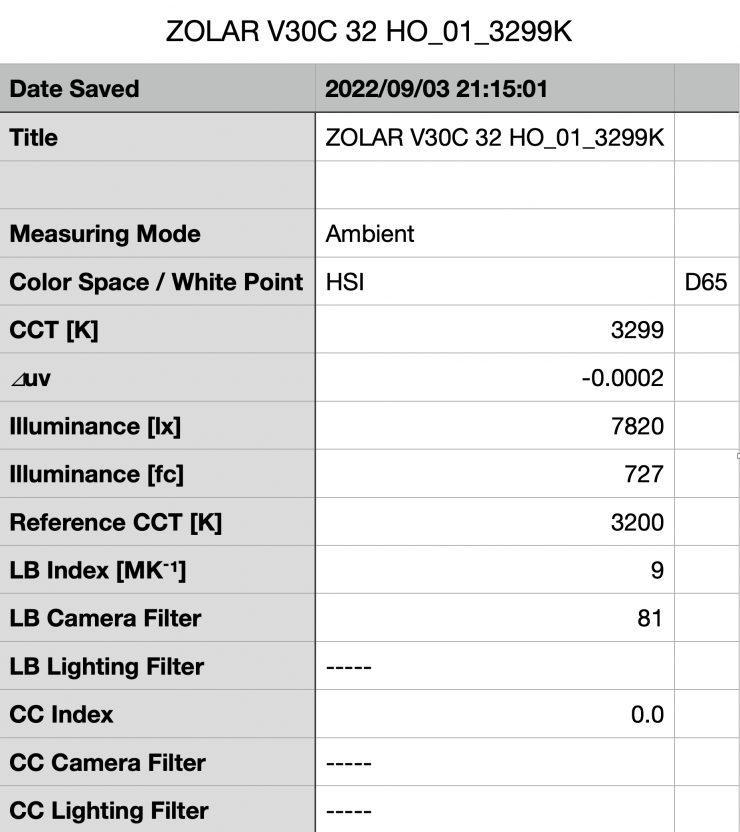
Above you can see the light recorded an output of 7820 lx (727 fc) when set at 3200K with its Stylist W diffusion panel (side A) and run via mains power in its High Output mode. This was an increase of 9.37% over when it was used in its High Color mode.
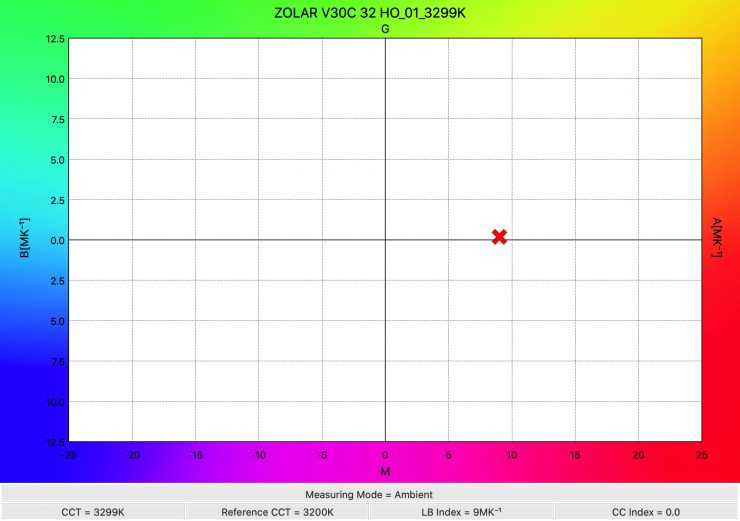
The Vega 30C produced a Kelvin color temperature of 3299K when used in its High Output mode which is only 44K higher than the reading in its High Color mode.
Saturated Red
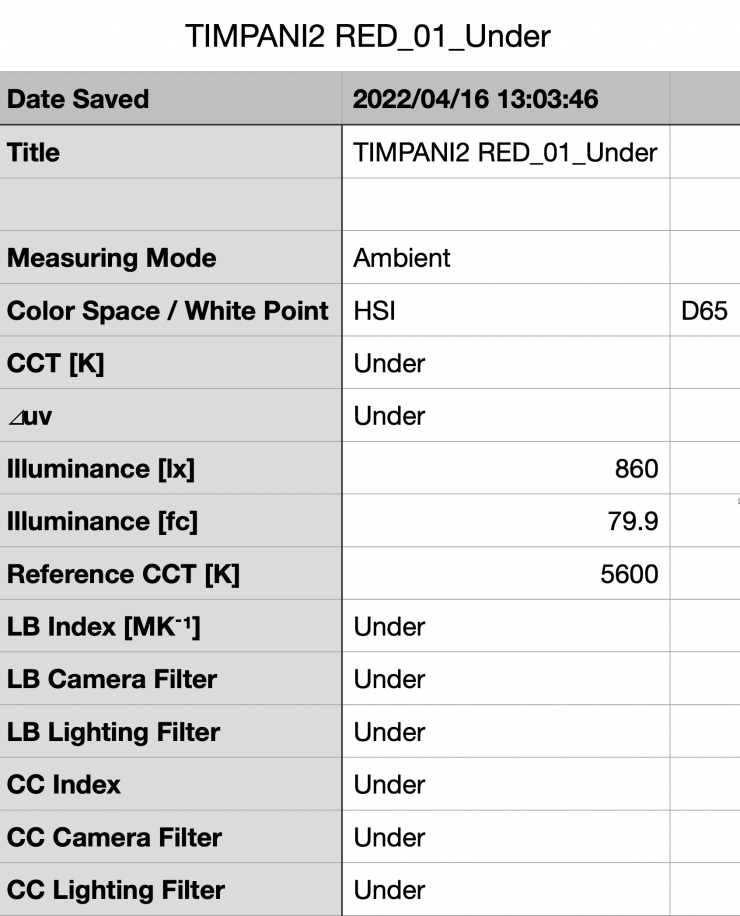
I also wanted to see how much output the light produced when creating a completely saturated red. The light recorded an output of 860 lx (79.9 fc). This is basically the equivalent of using the light at around 8-10% output if it was set at 5600K. It is important to know that RGBW lights put out significantly less output when you are creating certain saturated colors.
How do the lights perform at various Kelvin color temperatures?
So how do the ZOLAR fixtures perform at various Kelvin color temperatures when it comes to output and Kelvin color temperatures? Well, below you can see.
ZOLAR Toliman 30S (Stylist W Side A)
| KELVIN SETTING | LUX | CCT READING |
| 3200K | 4230 lx | 3223K |
| 4500K | 4510 lx | 4432K |
| 5600K | 4690 lx | 5450K |
These results tell me that the light has excellent CCT accuracy across its range. The output is also pretty consistent regardless of the CCT setting.
ZOLAR Toliman 30C (Stylist W Side A)
| KELVIN SETTING | LUX | CCT READING |
| 3200K | 7170 lx | 3209K |
| 4500K | 7740 lx | 4460K |
| 5600K | 8190 lx | 5443K |
These results tell me that the light has very good CCT accuracy across its range, however, it is at its most accurate when used between 3200-4500K. The output varies by 14.22% from 3200K to 5600K.
ZOLAR Vega 30C (Stylist W Side A) High Color Mode
| KELVIN SETTING | LUX | CCT READING |
| 2500K | 6720 lx | 2638K |
| 3200K | 7150 lx | 3250K |
| 4500K | 7810 lx | 4490K |
| 5600K | 7900 lx | 5557K |
| 6500K | 7430 lx | 6403K |
| 8000K | 6890 lx | 8004K |
| 10000K | 6540 lx | 9709K |
These results tell me that the light has excellent CCT accuracy across its range, however, it is at its most accurate when used between 3200-8000K. The output varies by 20.8% from the highest to lowest recorded readings.
Thoughts
The output of the lights could be more consistent across their CCT range, but in saying that, there weren’t any massive differences that I was concerned about. The color temperature readings were consistently good across all of the lights.
CCT consistency & linear output when dimming the light
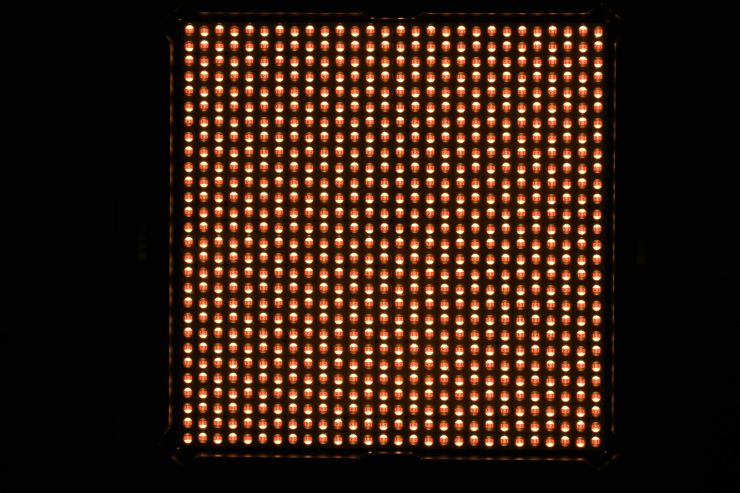
Now, what you should always do when testing lights is to see if the CCT remains consistent when dimming the light. Just because you set a light at say 5600K, that doesn’t mean that the CCT will remain stable as you start dimming the fixture down. I also wanted to see how linear the dimming curve was.
I decided to do a series of tests at 100%/75%/50%/25%10% to see if the Kelvin color temperature being recorded changed. This was done at a distance of 1m using a Sekonic C-800. These tests were conducted in the light’s Linear Dimming modes.
ZOLAR Toliman 30S (Stylist W Side A) 5600K
| CCT READING | OUTPUT | INTENSITY % |
| 5450K | 4690 lx | 100 |
| 5492K | 3690 lx | 75 |
| 5497K | 2450 lx | 50 |
| 5465K | 1190 lx | 25 |
| 5426K | 456 lx | 10 |
The Toliman 30S maintained good color temperature consistency even when dimming it right down. The reading only changed by 71K. As far as how linear the output is when you start dimming the light, at 50% output it had 47.7% less output than when used at 100%. At 25% it had 74.6% less output than when used at 100%. At 10% output it had 90.2% less output than when used at 100%. This shows me that the light’s dimming curve is very close to being perfectly linear.
ZOLAR Toliman 30C (Stylist W Side A) 5600K
| CCT READING | OUTPUT | INTENSITY % |
| 5443K | 8190 lx | 100 |
| 5471K | 6160 lx | 75 |
| 5450K | 4100 lx | 50 |
| 5431K | 2050 lx | 25 |
| 5417K | 873 lx | 10 |
The Toliman 30C maintained good color temperature consistency even when dimming it right down. The reading only changed by 54K. As far as how linear the output is when you start dimming the light, at 50% output it had 49.9% less output than when used at 100%. At 25% it had 74.9% less output than when used at 100%. At 10% output it had 89.3% less output than when used at 100%. This shows me that the light’s dimming curve is very close to being perfectly linear.
ZOLAR Vega 30C (Stylist W Side A) High Color Mode 5600K
| CCT READING | OUTPUT | INTENSITY % |
| 5557K | 7900 lx | 100 |
| 5579K | 5560 lx | 75 |
| 5561K | 3870 lx | 50 |
| 5539K | 1190 lx | 25 |
| 5520K | 811 lx | 10 |
The Vega 30C maintained good color temperature consistency even when dimming it right down. The reading only changed by 59K. As far as how linear the output is when you start dimming the light, at 50% output it had 51% less output than when used at 100%. At 25% it had 84.9% less output than when used at 100%. At 10% output it had 89.7% less output than when used at 100%. This shows me that the light’s dimming curve is close to being perfectly linear, however, there was a discrepancy when it was set at 25%.
Color Rendering
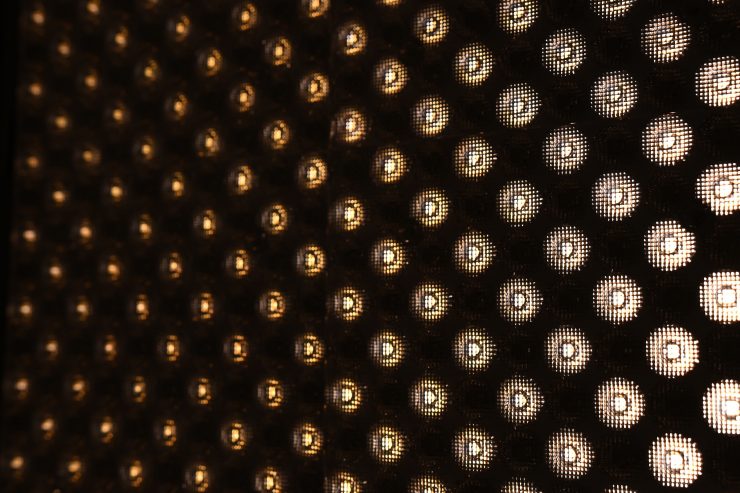
So now that we have seen how much output the lights produce, how do they perform when it comes to replicating accurate colors? Well, let’s first have a look at lights when they are used at 5600K.
5600K
ZOLAR Toliman 30S (Stylist W Side A) 5600K
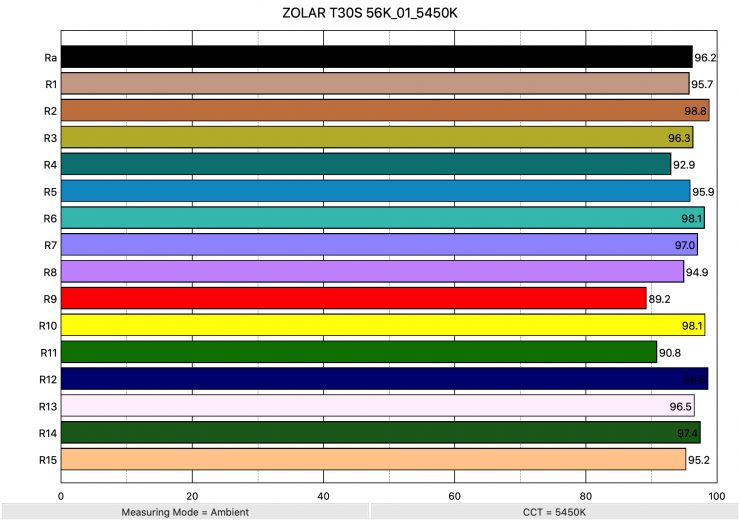
Above you can see that when the Toliman 30S was set at 5600K it recorded an average CRI (R1-R8) of 96.2 and an extended CRI (R1-R15) of 95.69. For replicating accurate skin tones it recorded 89.2 for R9 (red), 96.5 for R13 (closest to caucasian skin tones), and 95.2 for R15 (closest to Asian skin tones).
These were very solid results. Only R9 was below 90.
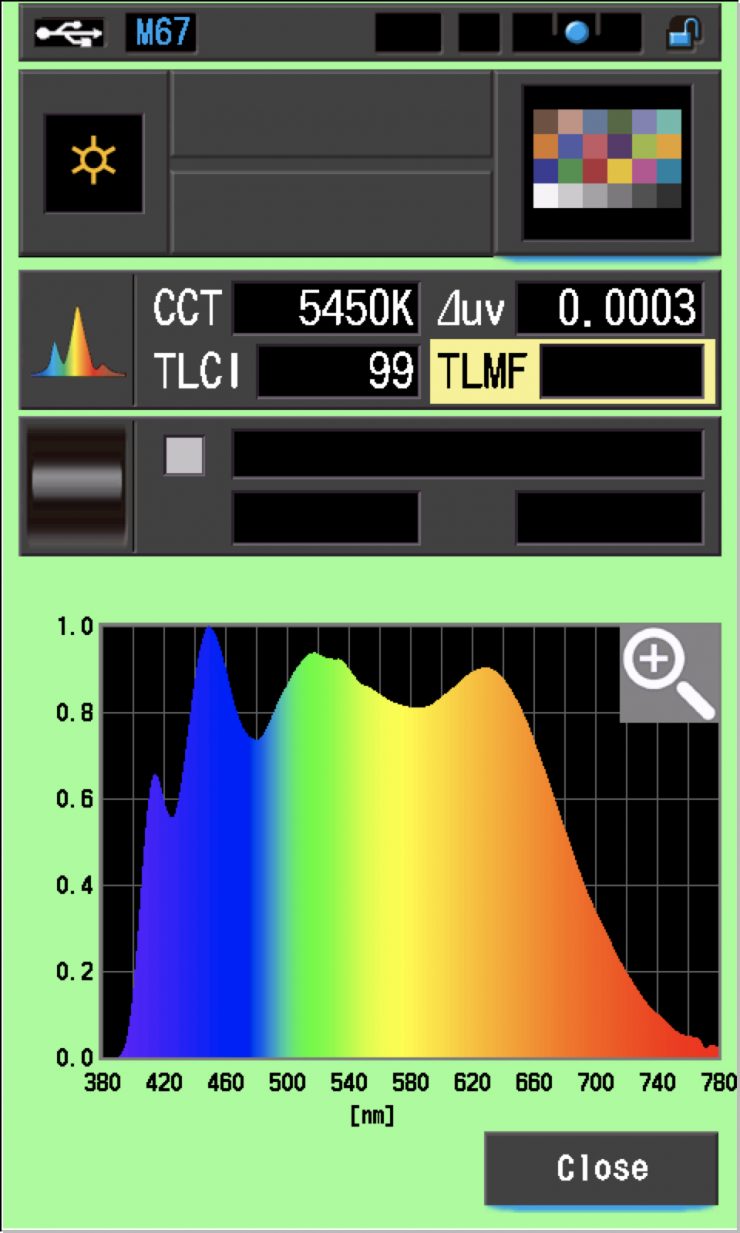
Above you can see that the ZOLAR Toliman 30S had a TLCI score of 99 when used at 5600K.
ZOLAR Toliman 30C (Stylist W Side A) 5600K
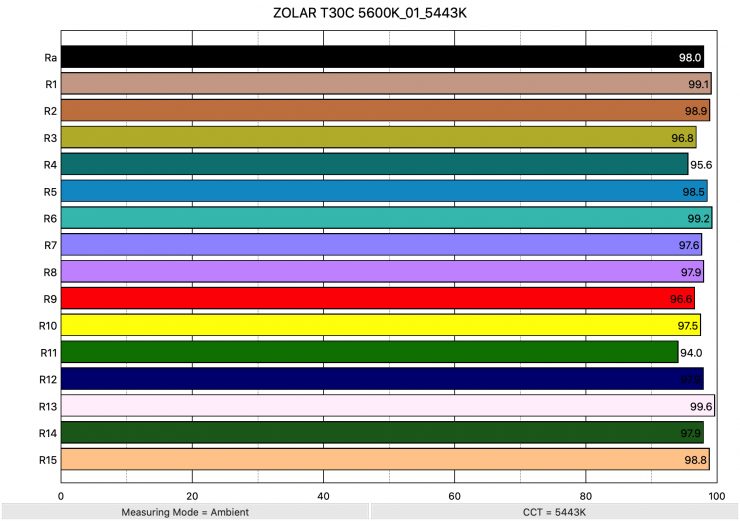
Above you can see that when the Toliman 30C was set at 5600K it recorded an average CRI (R1-R8) of 98.0 and an extended CRI (R1-R15) of 97.73. For replicating accurate skin tones it recorded 96.6 for R9 (red), 99.6 for R13 (closest to caucasian skin tones), and 98.8 for R15 (closest to Asian skin tones).
These were outstanding results and some of the best I have seen from any light, period. This is the first light I have ever tested where every single value from R1-R15 was above 90.
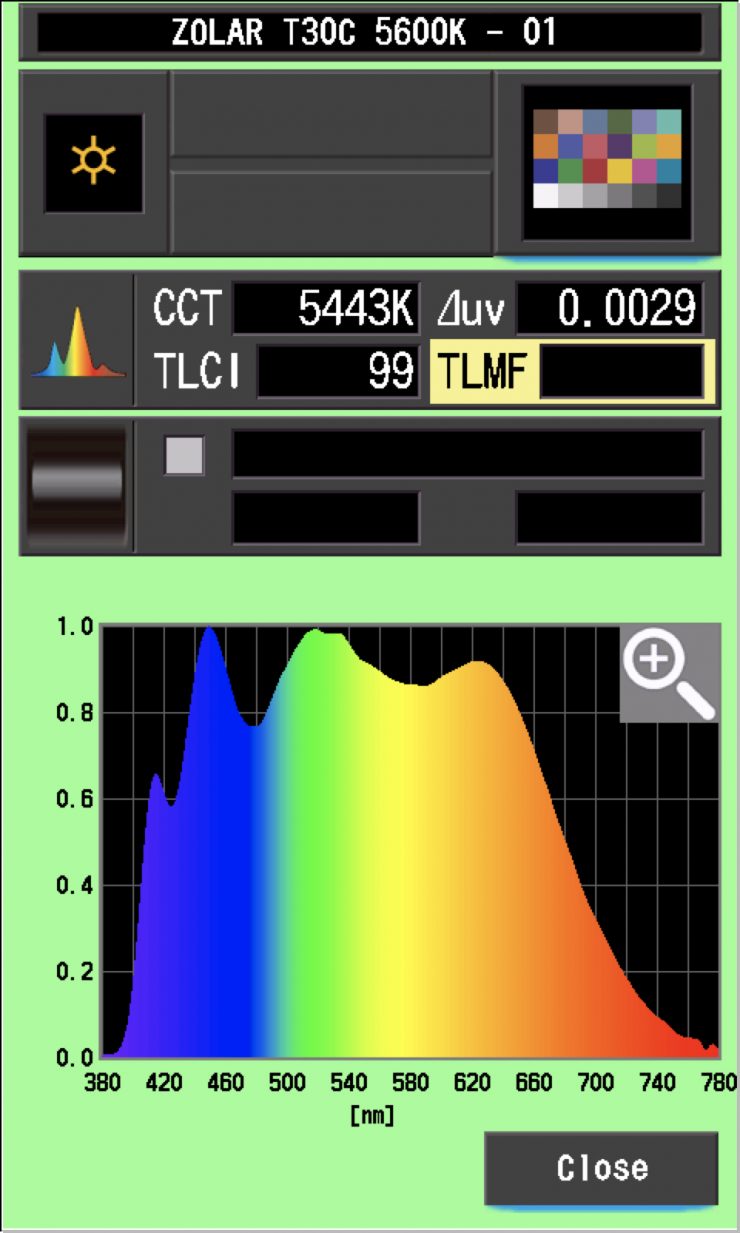
Above you can see that the ZOLAR Toliman 30C had a TLCI score of 99 when used at 5600K.
ZOLAR Vega 30C (Stylist W Side A) High Color Mode 5600K
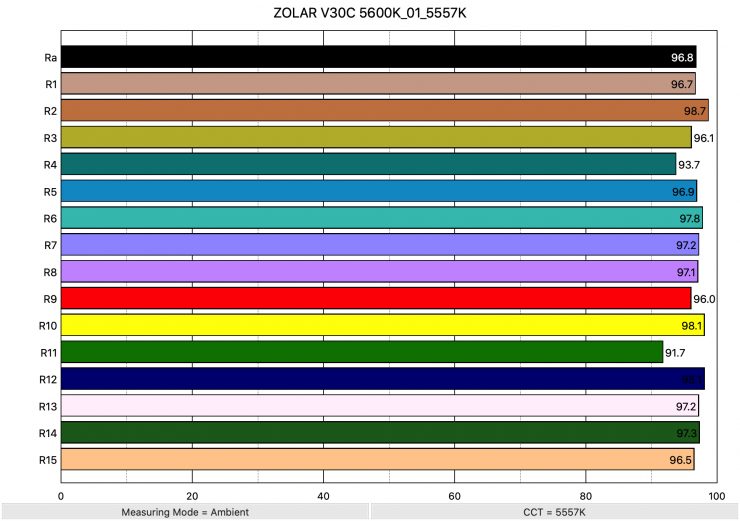
Above you can see that when the Vega 30C was set at 5600K in its High Color mode it recorded an average CRI (R1-R8) of 96.8 and an extended CRI (R1-R15) of 96.60. For replicating accurate skin tones it recorded 96.0 for R9 (red), 97.2 for R13 (closest to caucasian skin tones), and 96.5 for R15 (closest to Asian skin tones).
These were great results, but they weren’t quite as good as the Toliman 30C. Just like the Toliman 30C, every single value from R1-R15 was above 90.
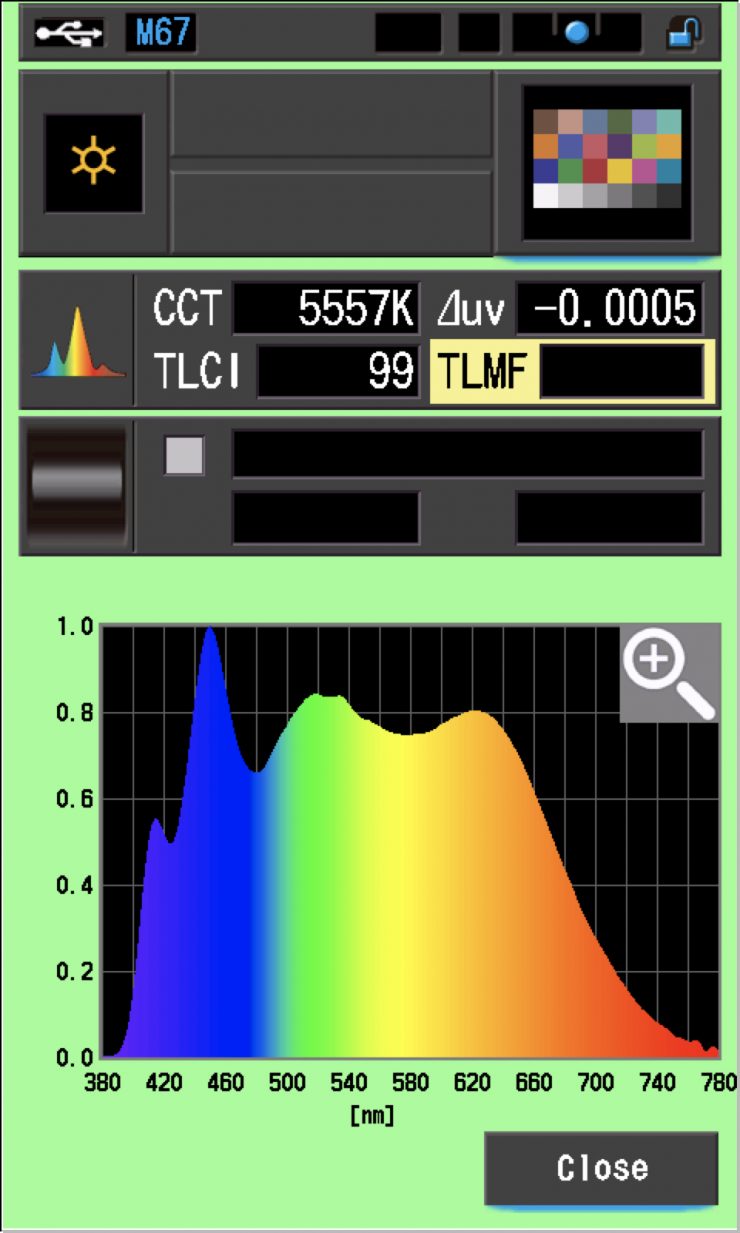
Above you can see that the ZOLAR Vega 30C had a TLCI score of 99 when used at 5600K.
So how do the extended CRI results taken at 5600K compare to some of the competition? Well, below you can see:
| EXTENDED CRI | |
| ZOLAR Toliman 30S | 96.69 |
| ZOLAR Tolman 30C | 97.73 |
| ZOLAR Vega 30C | 96.60 |
| Luxli Timpani² | 94.70 |
| Luxli Timpani | 96.2 |
| Rotolight Titan X1 | 95.44 |
| ARRI SkyPanel S30-C | 93.39 |
| Litepanels Gemini 1×1 Soft | 91.32 |
| Litepanels Gemini 1×1 HARD | 96.52 |
| Lupo Superpanel 30 Full Color Soft | 93.4 |
| Lupo Superpanel 30 Full Color | 93.59 |
| Aputure NOVA P300c | 95.34 |
As you can see, most of these lights are very close and you would be hard-pressed to tell any of them apart. However, all three of the ZOLAR fixtures recorded higher scores than any of these competing lights I have tested at 5600K.
3200K
Now, that we have seen how the lights perform at 5600K, let’s look at how they do at 3200K.
ZOLAR Toliman 30S (Stylist W Side A) 3200K
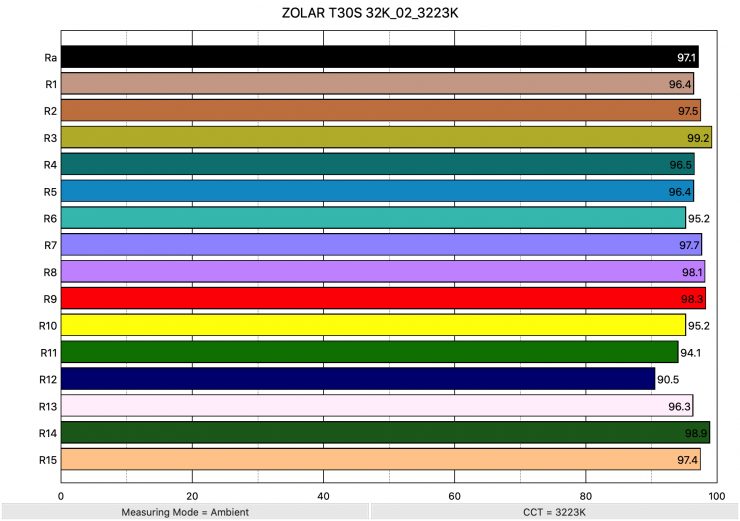
Above you can see that when the Toliman 30S was set at 3200K it recorded an average CRI (R1-R8) of 97.1 and an extended CRI (R1-R15) of 95.69. For replicating accurate skin tones it recorded 98.3 for R9 (red), 96.3 for R13 (closest to caucasian skin tones), and 97.4 for R15 (closest to Asian skin tones).
These were outstanding results and every value for R1-R15 was higher than 90.
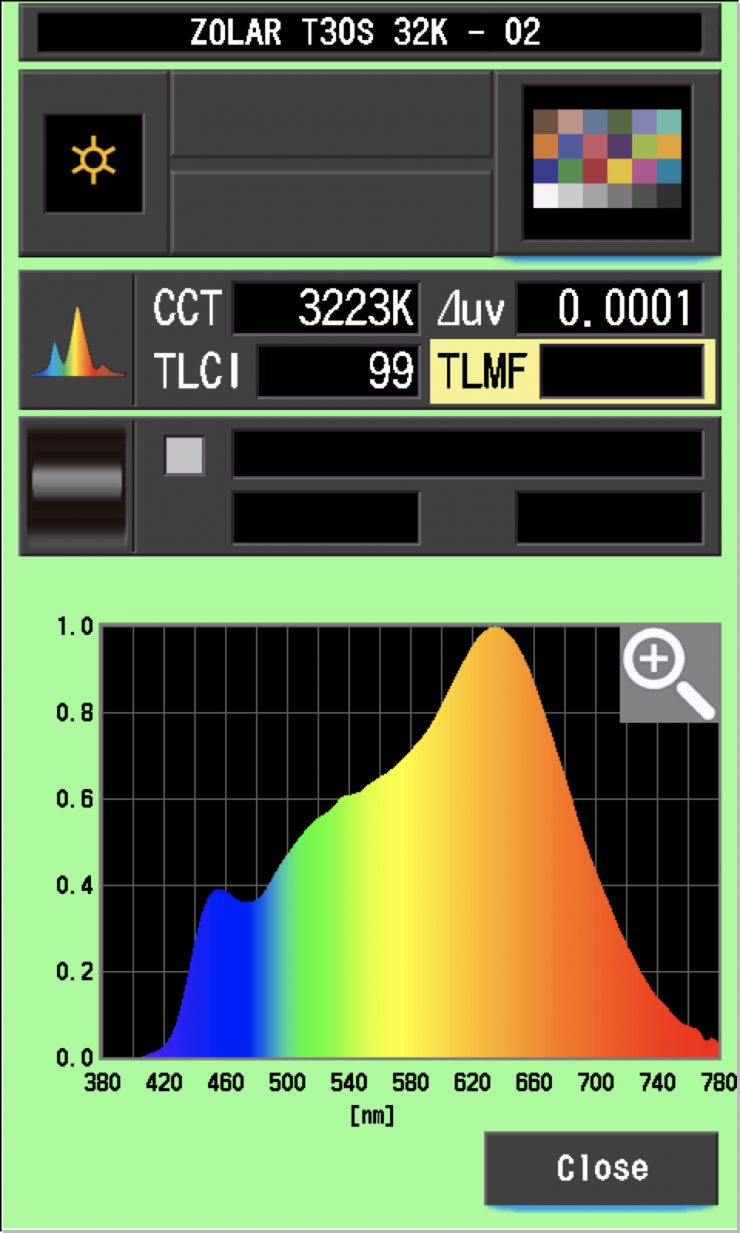
Above you can see that the ZOLAR Toliman 30C had a TLCI score of 99 when used at 3200K.
ZOLAR Toliman 30C (Stylist W Side A) 3200K
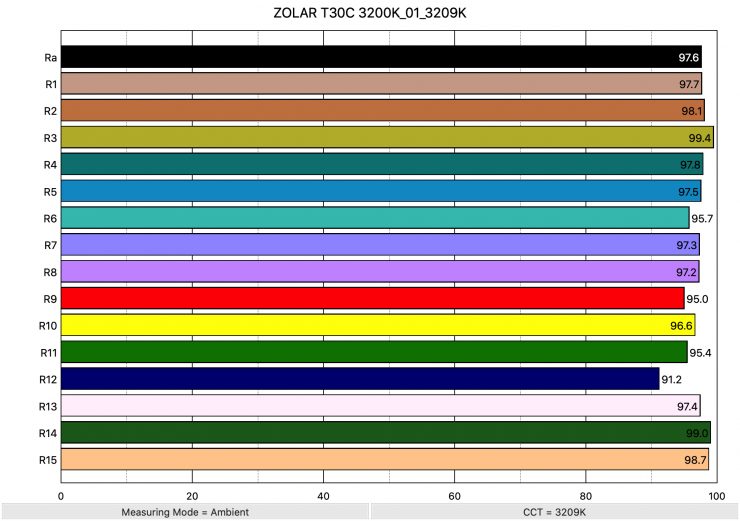
Above you can see the results for the Toliman 30C at 3200K. The light recorded an average CRI (R1-R8) of 97.6 and an extended CRI (R1-R15) of 96.93. For replicating accurate skin tones it recorded 95.0 for R9 (red), 99.0 for R13 (closest to caucasian skin tones), and 98.7 for R15 (closest to Asian skin tones). Again, these are exceptionally good scores and right up there with the best scores I have ever seen from a 1×1 style light. Just like at 5600K, the light didn’t have a single R1-R15 value under 90.
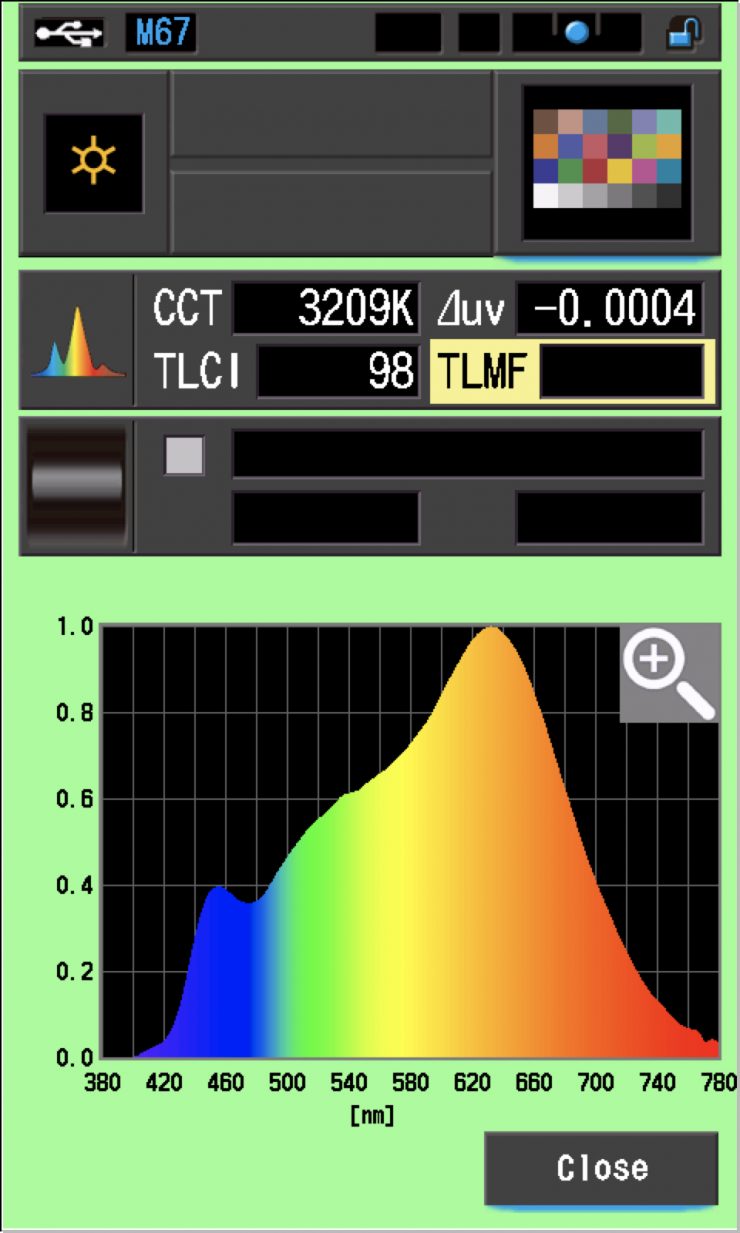
Above you can see that the Toliman 30C had a TLCI score of 98 when used at 3200K.
ZOLAR Vega 30C (Stylist W Side A) High Color Mode 3200K
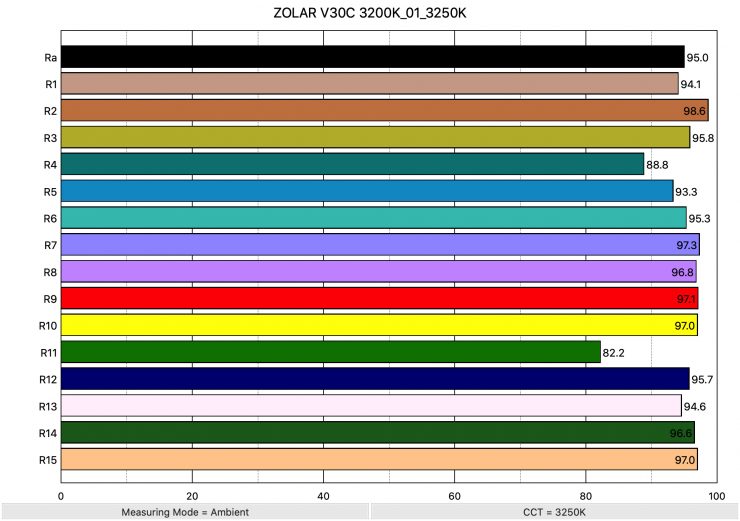
Above you can see that when the Vega 30C was set at 3200K in its High Color mode it recorded an average CRI (R1-R8) of 95.0 and an extended CRI (R1-R15) of 94.68. For replicating accurate skin tones it recorded 97.1 for R9 (red), 94.6 for R13 (closest to caucasian skin tones), and 97.0 for R15 (closest to Asian skin tones).
These were great results, but they weren’t quite as good as the Toliman 30C. Unlike at 5600K, the light had both R4 and R11 score below 90.
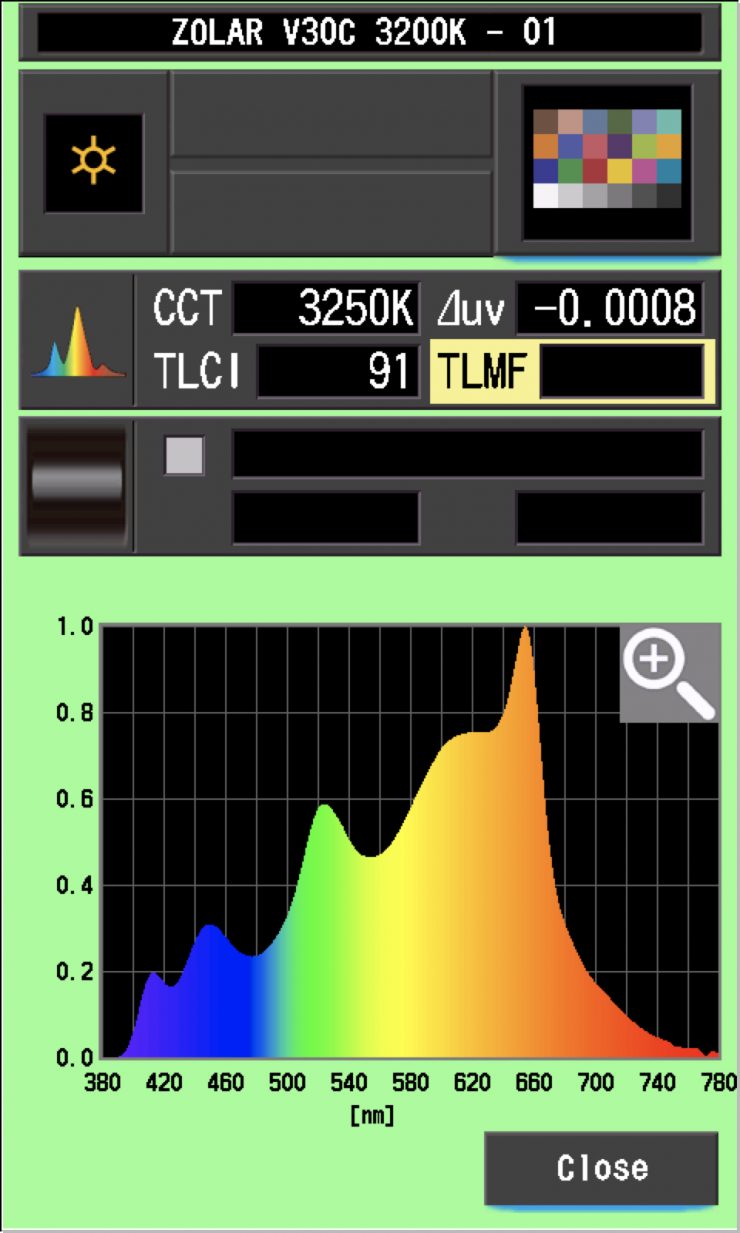
Above you can see that the Vega 30C had a TLCI score of just 91 when used at 3200K. This was strange result, but the tests don’t lie
ZOLAR Vega 30C (Stylist W Side B) High Color Mode 3200K
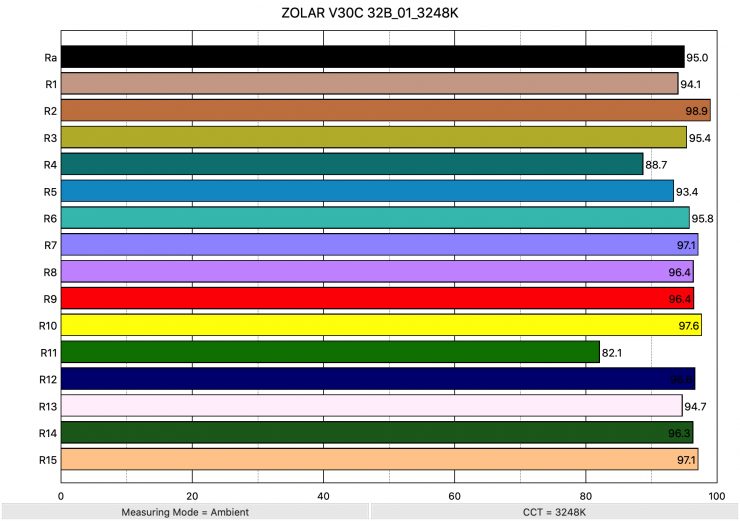
I was interested to see if the color rendering scores changed at all when changing the ZOLAR Stylist W to its B side.
Above you can see that when the Vega 30C was set at 3200K in its High Color mode using the side B diffusion it recorded an average CRI (R1-R8) of 95.0 and an extended CRI (R1-R15) of 94.68. For replicating accurate skin tones it recorded 96.4 for R9 (red), 94.7 for R13 (closest to caucasian skin tones), and 97.1 for R15 (closest to Asian skin tones). This tells me that using the B side on the diffusion panel isn’t changing the color rendering.
So how do the extended CRI results compare to some of the competition? Well, below you can see:
| EXTENDED CRI | |
| ZOLAR Toliman 30S | 95.69 |
| ZOLAR Toliman 30C | 96.93 |
| ZOLAR Vega 30C | 94.69 |
| Luxli Timpani² | 96.90 |
| Luxli Timpani | 95.45 |
| Rotolight Titan X1 | 91.83 |
| ARRI SkyPanel S30-C | 93.56 |
| Litepanels Gemini 1×1 Soft | 93.32 |
| Litepanels Gemini 1×1 HARD | 93.32 |
| Lupo Superpanel 30 Full Color Soft | 91.86 |
| Lupo Superpanel 30 Full Color | 90.7 |
| Aputure NOVA P300c | 95.64 |
Again, as you can see, all of these lights are very close and you would be hard-pressed to tell any of them apart. The ZOLAR Toliman 30C actauly pipped the Luxli Timpani² for the highest extended CRI score of any light I have ever tested at 3200K.
CC Index & ⊿uv
The CC Index displays the CC correction value and whether any magenta or green needs to be added or subtracted. 1 CC corresponds to 035 Kodak CC values or 1/8 Rosco filter values. Any reading less than +1.00 or -1.00 and you’re probably not going to need to make any kind of adjustment. The ⊿uv is the value to show how much this light is away from being an ideal light source (black body radiation = incandescent lamp). As with the CC Index you want this number to theoretically be zero. Kelvin is not a linear value, so we need to convert from Kelvin to MK-1 to compare the values of color temperature. To calculate from Kelvin to Mired is MK-1= 1*1000000/Kelvin. While this may sound confusing, it is the only way of measuring if the Kelvin shift is significant enough to warrant having to use a filter for correction. Below are the results for the ZOLAR fixtures.
ZOLAR Toliman 30S Kelvin Vs MK-1
| CCT | Difference in K | MK-1 | Difference in MK-1 | |
| SET VALUE | 3200K | 0 | 312.5 | 0 |
| ACTUAL READING | 3223K | 23 | 310.26 | 2.24 MK-1 |
| SET VALUE | 4500K | 0 | 222.22 | 0 |
| ACTUAL READING | 4432K | 68 | 225.63 | -3.41 MK-1 |
| SET VALUE | 5600K | 0 | 178.57 | 0 |
| ACTUAL READING | 5450K | 150 | 183.48 | -4.91 MK-1 |
These figures might look confusing, but what it tells me is that the light is very CCT accurate at all temperatures. Any MK-1 score that is under -9/9 means you wouldn’t have to use any color correction gels. The MK-1 scores for this light were exceptionally good.
| CCT | Difference in K | MK-1 | Difference in MK-1 | |
| SET VALUE | 3200K | 0 | 312.5 | 0 |
| ACTUAL READING | 3209K | 9 | 311.62 | 0.88 MK-1 |
| SET VALUE | 4500K | 0 | 222.22 | 0 |
| ACTUAL READING | 4460K | 40 | 224.21 | -1.99 MK-1 |
| SET VALUE | 5600K | 0 | 178.57 | 0 |
| ACTUAL READING | 5443K | 157 | 183.72 | -5.15 MK-1 |
The light is extremely CCT accurate at all temperatures. Any MK-1 score that is under -9/9 means you wouldn’t have to use any color correction gels. The MK-1 scores for this light were exceptionally good.
ZOLAR Vega 30C Kelvin Vs MK-1
| CCT | Difference in K | MK-1 | Difference in MK-1 | |
| SET VALUE | 2500K | 0 | 400 | 0 |
| ACTUAL READING | 2638K | 138 | 359.06 | 40.94 MK-1 |
| SET VALUE | 3200K | 0 | 312.5 | 0 |
| ACTUAL READING | 3250K | 50 | 307.69 | 4.81 MK-1 |
| SET VALUE | 4500K | 0 | 222.22 | 0 |
| ACTUAL READING | 4460K | 40 | 224.21 | -1.99 MK-1 |
| SET VALUE | 5600K | 0 | 178.57 | 0 |
| ACTUAL READING | 5443K | 31 | 183.72 | -5.15 MK-1 |
| SET VALUE | 6500K | 0 | 153.84 | 0 |
| ACTUAL READING | 6403K | 97 | 156.17 | -2.33 MK-1 |
| SET VALUE | 8000K | 0 | 125 | 0 |
| ACTUAL READING | 8004K | 4 | 124.93 | 0.07 MK-1 |
| SET VALUE | 10000K | 0 | 100.00 | 0 |
| ACTUAL READING | 9709K | 291 | 102.99 | -2.99 MK-1 |
The light is extremely CCT accurate at all temperatures except for 2500K. Any MK-1 score that is under -9/9 means you wouldn’t have to use any color correction gels. The MK-1 scores for this light were very good.
ZOLAR Toliman 30S CC INDEX & ⊿uv
| CC INDEX | ⊿uv | |
| 3200K | 0.1M | 0.0001 |
| 4500K | 0.1G | -0.0021 |
| 5600K | 0 | 0.0003 |
These scores were excellent. You don’t have to worry about any CC Index score unless it is above 1.0.
ZOLAR Toliman 30C CC INDEX & ⊿uv
| CC INDEX | ⊿uv | |
| 3200K | 0 | -0.0004 |
| 4500K | 0 | -0.0005 |
| 5600K | 0.2M | 0.0029 |
These scores were very good. At 5600K it does have a very mild shift, but you don’t have to worry about it unless it is above 1.0.
ZOLAR Vega 30C CC INDEX & ⊿uv
| CC INDEX | ⊿uv | |
| 2500K | 0.2G | -0.0009 |
| 3200K | 0 | -0.0008 |
| 4500K | 0 | -0.0001 |
| 5600K | 0.1G | -0.0005 |
| 6500K | 0.2G | 0.0003 |
| 8000K | 0.6G | -0.0008 |
| 10000K | 0.9G | -0.0004 |
Again, these scores were pretty good. The accurate ⊿uv scores across the light’s entire Kelvin color temperature were exceptionally good. The lights CC INDEX scores were excellent from 2500K to 6500K. At 8000K and above it does start to shift, but you don’t have to worry about it unless it is above 1.0.
TM-30
TM-30 is a relatively new color rendering standard that was developed to deal with the limitations of CRI. TM-30 looks at 99 individual colors. These 99 colors are categorized into seven groups: nature, skin color, textiles, paints, plastics, printed material, and color systems.
TM-30 scores go from 0 – 100. The higher the score, the more accurate a light is at producing colors. Any TM-30 Rf score in the ’90s is considered to be good. What is interesting and something that you need to be very aware of is that two separate light sources with the exact same CRI scores can render colors very differently. A light with a high CRI rating could have a low TM-30 score. Conversely, a light with a good TM-30 score could have a bad CRI score.
Now, there are two measurements associated with TM-30, Rf and Rg.
Rf (Color Fidelity)
Rg (Color Gamut)
With Rf value, ideally, you want a score in the 90’s.
With Rg value, a score below 100 indicates that the light source renders colors with less saturation than the reference source. So ideally you want this score to be above 100.
ZOLAR Toliman 30C
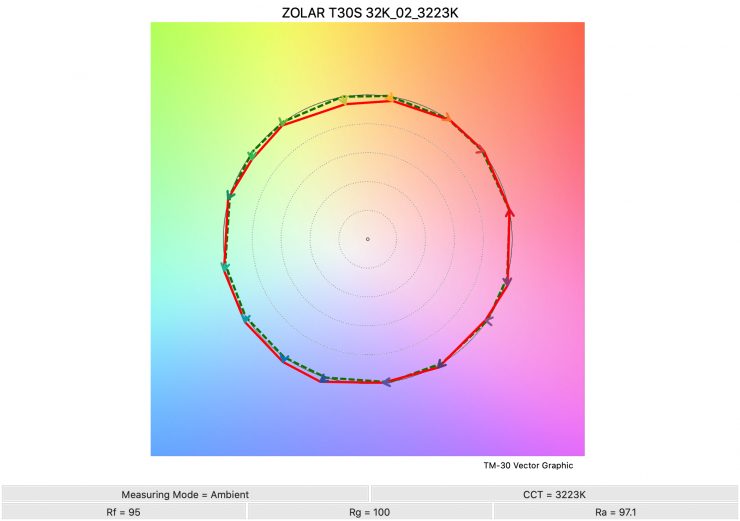
3200K 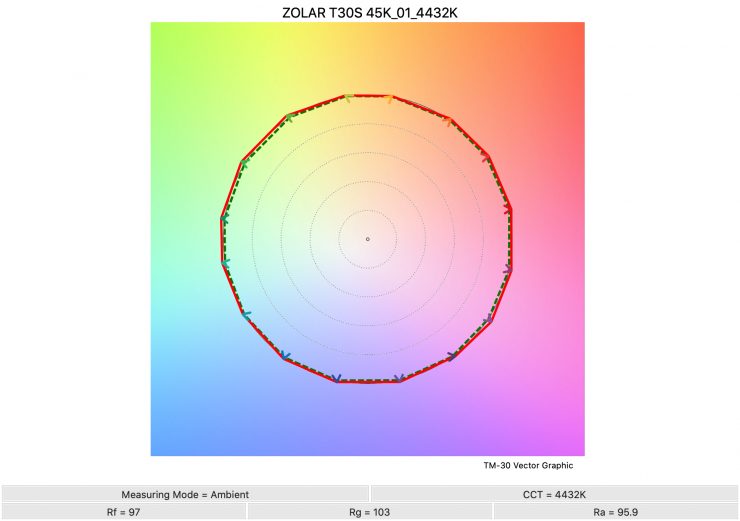
4500K 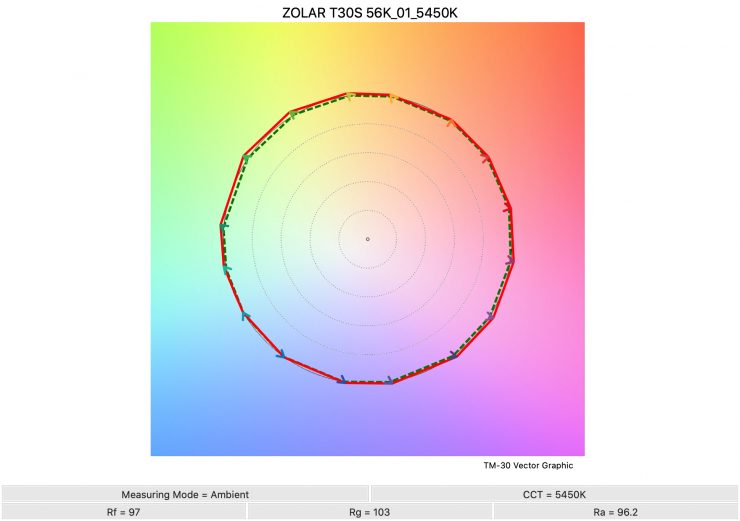
5600K
Above you can see the scores for Toliman 30C at various Kelvin color temperatures. Below I have listed the figures as well.
| Rf | Rg | |
| 3200K | 95 | 100 |
| 4500K | 97 | 103 |
| 5600K | 97 | 103 |
The TM-30 scores are all good and it shows me that the light is very consistent at replicating accurate colors with full saturation.
ZOLAR Toliman 30C
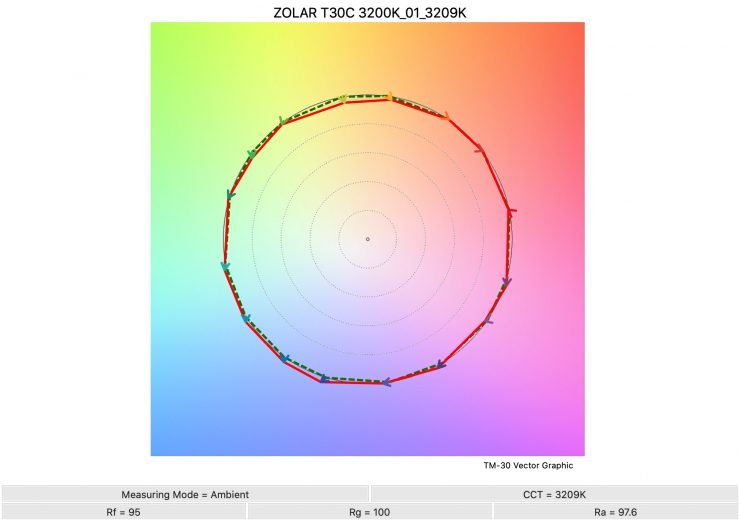
3200K 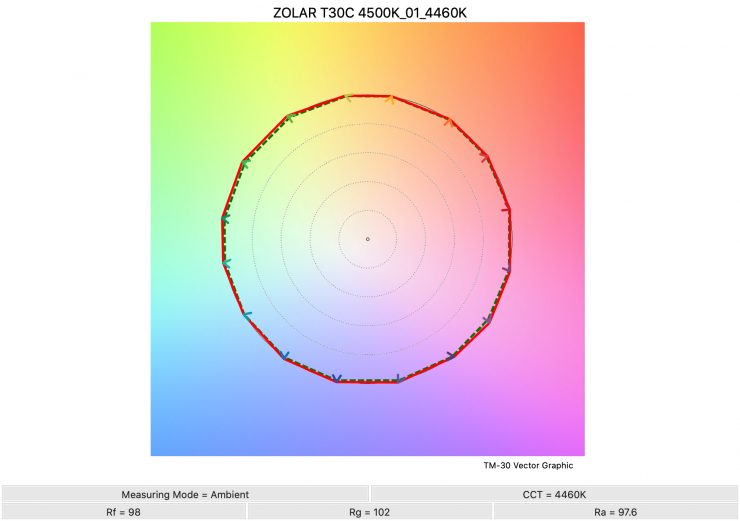
4500K 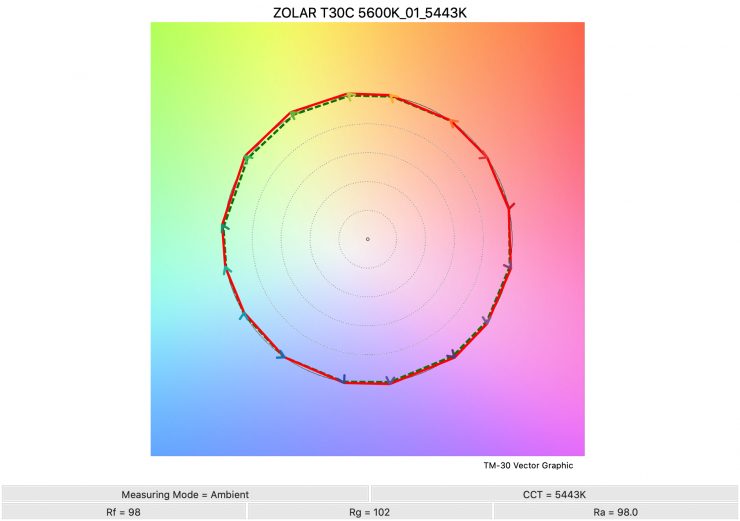
5600K
Above you can see the scores for Toliman 30C at various Kelvin color temperatures. Below I have listed the figures as well.
| Rf | Rg | |
| 3200K | 95 | 100 |
| 4500K | 98 | 102 |
| 5600K | 98 | 102 |
The TM-30 scores are all good and it shows me that the light is pretty consistent at replicating accurate colors with full saturation.
ZOLAR Vega 30C
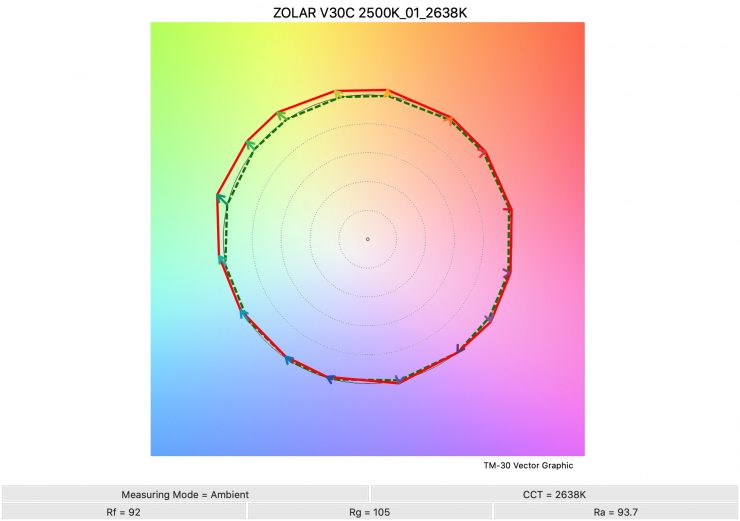
2500K 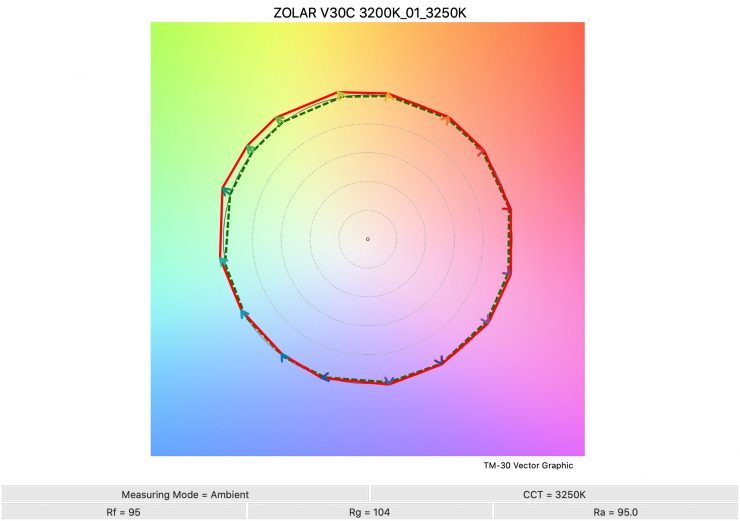
3200K 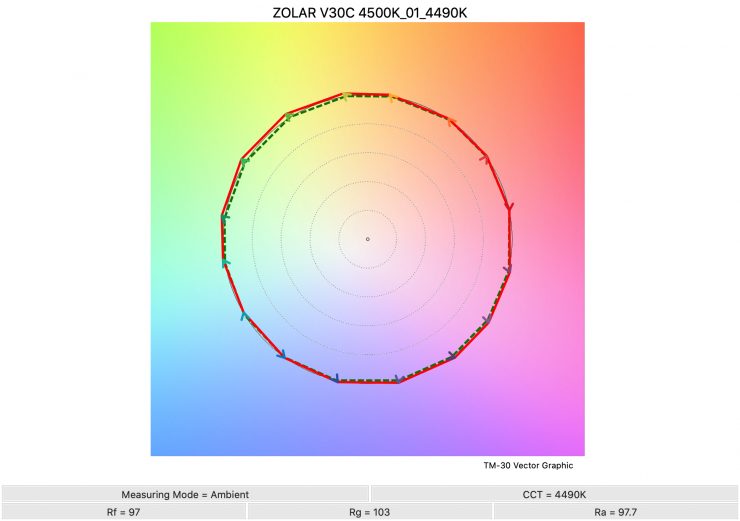
4500K 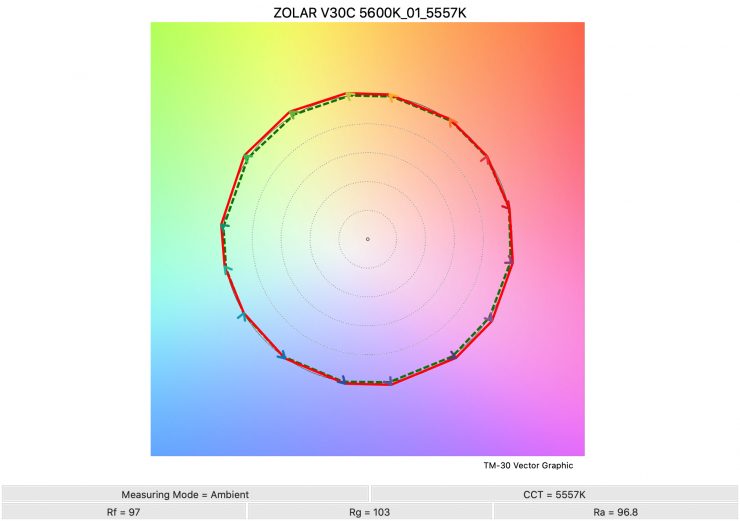
5600K 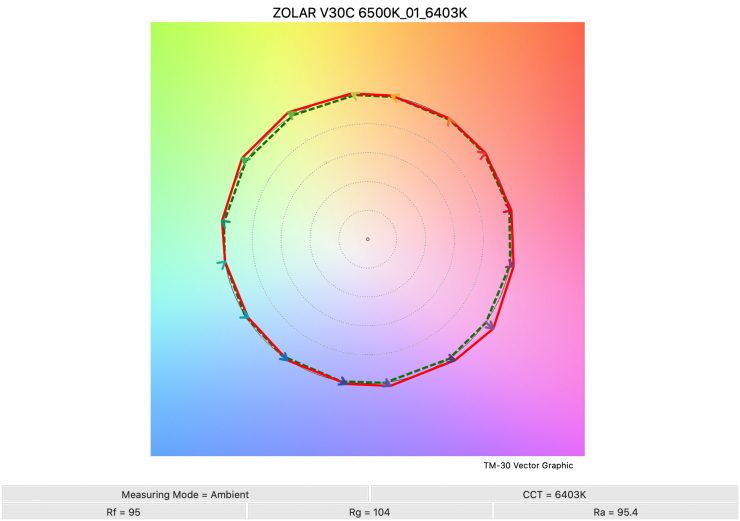
6500K 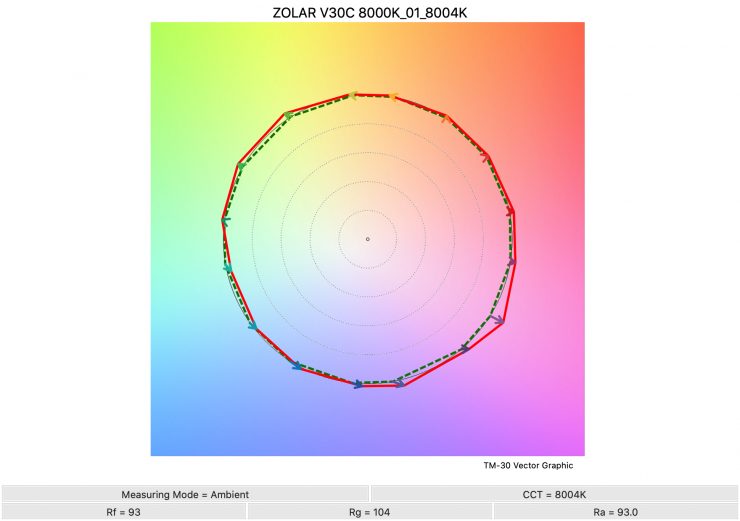
8000K 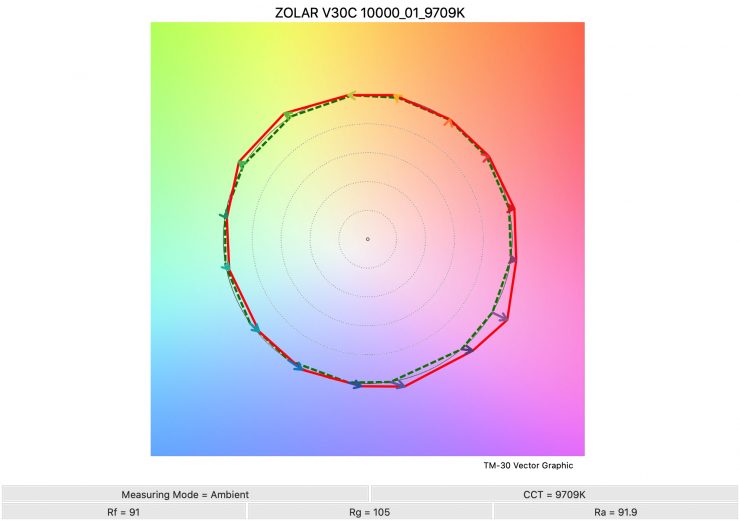
10000K
Above you can see the scores for the Vega 30C at various Kelvin color temperatures. Below I have listed the figures as well.
| Rf | Rg | |
| 2500K | 92 | 105 |
| 3200K | 95 | 104 |
| 4500K | 97 | 103 |
| 5600K | 97 | 103 |
| 6500K | 95 | 104 |
| 8000K | 93 | 104 |
| 10000K | 91 | 105 |
The TM-30 scores are all good and it shows me that the light is pretty consistent at replicating accurate colors with full saturation.

If we look at how well the Vega 30C replicates a fully saturated Red, you can see above that it is able to produce 100% saturation, with no shift in the hue.
SSI
SSI (Spectral Similarity Index) was developed by the Sci-Tech Council of the Academy. SSI gives me the ability to set any light as a standard, or use predefined standards (such as CIE D55), and then give other lights an SSI score based upon how well they will match standards such as CIE D55. This way I can measure spectral response and compare it directly against an ideal light source. This is actually a much better test than recording CRI scores.
First, let’s look at 3200K.
3200K
ZOLAR Toliman 30C 3200K
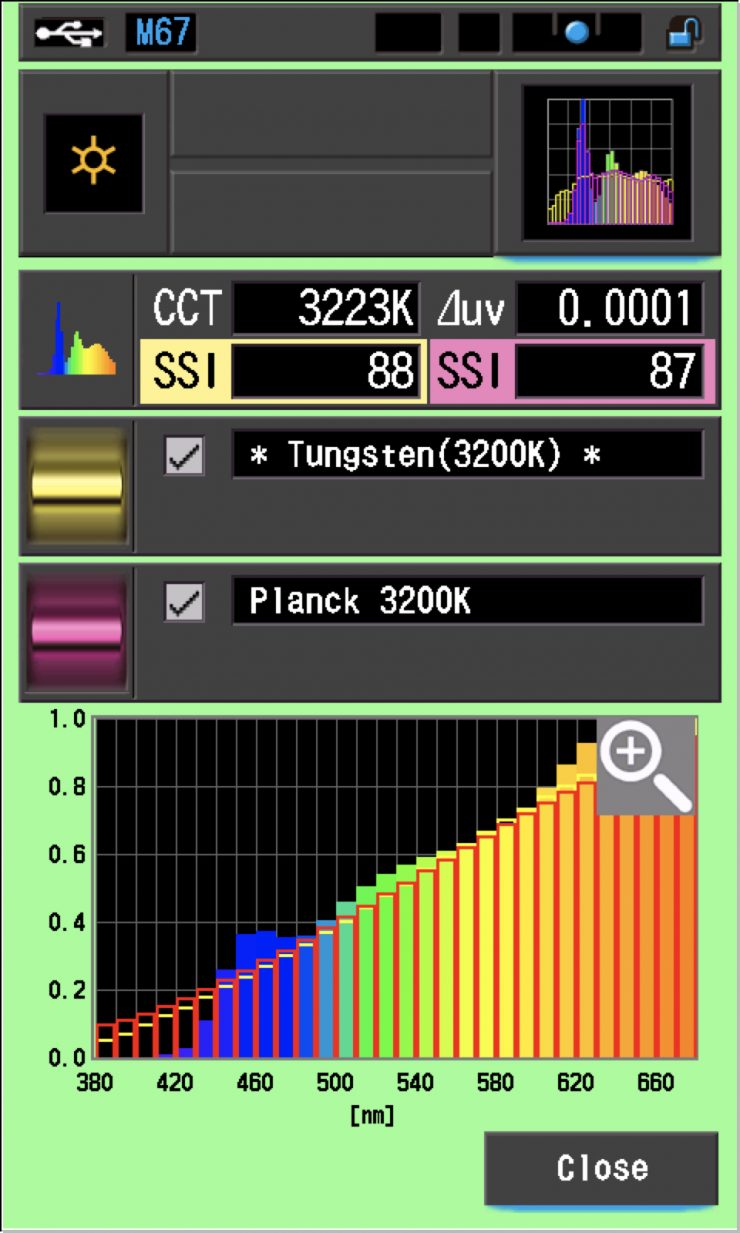
In the above graph, the red bars indicate a perfect Planck 3200K source. The gold bars indicate a perfect 3200K Tungsten source. This lets us compare how close to a perfect 3200K lighting source the Toliman 30S is. Any SSI score in the low ’80s is very good for a 3200K LED light, however, the Toliman 30C was in the high 80s’ which was outstanding. As you can see, LED lights have a hard time replicating colors below about 450nm.
ZOLAR Toliman 30C 3200K
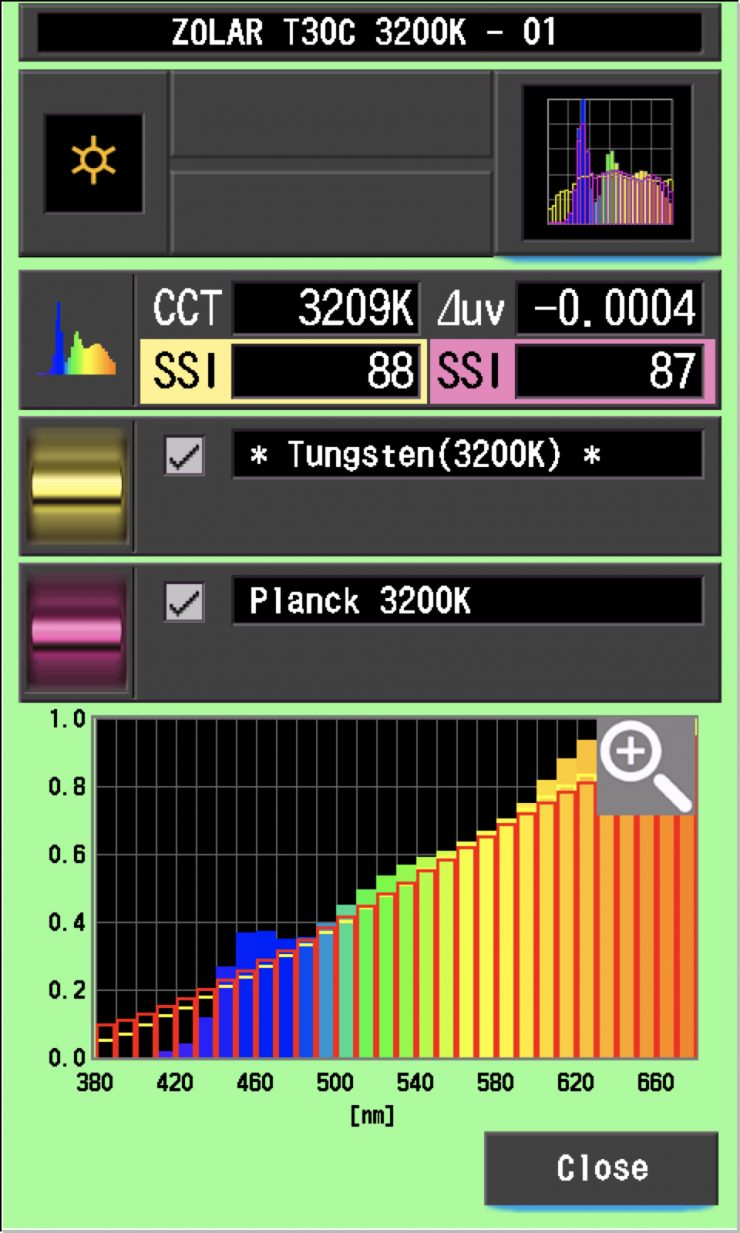
In this graph, the red bars indicate a perfect Planck 3200K source. The gold bars indicate a perfect 3200K Tungsten source. This lets us compare how close to a perfect 3200K lighting source the Toliman 30C is. Any SSI score in the low ’80s is very good for a 3200K LED light, however, the Toliman 30C was in the high 80s’ which was outstanding. As you can see, LED lights have a hard time replicating colors below about 450nm.
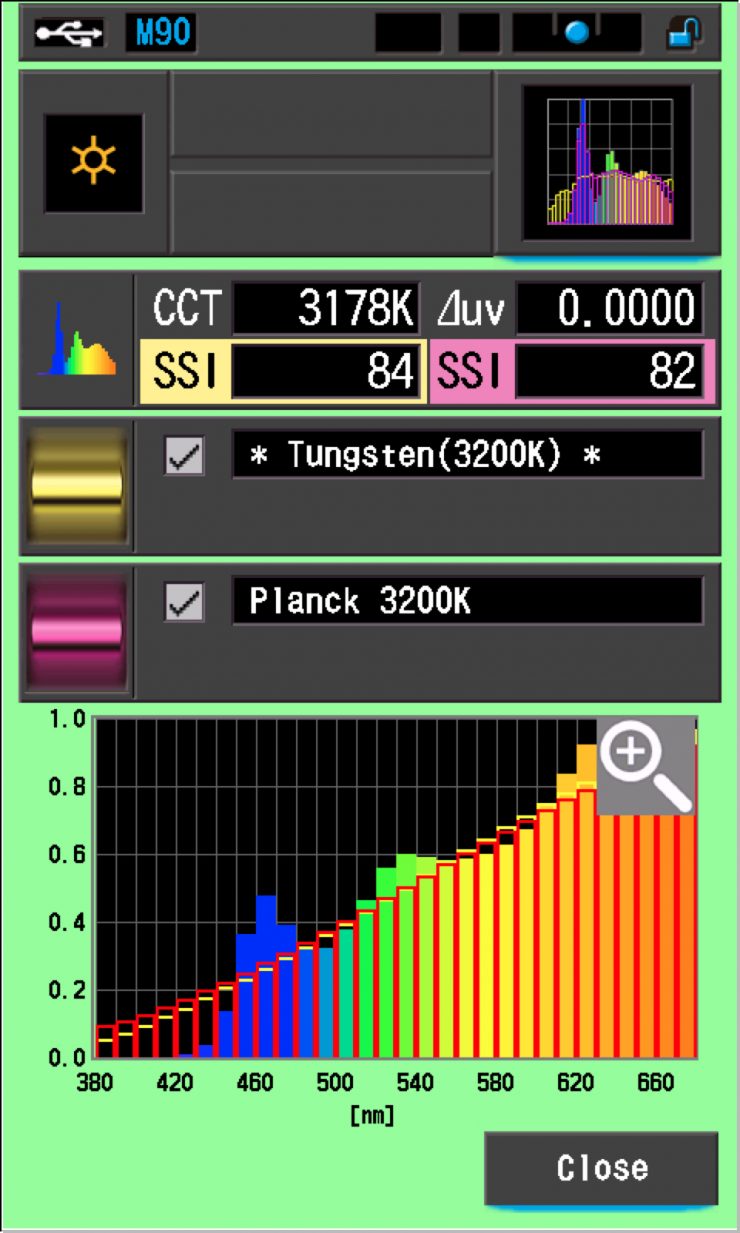
As a reference, above you can see the same result for the Rotolight Titan X1.
ZOLAR Vega 30C 3200K
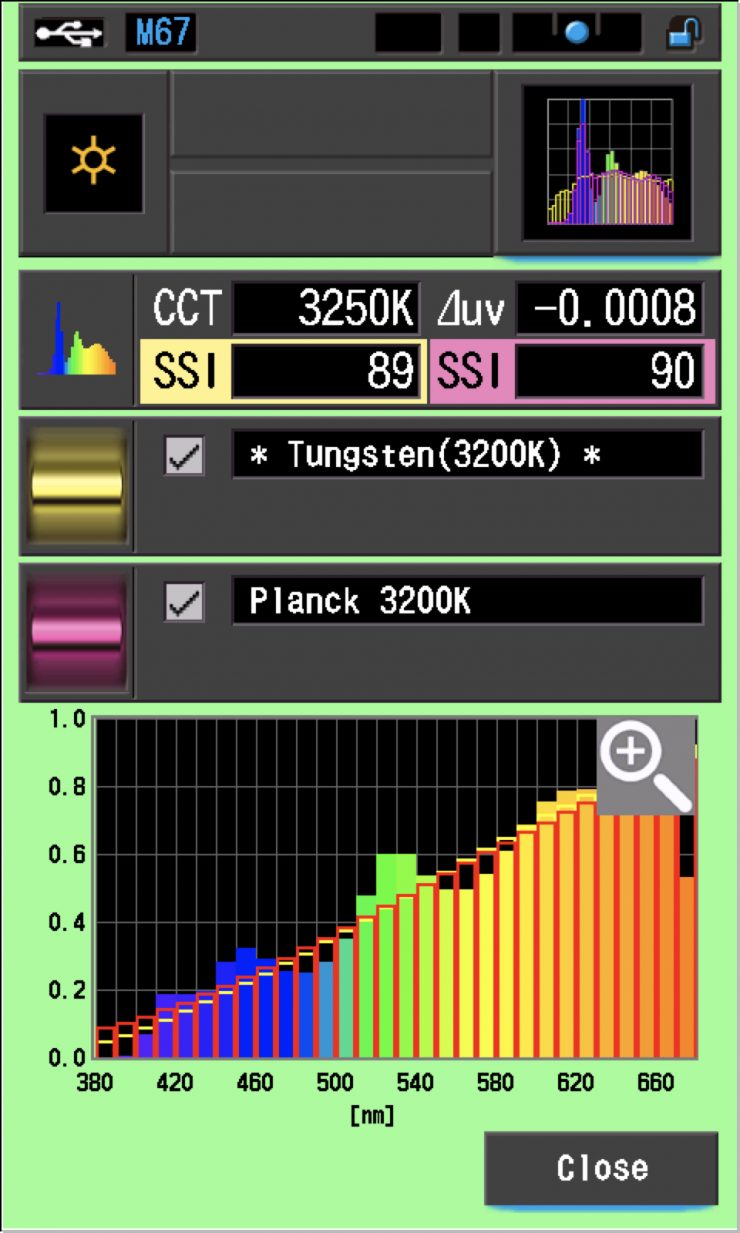
In this graph, the red bars indicate a perfect Planck 3200K source. The gold bars indicate a perfect 3200K Tungsten source. This lets us compare how close to a perfect 3200K lighting source the Vega 30C is. Any SSI score in the low ’80s is very good for a 3200K LED light, however, the Vega 30C scores were 89 and 90 respectively. These are the best SSI scores I have seen for any LED light when used at 3200K.
5600K
ZOLAR Toliman 30S 5600K
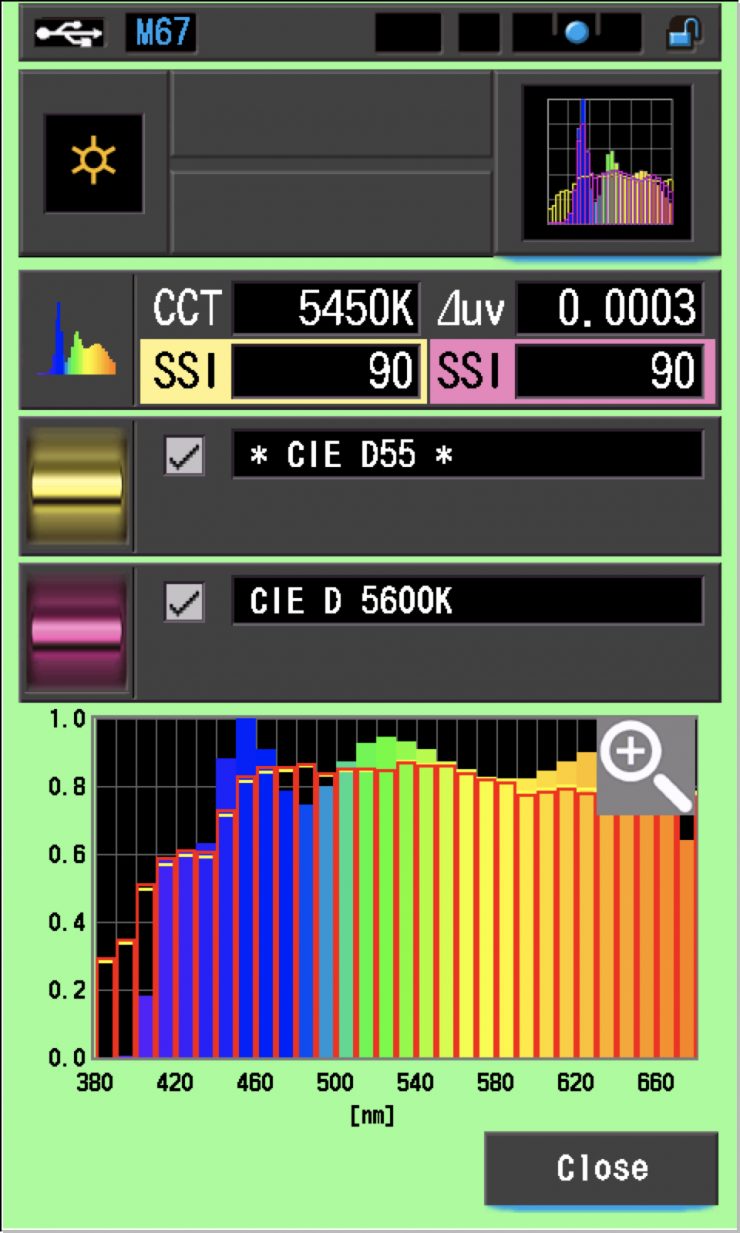
In the graph above the gold bars indicate a perfect CIE D55 source. The red bars indicate a perfect CIE D 5600K source. This lets us compare how close to a perfect 5600K lighting source the Toliman 30S is. A score in the low 70’s is typical for a 5600K LED source. A score of 90 is ridiculously good and the best I have seen from any light.
ZOLAR Toliman 30C 5600K
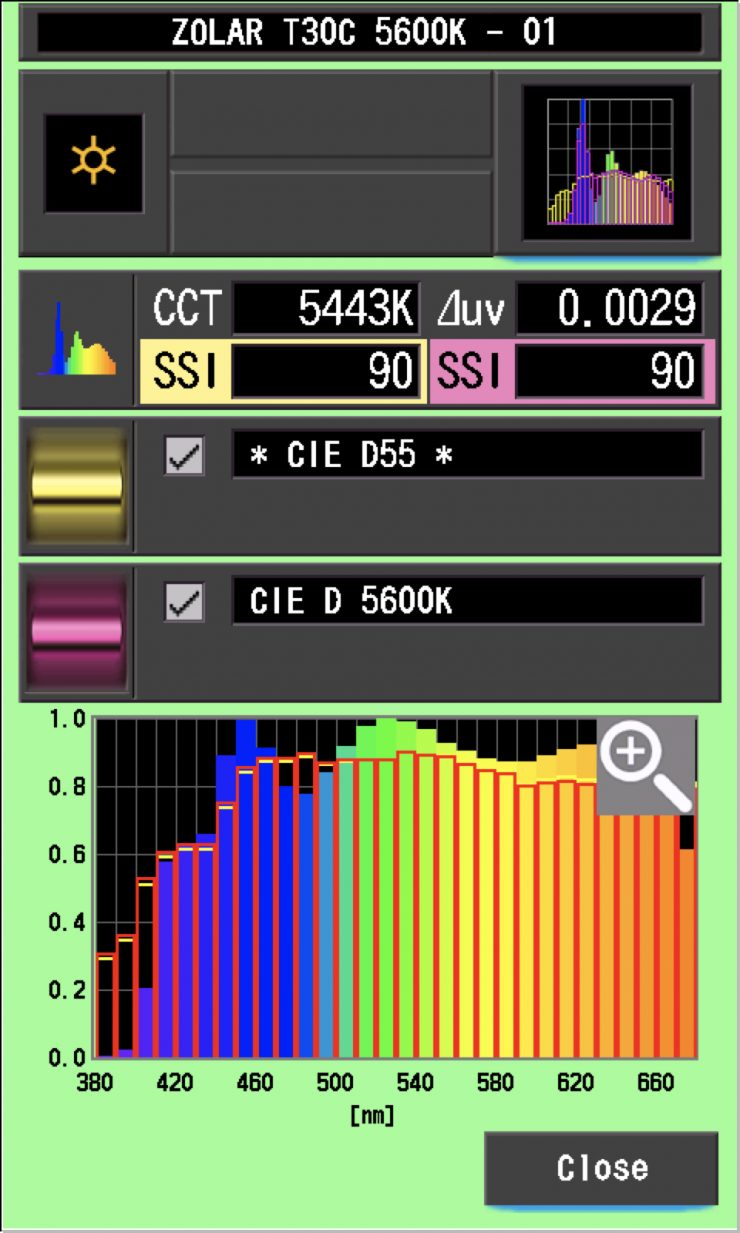
In the graph above the gold bars indicate a perfect CIE D55 source. The red bars indicate a perfect CIE D 5600K source. This lets us compare how close to a perfect 5600K lighting source the Toliman 30C is. A score in the low 70’s is typical for a 5600K LED source. A score of 90 is ridiculously good.
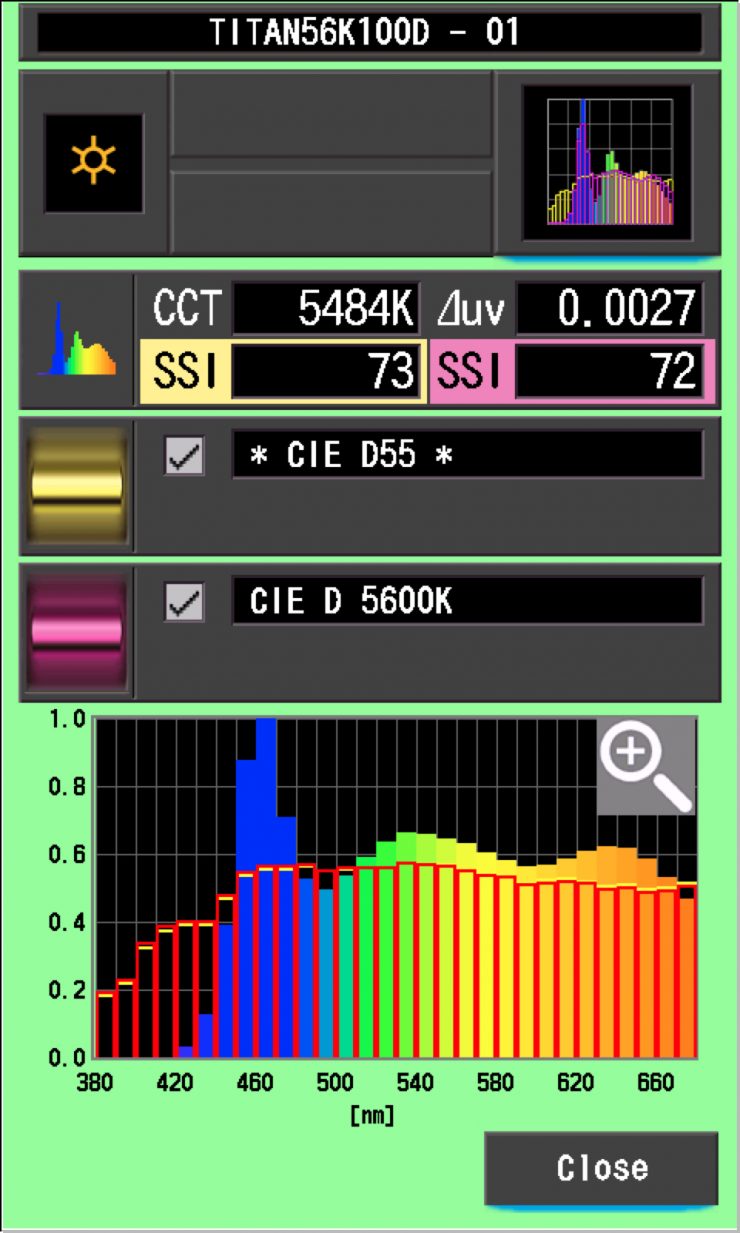
As a reference, above you can see the same result for the Rotolight Titan X1.
ZOLAR Toliman 30C 5600K
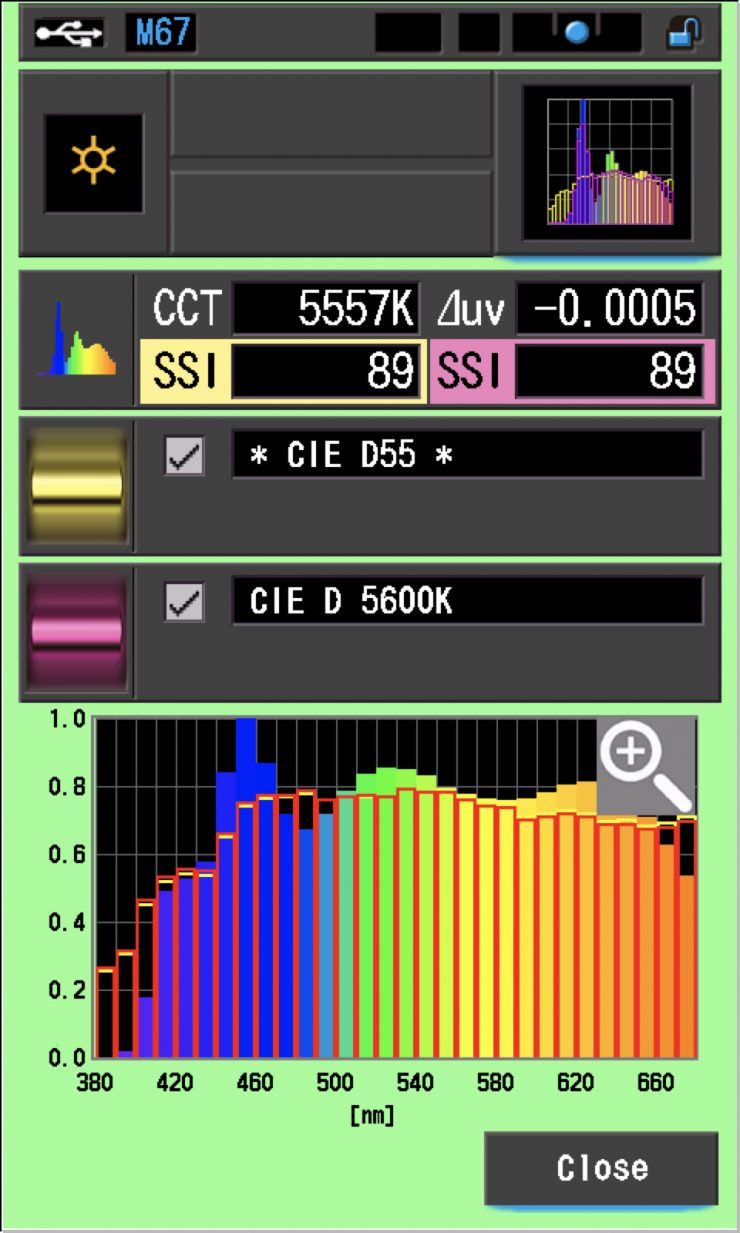
In the graph above the gold bars indicate a perfect CIE D55 source. The red bars indicate a perfect CIE D 5600K source. This lets us compare how close to a perfect 5600K lighting source the Vega 30C is. A score in the low 70’s is typical for a 5600K LED source. A score of 89 is ridiculously good.
SSI Comparisons
The main reason we want to record SSI scores is so we can see how well they match with other lights. Now here is where things become difficult. Because the ZOLAR lights have such high SSI scores they are not going to match other lights nearly as well, particularly at 5600K. As an example, I will show you how well the Vega 30C matched an ARRI Orbiter and Luxli’s Timpani 2. Below you can see the results when the lights are set at both 5600K and 3200K.
3200K
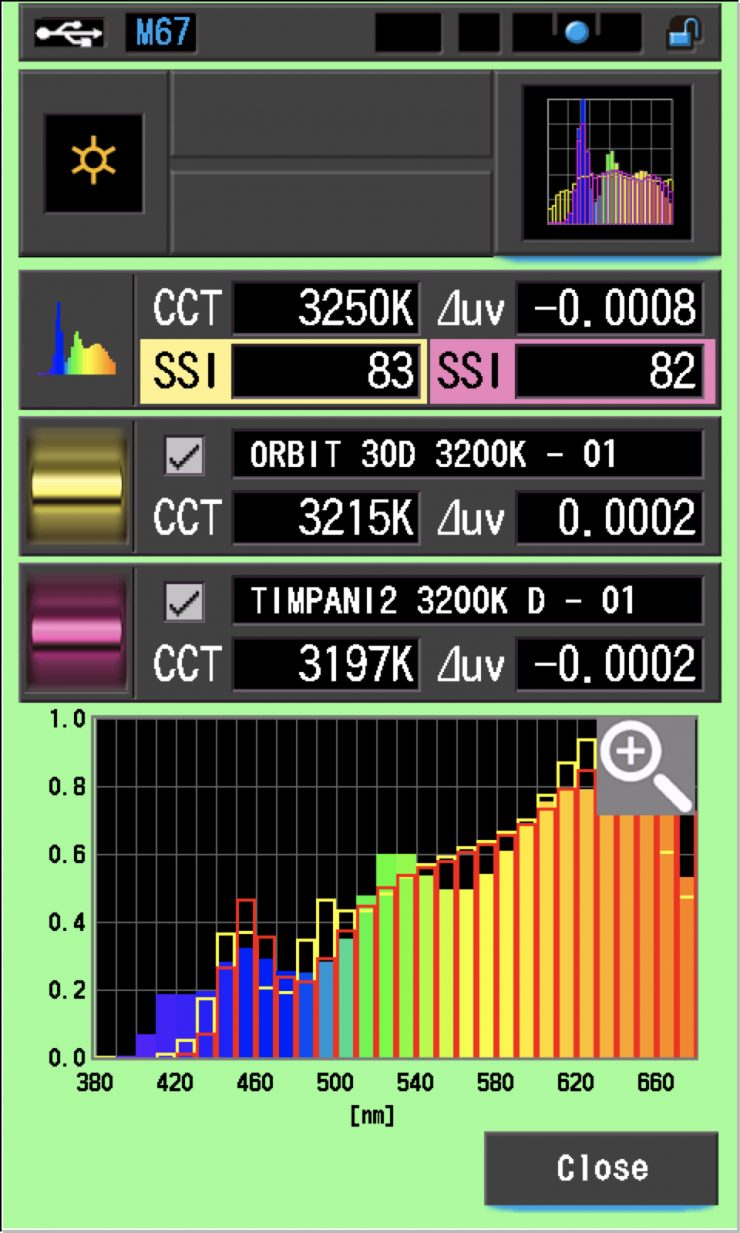
As you can see the ARRI and the Luxli are not that close to being a perfect match to the Vega 30C at 3200K, although with a bit of fine-tuning you could probably get them to work together without any big issues. A score of 80 is still pretty reasonable.
5600K
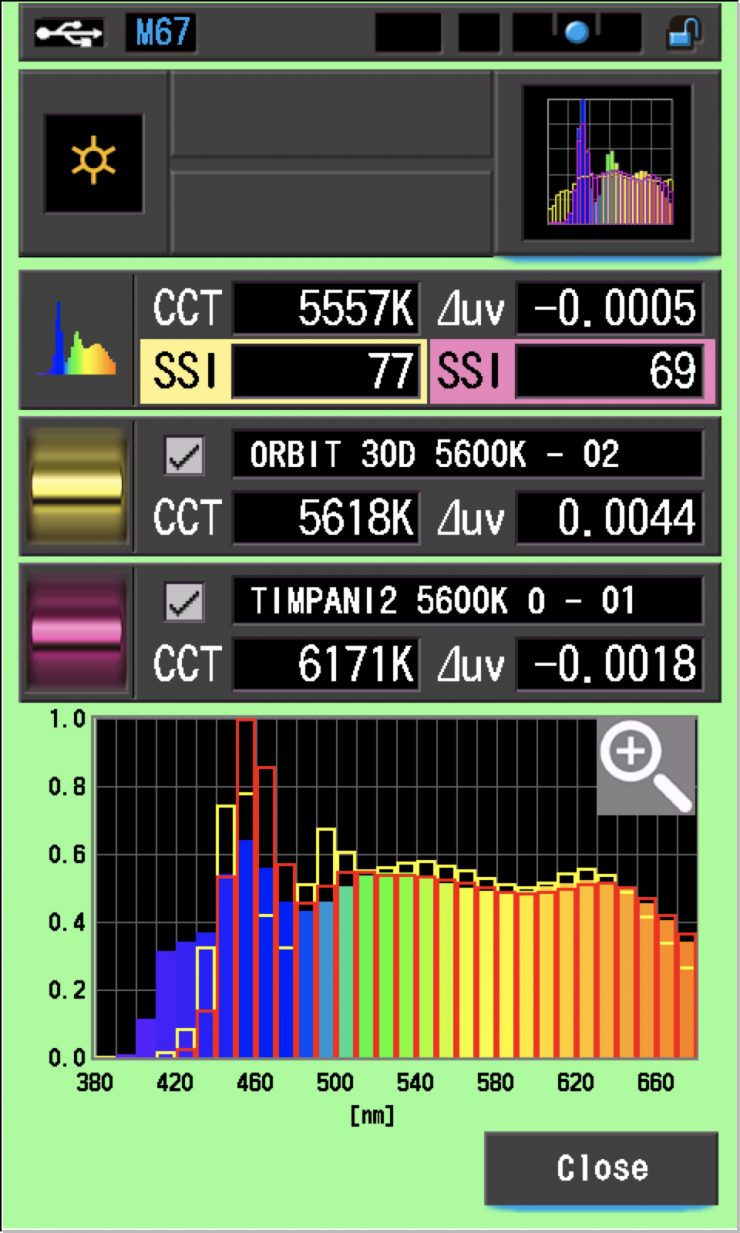
Here is where things get interesting. At 5600K both the ARRI and the Luxli are way off being anywhere near a perfect match to the Vega 30C.
Because the SSI scores at 5600K are so much different from other lights, let’s see how well the Vega 30C matches the Toliman 30C and Toliman 30S. What is interesting is that the Vega 30C has a Toliman matching mode setting in its menu and you can select this if you want to use the Vega with those other lights to get them to more closely match. So let’s see if that actually works or is it a gimmick? (Color matching mode will be added to other ZOLAR series via a firmware update).
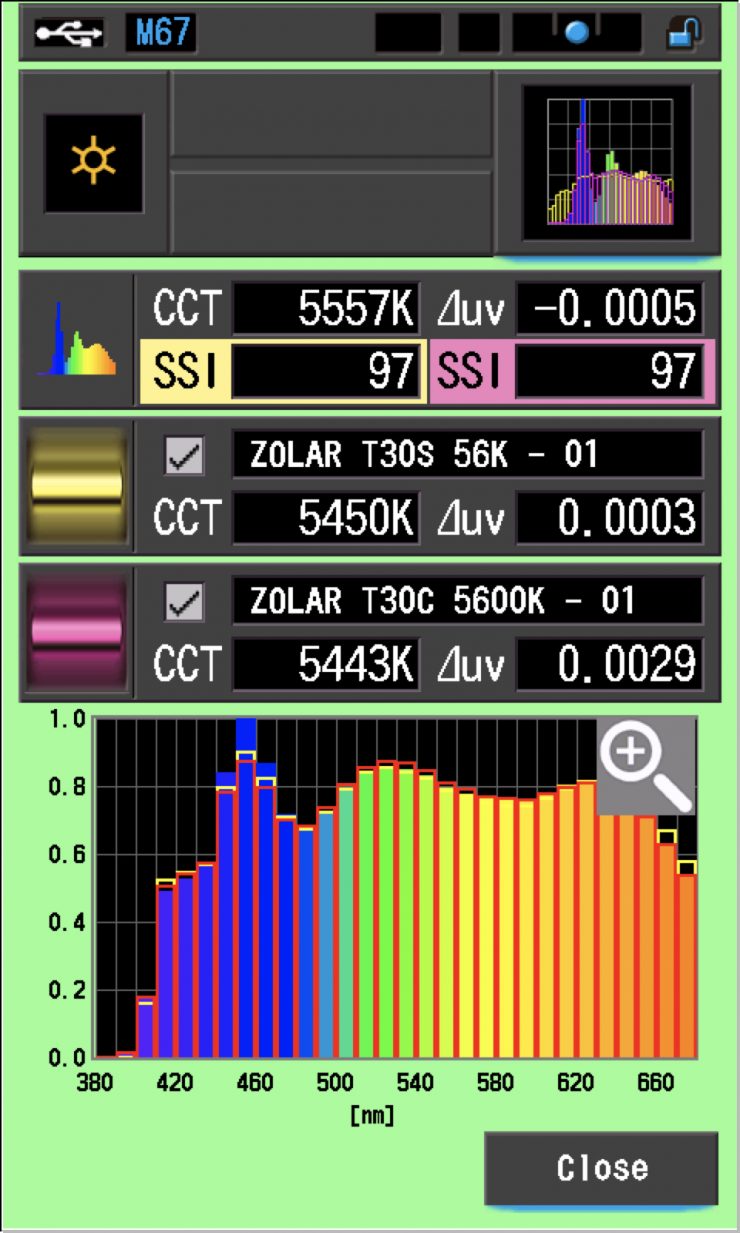
Above you can see how well the Vega 30C matches the Toliman 30C and Toliman 30S when it is used in its default configuration at 5600K. As you can see these lights are almost a perfect match when used at 5600K.
Ok, so let’s see if setting the Vega 30C to its Toliman match setting makes any difference.
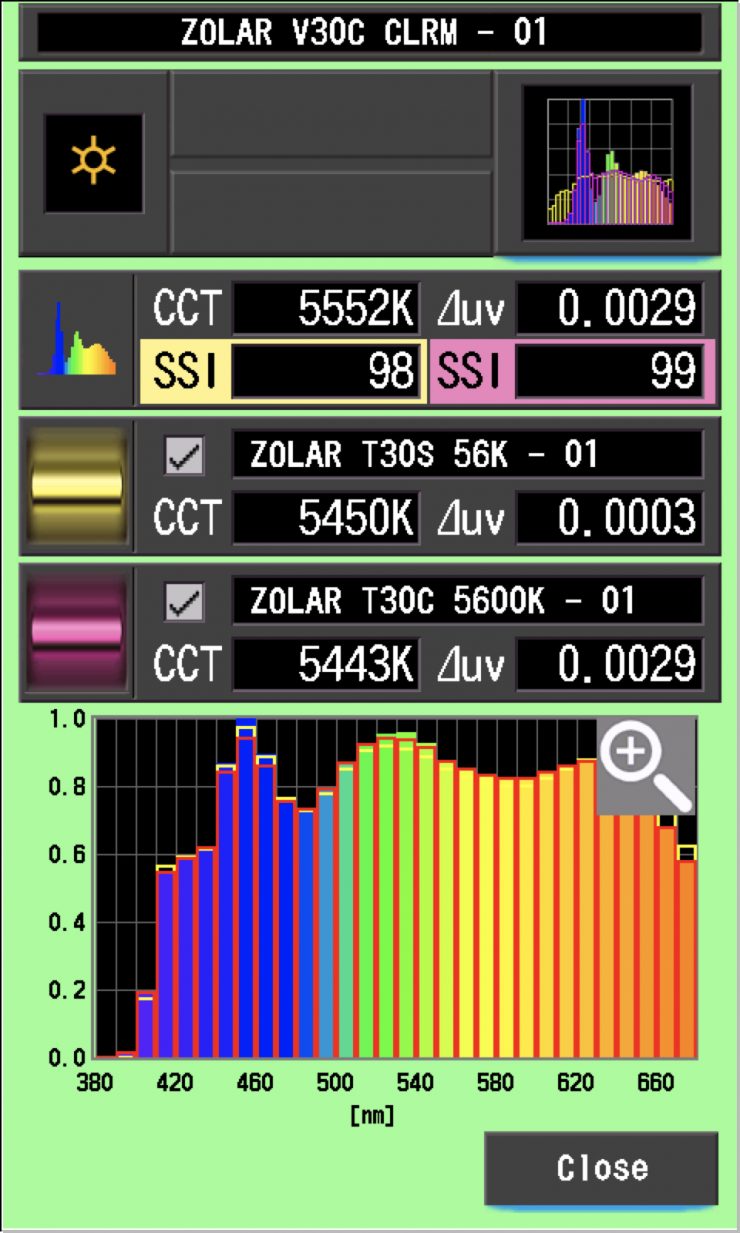
Above you can see how well the Vega 30C matches the Toliman 30C and Toliman 30S when it is used in its Toliman match configuration at 5600K. As you can see the scores did improve. In particular, the Toliman 30C is almost an identical match to the Vega 30C with a score of 99.
I am really impressed with what ZOLAR has done here. Putting a feature inside one of your lights to help it more closely match other fixtures in your range is a smart move.
SSI tests are a great way of telling you what lights you own or use will work well together.
Spectral Distribution
ZOLAR Toliman 30S 5600K
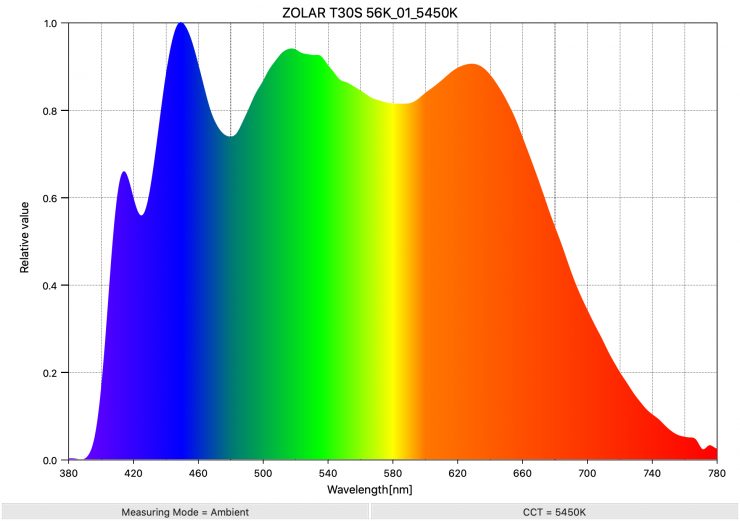
Above you can see the spectral distribution of the Toliman 30S when set at 5600K. The spectral distribution is exceptionally good at 5600K. This spectral distribution is far better than any LED light I have ever tested at 5600K.
ZOLAR Toliman 30C 5600K
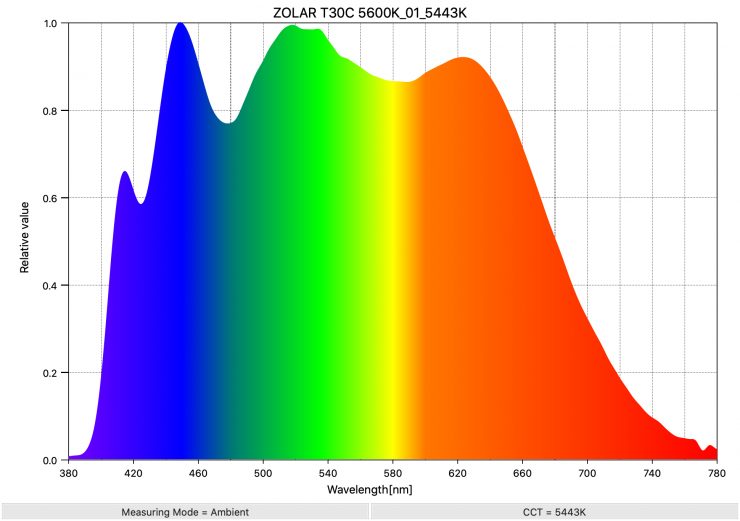
Above you can see the spectral distribution of the Toliman 30C when set at 5600K. The spectral distribution is exceptionally good at 5600K. Just like with the Toliman 30S, this spectral distribution is far better than any LED light I have ever tested at 5600K by a huge margain.
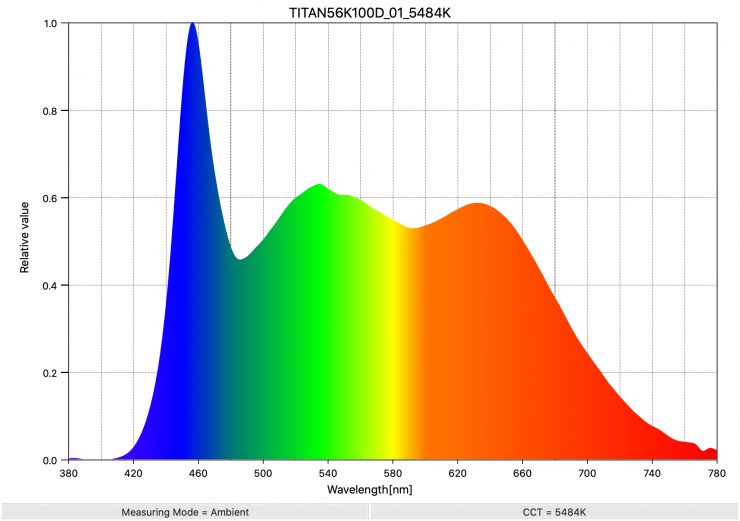
As a reference, above you can see the spectral distribution for the Rotolight Titan X1.
ZOLAR Vega 30C 5600K
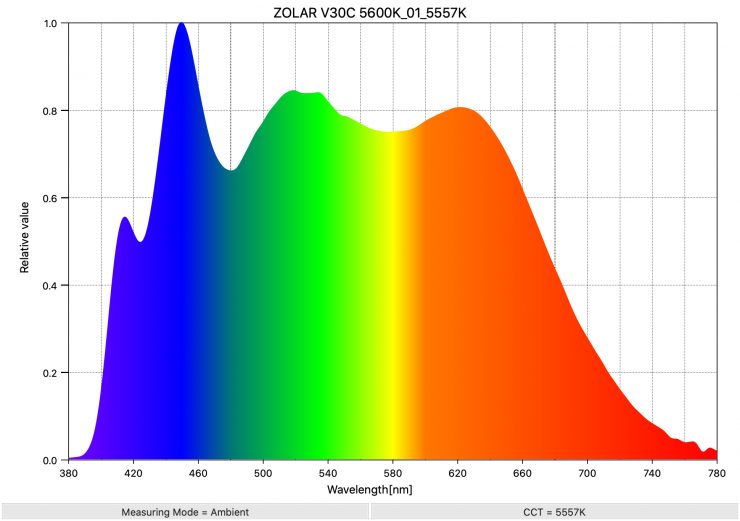
Above you can see the spectral distribution of the Vega 30C when set at 5600K. The spectral distribution is exceptionally good at 5600K. This spectral distribution is far better than any LED light I have ever tested at 5600K, except for the Toliman 30C.
ZOLAR Toliman 30S 3200K
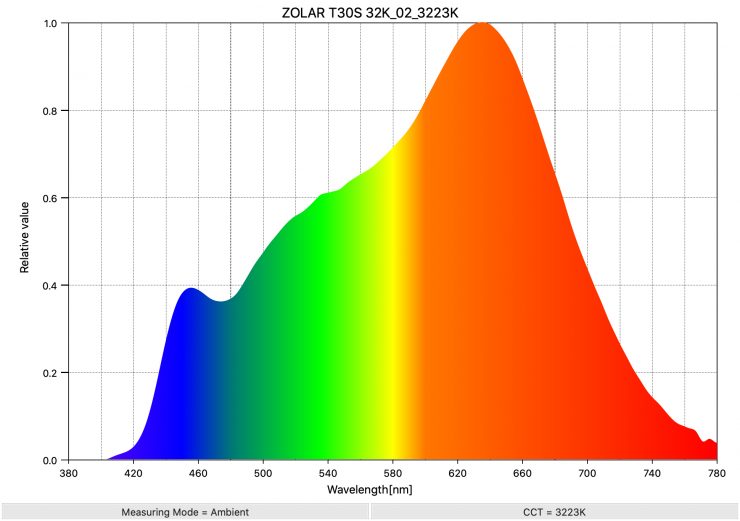
Above you can see the spectral distribution of the Toliman 30S when set at 3200K. The spectral distribution is very good at 3200K and the light doesn’t have any spikes where you wouldn’t expect to see any.
ZOLAR Toliman 30C 3200K
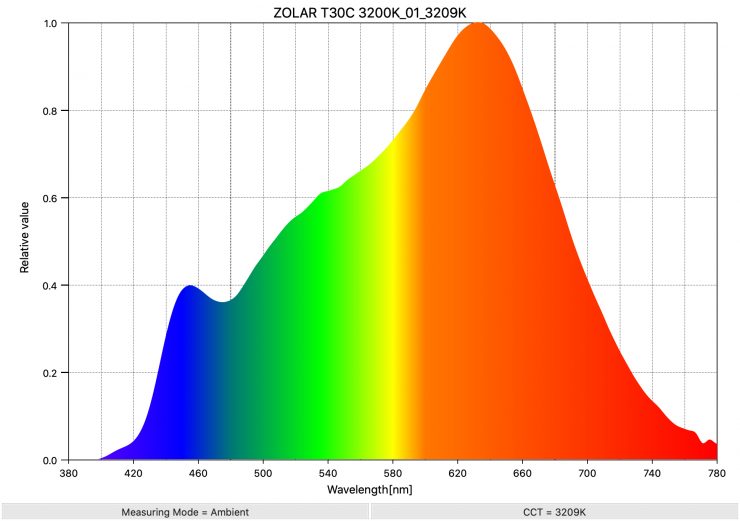
Above you can see the spectral distribution of the Toliman 30C when set at 3200K. The spectral distribution is very good at 3200K and the light doesn’t have any spikes where you wouldn’t expect to see any. It is almost identical to the spectral distribution of the Toliman 30S.
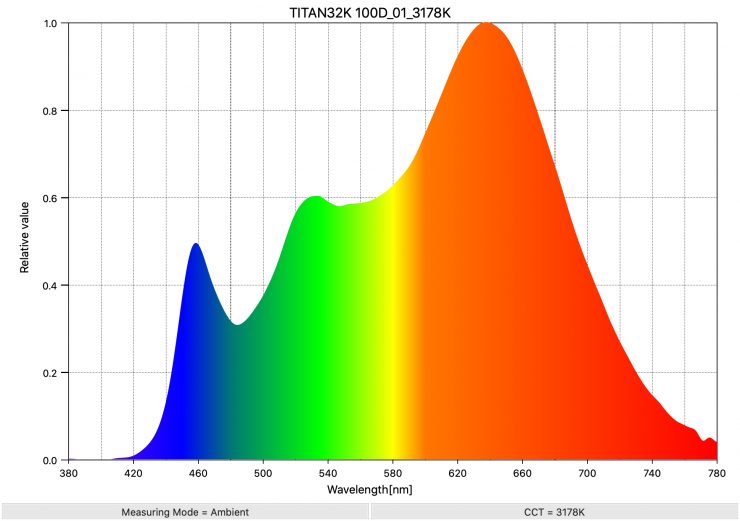
As a reference, above you can see the spectral distribution for the Rotolight Titan X1.
ZOLAR Toliman 30C 3200K
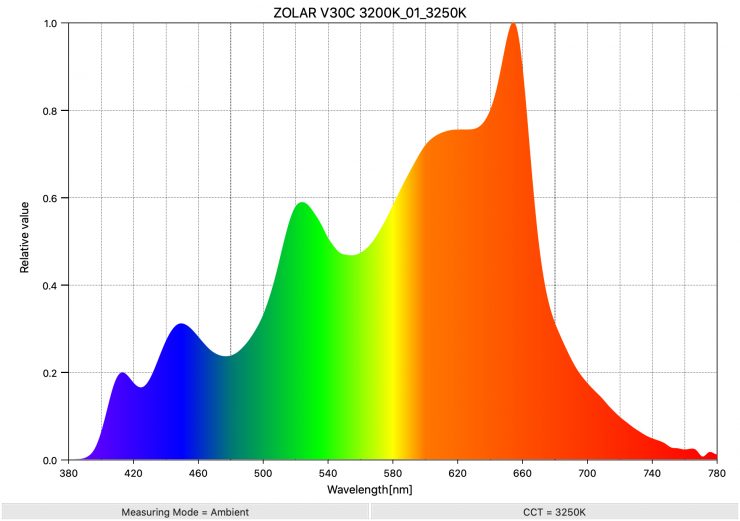
Strangely the spectral distribution for the Vega 30C, when used at 3200K, was a bit all over the place. There was quite a pronounced green spike in the spectrum as well as a lot of missing information.
Real-World Performance
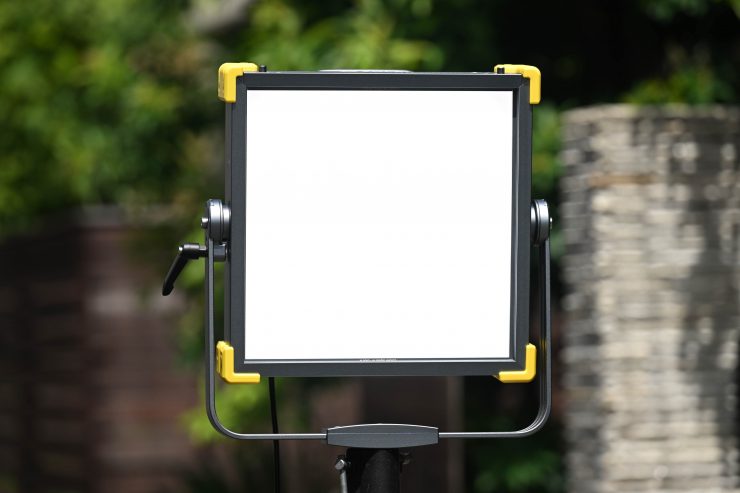
As I always say, photometric scores only tell you part of the story. Lots of LED lights score well these days in technical tests, but a good light should be easy to use, versatile, and provide good real-world results.
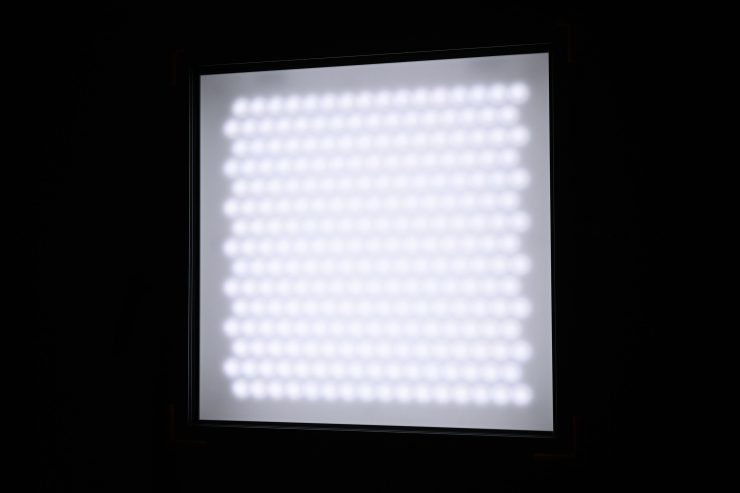
Now, let’s first have a look at the ZOLAR Stylist W diffusion panels. If you use them with the A side facing outwards, even at 100 output you can still see the individual LED clusters.
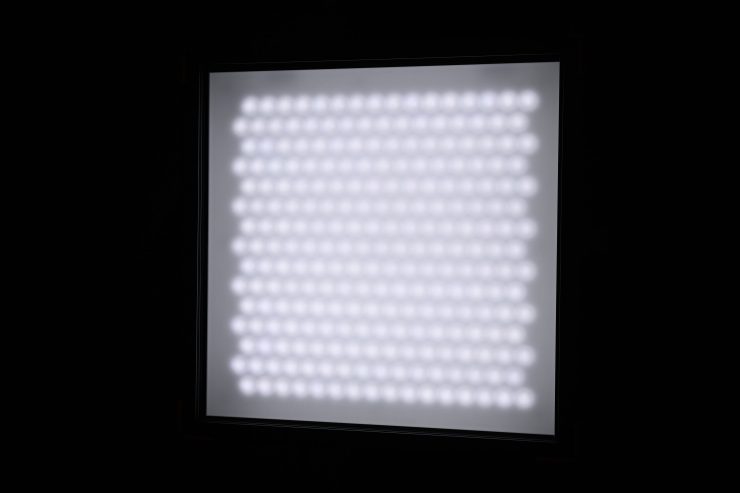
If you dim the light down then the effect is even more pronounced.
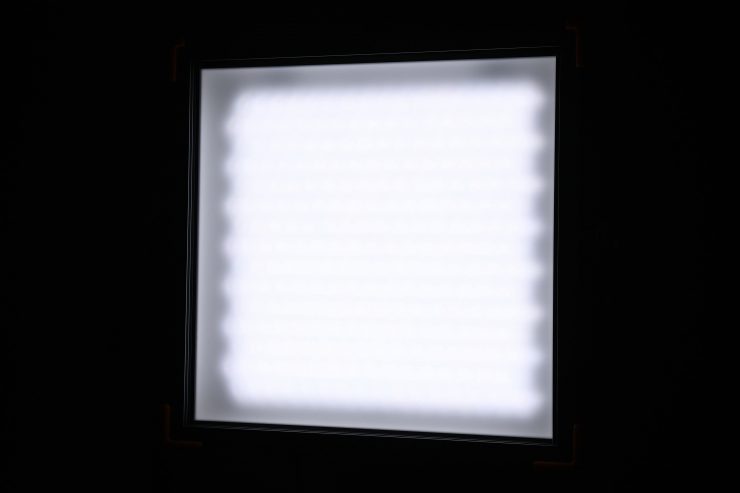
If you have the B side facing outwards, then this is somewhat reduced because the beam angle of the light is being increased.
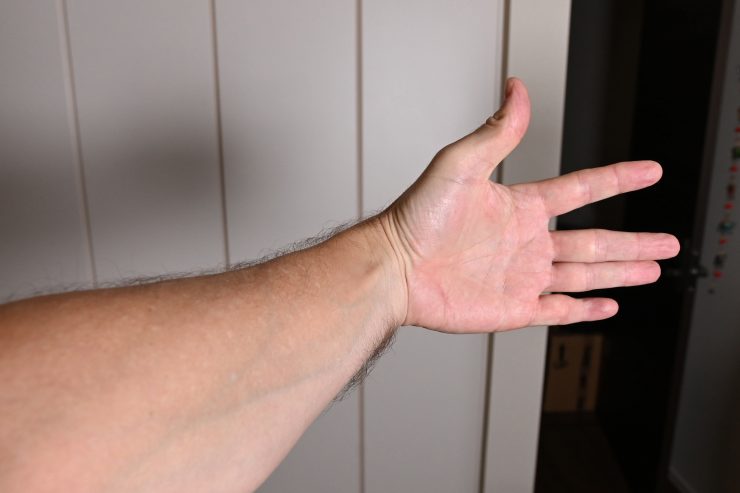
B side facing out 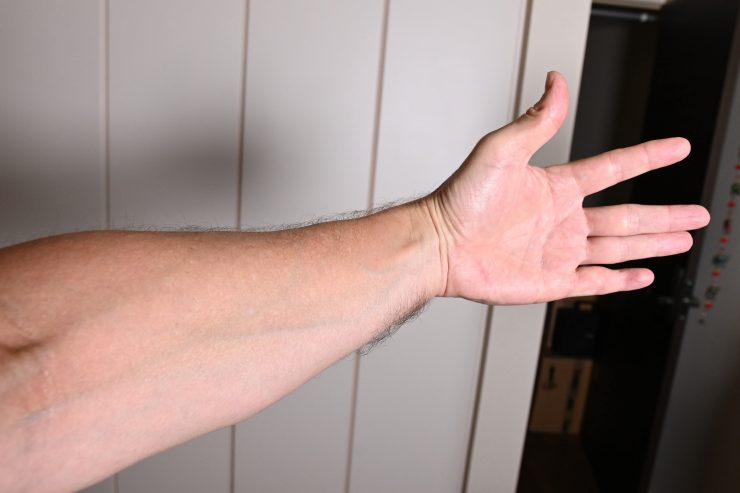
A side facing out
As far as shadows are concerned, you don’t get any cross-hatching when using the Stylist W diffusion panels regardless of whether the A side or B side is facing outwards. Both images above were captured with the same exposure settings when the light set at 100% output.
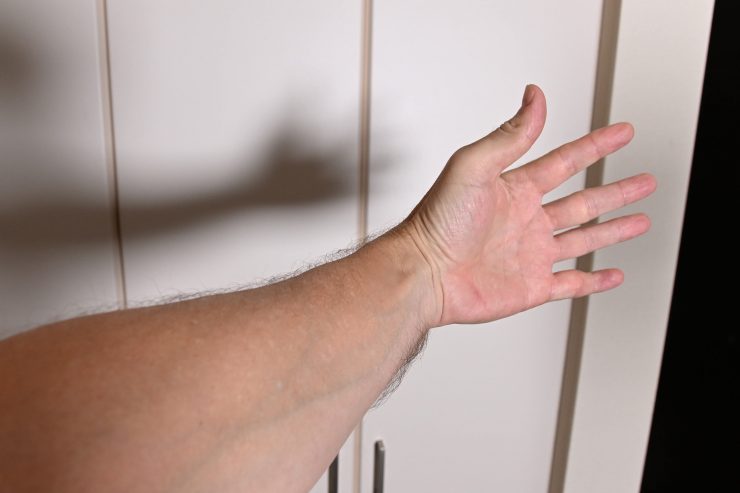
If you remove the ZOLAR Stylist W diffusion panel and use the light without any diffusion, you will get cross-hatched shadows.
The Vega 30C and Toliman 30C do have a fair amount of spill because of their reasonably wide beam angles. This is something you need to take into account when using them.
The Toliman 30S has a lot narrower beam angle, so there isn’t nearly as much spill.
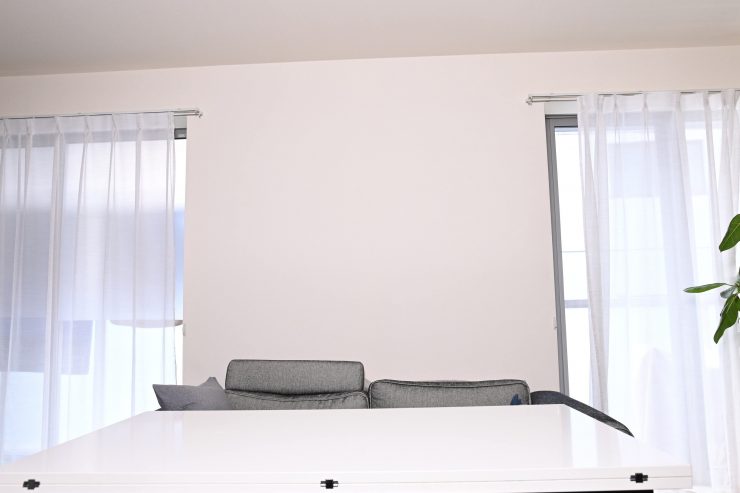
ZOLAR Vega 30C (Stylist W Side A out) 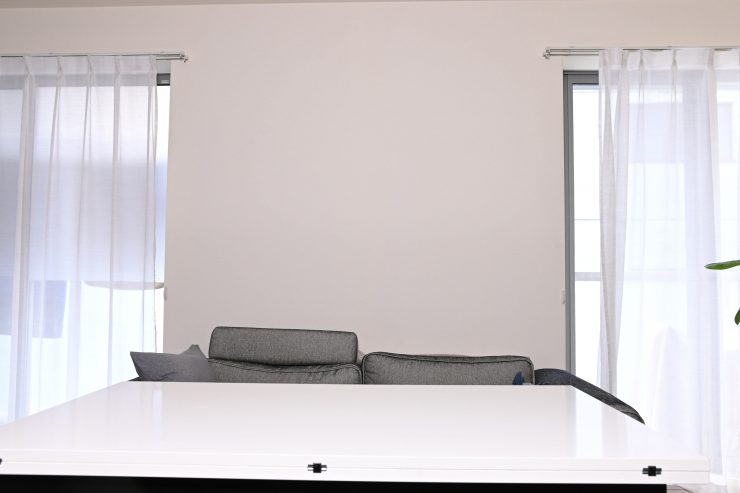
ZOLAR Vega 30C (Stylist W Side B out) 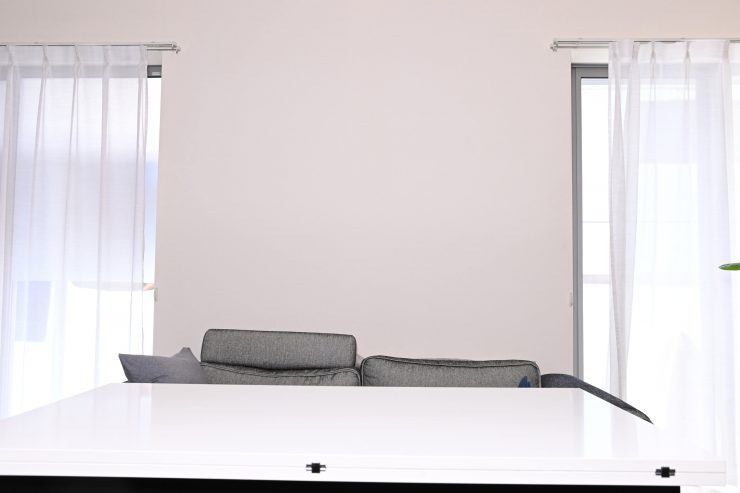
ZOLAR Vega 30C (no diffusion panel) 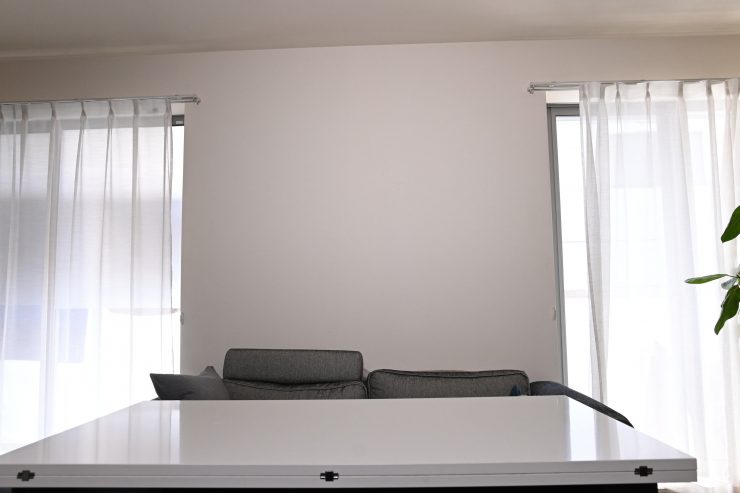
ZOLAR Toliman 30S (Stylist W Side A out) 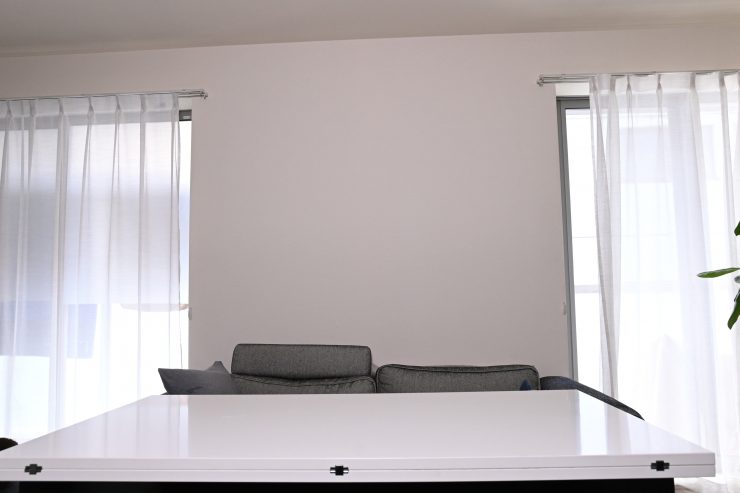
Luxli Timpani² 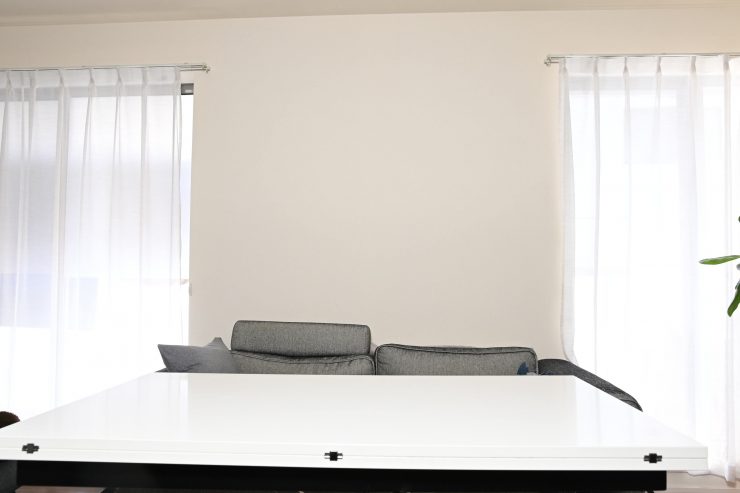
Litepanels Gemini 1×1 Soft 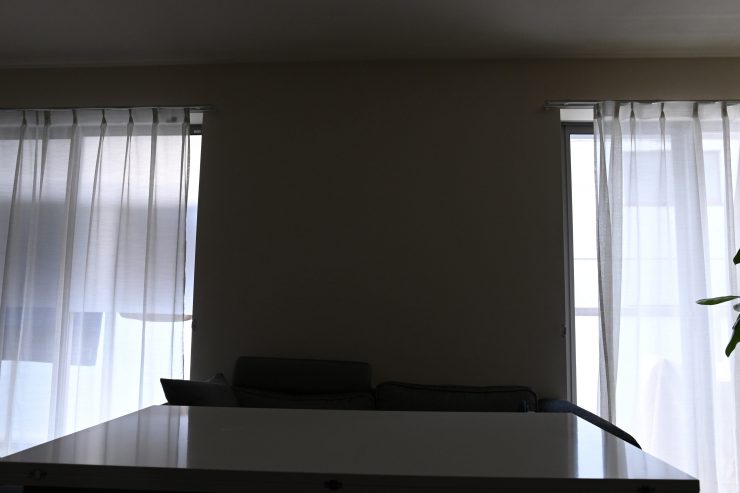
No light
So how bright are they in the real world? Well, above you can see some example images where I have kept the exposure and WB exactly the same for all of the images. I have also included the Luxli Timpani² 1×1 RGBAW LED Light and the Litepanels Gemini Soft as a reference. The ZOLAR Toliman 30C has a very similar output to the Vega 30C and that is why I haven’t included it.
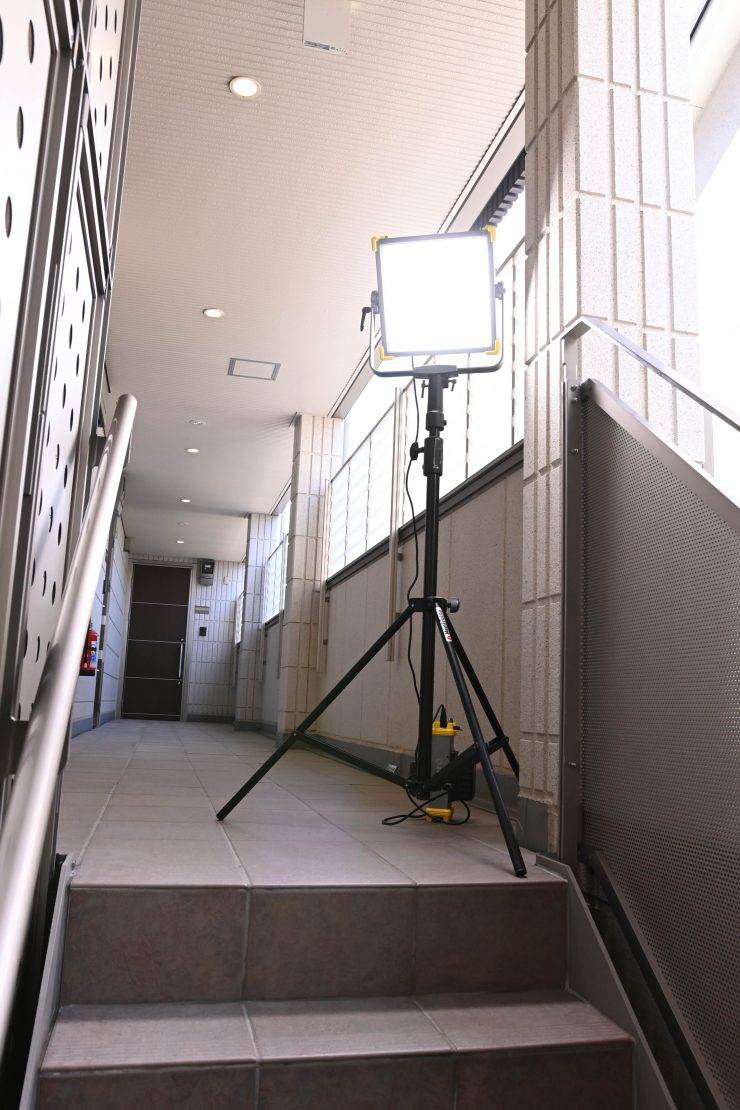
Position of light 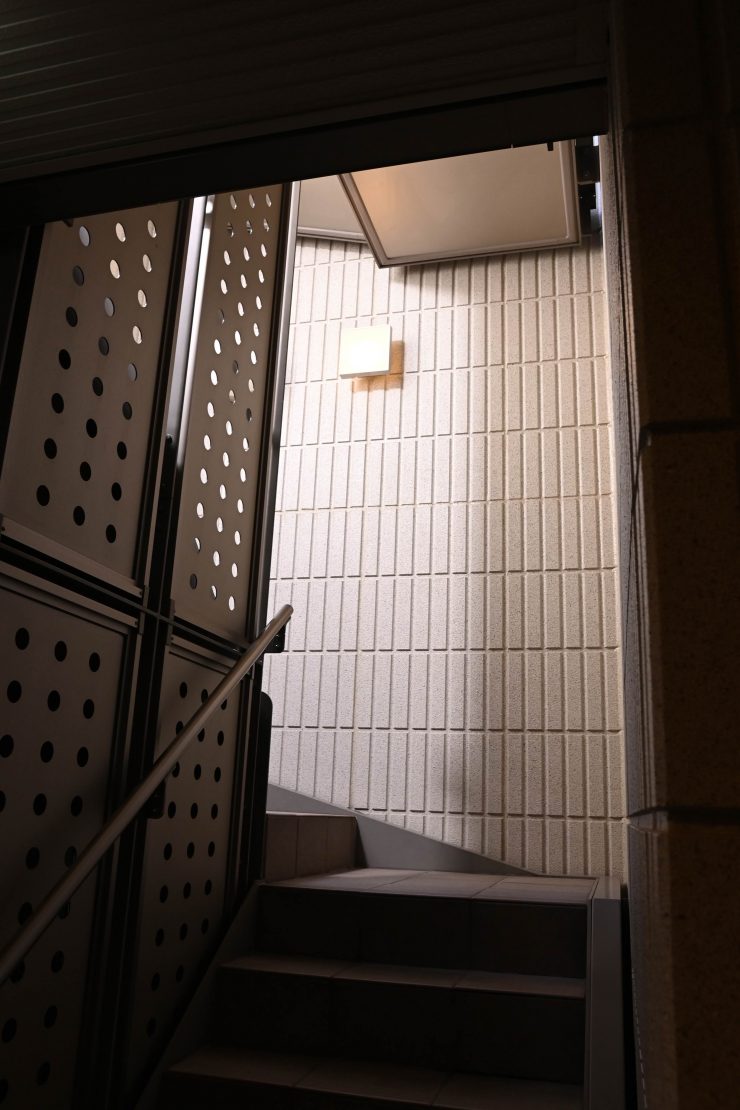
Light On 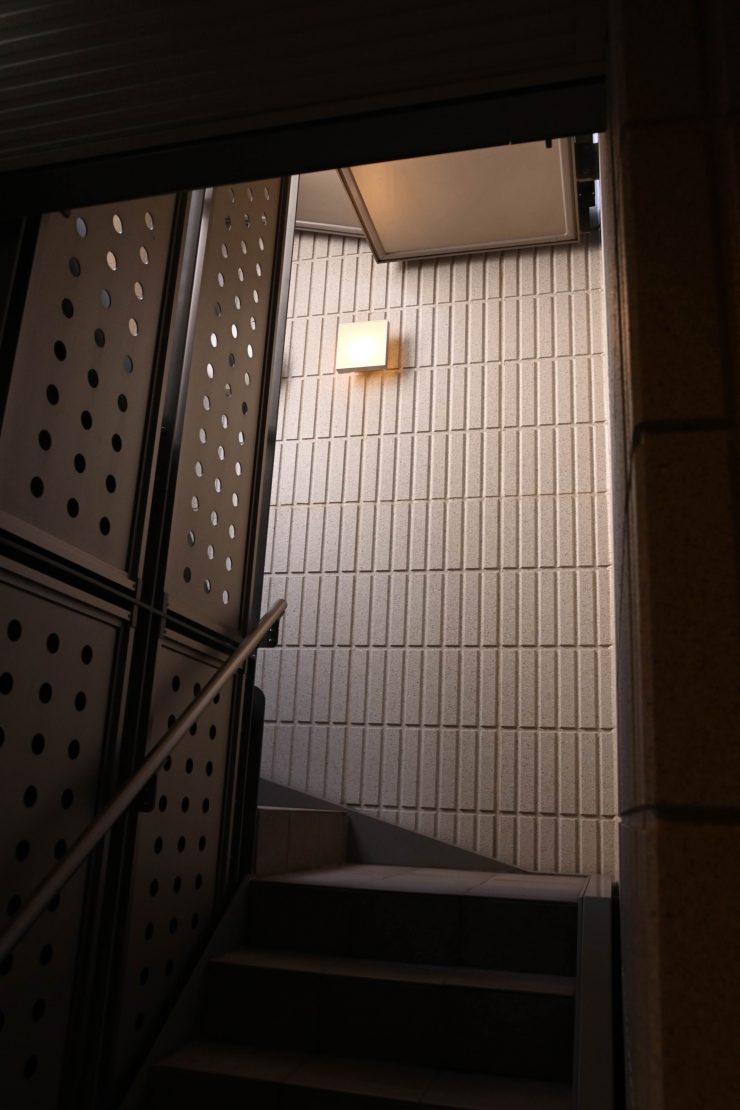
Light Off 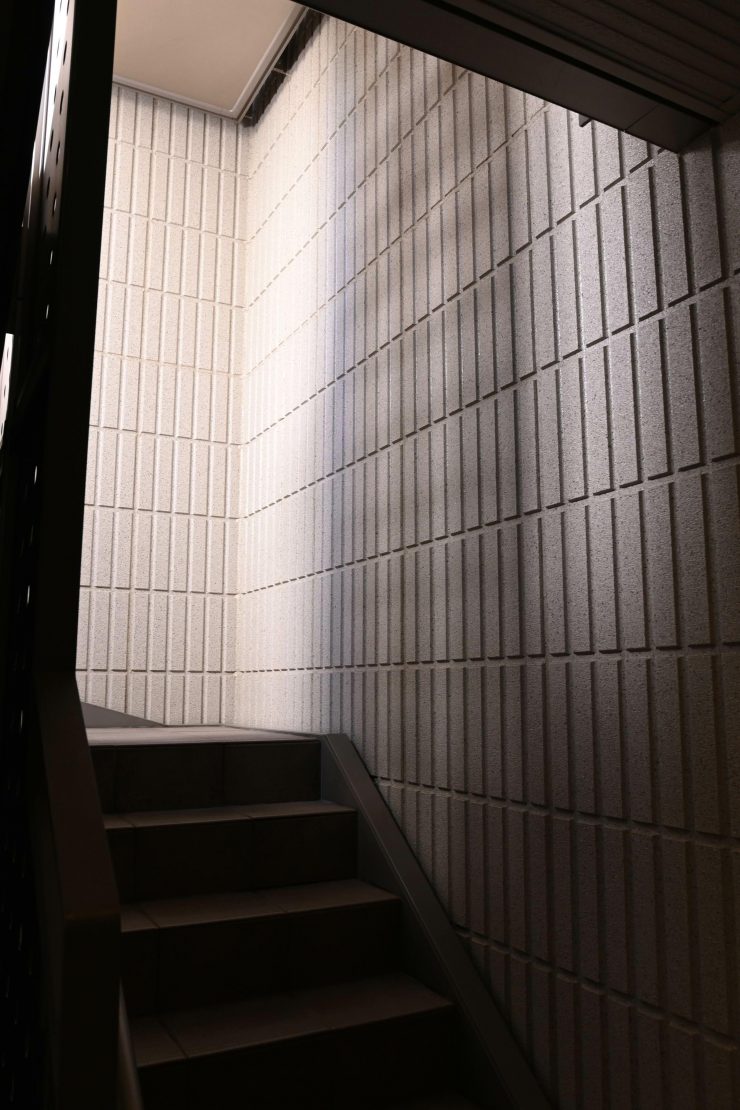
Light On 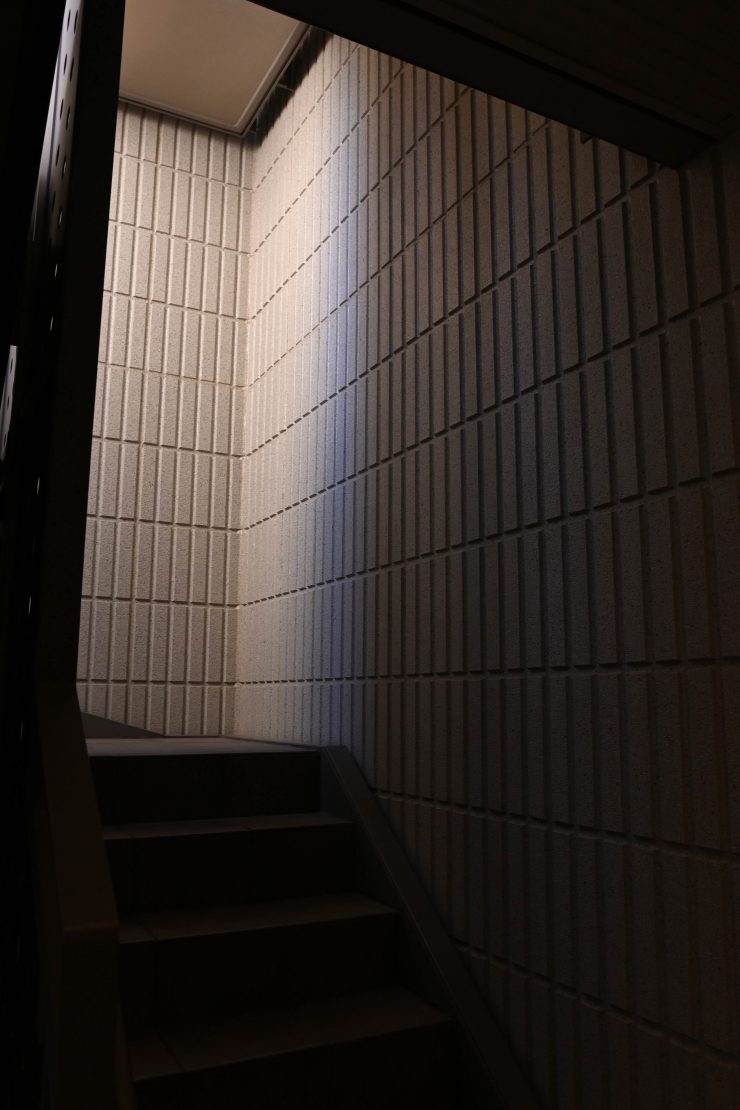
Light Off 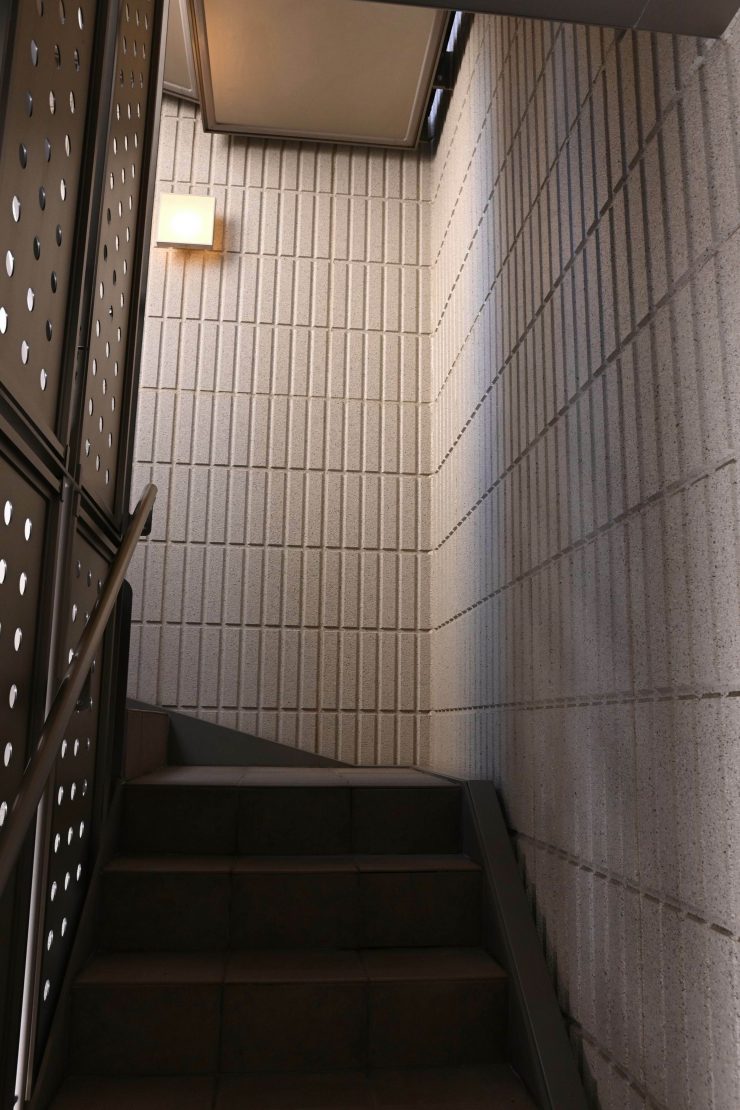
Light On 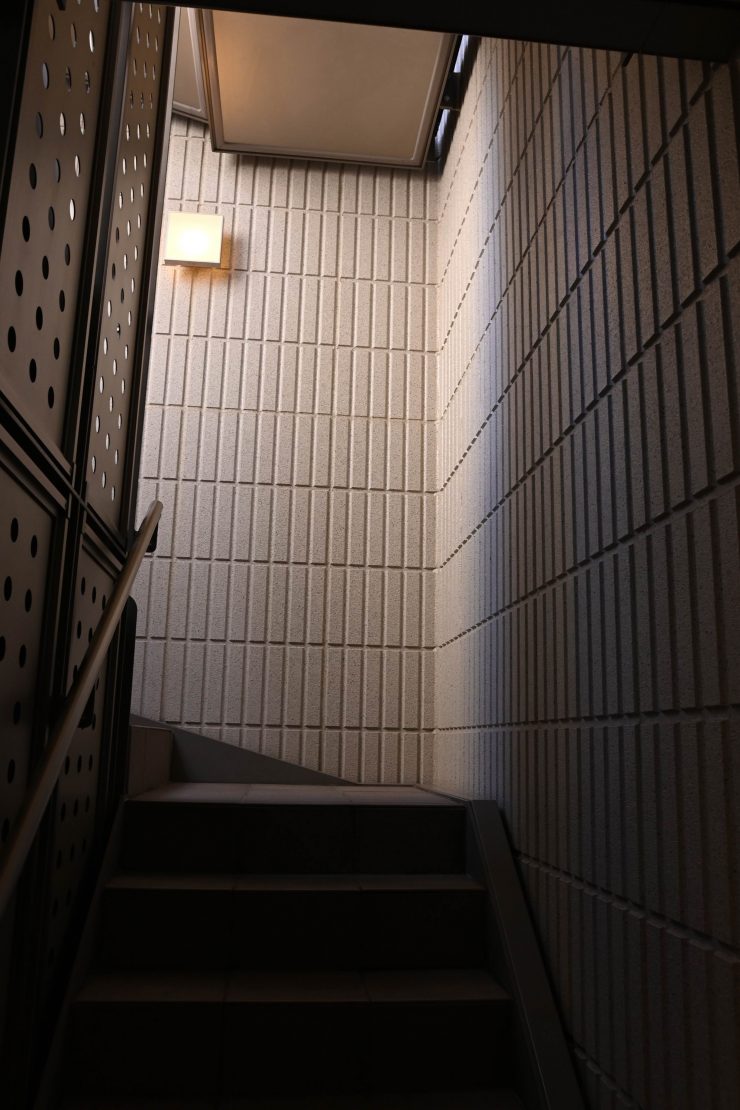
Light Off 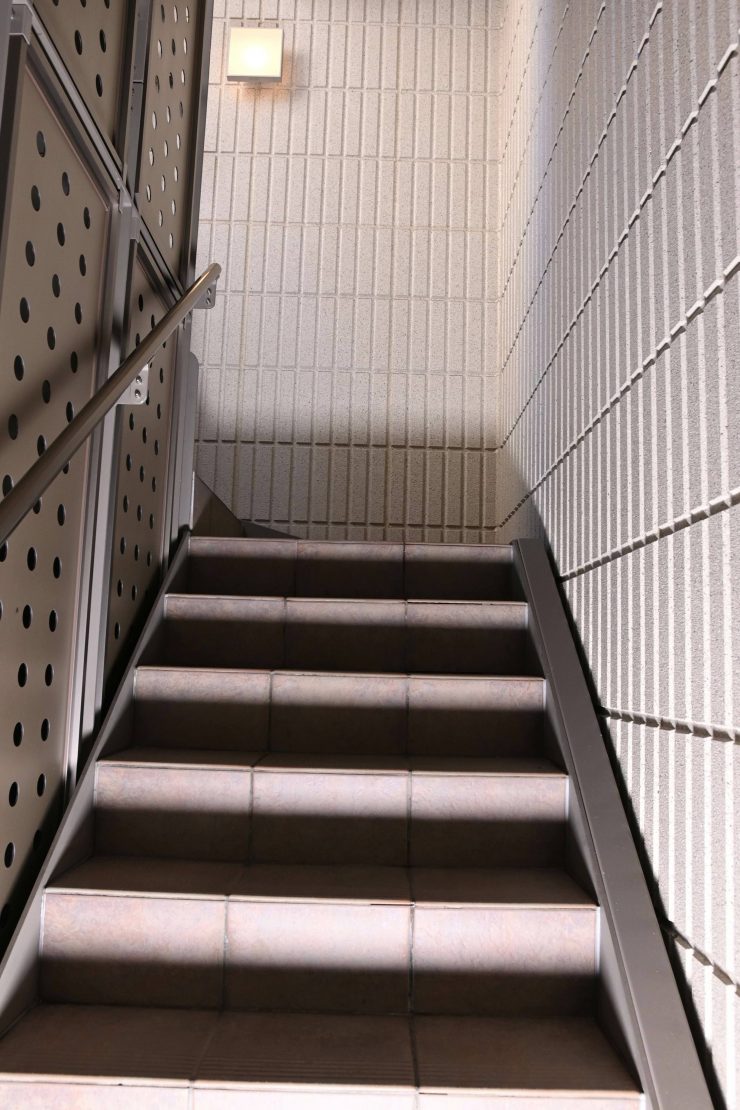
Light On 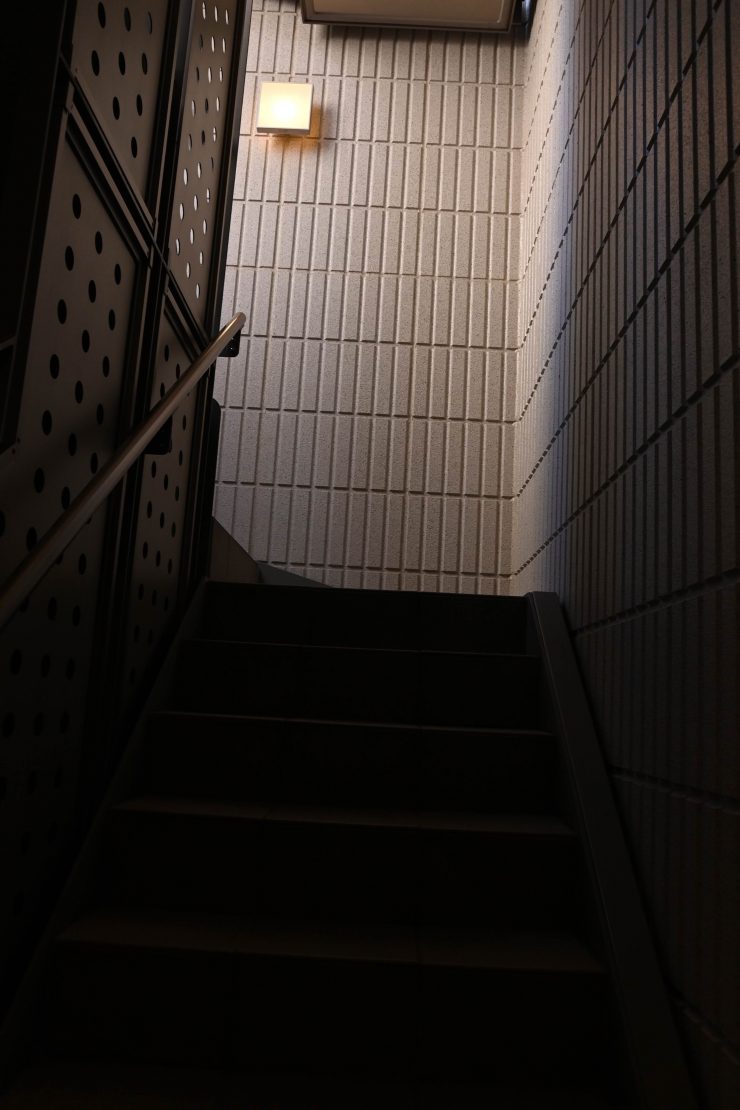
Light Off
To give you an idea about the output above you can see some shots with the light used in a stairwell.
The ZOLAR fixtures do produce a really nice quality of light, and most importantly they are easy to use and operate.
If you don’t have a high enough output, to begin with, and then attempt to heavily diffuse that lighting source, often the brightness of that light is reduced to a point where it’s only usable when placed very close to a subject. The ZOLAR fixtures, particularly the Vega 30C and Toliman 30C have quite a lot of output so you don’t have to place them too close to your subject or run them at full output when using them indoors.
Even the Toliman 30S, which has a lot lower power draw, puts out a decent amount of light. It would work for quite a lot of interview situations or even as some fill outdoors if needed (as long as it is cloudy or overcast).
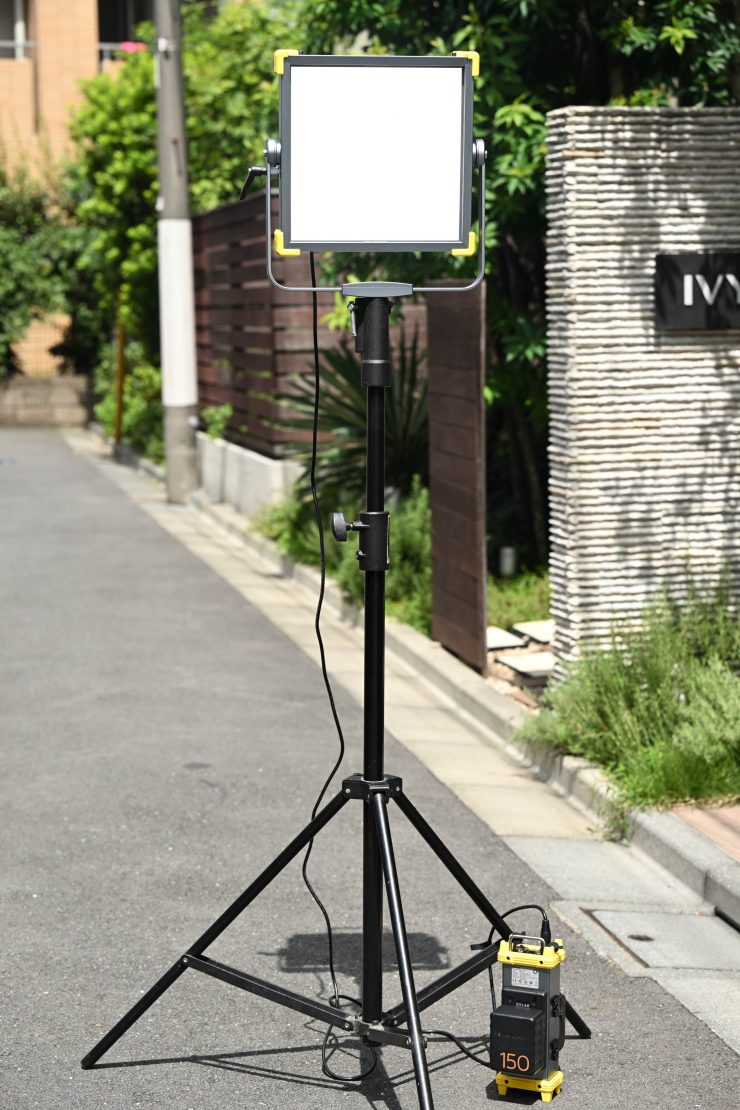
These lights are good solutions for solo operators or traveling cameramen or women who need a light that is quick to set up and can be powered remotely in the field from flight-safe camera batteries.
The ZOLAR lights would also be a pretty decent option for news crews due to their quick setup time and ability to be run at full output via flight-safe batteries.
As far as the RGB Color Mode, effects modes, gels, etc. go with the Vega 30C, while they are great to have, not everyone will need them.
The biggest question people will want to be answered is do these high SSI scores when using the lights at 5600K make any big real-world difference?
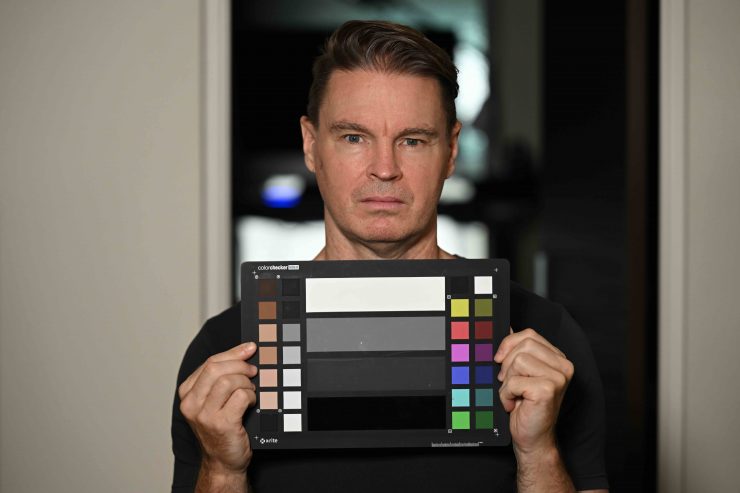
ZOLAR Vega 30C 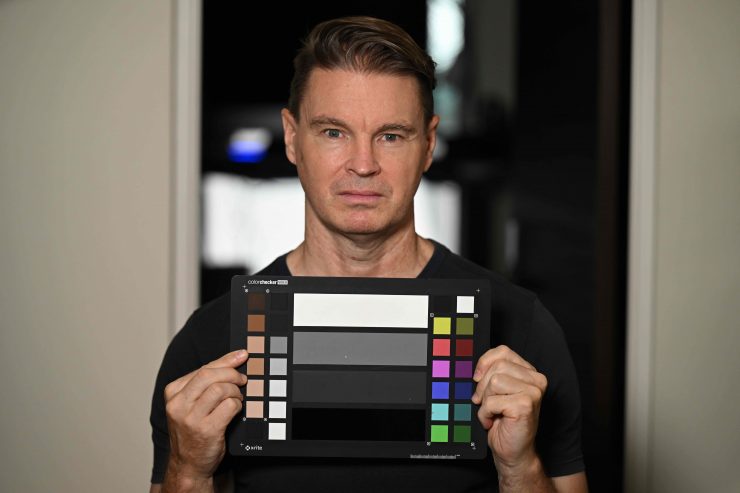
Litepanels Gemeni 1×1 SOFT 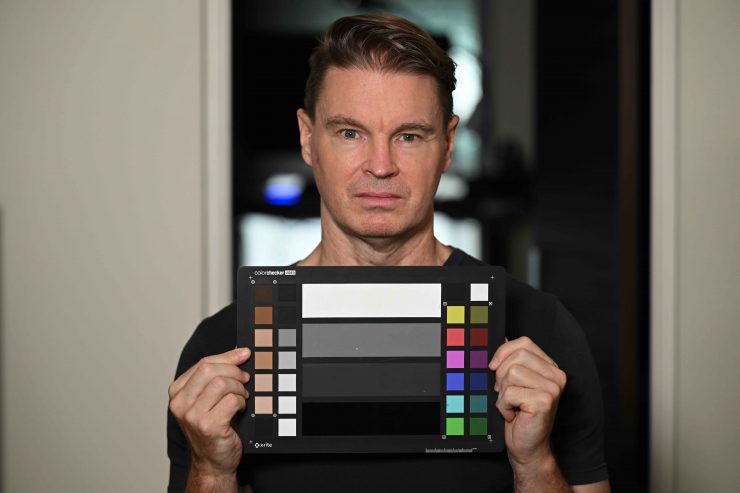
Luxli Timpani²
That is a good question. I decided to do a real-world test comparing the ZOLAR Vega 30C with the Litepanels Gemini 1×1 SOFT and the Luxli Timpani². I white balanced for each individual light and then took an image. Nothing has been altered or adjusted. As you can see there isn’t a massive difference between all three of the lights. The Litepanels is perhaps a tiny bit on the green side, but that light does have +/- G/M adjustment so you could change it. The Luxli and ZOLAR are incredibly close.
A light that has high SSI scores when used at 5600K is certainly capable of producing great results, however, you shouldn’t read too much into it depending on what you are trying to accomplish. As you can see from my real-world test, the Luxli Timpani² which doesn’t score nearly as high in SSI tests when used at 5600K is still able to produce extremely good results when used in this particular scenario.
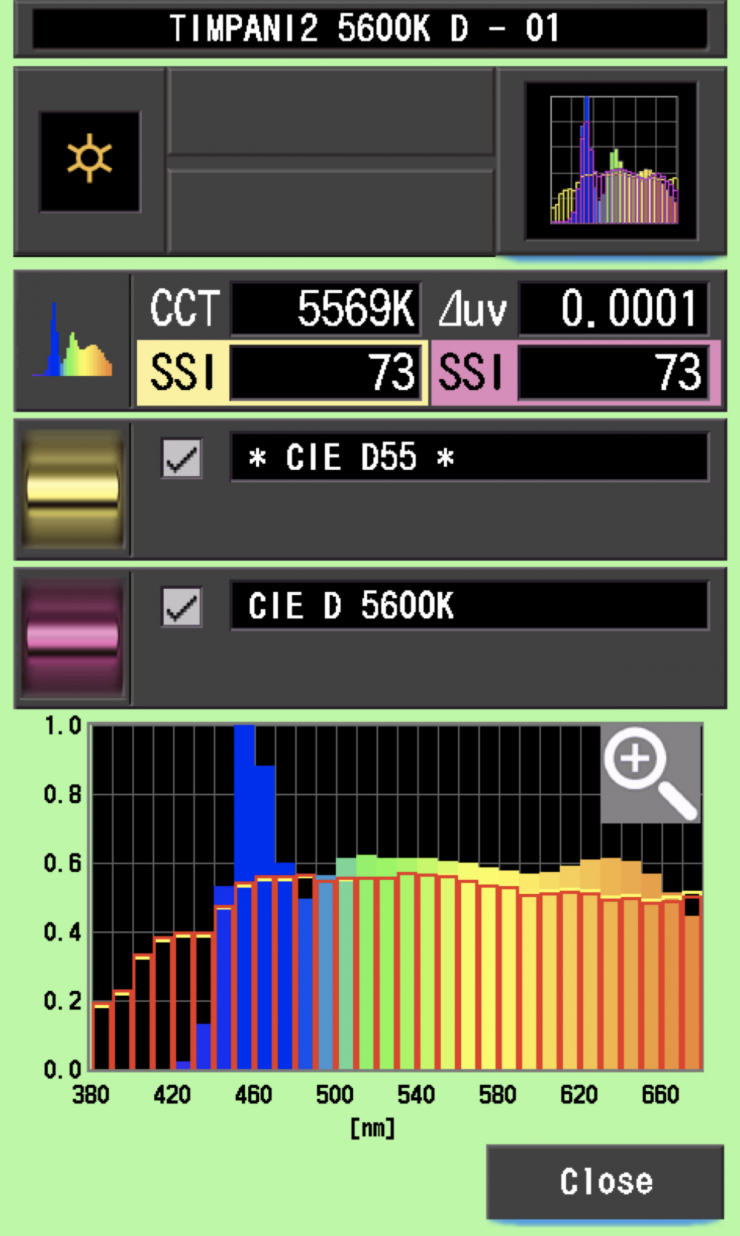
Just for the record, above are the SSI scores for the Luxli Timpani² when it is used at 5600K.
Now, you will generally get pretty close results if you are white balancing and are in controlled conditions, but if you are trying to actually match a daylight source like the sun, then having a light with the ability to capture a fuller spectrum will make a difference. How many times have you seen shots on TV where they are using a LED light outdoors and the colors look terrible?
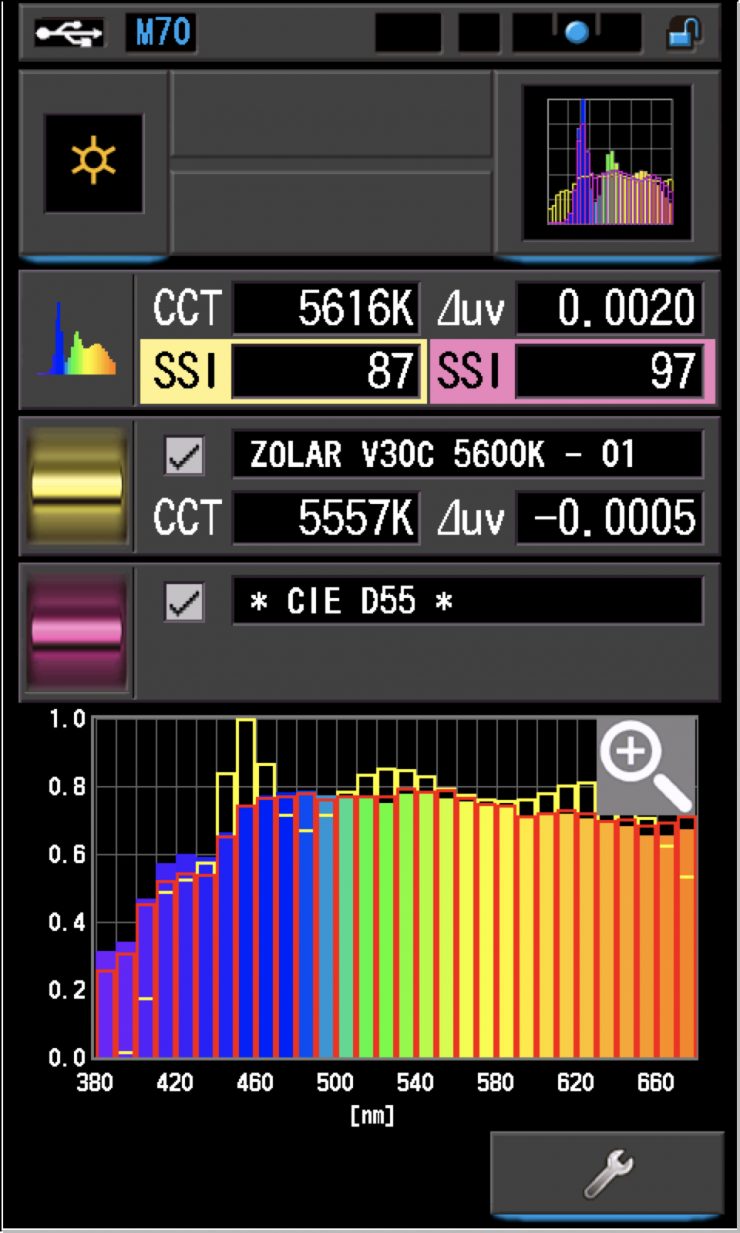
Above you can see an SSI comparison where I got a reading from the sun outdoors in bright daylight and compared it to the Vega 30-C. In the graph, the red bars indicate a perfect CIE D55 source. The gold bars indicate the spectral response of the ZOLAR Vega 30C. This lets us compare how close to matching the sun the Vega 30C is. A match of 89 is ridiculously good for an LED light when used at 5600K.
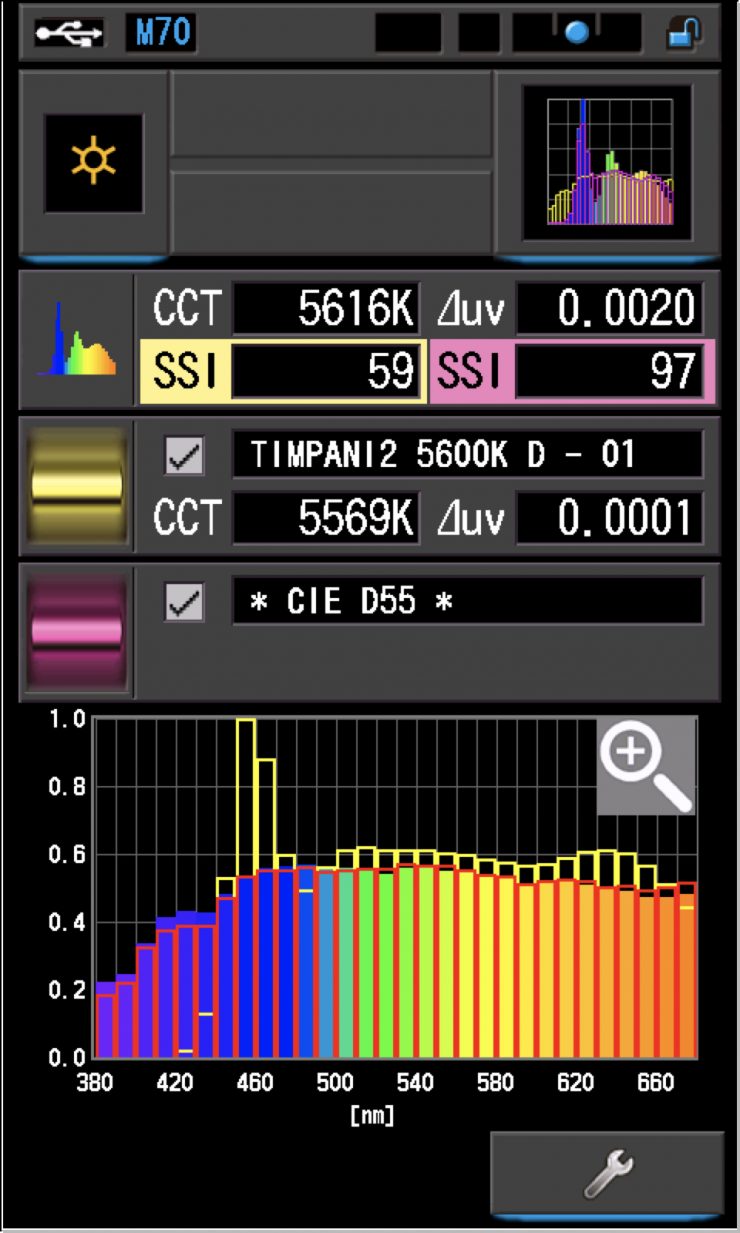
As a comparison, above you can see the same test with the Luxli Timpani². In the graph above the red bars indicate a perfect CIE D55 source. The gold bars indicate the spectral response of the Luxli Timpani². This lets us compare how close to matching the sun the Luxli Timpani² is. As you can see the Luxli Timpani² only had a matching score of 59 which is pretty bad.
What this essentially means is that lights that have the ability to capture a greater spectrum when set at 5600K will match daylight sources such as the sun a whole lot better. Now, for smaller-sized 1×1 panel lights with this ability, this advantage may not be that great because you could be trying to match a source (such as the sun) with not enough output.
What would be interesting to see is if manufacturers could put this fuller spectrum technology into high-powered LED fresnels. This would make a ton of sense, especially when using lights outdoors.

Vega 30C 
Light off
Above you can see a comparison when using the Vega 30C outdoors to try and match the sun. I white balanced for the sun and then turned the light on. As you can see, the light was able to provide enough fill to help even out the scene.

Above you can see a shot with the light on when the sun was behind some clouds. Again I haven’t done a WB with the light on.
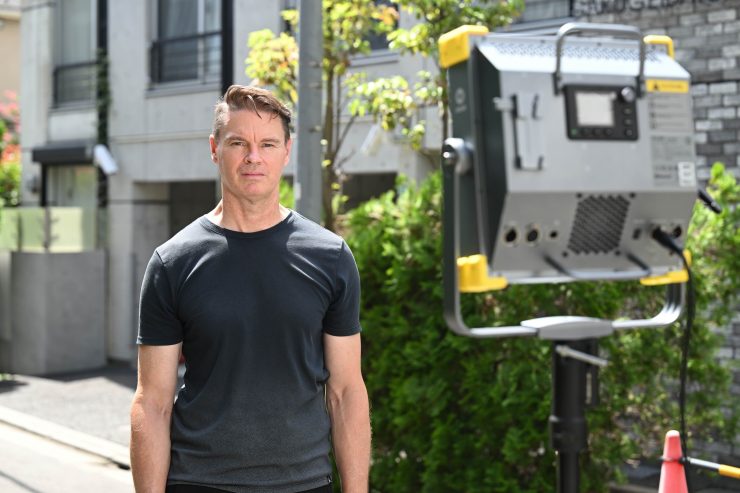
What I found is that the light is very good at replicating accurate colors when used outdoors. The fact that I didn’t even need to do a WB with the light on shows you how closely it actually matches daylight sources such as the sun.
Do you actually need an RGBW light?
Just because we want something, doesn’t necessarily mean that we need it. Whether you actually need an RGBW light really depends on the type of things that you shoot. If you are primarily shooting interviews, then having an RGBW light may not make a lot of sense. However, in saying that, the price point of the Vega 30C makes it a lot cheaper than other good traditional 1×1 LED panel lights. In that regard, considering it outperforms a lot of other 1×1 panel lights, it’s definitely worth buying if you are in the market for a fixture with this type of form factor. Even if you aren’t going to use the additional RGB features and effects they are nice to have on hand if the situation arises.
Even if you have no need for creating colors or using effects with your lighting, RGBW lights do give you access to creating a far wider range of Kelvin color temperatures than their regular LED counterparts. Having the ability to dial in a Kelvin color temperature between 2,200 – 20,000K can be extremely handy, and you shouldn’t overlook how important being able to change the +/- G/M bias is.
Other Alternatives
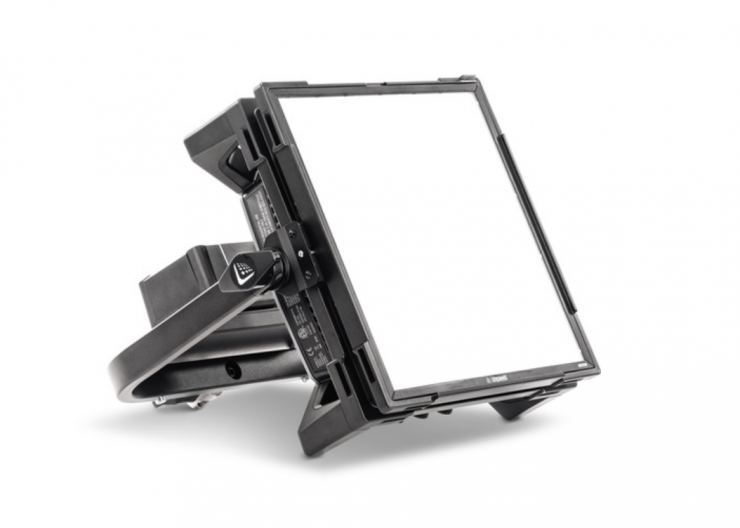
Litepanels Gemini 1×1 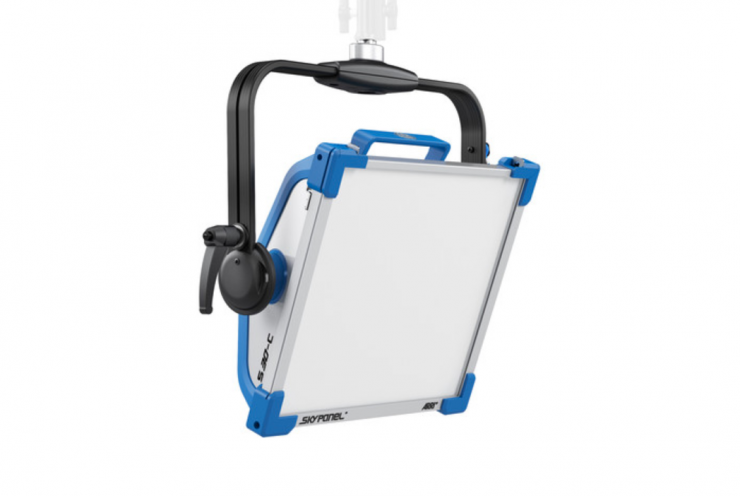
ARRI SkyPanel S30-C
There are a ton of 1×1 lights out there on the market at varying price points, but here are some of the lights that could be considered competition:
- Rotolight Titan X1
- Creamsource Vortex4 1×1 RGBW
- Litepanels Gemini 1×1
- Litepanels Gemini 1 x 1 RGBWW LED Hard Panel
- ARRI SkyPanel S30-C
- Lupo Superpanel Soft Full Color 30 Soft
- Lupo Superpanel Soft Full Color 30
- Rayzr 7 MC120
- Luxli Timpani² 1×1 RGBAW
- Aputure NOVA P300c
- VELVETlight Evo 1 Studio 1×1 Color-Tunable LED Panel
- TRIGYN Vari-Light RGBW 1×1 LED Soft Light Kit
- Falcon Eyes D-S811 RGB 1×1
- Fluotec Cinelight Color30 1X1 Color
You would expect that the newest lights on this list would be the best, but that is not always the case.
The SkyPanel was announced way back in 2015 and the Litepanels Gemini in 2017. The SkyPanel series has been hugely popular because it is widely available, super robust, and reliable.
The Lupo Superpanel Full Color 30/ Full Color 30 Soft, Luxli Timpani, Rayzr 7 MC120, Falcon Eyes, and TRIGYN are more budget-friendly options, that will probably appeal to a different segment of the market than lights like the Rotolight Titan X1, ARRI SkyPanel S30-C, Creamsource Vortex4, etc.
All of the competition have their strengths and weaknesses and what light will work best for you certainly comes down to a lot more factors than just specifications and features.
A rental house is much more likely to carry an ARRI, Kino Flo, Rotolight, or even a Litepanels Gemini over a Lupo, Aputure, Rayzr 7, or ZOLAR, although that is starting to change in some markets. This is primarily to do with the build quality, after-sales service, and a long-term track record of reliability. However, the build quality of the ZOLAR fixtures is excellent, as is the performance, so there is no reason that they couldn’t be used at the highest levels of production.
Price & Availability
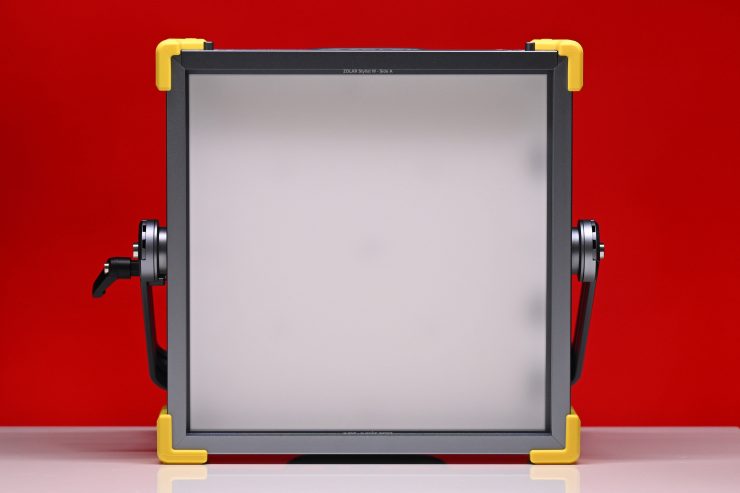
Here are the prices for the ZOLAR fixtures:
- ZOLAR Toliman 30S (Bi-color LED) – $499.00 USD
- ZOLAR Toliman 30C (Bi-color LED) – $699.00 USD
- ZOLAR Vega 30C (5-color LED) – $799.00 USD
The ZOLAR series is very competitively priced.
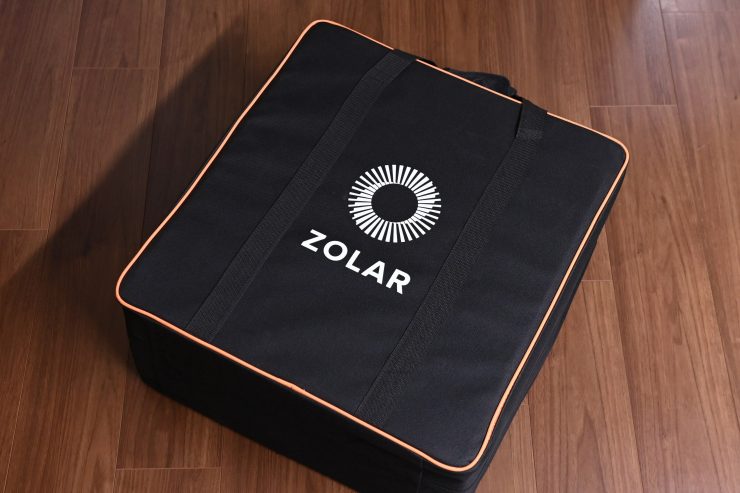
All three lights come in a soft case that has foam cutouts inside.
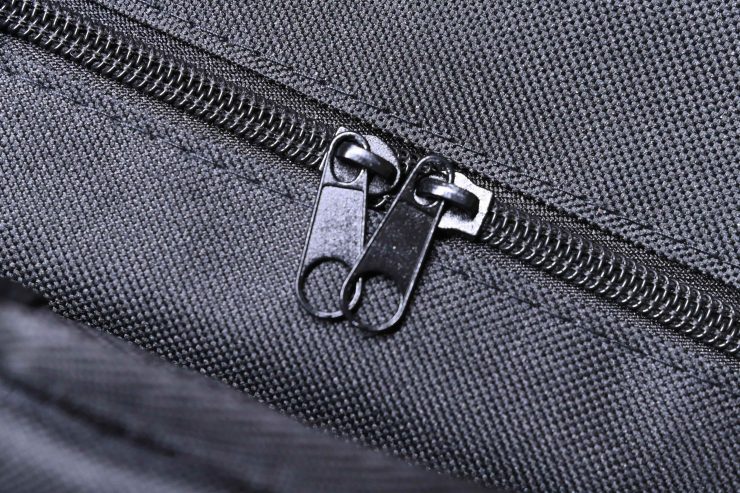
While the bag is ok, I don’t personally think the zippers would last that long.
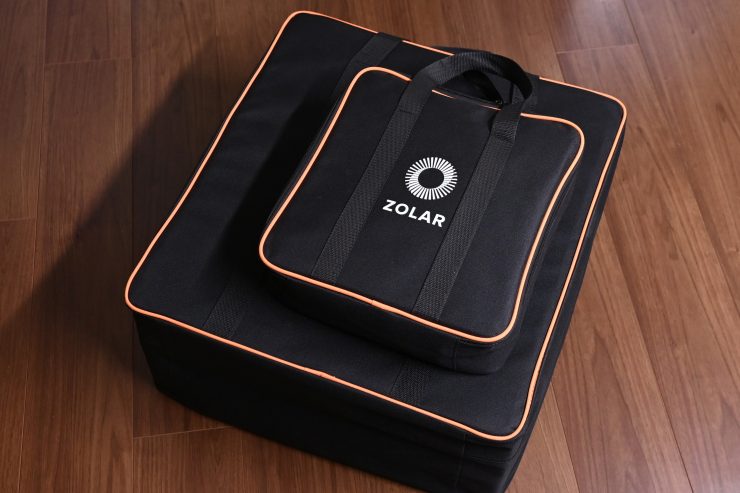
With the Vega 30C and Tolamn 30C, you get an extra bag that is for the power supply. I would have preferred to have seen a solution where everything fits into one bag. It would have also been nice to have seen some optional hard cases for those people who want to travel and fly with the lights.
Below you can see how the price of the Vega 30C compares to other 1×1 RGBW lights on the market:
| Price | |
| Z CAM ZOLAR Vega 30C | $799 USD |
| Luxli Timpani² | $999 USD |
| Creamsource Vortex4 1×1 RGBW | $2,799 USD |
| Rotolight Titan X1 | $3,699 USD |
| ARRI SkyPanel S30-C | $4,900 USD |
| Litepanels Gemini 1×1 | $1,776 USD |
| Litepanels Gemini 1 x 1 RGBWW LED Hard Panel | $2,505.23 USD |
| Lupo Superpanel Soft Full Color 30 | $1,698 USD |
| Lupo Superpanel Full Color 30 | $1,698 USD |
| VELVETlight Evo 1 Studio 1×1 Color-Tunable LED Panel | $2,776.75 USD |
| Rayzr 7 MC120 | $899 USD |
| Luxli Timpani 1×1 RGBAW | $849.99 USD |
| Aputure NOVA P300c | $1,699 USD |
| TRIGYN Vari-Light RGBW 1×1 LED Soft Light Kit | $919 USD |
| Falcon Eyes D-S811 RGB 1×1 | $1,299 USD |
| Fluotec Cinelight Color30 1X1 Color | $1,643 USD |
With modern-day lights (and this goes for just about any of today’s technology) the lifespan of the product is not going to be as long. That is not to say your light will become obsolete in 3 years time, but there will be something better that is bound to come along.
In saying that, a lot of today’s lights are receiving new features via firmware updates. This is something that increases their flexibility and feature set.
Optional Accessories
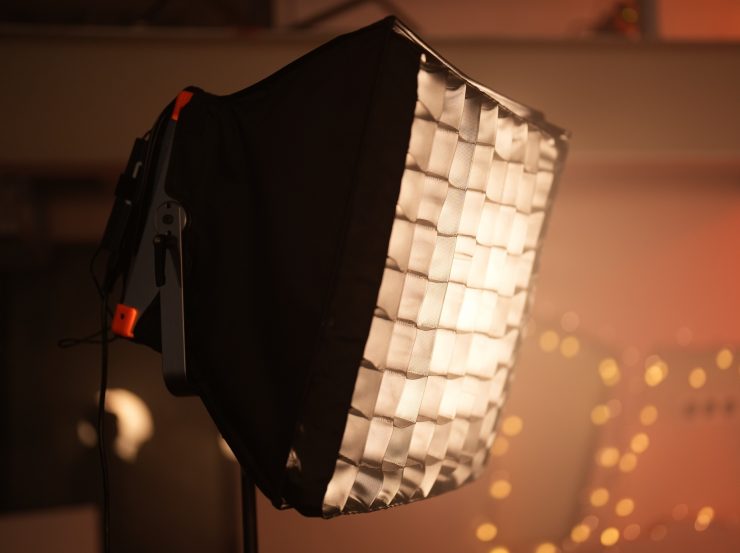
At launch there will be the following optional accessories available:
- ZOLAR Stylist L
- ZOLAR Barndoors
- ZOLAR SoftBox Accessory Kit (this features a softbox and a grid)
I don’t currently have any prices for these accessories, but I will update the review once I do.
Full Specifications
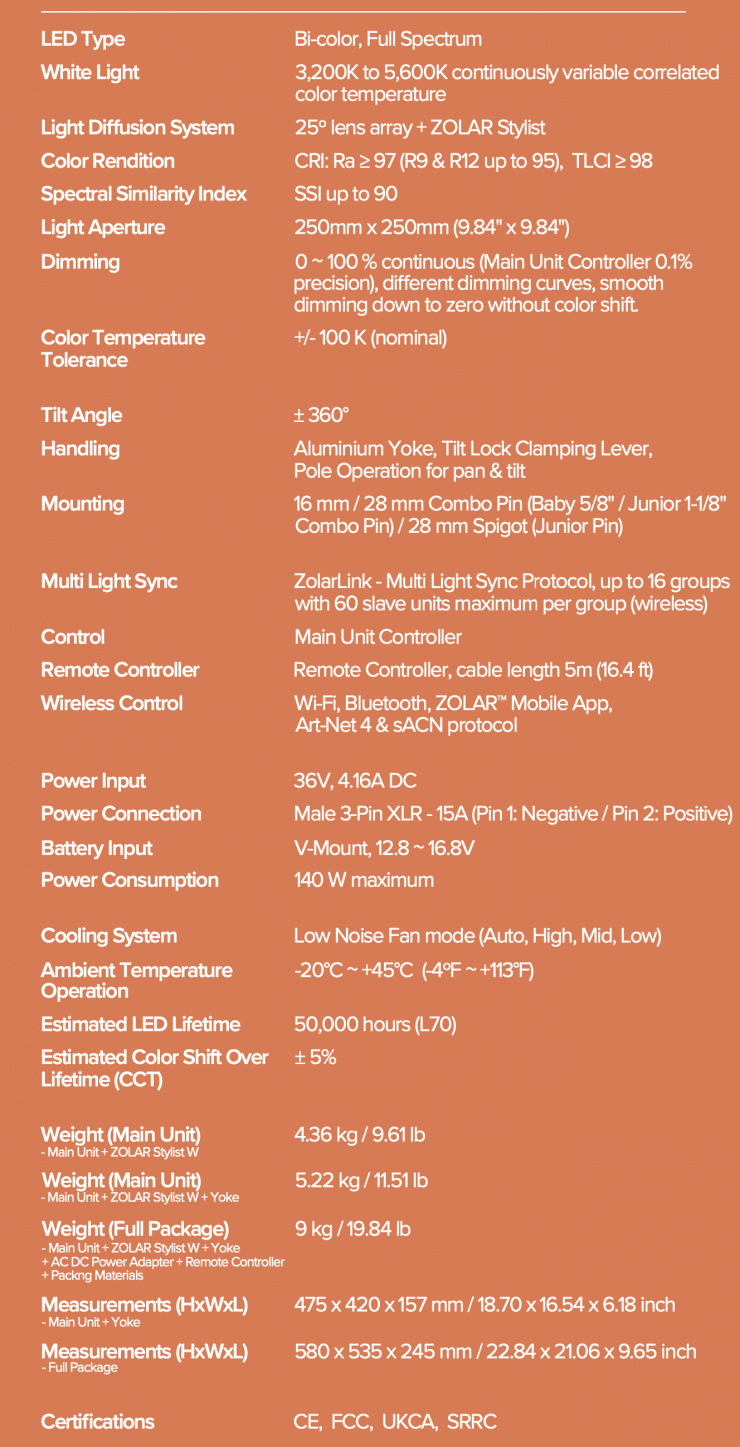
ZOLAR Toliman 30S 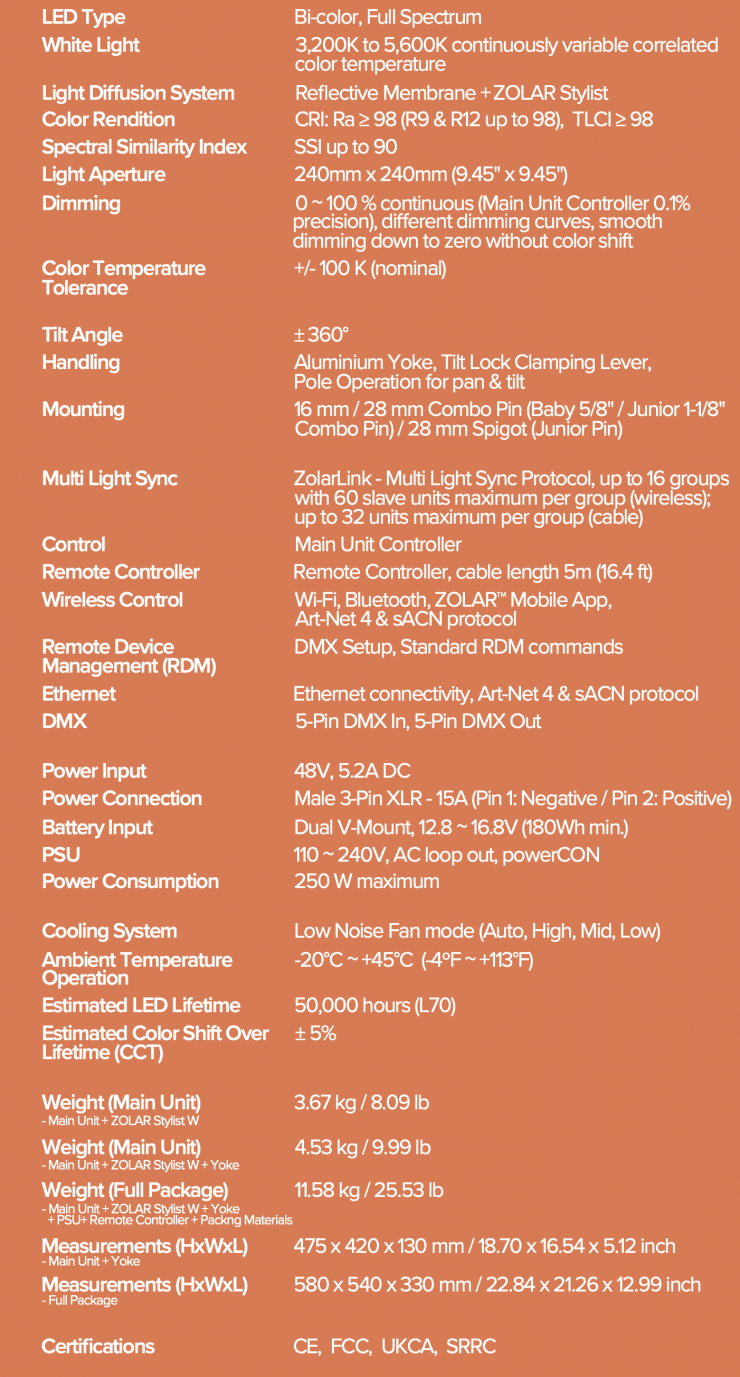
ZOLAR Toliman 30C 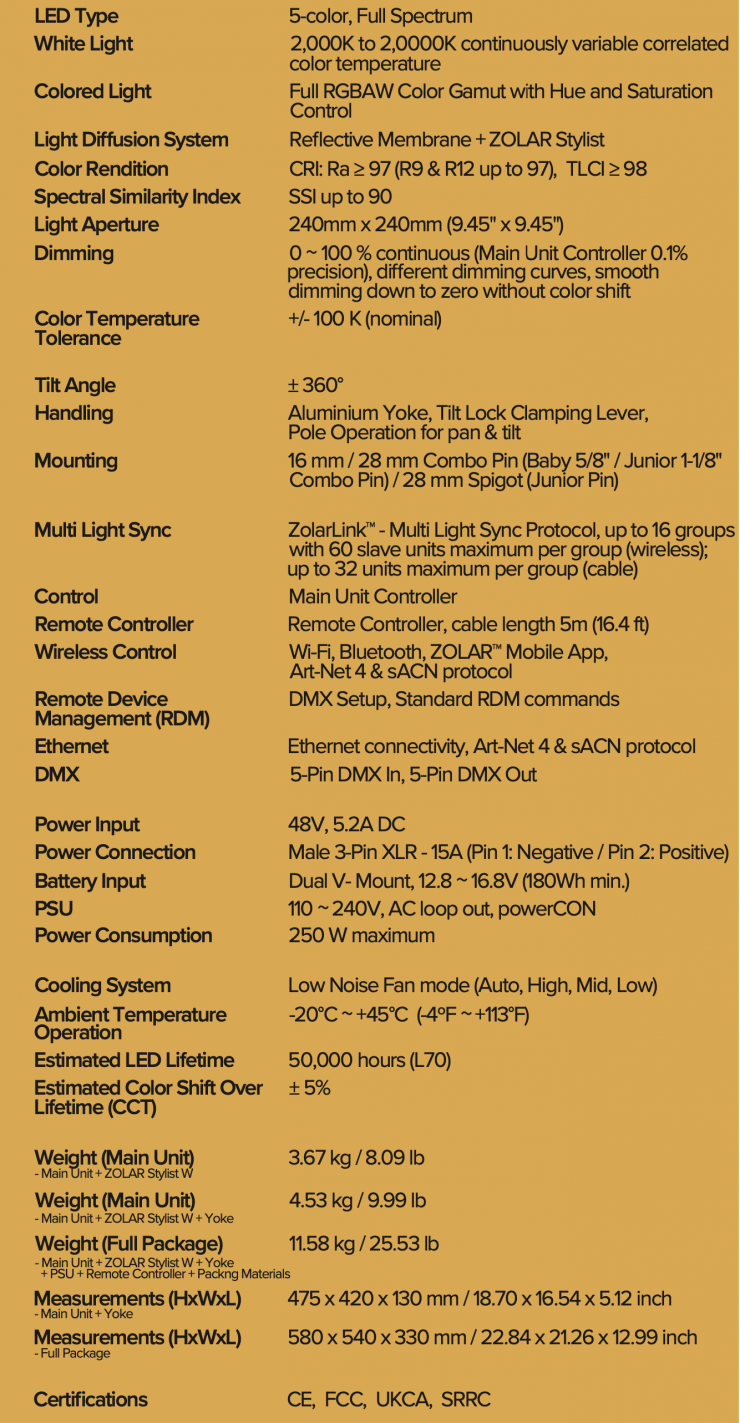
ZOLAR Vega 30C
Above you can see the full specifications for all three lights.
Conclusion
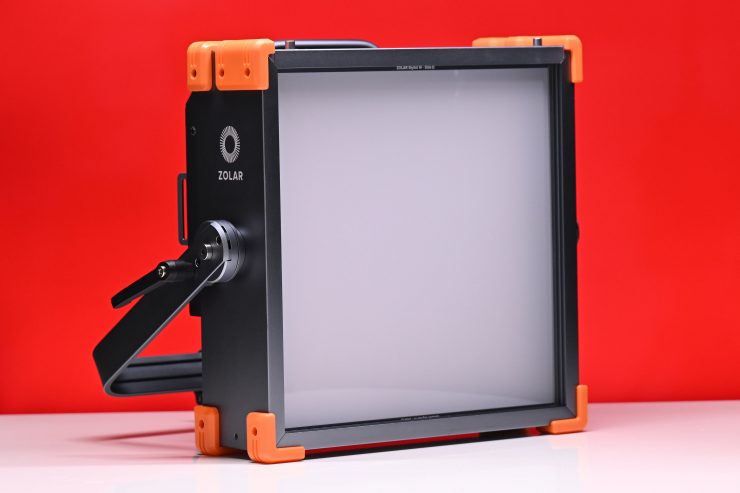
The ZOLAR 1×1 panels are impressive offerings. They are feature-rich fixtures with very great color accuracy and color rendering and good build quality. They have a decent amount of output which makes them versatile solutions for lots of different applications, and they can be run at full power via flight-safe batteries.
The build quality, exceptional color accuracy, and different ways of powering and controlling the lights are something no other manufacturer is doing at this level of affordability.
The ZOLAR fixtures represent incredibly good value given their performance and feature set, and if you were in the market for 1×1 panels then I don’t think anything else comes close to the price of these fixtures. The nearest competitor for the Vega 30C, at least in my opinion, would be the Luxli Timpani². However, that light doesn’t have as much output, nor does it have the same SSI scores when used at 5600K.
Most ‘affordable‘ fixtures tend to suffer from average build quality and limited features, but that is not the case with the ZOLAR lights. The entry-level Toliman 30S which is only $499 USD is a way better 1×1 light than anything else even remotely close to its price point. If you don’t need or require an RGBW light, then the Tolman 30S and Tolamn 30C are fantastic options.
I also like how all three of the lights are almost an identical match so you can use them together without any issues.
As I mentioned earlier, whatever they are doing over there in China, it should be making other lighting manufacturers very concerned. The build quality, photometric scores, and usability of the ZOLAR fixtures place them right up there with the best 1×1 solutions I have tested at a fraction of the price.
I highly recommend the ZOLAR fixtures if you are in the market for a solid, well-performing 1×1 panel that won’t empty your wallet.

